The 10 Best Treks in Nepal – The Ultimate Guide to Decide Which Trek Suits You

Guest post by Rakesh from AroundManasluTrek.com , a local trekking operator in Nepal that specializes in the beautiful Manaslu region of the Himalayas.
Nepal has been the most sought-after destination for adventure treks. From the diverse terrain to the rich cultures, the nation has everything to offer. Here, we’ll be discussing the Top 10 Best Treks in Nepal, highlighting the essence of various trekking regions.
This comprehensive guide will help you in selecting the top adventure treks in Nepal based on your preferences and experience level. We’ve featured the 10 most adventurous treks mentioning key highlights, the best time to visit, difficulty level, and much more.
At the end of this post, you’ll be able to make informed decisions for undertaking a suitable trek. Trekking in Nepal is a journey of exploration and discovery through Himalayan panoramas.

1) Everest Base Camp Trek
2) annapurna base camp trek, 3) langtang valley trek , 4) manaslu circuit trek, 5) annapurna circuit trek, 6) upper mustang trek, 7) kanchenjunga trek, 8) dhaulagiri trek, 9) upper dolpo trek, 10) nar phu valley trek.
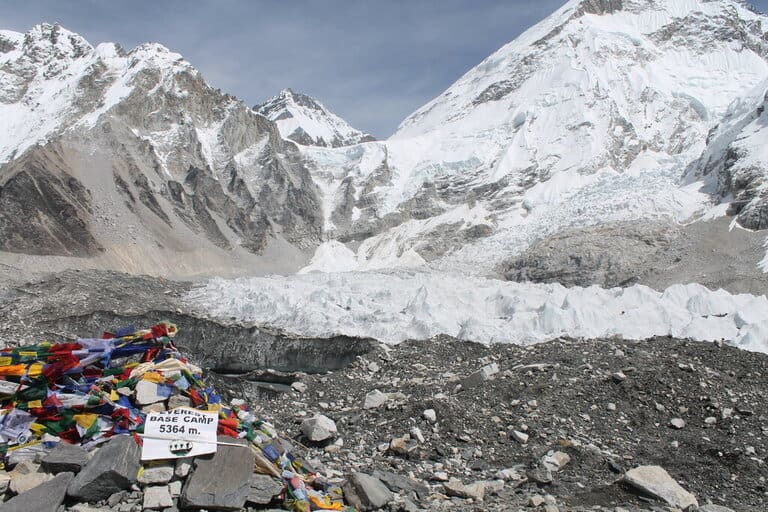
Widely considered one of the absolute best treks in Nepal, the journey to Everest Base Camp Trek is an exciting adventure that takes around 14 days to complete. Generally, the whole trek distance is around 130 Km taking you to the highest elevation at Everest Base Camp (5,364m/17,598ft) & Kala Patthar (5,545m/18,192ft). Though the trek can be a bit challenging for beginners, it is considered as moderate as a whole.
The trek to Everest Base Camp begins with a picturesque flight to Lukla from Kathmandu. As the trek progresses, you come across various stops like Phakding, Namche Bazaar, Tengboche, Dingboche, Lobuche, and Gorak Shep.
The trail lets you explore Sagarmatha National Park with rich flora & fauna while experiencing Sherpa culture & Buddhist monasteries. The best part is you get up-close views of Mt. Everest (8,848m) – the world’s highest peak, as well as other giants like Lhotse, Makalu, and Cho Oyu.
Retracing the footsteps of Everest pioneers like Edmund Hillary is something to be proud of. Apart from that, exploring the iconic Tengboche Monastery, witnessing the sunrise view of Everest from the Kala Patthar viewpoint, and many more make this trek truly astonishing.
Outline Itinerary
- Day 1: Kathmandu Arrival
- Day 2: Fly to Lukla, Trek to Phakding
- Day 3: Phakding to Namche Bazaar
- Day 4: Acclimatization Day in Namche Bazaar
- Day 5: Namche Bazaar to Tengboche
- Day 6: Tengboche to Dingboche
- Day 7: Acclimatization Day in Dingboche
- Day 8: Dingboche to Lobuche
- Day 9: Lobuche to Gorak Shep, Everest Base Camp, and back to Gorak Shep
- Day 10: Hike to Kala Patthar, then to Pheriche
- Day 11: Pheriche to Namche Bazaar
- Day 12: Namche Bazaar to Lukla
- Day 13: Fly back to Kathmandu
- Day 14: Departure from Kathmandu
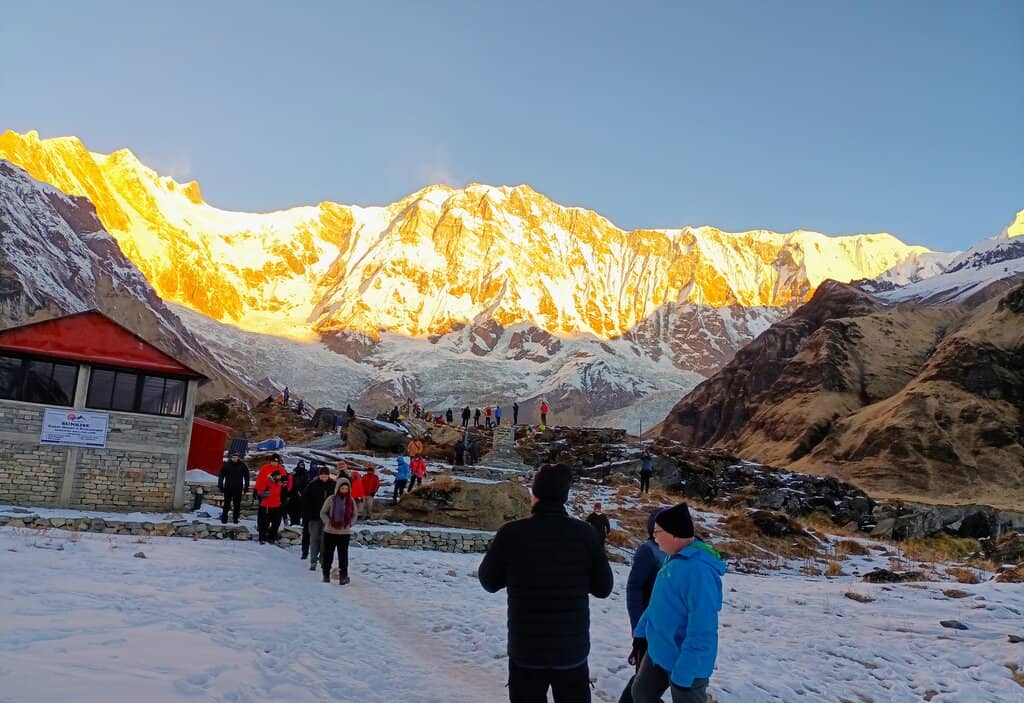
The Annapurna Base Camp Trek is a moderate 10-14 day journey covering around 115-130 km within Nepal’s iconic Annapurna Conservation Area.
Reaching a maximum altitude of 4,130m at Annapurna Base Camp, this trek offers stunning views of Mt. Annapurna (8,091m) and other mighty 7,000m+ peaks.
Beginning and ending in Pokhara or Nayapul, key highlights include trekking through rhododendron forests, dramatic glacial valleys, mountain panoramas, and diverse ecosystems from subtropical forests to alpine terrain.
The cultural encounter comes through experiencing Gurung and Magar villages, monasteries, and shrines along the route. This trek walks you across the inner Annapurna Sanctuary. With easier access compared to other demanding treks, the trek to Annapurna Base Camp showcases the undefining beauty of Nepal.
- Day 1: Arrival in Kathmandu
- Day 2: Drive from Kathmandu to Pokhara
- Day 3: Pokhara to Tikhe Dhunga
- Day 4: Tikhe Dhunga to Ghorepani
- Day 5: Ghorepani – Poonhill – Tadapani
- Day 6: Tadapani to Chhomrong village
- Day 7: Chhomrong to Dovan
- Day 8: Dovan to Deurali
- Day 9: Deurali to Annapurna Base Camp via Machhapuchhre Base Camp
- Day 10: Annapurna Base Camp to Bamboo
- Day 11: Bamboo to Jhinu Danda Hot Spring
- Day 12: Jhinu Danda to Pokhara
- Day 13: Drive Back to Kathmandu
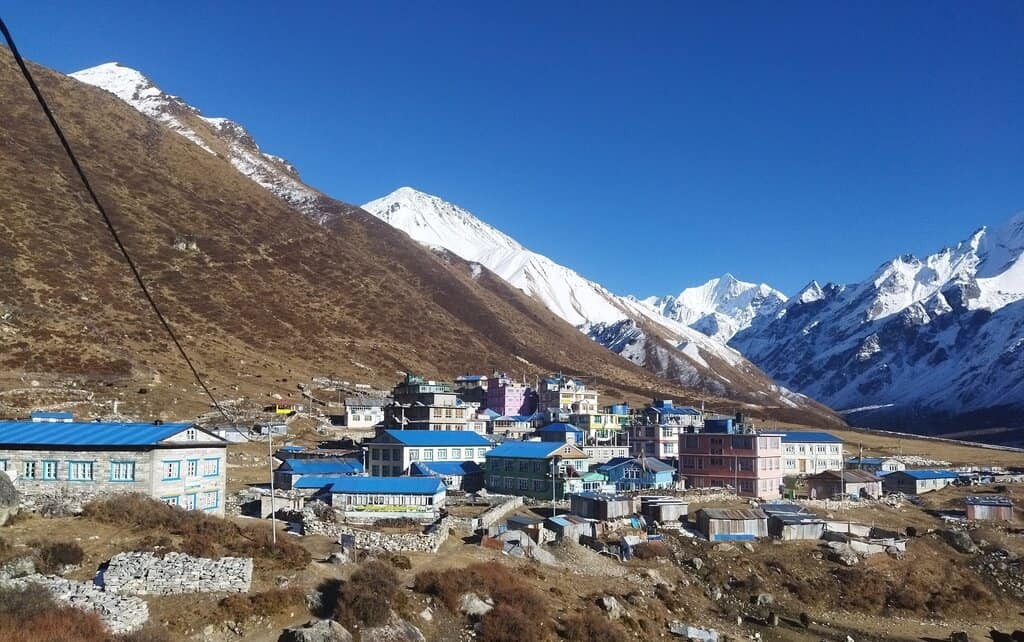
The Langtang Valley Trek is one of the nearest and most dramatic Himalayan treks from Kathmandu. The trek is a moderate 7-10 day journey spanning 50-65 km with a maximum altitude of 4,773m at Kyanjin Ri or 5,000m at Tserko Ri.
Starting from Syabru Besi and ending in Dhunche or Syabrubesi, major stops include Lama Hotel, Langtang Village, and Kyanjin Gompa. Highlights are spectacular mountain vistas of Langtang Lirung (7,246m), Langtang Ri (6,370m), and Dorje Lakpa (6,990m), crossing glaciers, thundering waterfalls, lush rhododendron forests and spotting rare red pandas.
This exceptional trek immerses you in ancient Tibetan Buddhist culture at Kyanjin Gompa, interacting with Tamang and Tibetan communities, while trekking through dramatic landscapes from subtropical jungles to alpine glaciers within Langtang National Park – Nepal’s first Himalayan national park.
Brief Itinerary for Langtang Valley Trek
- Day 2: Kathmandu to Syabrubesi
- Day 3: Syabrubesi to Lama Hotel
- Day 4: Lama Hotel to Mundu via Langtang Village
- Day 5: Mundu to Kyanjin Gompa
- Day 6: Acclimatization Day at Kyanjin Gompa
- Day 7: Kyanjin Gompa to Lama Hotel
- Day 8: Lama Hotel to Syabrubesi
- Day 9: Syabrubesi to Kathmandu
- Day 10: Departure from Kathmandu
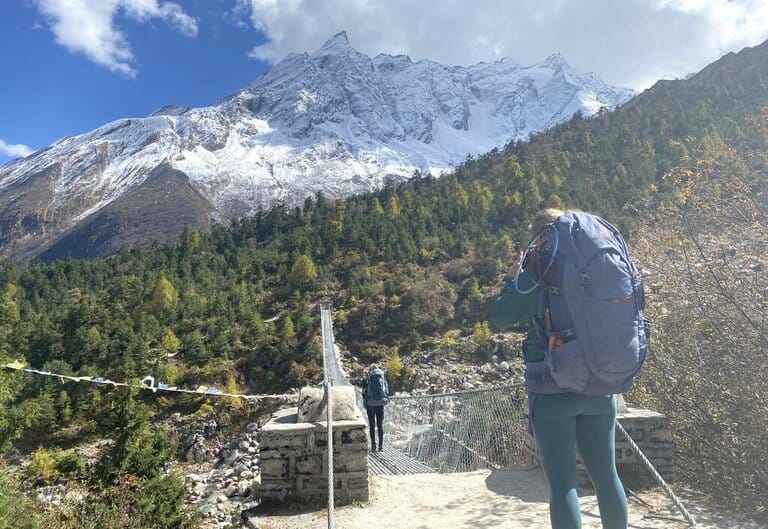
The Manaslu Circuit Trek is a challenging 14-18 day adventure covering around 180 km with a maximum altitude of 5,106m at Larkya La Pass.
Starting from Soti Khola or Machha Khola and ending in Dharapani, major stops include Philim, Birgha Kharka, Lho, Samagaun, Samdo, and Dharamsala.
Trekkers are rewarded with stunning views of Mt. Manaslu (8,163m) – the 8th highest peak in the world, crossing the iconic pass, Larkya La. Moreover, you come across authentic Tibetan Buddhist villages, incredible biodiversity within the Manaslu Conservation Area, dramatic suspension bridges, and cultural interactions with Nubri, Tsum, and Kutang communities.
This restricted-permit trek is far less crowded than the Annapurna and Everest trails. The adventure of high mountain pass crossings on one of Nepal’s newest trekking routes opened only in 1991.
The trekking trail features dramatic terrain changes from subtropical to alpine, glacier scenery, turquoise Budi Gandaki valleys, potential snow leopards, and more.
Brief Itinerary for Manaslu Circuit Trek
- Day 2: Kathmandu to Machha Khola
- Day 3: Machha Khola to Jagat
- Day 4: Jagat to Deng
- Day 5: Deng to Namrung
- Day 6: Namrung to Lho Gaun
- Day 7: Lho Gaun to Samagaon
- Day 8: Acclimatization Day at Samagaon
- Day 9: Samagaon to Samdo
- Day 10: Samdo to Dharamsala (Larkya Phedi)
- Day 11: Dharamsala to Bhimthang via Larkya La Pass
- Day 12: Bhimthang to Dharapani
- Day 13: Dharapani to Kathmandu
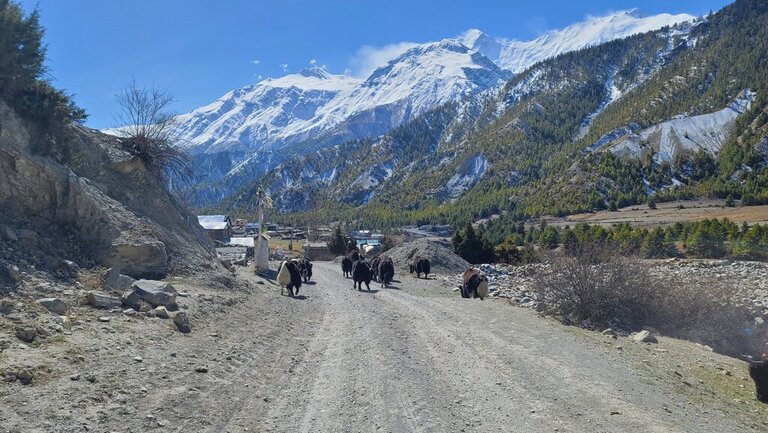
The Annapurna Circuit Trek is an epic 14-22 day journey spanning approximately 230-300 km with a maximum altitude of 5,416m at Thorung La Pass.
Starting from Besisahar and ending in Jomsom or Nayapul, major stops include Chame, Pisang, Manang, Muktinath, and Ghorepani. This challenging trek showcases diverse landscapes from lush rhododendron forests to arid deserts, with iconic views of Himalayan giants like Annapurna I (8,091m) and Dhaulagiri (8,167m).
Cultural highlights are immersion in ethnic Thakali, Magar, and Gurung villages, the sacred Muktinath Temple, and the dramatic terrain of deep gorges and glaciers.
Trekkers cross the iconic Thorung La – one of the world’s highest passes over 5,400m – experiencing multiple climatic zones from subtropical to alpine while observing flora and fauna. The journey along the Annapurna Circuit Trek leads you through multiple districts with stunning views of three 8,000m+ peaks.
Brief Itinerary for Annapurna Circuit Trek
- Day 2: Kathmandu to Besisahar and then to Chamje
- Day 3: Chamje to Dharapani
- Day 4: Dharapani to Chame
- Day 5: Chame to Upper Pisang
- Day 6: Upper Pisang to Manang
- Day 7: Acclimatization Day in Manang
- Day 8: Manang to Yak Kharka
- Day 9: Yak Kharka to Thorong Phedi
- Day 10: Thorong Phedi to Muktinath via Thorong La Pass
- Day 11: Muktinath to Jomsom
- Day 12: Jomsom to Pokhara
- Day 13: Pokhara to Kathmandu
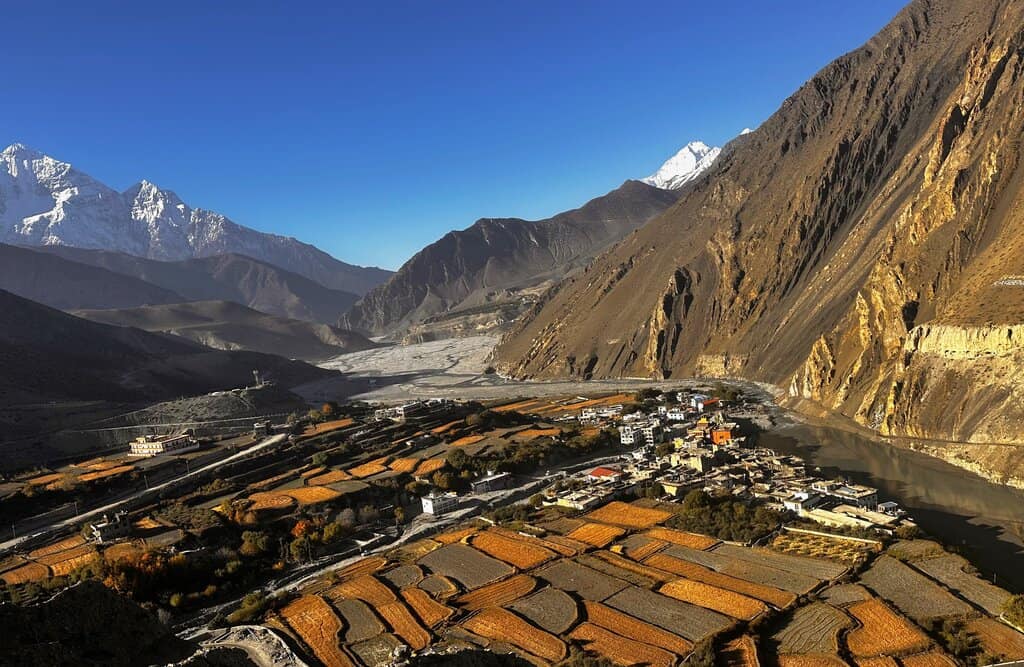
The Upper Mustang Trek is a moderate to challenging 16-18 day journey spanning approximately 130 km in the remote trans-Himalayan region bordering Tibet.
With a maximum altitude of 3,840m at Lo Manthang, Upper Mustang is ideal for those trekkers who may be worried about the high altitude in the Himalayas. Major stops include Chele, Ghami, Tsarang, and the ancient walled kingdom of Lo Manthang itself.
The trek to Upper Mustang requires a restricted area permit. Rich with culture, it’s a great opportunity to explore the last remnant of Nepal’s monarchy. One gets to witness centuries-old Tibetan Buddhist architecture, cave paintings, colorful canyons, and spot exotic Himalayan wildlife along the way.
Trekkers experience life in traditional Tibetan-influenced villages like Ghami, visit iconic monasteries like Namgyal Gompa, and trek along the ancient salt trade route through the Kali Gandaki gorge.
Distinct arid, semi-desert landscapes, unlike other Himalayan treks, along with stunning views of Nilgiri, Annapurna, and Dhaulagiri peaks, make this trek truly one-of-a-kind.
Brief Itinerary for Upper Mustang Trek
- Day 2: Kathmandu to Pokhara
- Day 3: Pokhara to Kagbeni via Jomsom
- Day 4: Kagbeni to Chele
- Day 5: Chele to Syanboche
- Day 6: Syanboche to Ghami
- Day 7: Ghami to Charang
- Day 8: Charang to Lo Manthang
- Day 9: Exploration Day in Lo Manthang
- Day 10: Lo Manthang to Drakmar
- Day 11: Drakmar to Ghiling
- Day 12: Ghiling to Chhuksang
- Day 13: Chhuksang to Jomsom
- Day 14: Jomsom to Pokhara
- Day 15: Pokhara to Kathmandu
- Day 16: Departure from Kathmandu

The Kanchenjunga Trek is a thrilling 22-day journey spanning approximately 220 km in eastern Nepal. One of the most strenuous and challenging treks, it reaches the north and south base camps of Mt. Kanchenjunga (8,586m) – the 3rd highest peak in the world – at Pangpema (5,143m) and Ramche (4,540m), respectively.
Major highlights include crossing the scenic Mirgin La and Sele Le passes. Trekkers will journey through the biodiverse Kanchenjunga Conservation Area, visit ancient monasteries, and much more.
Experiencing authentic mountain cultures like those of the Limbu, Rai, and Buddhist Sherpa people is a cultural experience. Traversing glaciers and witnessing dramatic alpine landscapes round out the major highlights.
The Kanchenjunga trek requiring special permits offers pristine wilderness, diverse terrain, and opportunities to spot rare animals like red pandas. One of the world’s least crowded multi-week Himalayan adventures, it offers trekkers a culturally immersive journey with stunning panoramas of Kanchenjunga.
Brief Itinerary for Kanchenjunga Trek
- Day 2: Kathmandu to Bhadrapur, then drive to Ilam/Taplejung
- Day 3: Ilam/Taplejung to Chirwa
- Day 4: Chirwa to Lelep
- Day 5: Lelep to Amjilosa
- Day 6: Amjilosa to Gyabla
- Day 7: Gyabla to Ghunsa
- Day 8: Acclimatization Day in Ghunsa
- Day 9: Ghunsa to Khambachen
- Day 10: Khambachen to Lhonak
- Day 11: Excursion to Kanchenjunga Base Camp (Pangpema) and back to Lhonak
- Day 12: Lhonak to Ghunsa
- Day 13: Ghunsa to Sele La Base Camp
- Day 14: Sele La Base Camp to Tseram
- Day 15: Tseram to Ramche
- Day 16: Ramche to Tortong
- Day 17: Tortong to Yamphudin
- Day 18: Yamphuding to Khebang
- Day 19: Khebang to Khamdime
- Day 20: Khamdime to Bhadrapur
- Day 21: Bhadrapur to Kathmandu
- Day 22: Departure from Kathmandu
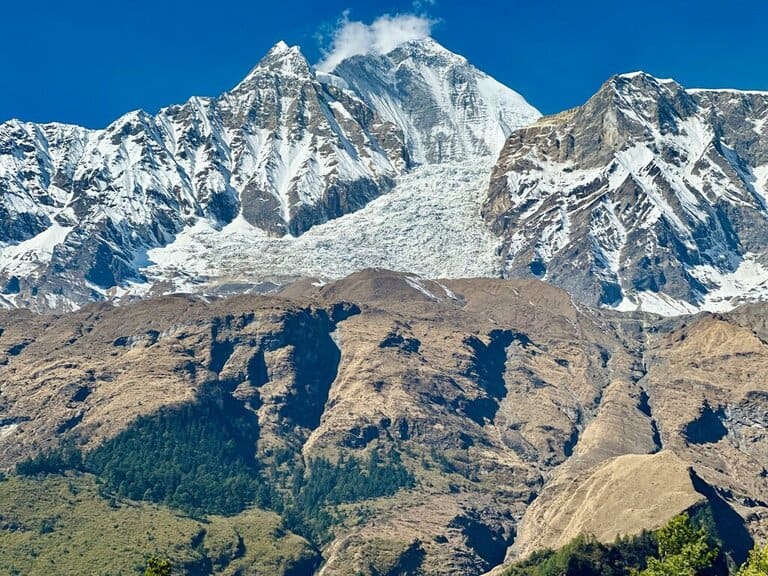
The Dhaulagiri Trek is an incredibly strenuous and challenging 18-day journey spanning approximately 180-200 km through extremely remote Himalayan trails.
Reaching maximum altitudes of 5,360m at French Pass and 5,200m at Dhampus Pass, trekkers explore diverse terrain from forests to glaciers and alpine meadows.
Major highlights include trekking to three base camps – Italian, Glacier, and Dhaulagiri, witnessing stunning landscapes, and taking in incredible views of Mt. Dhaulagiri (8,167m) – the 7th highest peak, along with other towering 7,000m+ mountains of the Dhaulagiri range.
This trek requires crossing the famed Hidden Valley between the high mountain passes and excellent fitness. For adventurous souls seeking breathtaking scenery away from crowded routes, Dhaulagiri offers outstanding Himalayan grandeur.
Brief Itinerary for Dhaulagiri Trek
- Day 2: Kathmandu to Beni
- Day 3: Beni to Babiyachaur
- Day 4: Babiyachaur to Dharapani
- Day 5: Dharapani to Muri
- Day 6: Muri to Boghara
- Day 7: Boghara to Dobang
- Day 8: Dobang to Italian Base Camp
- Day 9: Acclimatization Day at Italian Base Camp
- Day 10: Italian Base Camp to Glacier Camp
- Day 11: Glacier Camp to Dhaulagiri Base Camp
- Day 12: Acclimatization Day at Dhaulagiri Base Camp
- Day 13: Dhaulagiri Base Camp to Hidden Valley via French Pass
- Day 14: Hidden Valley to Yak Kharka via Dhampus Pass
- Day 15: Yak Kharka to Marpha
- Day 16: Marpha to Pokhara
- Day 17: Pokhara to Kathmandu
- Day 18: Departure from Kathmandu
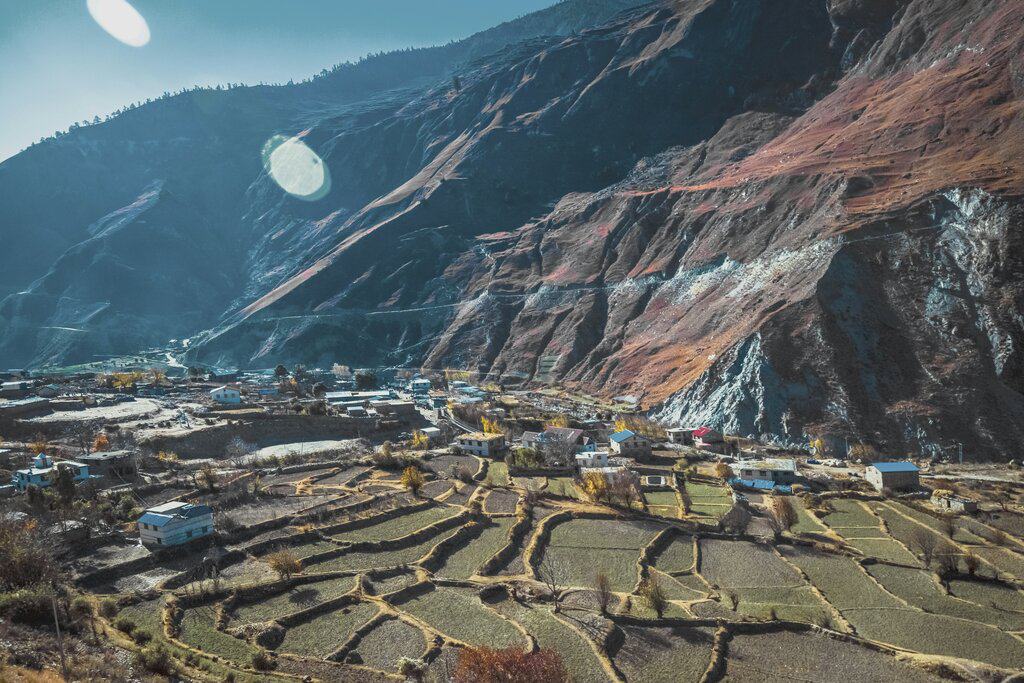
The Upper Dolpo Trek is an incredibly remote 23-day journey through the restricted and culturally preserved region adjoining Tibet. Trekkers experience authentic Tibetan Buddhist culture, crossing high passes like Kang La (5,350m) offering dramatic Himalayan vistas.
Major highlights include Shey Phoksundo National Park, turquoise Phoksundo Lake, charming ethnic villages, ancient monasteries, and chances to spot snow leopards.
This trek requires permits, guides, and self-sufficient camping amidst a dramatic landscape of the Tibetan plateau with no modern amenities. Upper Dolpo offers spirited travelers an off-the-beaten-path journey into Nepal’s untouched traveled trails.
Brief Itinerary for Upper Dolpo Trek
- Day 2: Kathmandu to Nepalgunj
- Day 3: Nepalgunj to Juphal, then trek to Chhepka
- Day 4: Chhepka to Amchi Hospital
- Day 5: Amchi Hospital to Phoksundo Lake
- Day 6: Acclimatization Day at Phoksundo Lake
- Day 7: Phoksundo Lake to Chunemba
- Day 8: Chunemba to Snowfields Camp
- Day 9: Trek to Shey Gompa via Kang La
- Day 10: Rest Day at Shey Gompa
- Day 11: Shey Gompa to Namgung via Shey La
- Day 12: Namgung to Saldang
- Day 13: Saldang to Sibu
- Day 14: Sibu to Lagmo Che
- Day 15: Lagmo Che to Tokyu via Jeng La
- Day 16: Tokyo to Dho Tarap
- Day 17: Dho Tarap to Sisaul
- Day 18: Sisaul to Laina Odar
- Day 19: Laina Odar to Lingdo
- Day 20: Lingdo to Dunai
- Day 21: Dunai to Juphal
- Day 22: Juphal-Nepalgunj-Kathmandu (Flight)
- Day 23: Departure from Kathmandu
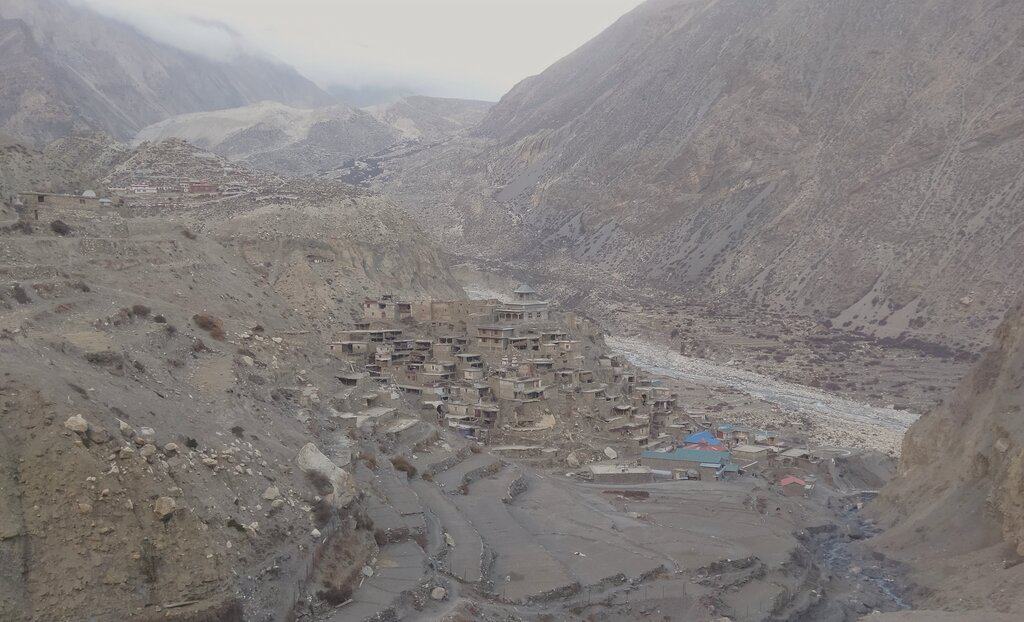
The Nar Phu Valley Trek is a challenging 18-day journey with a high point at Kang La Pass (5,322m). The trek begins from Jagat leading you through off-the-beaten-path adventure. Major stops include the remote Nar and Phu villages, Nar Phedi Monastery, and an optional Himlung Himal Base Camp trek.
This trek explores the pristine Nar and Phu valleys, offering a rare glimpse into the unique Tibetan culture and lifestyle of ethnic mountain communities.
Trek highlights are narrow canyons, enchanting forests, glaciers, amazing rock formations, high Himalayan peaks, and visits to ancient Buddhist gompas and chortens.
One of Nepal’s least-visited treks ( only opened in 2002), it provides an authentic cultural experience amid an arid landscape with excellent views of giants like Manaslu, Dhaulagiri, and Annapurna.
Brief Itinerary for Nar Phu Valley Trek
- Day 2: Drive from Kathmandu to Jagat
- Day 3: Jagat to Dharapani
- Day 4: Dharapani to Koto
- Day 5: Koto to Meta
- Day 6: Meta to Phu Village
- Day 7: Acclimatization Day in Phu Village
- Day 8: Phu Village to Nar Village
- Day 9: Acclimatization Day in Nar Village
- Day 10: Nar Village to Ngawal via Kang La Pass
- Day 11: Ngawal to Manang
- Day 12: Manang to Yak Kharka
- Day 13: Yak Kharka to Thorong Phedi
- Day 14: Thorong Phedi to Muktinath via Thorong La Pass
- Day 15: Muktinath to Jomsom
- Day 16: Fly to Pokhara
- Day 17: Drive back to Kathmandu
Best Treks in Nepal – Final Say
And that’s all there is to it. Based on your preference and experience level, you can decide on any of these 10 best treks in Nepal . Our hand-picked list of adventure treks showcases diverse trekking experiences.
Whether it be moderate trails or demanding high-altitude treks, this list suits a wide range of trekkers from beginners to experienced ones.
In addition, to make your trek hassle-free and convenient, booking with a reputable trekking agency is highly suggested. And thus you can enjoy the unparalleled trekking experience in Nepal.
Chris Heckmann
Cycling in the netherlands – everything you need to know, you may also like, alcohol in jordan – what to know before..., the 8 best bubble tent hotels in wadi..., the complete guide to red valley cappadocia, the ultimate 7 day jordan itinerary, floating in the dead sea in jordan –..., 5 reasons why you should visit cappadocia in..., the best places to see the balloons in..., the back entrance of petra – how to..., your complete guide to visiting the golden temple..., the complete guide to the everest base camp....
I appreciated the clear structure of your writing, making it easy to follow the flow of ideas. Your use of descriptive language painted a vivid picture on Nepal adventure tourism, allowing me to visualize the scene you were describing.
Thanks Basanta. But credit is due to my guest writer on this one. I only edited and published it!
Leave a Comment Cancel Reply
Save my name, email, and website in this browser for the next time I comment.
- Work With Me
- Netherlands
- Turks and Caicos
- United States
- New Zealand
- Netherlands Travel
- Custom Travel Planning
- Top 10 Lists
- Dutch Culture
- Indian Culture

Top 13 Best Treks in Nepal to Help you Choose The Right Trek for you
Written By: The Planet D
Updated On: June 20, 2023
Nepal is waiting to take you away from all the noise and chaos. It’s time to book a great adventure to the roof of the world deep into the heart of the Himalayas. From the Annapurna Circuit to the Everest base camp trek , Nepal it is the best trekking destination on earth and there is no better time to go than now.
Nepal is filled with amazing trekking routes outside the classic treks, and we asked our friend Dipendra of Simrik Nepal Treks to break down some of the best treks in Nepal. With his help and drawing from our experiences in Nepal, these are some treks to inspire you to run away from the noise and take you to the mountains. If you are planning a trip to Nepal, make sure to get in touch with Dipendra ( Deep ) to guide you through the Himalayan mountains.
Table of Contents
Best Treks in Nepal
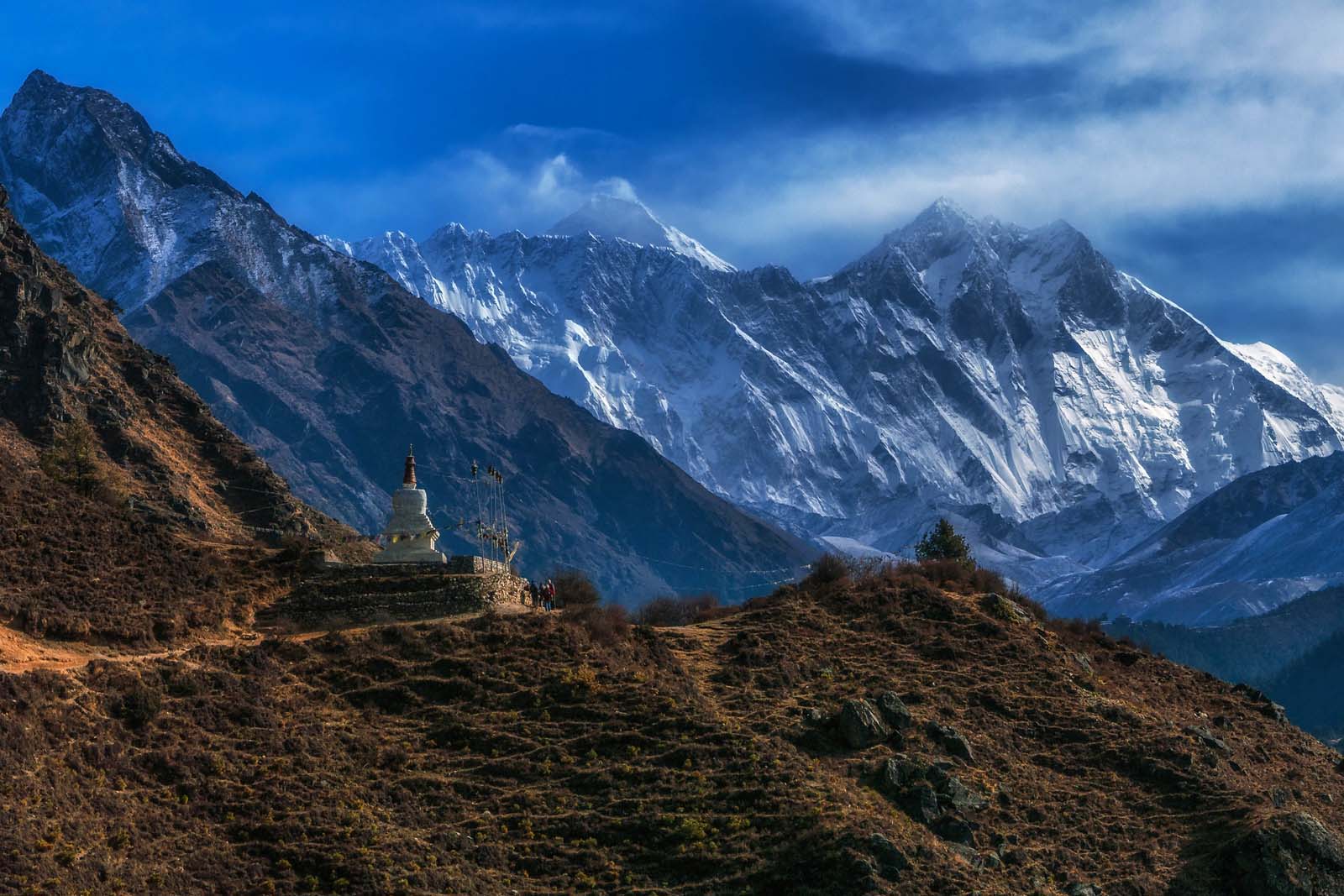
Whether you are an experienced trekker or just dipping your toes in, get ready for Nepal trekking to ignite the adventurer in you. With its awe-inspiring mountain scenery, friendly people, and well-planned mountain routes complete with lodges and teahouses, there’s a trek for you. If you feel that you’ve been cooped up in the house too long, now is the time to get outside and be at one with nature. We’ve broken down some of the most famous treks in Nepal to help you plan your trip.
Safe Trekking in Nepal – A Word
Trekking in Nepal can be risky and you need to weigh all factors before considering a high-altitude trek. If you are in moderately good shape, drink plenty of fluids, take it slow, and go down to lower altitude when you feel the signs of altitude sickness, you should be fine trekking through the most beautiful mountain ranges on earth.
1. Mount Everest Base Camp Trek
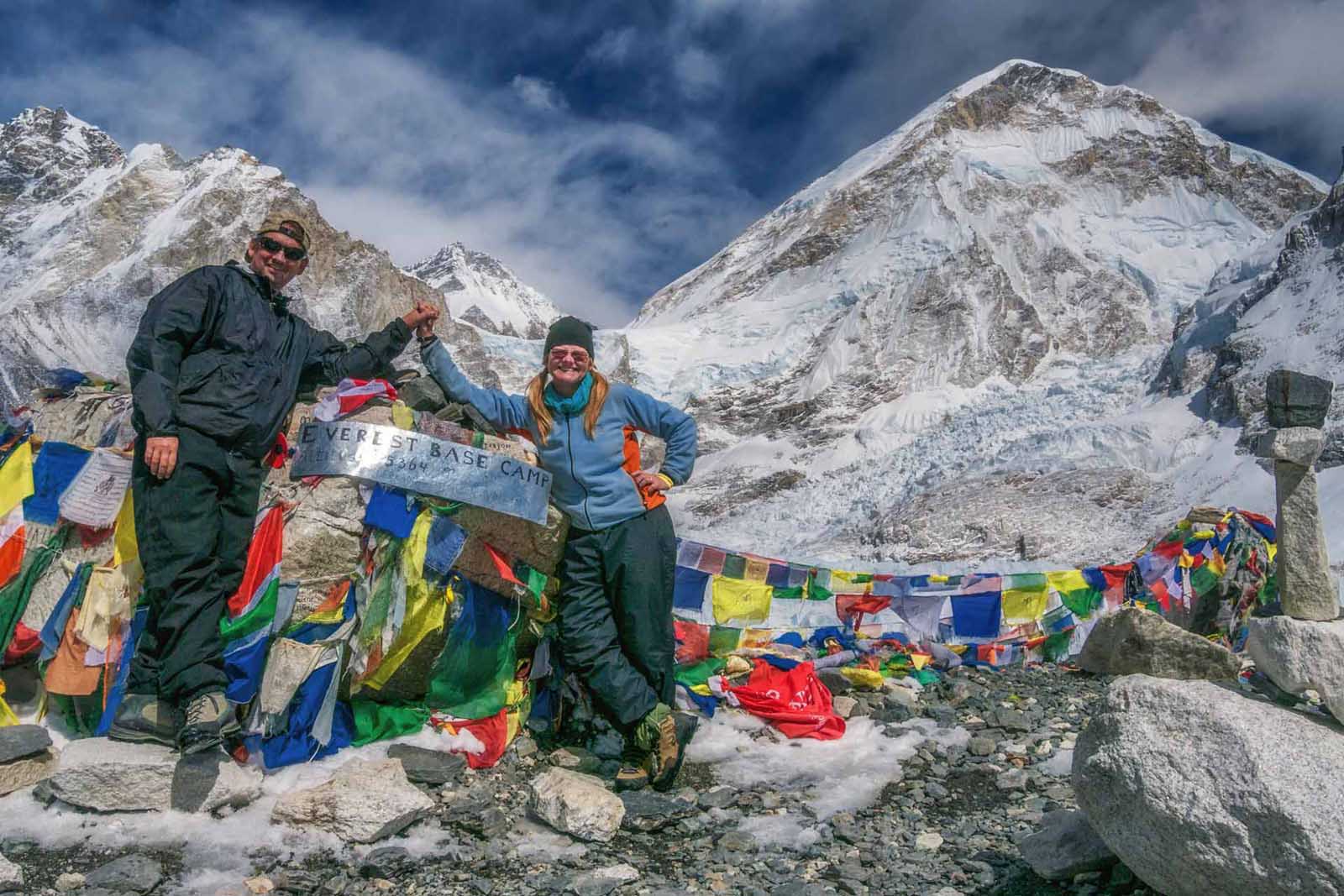
Everest Base Camp Trek is one of the most popular trekking routes in Nepal that offers several opportunities to view Mount Everest. This 16-day classic trek takes you from the streets of Kathmandu onto a scenic flight through the Himalayas to one of the highest airports in the world. The flight to Lukla is breathtaking where you’ll land at the Tenzing Hillary Airport to begin the most epic hike through Sagamartha National Park.
Lukla Airport
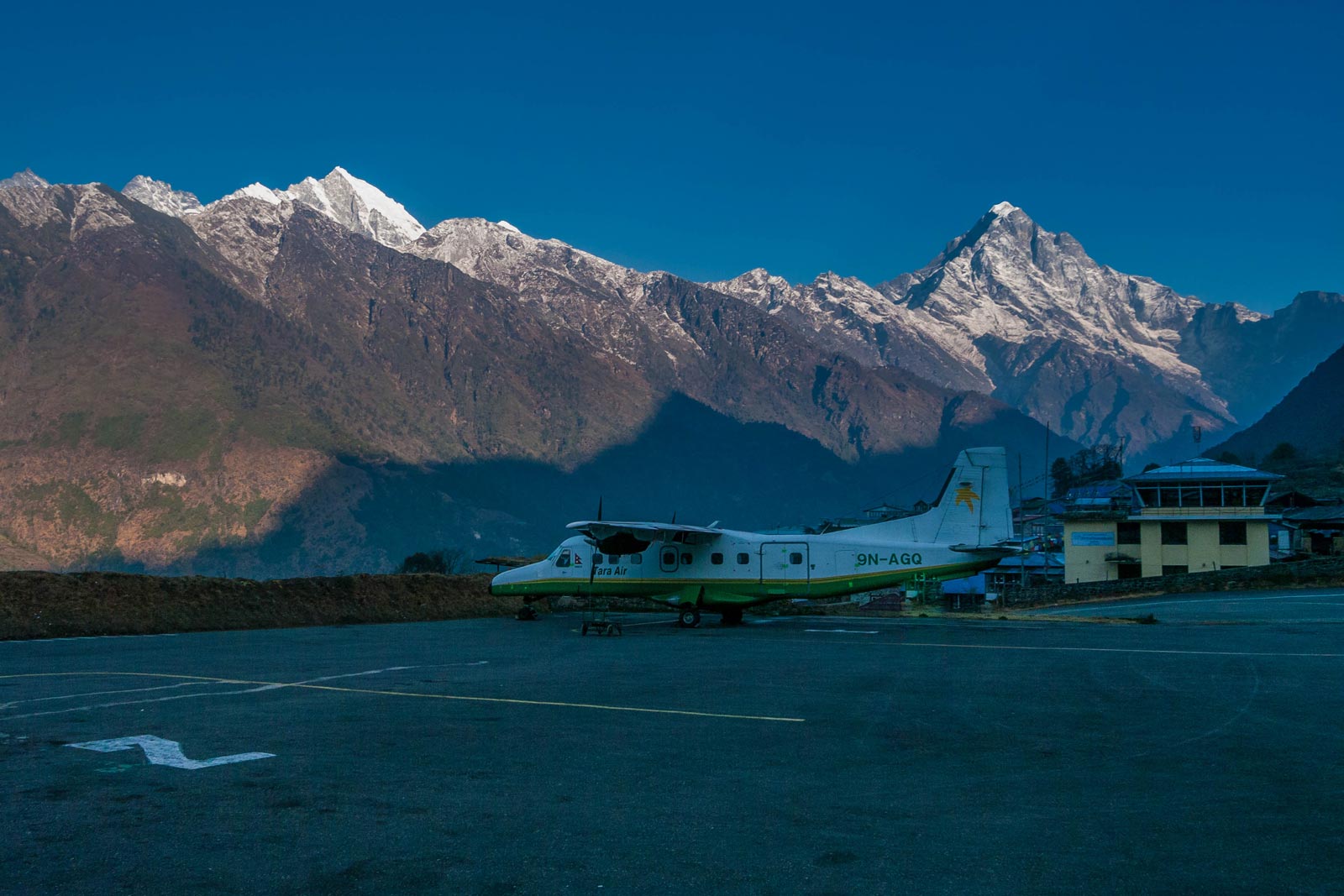
Walk in the footsteps of legends as you follow this classic trek to Everest Base Camp starting in Lukla. En Route you’ll visit Namche Bazaar, and Tengboche Monastery, cross breathtaking suspension bridges and take in awe-inspiring viewpoints of the highest mountains in the world including Lhotse, Changri, Ama Dablam, and Nuptse all standing tall at 8414m, 6027m, and 7861m.
They are the little sisters to the highest Mountain on earth and you’ll see that too! Everest stands at 8848 meters and one of the best views of all the high mountains together is from a viewpoint on your acclimatization day while staying at Namche Bazaar.
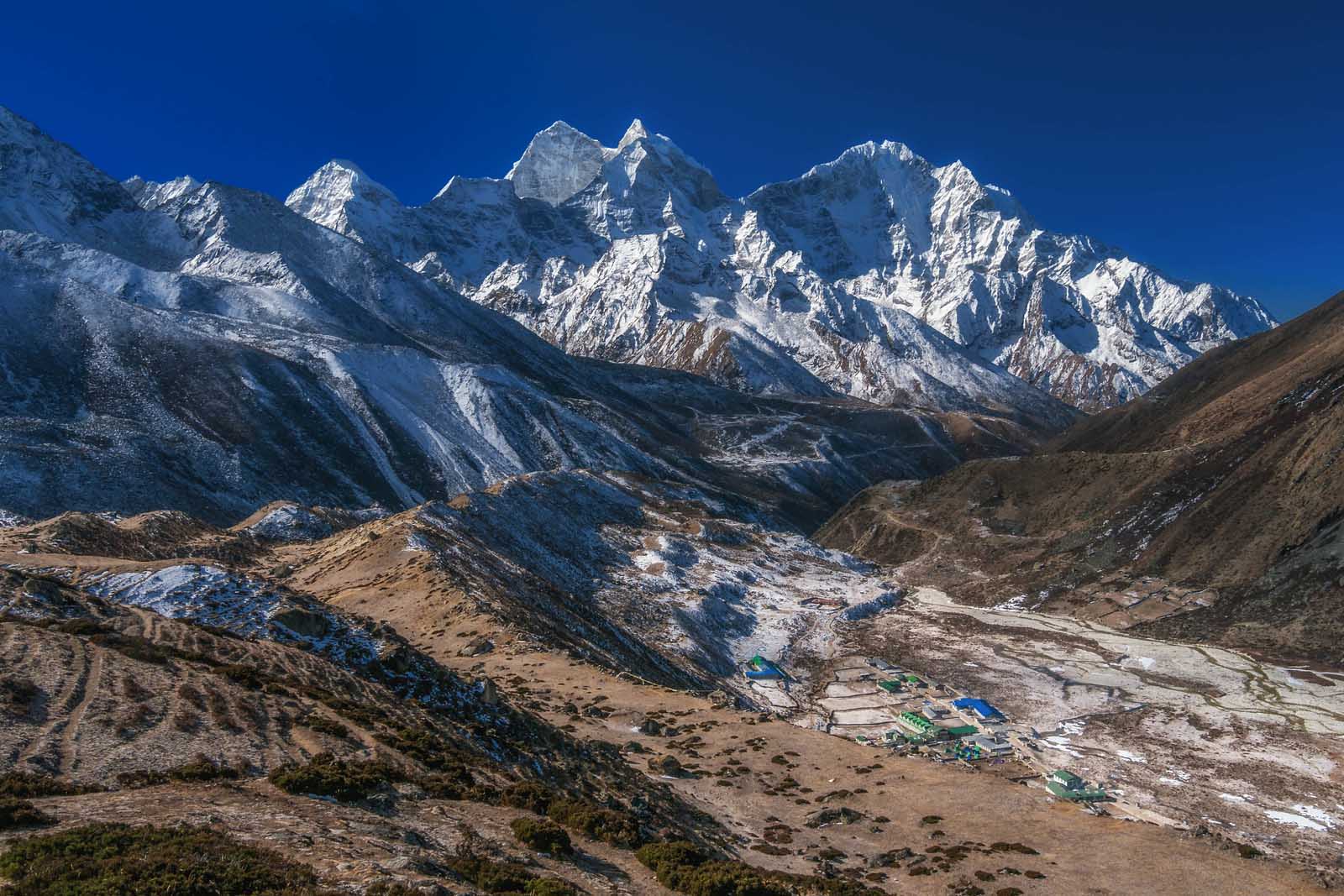
Mount Everest Base Camp is one of the more challenging treks in Nepal due to the fact that it is a hike through sustained elevation of Sagarmatha National Park. For most of the two-week hike, you’ll be trekking above 4000 meters as you make your way through the Everest region to Everest Base Camp.
You don’t need to carry tents as this is a teahouse trek, meaning you will stay in simple trekking lodges along the route. We have an entire breakdown of our trek here. For more information, you can contact our friend Dipendra (Deep) at Simrik Nepal Treks.
- Trek Duration : 13 days
- Max Elevation: 5,140m
- Start: Lukla
- Trekking Difficulty: Challenging
- Accommodation Type: Teahouse
- Best Season to Trek: March – May & Sept – Dec
Kala Patthar – A Good Addition to EBC
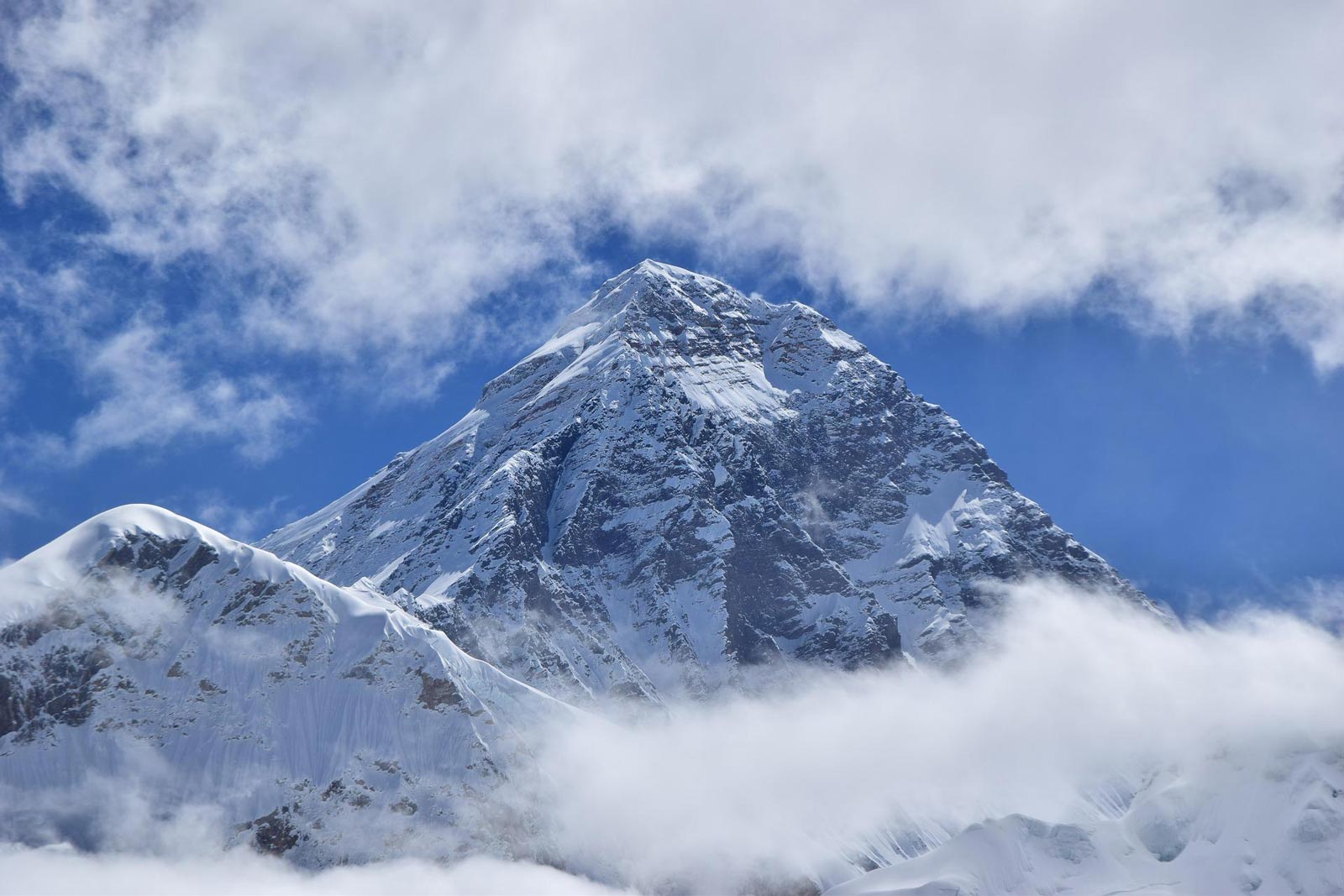
If you want to add a short trek to your base camp trek, Kala Patthar is a quick two-hour trek to add on to your descent back to Lukla. It is a good option if you are feeling up for it as it gives a great view of Everest. From base camp you don’t actually see Mount Everest, so Kala Patthar is a great addition. This is one of the best views of the peak of Everest and the surrounding stunning mountain scenery. I really don’t think I have ever witnessed more spectacular scenery than the Himalayas of Nepal.
Kala Patthar is a hill above the village of Gorak Shep that offers the best view of the highest mountain in the world and is a must-stop on anyone’s EBC trekking route. We didn’t get the chance to climb this as I (Deb) started to suffer from congestion. At this altitude, you never want to push yourself beyond your means because illness can turn deadly quickly.
- Everest Base Camp Trek – Guide to Sagarmatha National Park
Everest Base Camp Trek in Photos
- Flight to Lukla – A Scary Thrill Ride to Everest
- Tips for Planning and Trekking to Everest Base Camp
2. Three Passes Trek
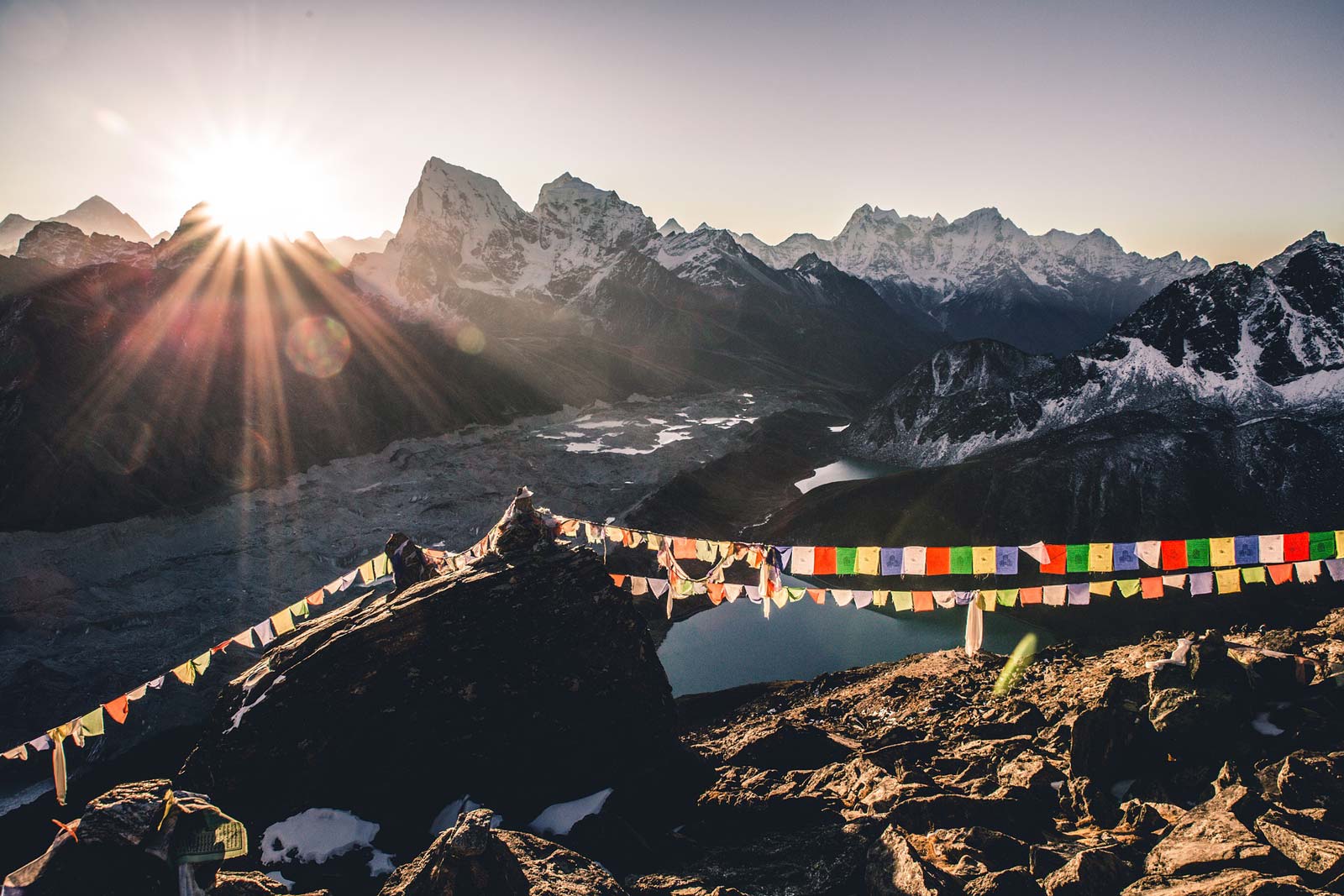
If you want to make your Everest Base Camp Trek even more challenging, add the Three Passes Trek to your trip. The Three Passes Trek is the most challenging trek in the Everest Region that takes you through three high passes, Kongma La Pass, Cho La Pass, and Renjo La Pass (all over 5000 meters) hence the name, Three Passes trek. Following the route of Everest Base Camp, it splits off part way through to take you around to the three passes and Gokyo Lakes before meeting up with the EBC route again at Lobuche.
This is a challenging trek that showcases the beauty of the Everest Region including the Gokyo Lakes and some of the highest mountain peaks. From Gokyo Ri, you’ll see four of the six highest peaks in the world including Mount Everest, Lhotse, Makalu, and Cho Oyu. Trekking across the Chola Pass connects the Gokyo Region with the Everest Region and is one of the best treks in all of Nepal.
- Trek Duration: 17 days
- Max Elevation: 5,555m
- Accommodation Type: Teahouse Trek
- Best Season to Trek: Feb to May and Sep to Dec
3. Annapurna Base Camp Trek
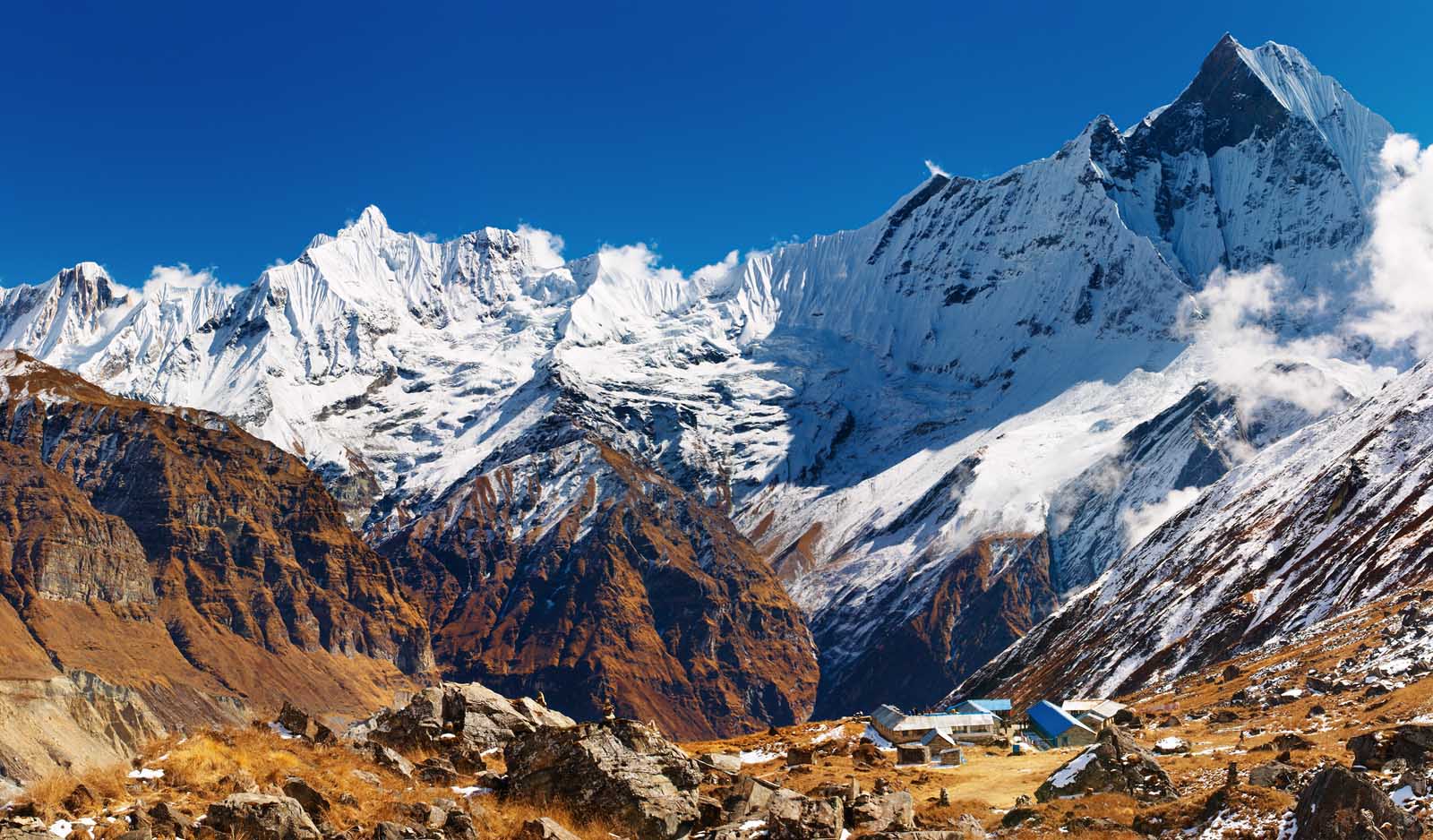
The Annapurna Base camp Trek has been a longtime favorite of backpackers in Southeast Asia and it remains one of the most popular treks in the Annapurna region. This trek takes you to the adventure town of Pokhara which is filled with restaurants and guest houses lining the quiet lake. You can fly to Pokhara from Kathmandu but you can also take a bus. We took the five-hour bus ride ourselves. From Pokhara, you then take a truck to Dhampus which is one hour away.
The Annapurna Base Camp trek is unique in the fact that it starts in a lush jungle that changes before your eyes to a rocky landscape leading to nearly vertical peaks and snowcapped mountains of the Annapurna Range.
The trek begins in forests and takes you on a journey through river crossings, moorlands, glaciers, and stunning vistas of the Annapurna Range. You’ll trek through remote villages while coming across passing mule trains on high mountain passes. Check out prices and more details for trekking throughout the Annapurna Sanctuary at Simrik Real Nepal. Find out more about this trek Trek at SimrikNepalTreks
- Trekking Difficulty – Moderate
- Trek Duration – 14 days
- Max Elevation 4210 Meters
- Start – Tikhedhunga
- Accommodation Type – Teahouse
- Best Season to Trek – March-May & Sept-Dec
4. Annapurna Circuit Trek
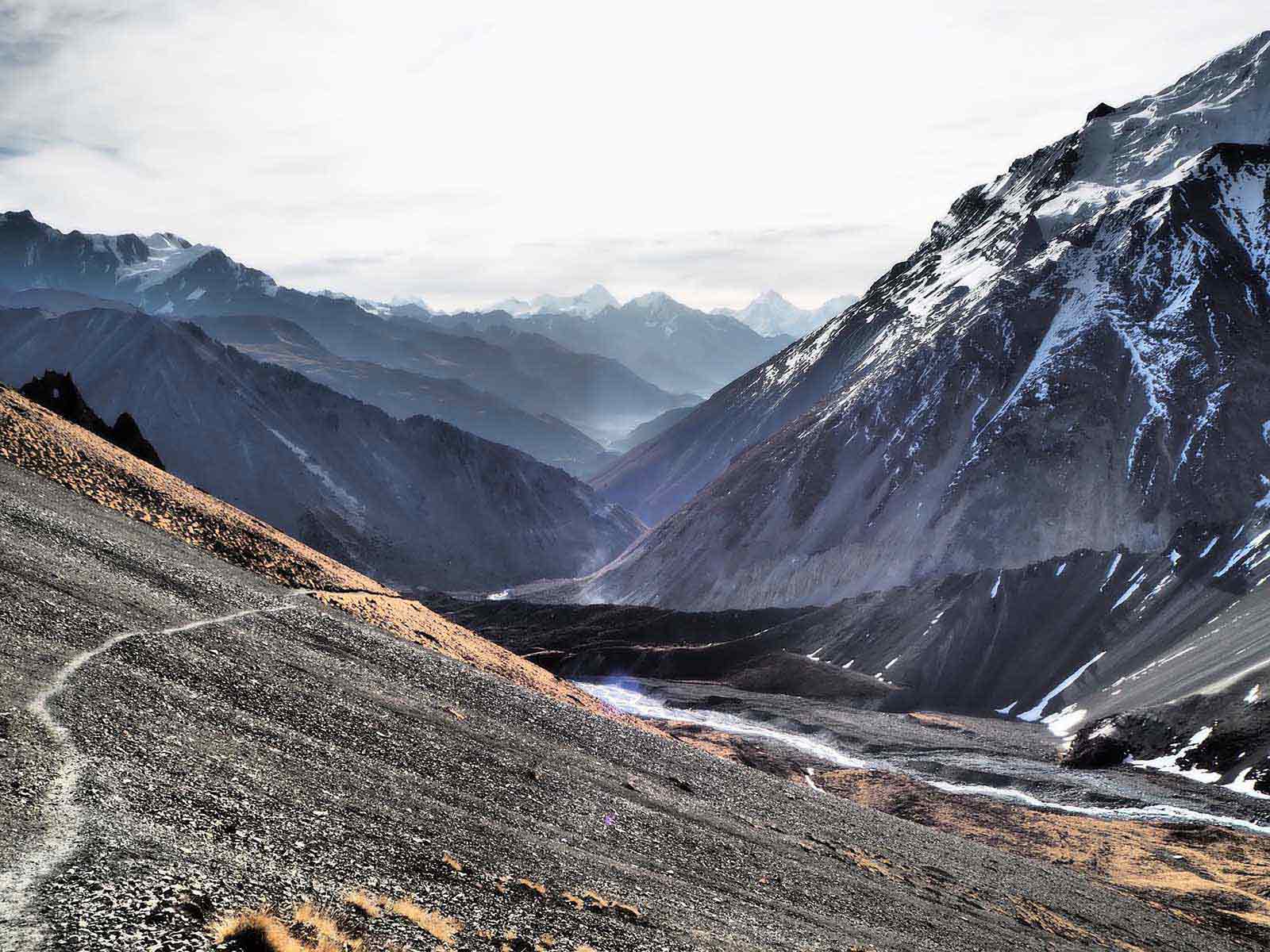
The Annapurna Circuit Trek is another classic Himalayan trek in Nepal taking you through waterfalls and pine forests as you make your way up to the more rugged terrain of the Annapurna Massif. This trek circles the Annapurna Range containing 13 majestic mountain peaks reaching over 6000 meters including and Mt. Nilgiri, Tilicho peak, Annapurna south, and the highest mountain in the Annapurna Region, Annapurna which stands at 8,091 meters high.
Annapurna Circuit is still one of the most popular treks in Nepal due to the fact that is offers a little bit of everything. On this multiday trip, you’ll trek through rice terraces, forests and Nepalese mountain communities. One of the highlights of this Nepal trek is having the opportunity to interact with the local communities that inhabit the Annapurna region. This is a well-traveled route that has seen a lot of development, but it still offers the same scenic beauty it always has. See more details here.
- Trekking Difficulty: Moderate
- Trek Duration: 12- 21 Days
- Max Elevation: – 5416 metres
- Start: Besisahar
- Best Season to Trek – March – May & Sept – Dec
5. Poon Hill Trek
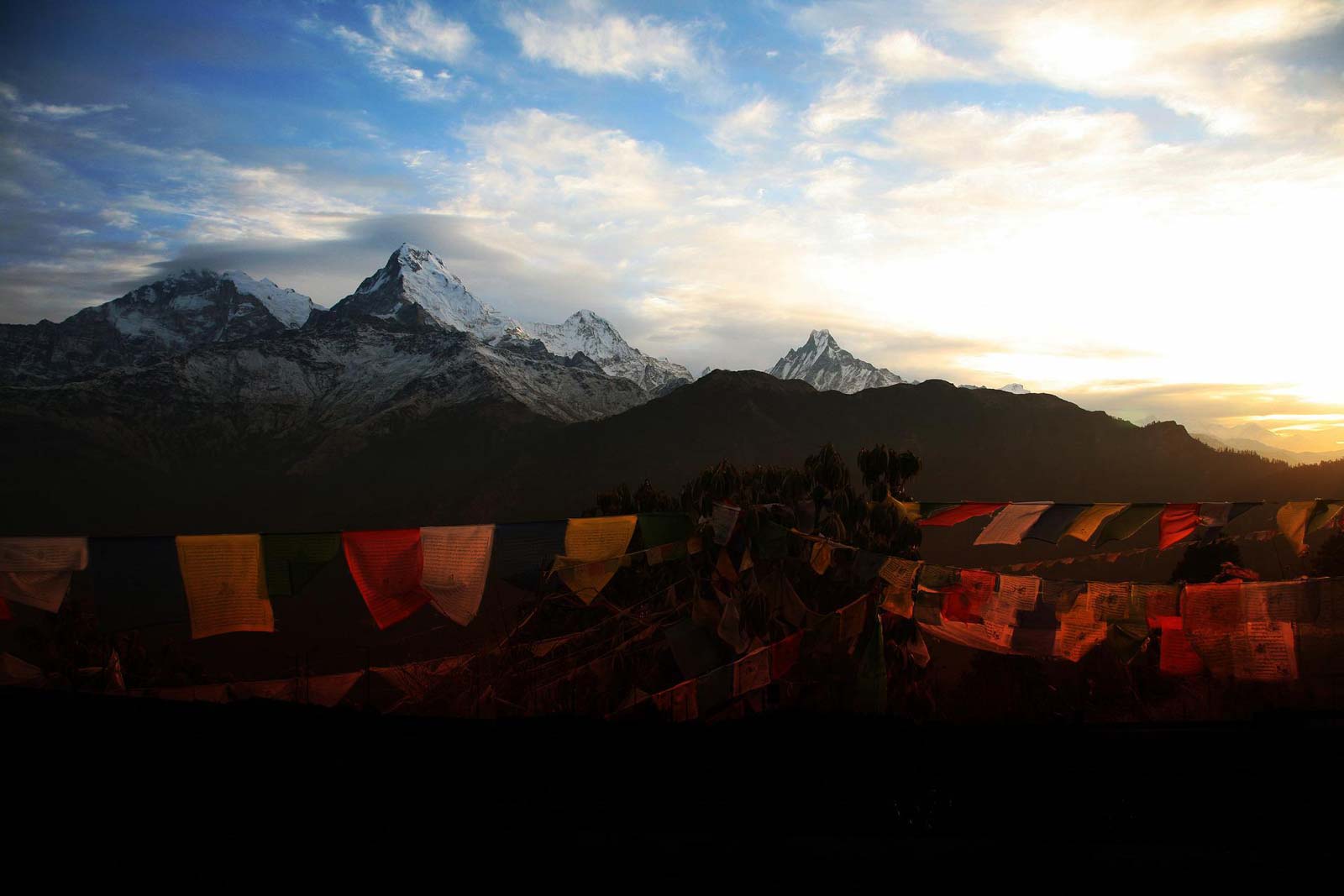
Another popular trek in the Annapurna Sanctuary is the Poon Hill Trek. If you have a short amount of time, the Poon Hill Trek is a great trek to choose as it takes only a few days. It is often combined with the Annapurna Base Camp, but it is a trek in its own right.
It begins with a bus ride to Pokhara where you’ll catch a jeep to Ghandruk. Poohhill has well-maintained trekking lodges along the route with Wifi and even hot showers. The trek to the Poon Hill lookout may be short, but it offers amazing views of the Annapurna range as well as the Dhaulagiri massif. (Dhaulagiri is the 7th highest mountain in the world standing tall at 8,167 meters (26,795 ft).
Dipendra offers 7 day itineraries from Kathmandu. This includes a day in Pokorah, Tikedhunga, Ghorepani and a trek back to Pokarah via Nayapu. We spent a few days chilling in Pokhara and it’s worth a trip even if you don’t go do a high Annapurna Sanctury trek. It’s a great short trek if you’ve done one of the other treks in the country and want a taste of the Annapurna Sanctuary.
- Trek Duration: 3 days
- Max Elevation: – 3210 metres
- Accommodation Type – Teahouse Trek
6. Manaslu Circuit Trek
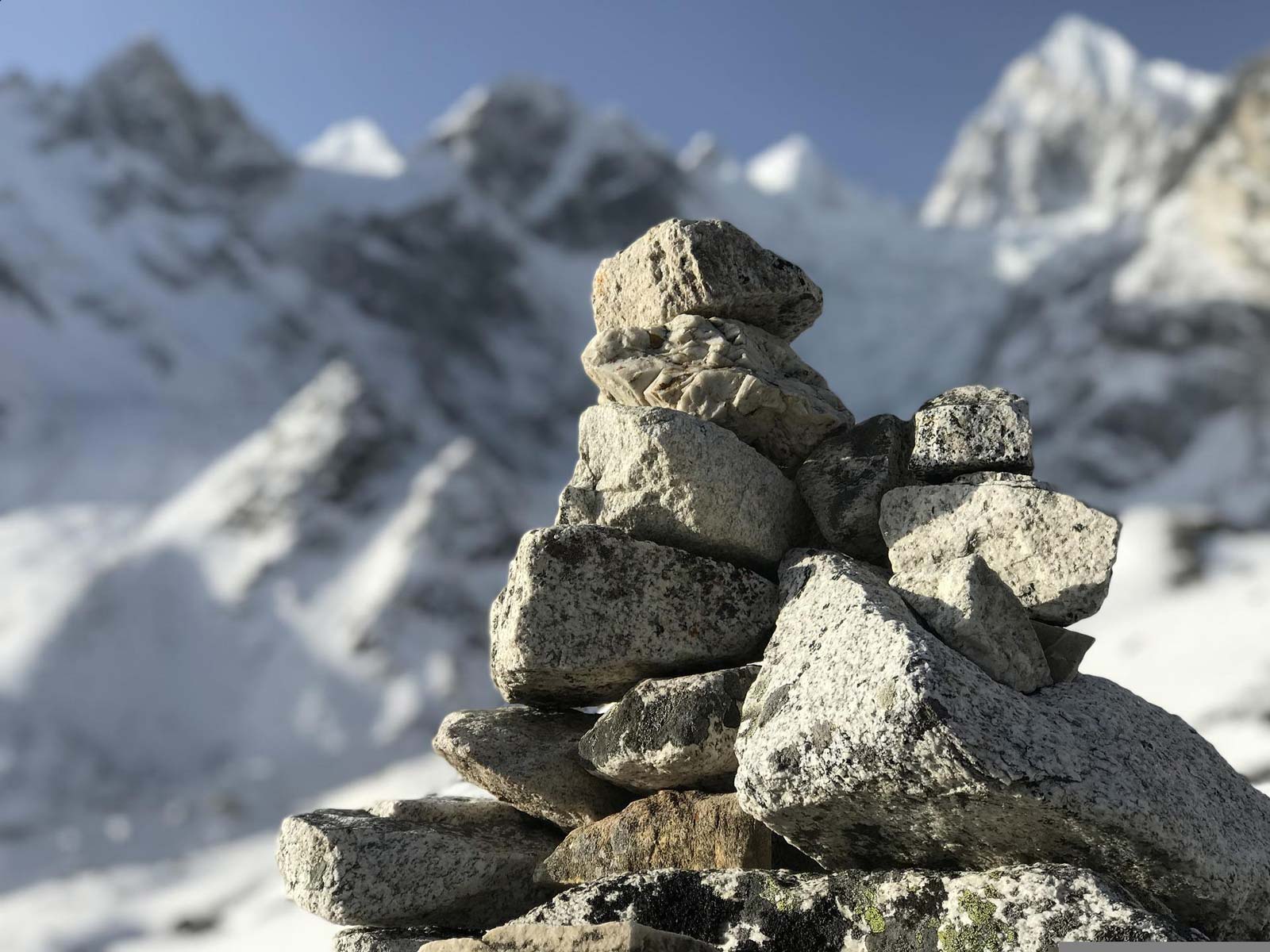
Located along the border of Nepal and Tibet, this gem of a trek takes you off the beaten path to a land of beauty. Seeing fewer trekkers on the trail makes the Manaslu Circuit Trek one of the best treks in Nepal. Many people compare this trek to the Annapurna Circuit before it became crowded and overly developed.
The Manaslu Circuit trek has everything you could want out of a trek in Nepal with cultural immersion, high Himalayan peaks and mountain views, plus the classic teahouses we have all come to know so well in Nepal. Manasulu is the eighth highest peak in the world. Plus, you don’t need to fly to the base of the Manaslu circuitTrek, you can take the bus or hire a private vehicle from either Kathmandu or Pokhara. See more details at SimRik Real Nepal
- Trekking Difficulty – Difficult
- Trek Duration – 16 days
- Max Elevation – 5220 Meters
- Start – Arughat Bazar
- Accommodation Type – Teahouse Trek (but lodges are limited so camping equipment may be required)
- Best Season to Trek – May & Sept through to December
7. Upper mustang trek
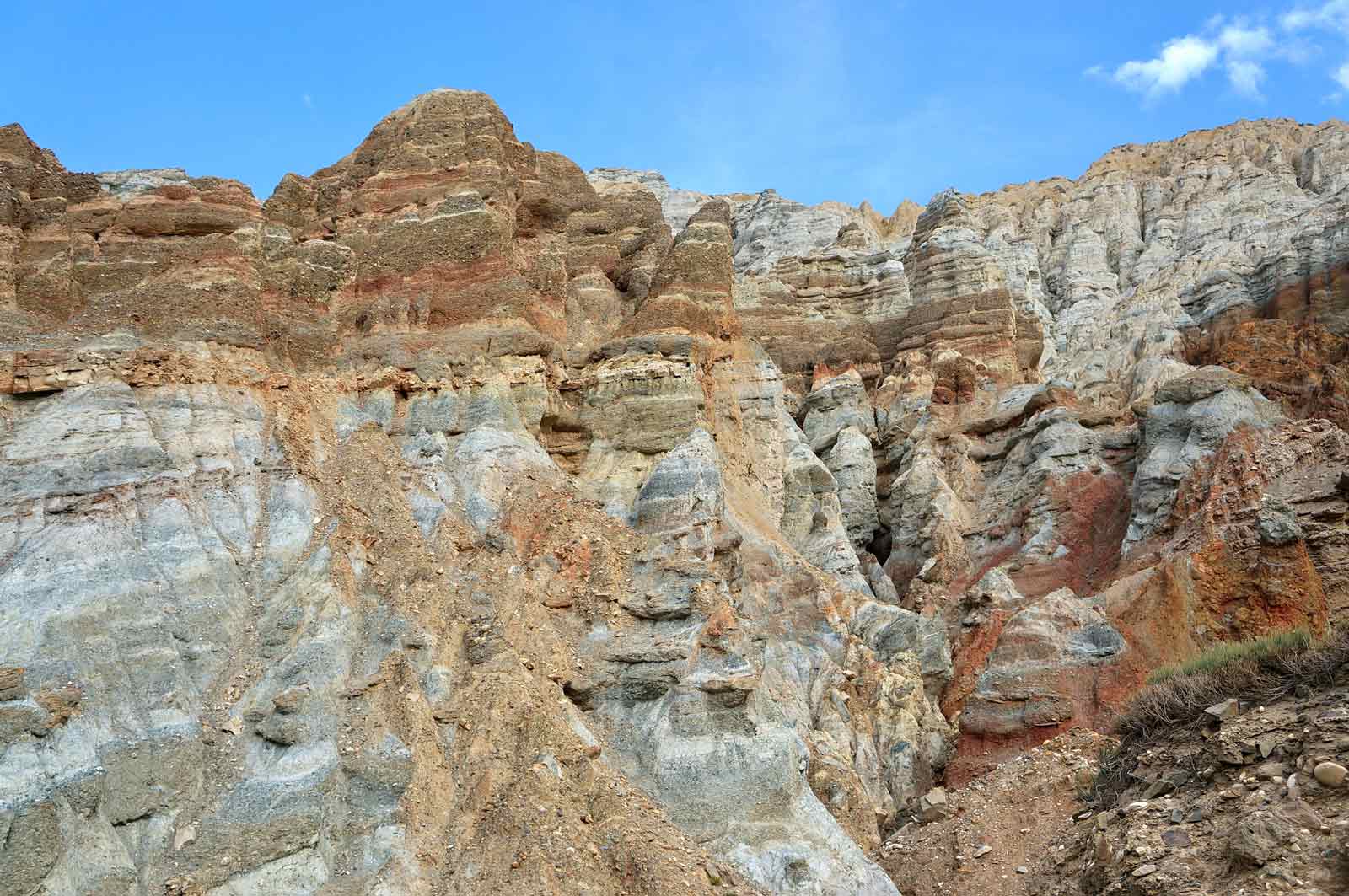
Upper Mustang is known as the ‘Last Forbidden Kingdom.’ and is one of the best hikes in Nepal to experience the culture of ancient Buddhism. This area only opened to foreigners in October 1991 and the trek only allows a limited number of trekkers.
The Upper Mustang Trek starts in the upper corner of the Annapurna Circut and takes you through undisturbed Tibetan Buddhist villages that have long been isolated from the outside world. While it is opening up, Upper Mustang is still one of the more remote trekking routes in Nepal and a special permit is required. However, that is changing quickly as trucking routes are being developed.
After flying into Pokorah you’ll spend a day enjoying the valley before making your way to Jomsom where the Upper Mustang trek starts. The trail follows the ancient salt caravan route where you can expect to hike 6- 7 hours per day through trails that pass through desert-like and rocky conditions. En route you will see everything from barren highlands of the Himalayan desert to snow capped peaks. The turnaround point is Lo Manthang which is a Himalayan village in the only semi-desert in Nepal known for its whitewashed mud-brick walls, the Royal Palace, and Buddhist monasteries and fortifications. Contact our friend Deep at Simrik Real Nepal for more details.
- Trek Duration – 11 Days
- Trekking Difficulty – Moderate to Difficult
- Max Elevation – 4210 meters
- Start – Jomsom
- Accommodation Type – trekking lodges (Tea houses)
- Best Season to Trek – March – December
8. Upper Dolpo Trek
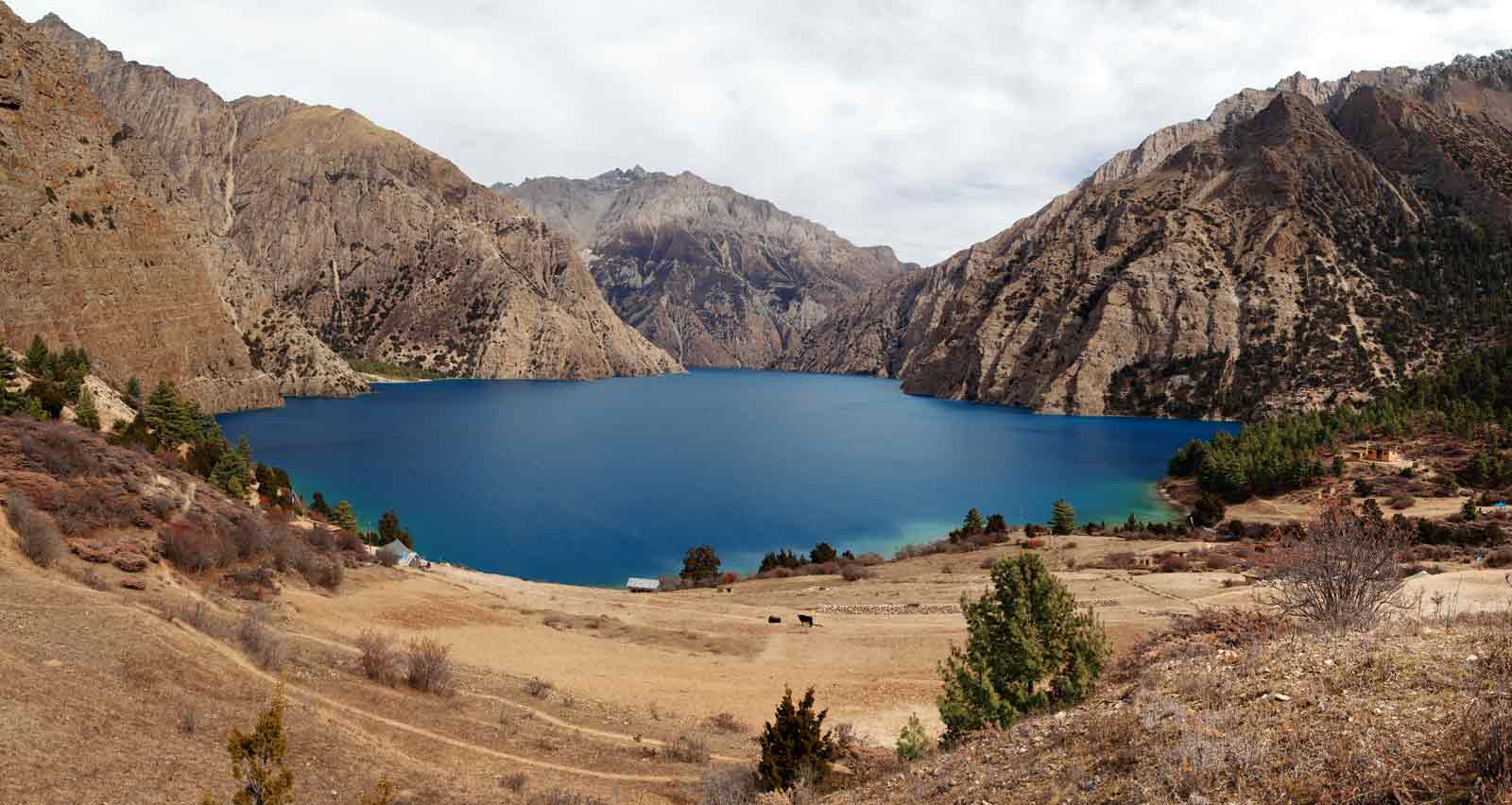
The Upper Dolpo trek is one of the most rewarding treks in Nepal with its high passes, turquoise lakes including Shey Phoksundo lake, the deepest lake in Napal. Trek through this remote setting in Nepal’s largest national park,She-Phoksundo National Park to view its deep valleys and high mountains of the Annapurna Range including and the 800-year-old Shey Monastery.
Located between the Tibetan plateau and the Dhaulagiri ranges, the Upper Dolpo Trek takes you through Shey-Phoksundo National Park. En route, you’ll meet the nomadic people who dwell in Tibetan style villages while immersing in their culture. Following this ancient salt trading route, you’ll stop at Buddhist monasteries, make way for yak caravans and maybe even spot the elusive snow leopard. The Dolpo Trekking trail will take you through forested areas and to the barren plateau close to the Tibet border where trekking tourism is in its infancy.
Upper Dolpo was the location for the movie Himalayas, which was nominated for an Oscar and was the inspiration for the book, the Himalayan Leopard by Peter Mattessian. See further details at Simrik Nepal
- Trekking Difficulty: Difficult
- Trek Duration: 19 days
- Max Elevation: 5190 Meters
- Accomodation Type: Mountain lodges and camping
- Best Season to Trek: May to September
9. Mera Peak Climb
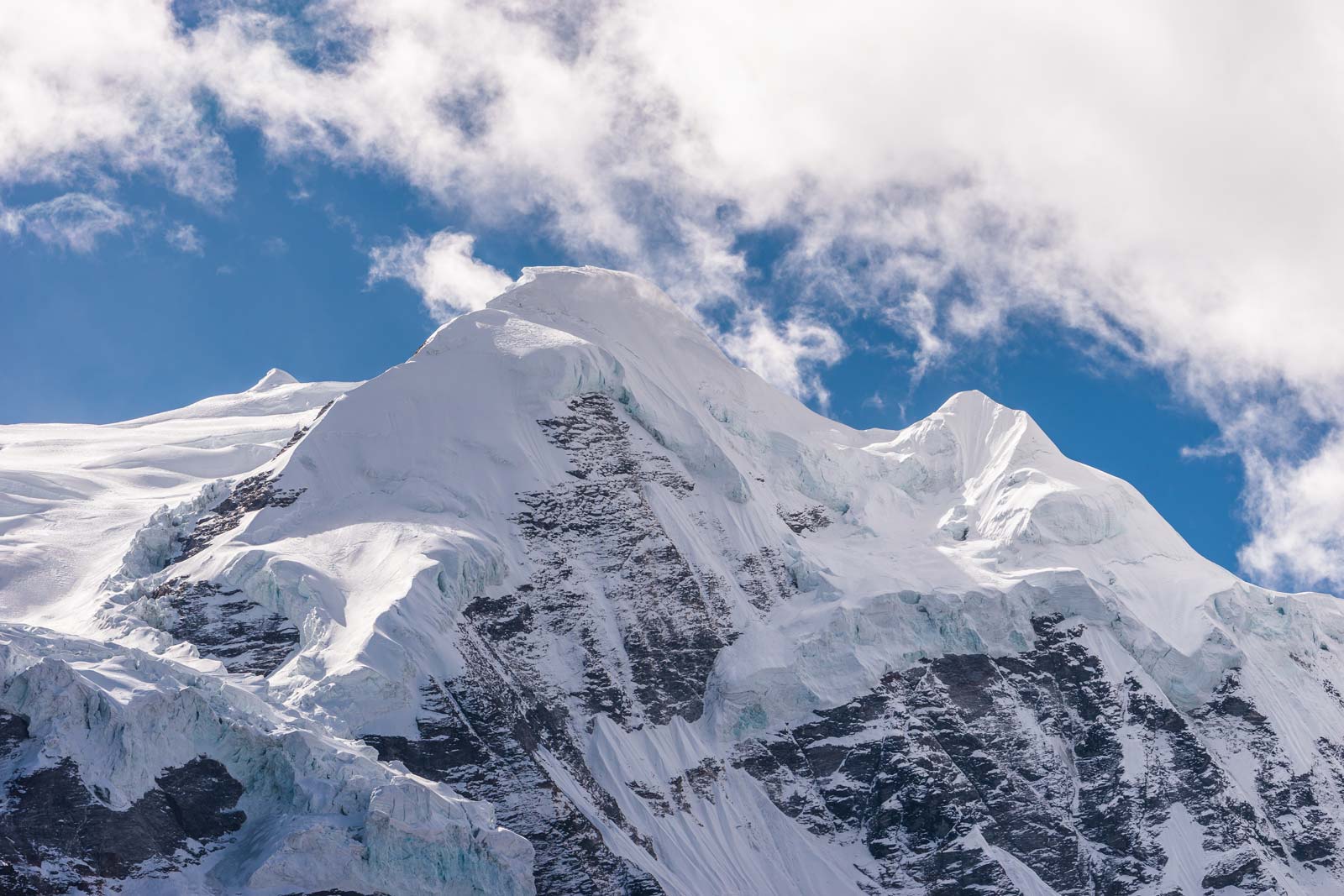
Located in the Everest Region of Nepal, Mera Peak is the highest mountain trekking peak climb in Nepal. Trekking peak climb means that it is a mountain summit climb that requires little technical climbing skills. Even though it doesn’t require many technical skills, it is still a very strenuous trek reaching a height of 6476m and you do need some experience.
For the Mera Peak trek, you’ll need to know how to walk in crampons, and to use a snow ax. You’ll also be attached to a safety line, so you need to know how to clip into a rop safely. So be prepared. But this trek involves camping, so sold weather camping on snow is expected. More details here
- Max Elevation: 6,654 Meters
- Accommodation Type: Teahouse and Camping
10. Island Peak Climb
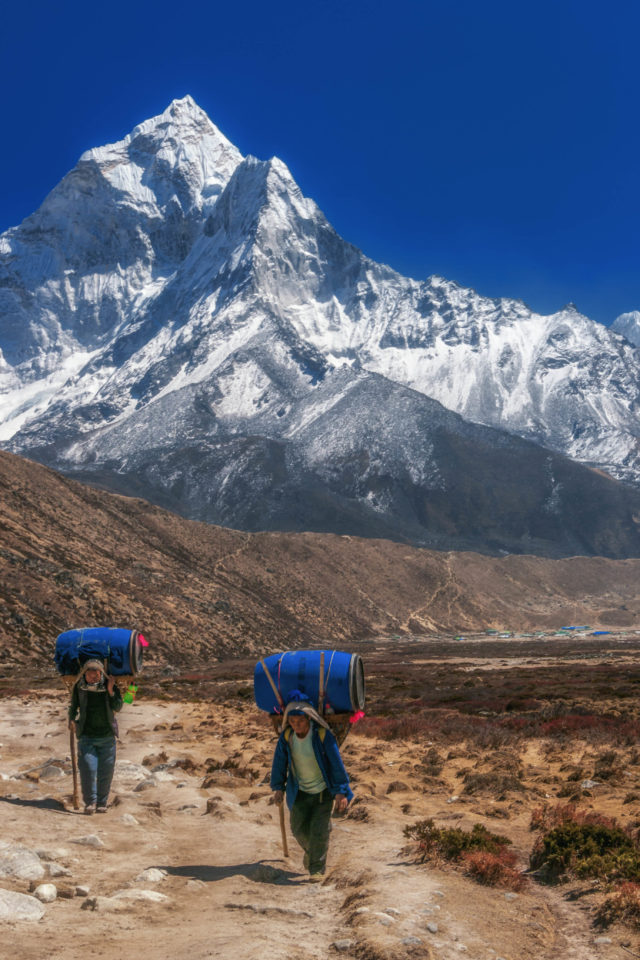
Island Peak is located in the Mount Everest region and this challenging trek takes you through Khumbu, Gokyo, and Everest Base Camps. The Island Peak Climb is another opportunity to climb a peak in Nepal with limited alpine experience. This climb takes you across the Chola Pass and Kongma La Pass as you ascend from the Lhotse glacier to Gokyo RI and Kala Pattar. Get more details here
- Max Elevation: 6,189 Meters
- Best Season to Trek: March and May and also September to December.
11. Kanchenjunga Trek
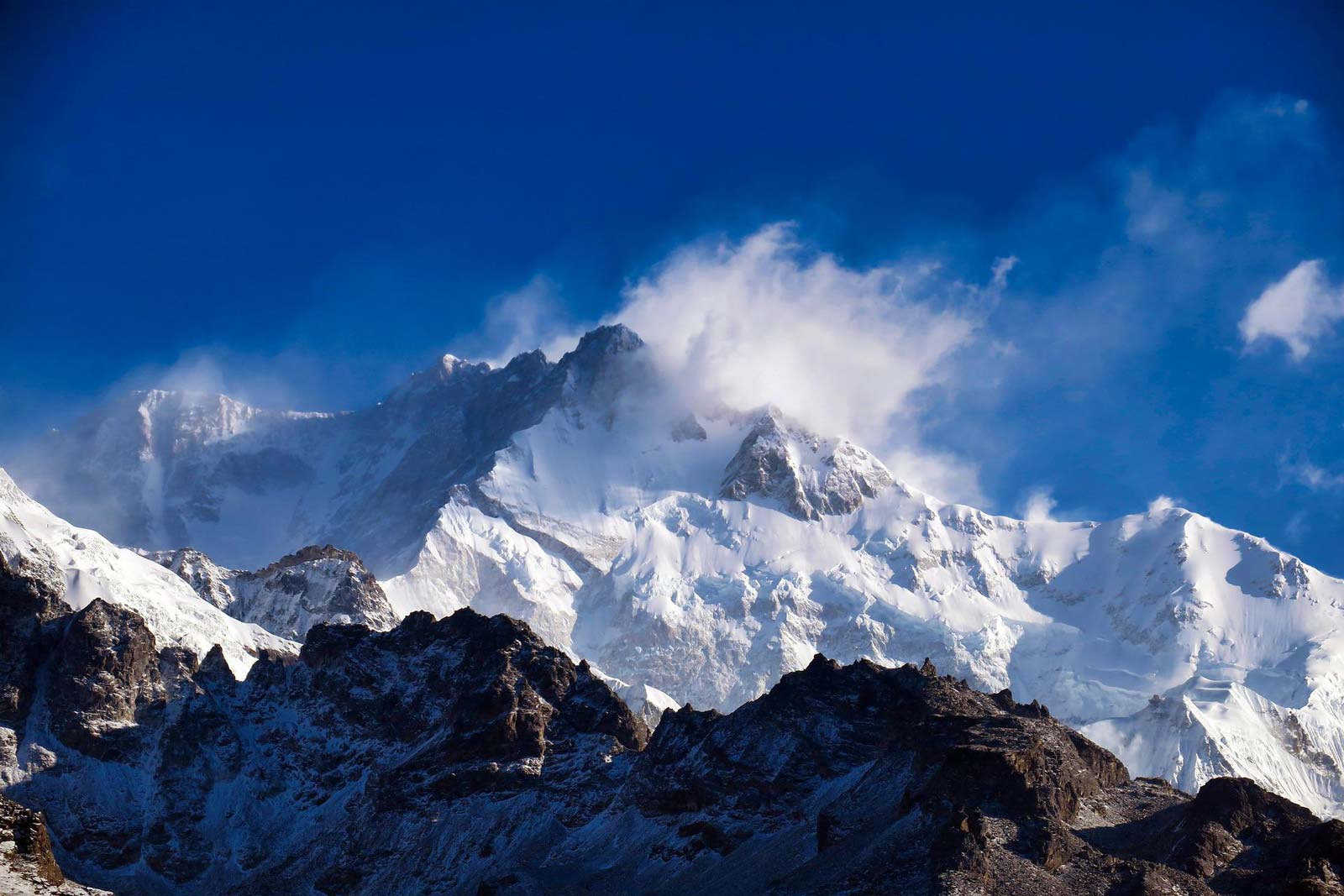
This trekking destination takes you to the third highest mountain in the world. Kanchenjunga is dubbed “the gift of the earth”, and this trek passes through subtropical forests, captivating villages, and mountaintop grasslands and has fantastic views of snowy peaks such as Pyramid Peak, Twin Peak, and of course, Kanchenjunga Peak. Located in the far eastern region of the country, it shares its border with Sikkim, India. See more details for booking here
- Trek Duration: 27 Days
- Max Elevation: 5150 Meters
- Start: Suketar
- Difficulty: Challenging
- Accommodation Type: Camping and Teahouse
12. Makalu Base Camp Trek
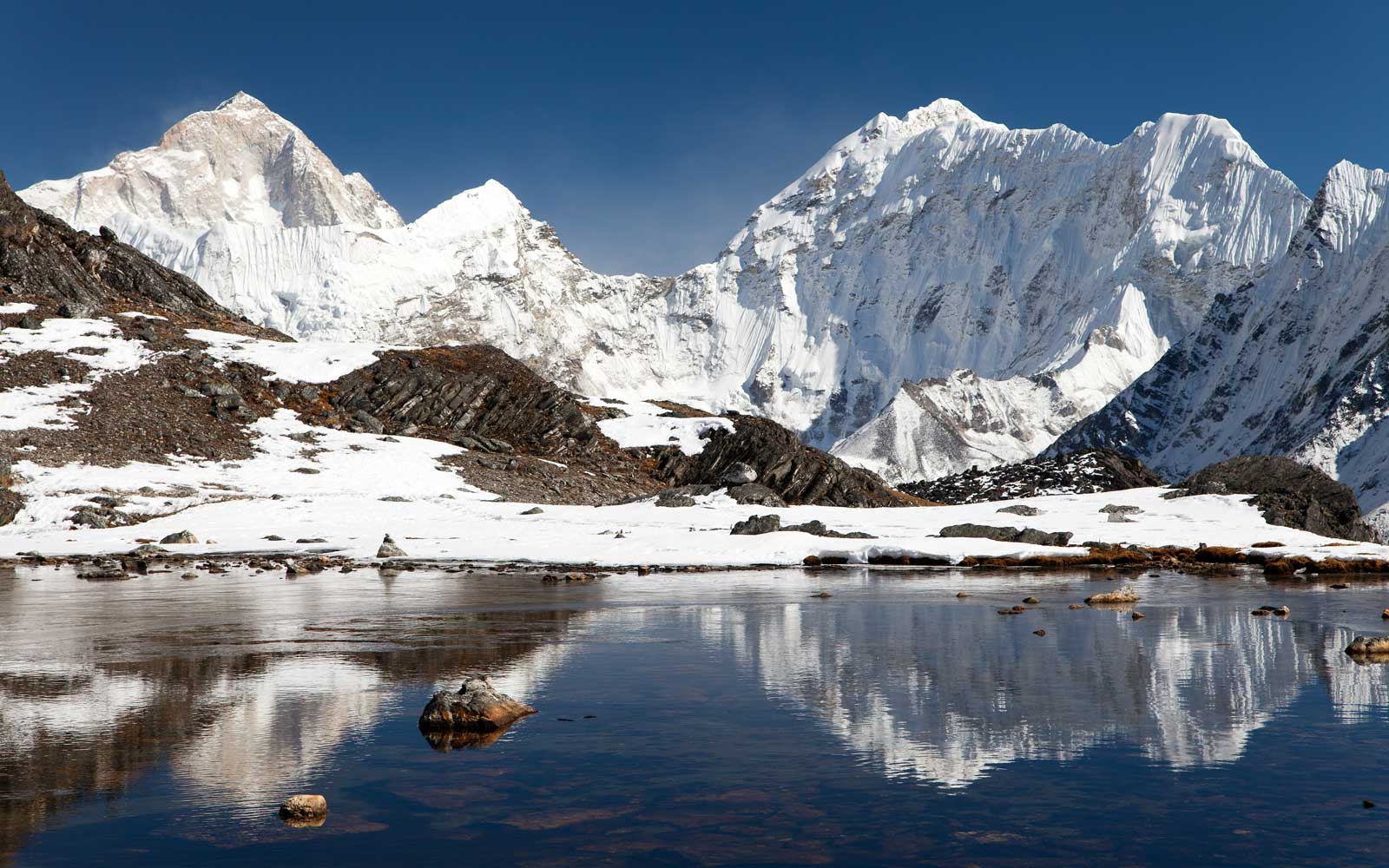
The Makalu Base Camp Trek is one of the most challenging treks in Nepal taking you deep into the heart of the Himalayas. This trek is for experienced trekkers as it is a hike that has a sustained period of high altitude. Part challenging trek, part cultural trek, the Makalu Base Camp Trek takes you through rural villages of the Rai People and terraced farmland.
As you gain altitude, you’ll come across Sherpa and Bhotia villages living life as they have for centuries. One of the treats of this trek is that few foreigners venture to this off the beaten path trek in Nepal to see its unique perspective with different views of some of the highest mountains including the Kangshung face of Everest. See details here.
- Trek Duration: 23 days
- Max Elevation: 5,220 m
- Start: Tumlingtar
13. Gaurishanker Himal Trek
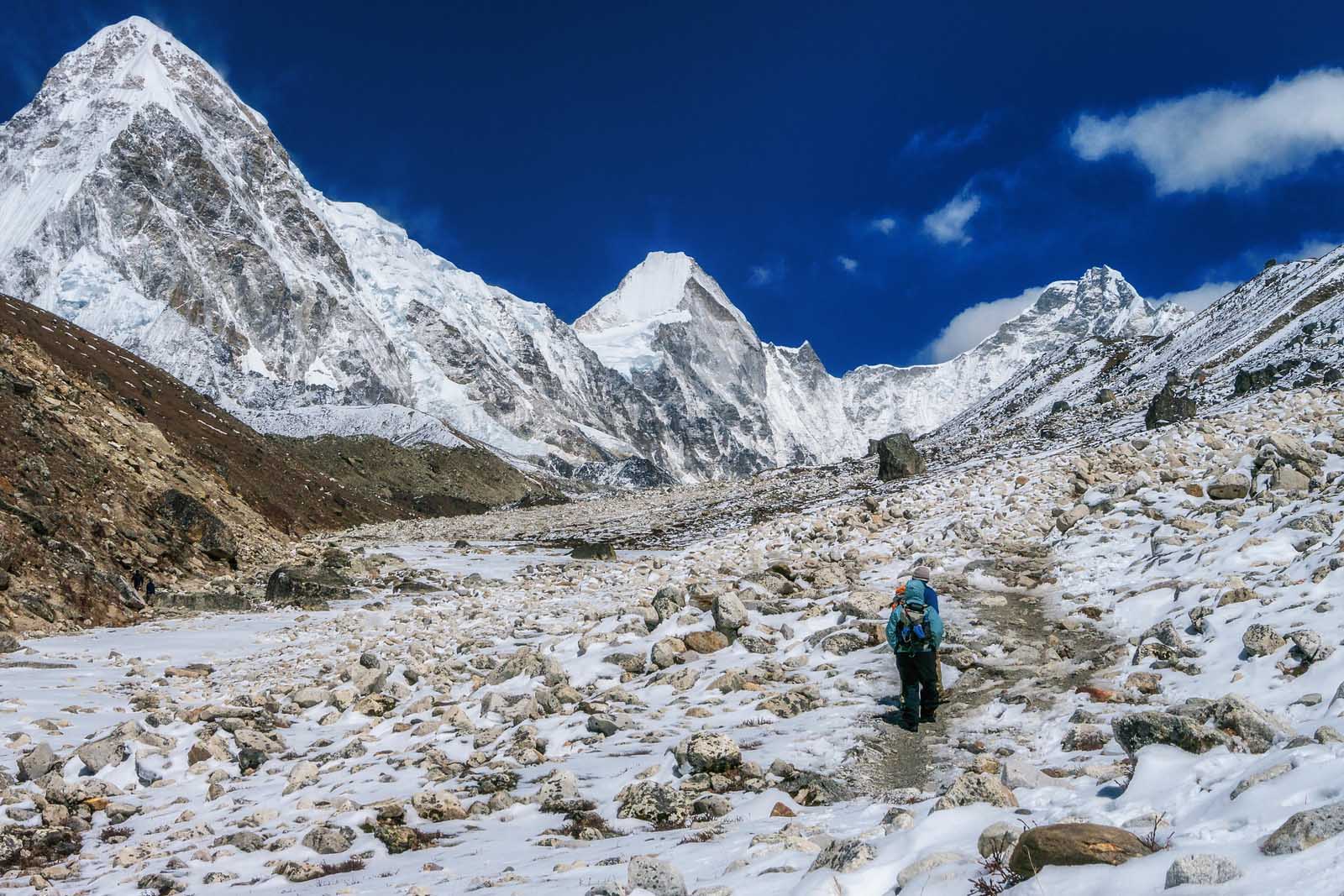
While not one of the famous treks in Nepal, the Tso Rolpa Lake, The Gaurishanker Himal Trek is the perfect place to avoid the crowds. This trek passes through Na village and the village of Beding as well as the Monastery and Sherpa village. On the Gaurishankar Himal Trek trail, there are great views of two high peaks – Gaurishankar (7,145m), Melungtse (7,181m).
The Gaurishankar Himal Trek takes you up to Lake Tso Rolpa and Rolwaling glacier where you’ll find yourself walking below the Rolwaling Icefall. The trek takes you to the Tashi Lapcha Pass and then the Gaurishankar Himal Trek trail where you will descend down to Theng Po and the Everest base camp trekking trail.
En route you’ll have gorgeous views of the Himalaya Mountain Ranges including Gaurishankar (7,145m), Melungtse (7,181m). You will then get a taste of the Everest Base camp trek by descending to Theng Po to join the trail on the Khumbu Valley. Details here
- Trek Duration: 22 days
- Max Elevation: 5755 Meters
- Start: Charikot (Driving)
- Trekking Difficulty: Very Difficult
14. Langtang Valley Trek
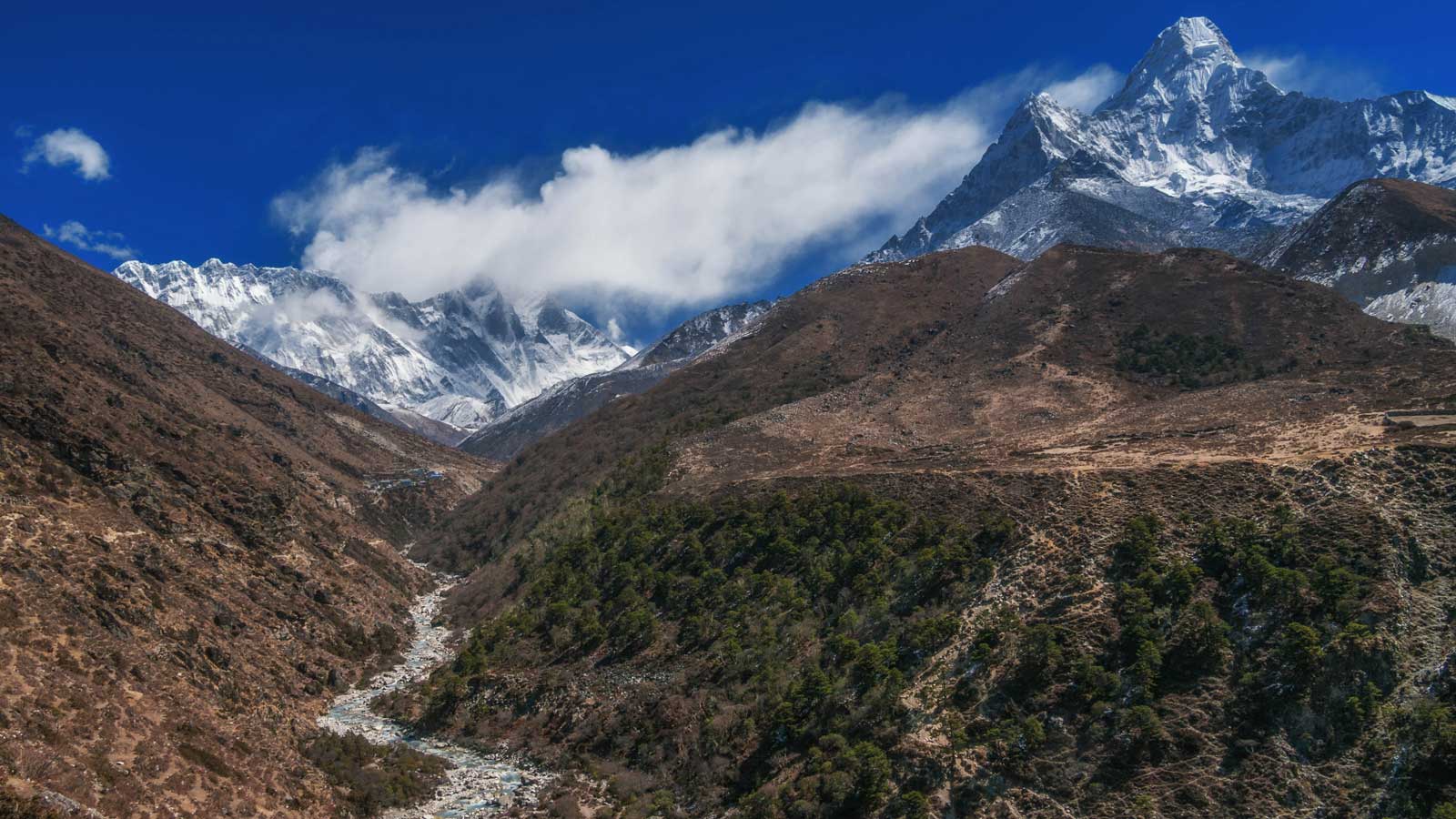
Trekking through Langtang Valley, the Langtang Trek is an excellent choice. Located relatively close to Kathmandu, this trek can be done is as little as one week to complete. This trek will take you through bamboo forests and rolling shrub land as you admire the surrounding snow capped mountains.
If you want a longer Langtang trek, you can do a 10 – 14 day trek through the Langtang Valley. ON this trek, you’ll pass the homes and villages of many Sherpa communities. This cultural trek will take you to Buddhist settlements and Sherpa villages. The Langtang valley has views of the incredible mountains, Dorje Lakpa (6,990m), Langtang Ri (6,370m) and Langtang Lirung (7,245m).
- Trek Duration: 4 – 14 days
- Max Elevation: 3,165m – 5050 meters
- Start: Syabrubesi
- Difficulty: Moderate
- Type: Teahouse Trek
- Best Time to Trek: March – May & Sept – Dec
Dhaulagiri Circuit Trek
If you are looking for one of the more challenging treks in Nepal, the Dhaulagiri Circuit Trek is a 12-day trek with 3 of those days being above 5000 meters. Dave and I always do fine up to 5k but really feel the pain when we are above that altitude. The Dhaulagiri Circuit Trek is similar to the Annapurna Circuit as it circumnavigates Mount Dhaulagiri which stands at 8,167 meters high.
The Dhaulagiri Trekking Trail is very challenging and requires trekking experience. It is one of the most remote and wild treks in Nepal. Things you’ll see on this trail include,The Gandaki Gorge and the Iced French, and Thapa passes. You’ll have the chance to meet the Gurung and Magyar people and experience their culture and way of life
- Trek Duration: 12 – 24 days
- Max Elevation: 5360 Meters
- Start: Pokhara to Beni
- Difficulty: Very Difficult
- Best Time to Trek: March to May as well as September to December.
About Trekking in Nepal
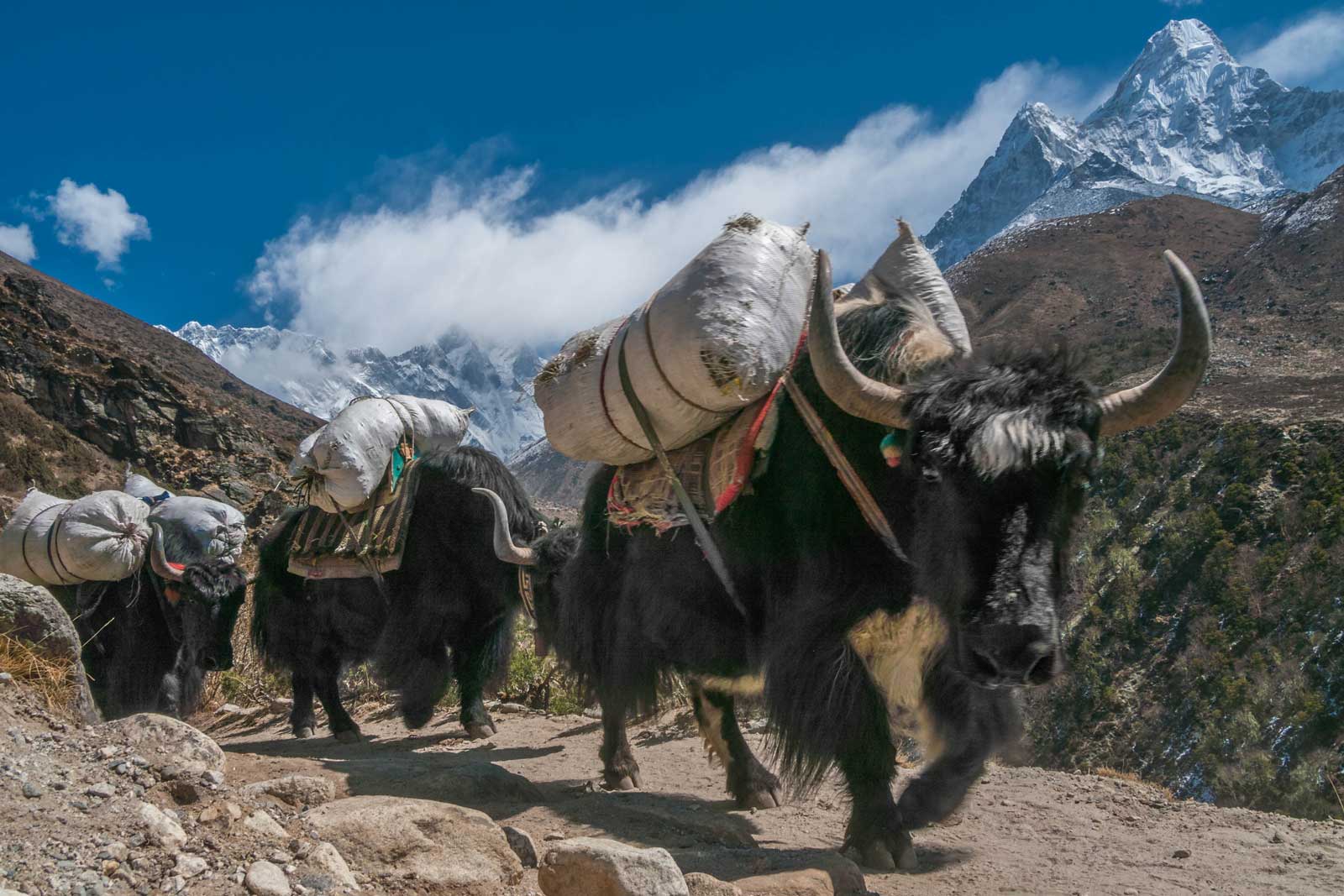
Nepal is located in Southeast Asia between India and China. Eight of the fourteen 8,000-meter peaks are located in Nepal. When traveling to Nepal, you will be flying into Kathmandu International Airport and will spend a few days in the Capital city of Kathmandu.
This has been a base for Himalayan expeditions for decades and it’s a great place to stock up on any supplies that you’ll need for your trek into the mountains. Nepal is one of the best places in the world for trekking because of its strong infrastructure. Many of the treks take you high into the mountains and yet, there are lodges all along the routes. Guides and porters are affordable so you don’t need to carry your packs as you venture into high altitudes.
We highly recommend hiring a guide for trekking in Nepal as it’s much more fun to have first hand information, it’s important to support the lcoal tourism and even if you think you are expeirenced, anything can happen at high altitudes and a guide is an important component for safety.
When hiking the trails in Nepal, we saw many a photo of missing trekkers who thought they could go it alone.
Tips for Trekking
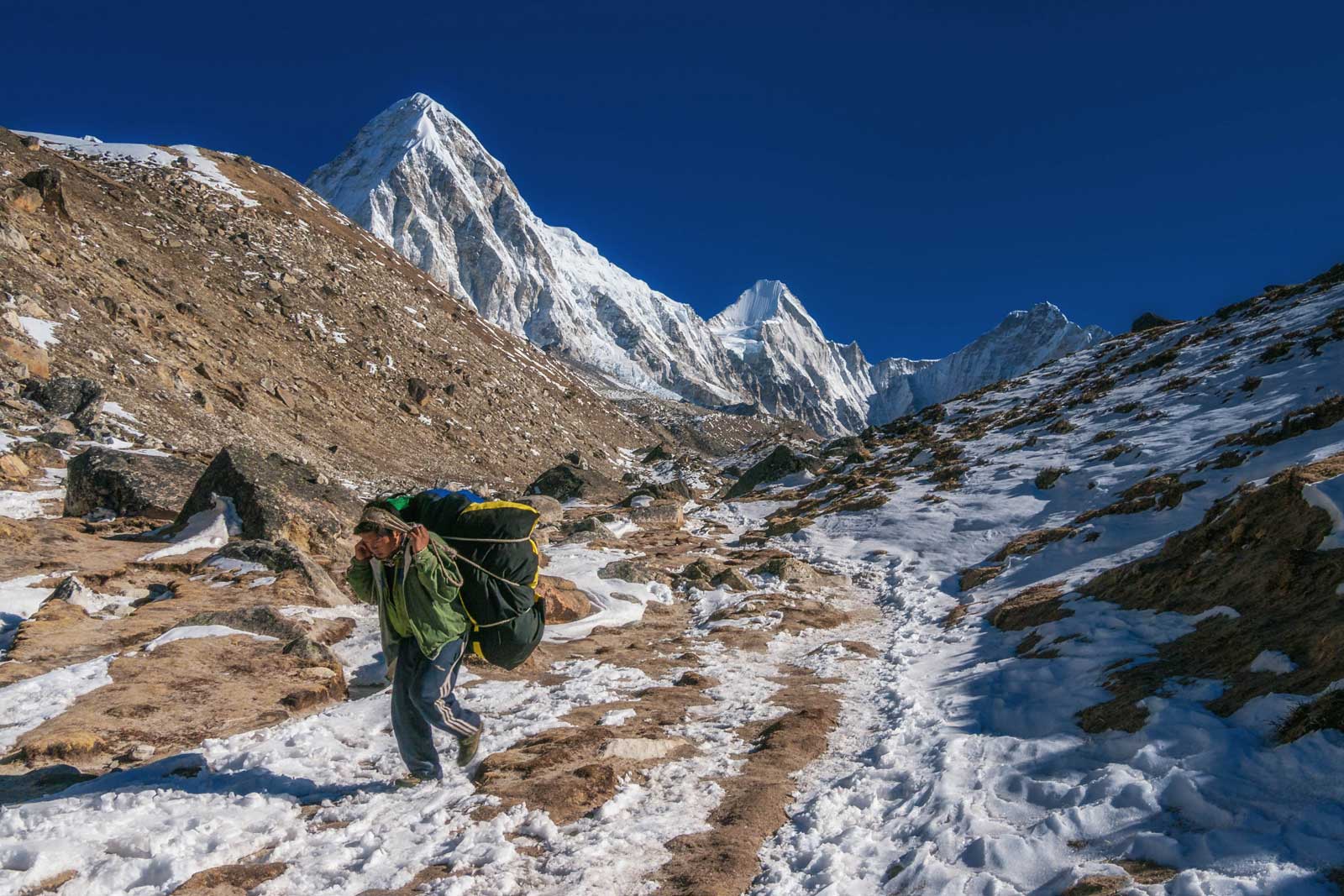
Altitude Sickness is avery real possibility when trekking in Nepal so make sure to keep an eye out for symptoms. Acute mountain sickness can happen over 3000 meters and all of our Nepal Treks listed go above and remain above 3000 meters. Take your time climbing and if you don’t feel well, go down to a safer altitude. Drink plenty of water and try to keep eating.
When flying into a trekking destination, make sure to give yourself a couple of days on each end to fly home from Kathmandu. Delays and cancellations are regular in the Himalayas and if you have a flight book the day after your trek, you may miss it. Our flight was delayed by 12 hours and many people missed their flights completely back to Kathmandu from Lukla.
When hiking on the trail, make sure to give way to yak trains and mules. Stand on the mountain side to let them pass so that you are not pushed off the side of the mountain. These animals stop for nothing, so stay safely out of their way.
There are many places to fill up your water on the treks including filling stations and mountain streams. We suggest packing two refillable waterbottls and using a Steripen to sterilize your water.
Independent vs a Guided Organized Trek
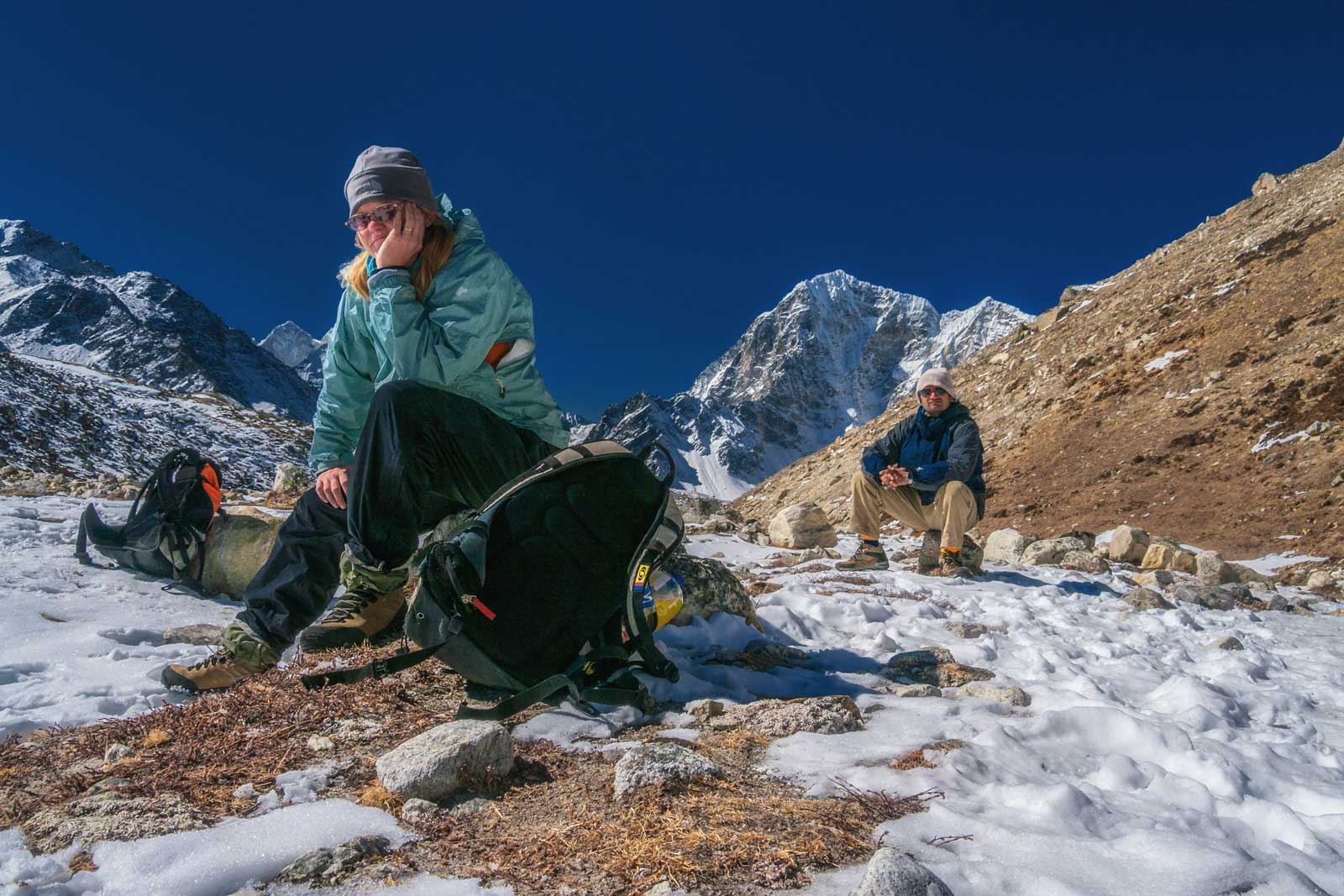
The Everest, Annapurna and Langtang regions of Nepal allow people to trek independently and for the most part trails are well marked and easy to follow. But going with a guide is a great way to have all your hotels (teahouses) meals, porters and routes planned for you. We always hire an experienced guide to take us through the mountains.
When you hire locally, you skip paying the middleman and expensive fees that they need to keep their Western companies and staff going. While by hiring directly in Nepal you will have experienced local guides who grew up in the mountains, have friends in the villages and can give you a unique perspective. Plus, you know your money is going directly to the local economy.
It is up to you to decide what to do, but we have hired local guides for all our mountain expeidtions and have always paid far less than the guided tours booked through the likes of the famous tour companies, while making lifelong friends and having a safe and affordable adventenure.
For more information on trekking in Nepal visit Simrik Real Nepal We used Dipendra for our trek through the Everest Region and have remained friends with him throughout the years. His Trekking Agency is open for business and waiting for you to visit.
Top Places to visit in Kathmandu, Nepal
- 32 of The Tallest Mountains in the World by Continent
- 21 of The Best Treks in the World
- Complete Guide to Climbing Mount Kilimanjaro – How Hard is It?
- Mount Kinabalu – What it’s Really Like to Climb Borneo’s Highest Peak
- How to Pack a Travel First Aid Kit
Travel Planning Resources
Looking to book your next trip? Why not use these resources that are tried and tested by yours truly.
Flights: Start planning your trip by finding the best flight deals on Skyscanner
Book your Hotel: Find the best prices on hotels with these two providers. If you are located in Europe use Booking.com and if you are anywhere else use TripAdvisor
Find Apartment Rentals: You will find the cheapest prices on apartment rentals with VRBO .
Travel Insurance: Don't leave home without it. Here is what we recommend:
- Allianz - Occasional Travelers.
- Medjet - Global air medical transport and travel security.
Need more help planning your trip? Make sure to check out our Resources Page where we highlight all the great companies that we trust when we are traveling.
You May Also Like
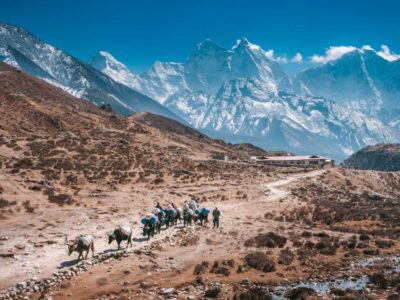
Everest Base Camp Trek – Ultimate Guide For 2024
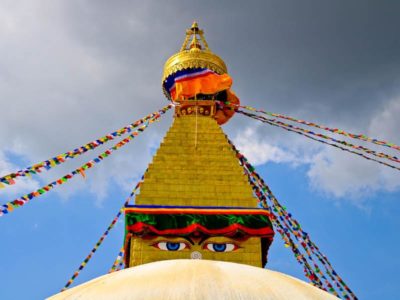
About The Planet D
Dave Bouskill and Debra Corbeil are the owners and founders of The Planet D. After traveling to 115 countries, on all 7 continents over the past 13 years they have become one of the foremost experts in travel. Being recognized as top travel bloggers and influencers by the likes of Forbes Magazine , the Society of American Travel Writers and USA Today has allowed them to become leaders in their field.
Join thousands of others who get our monthly updates!
Leave a comment cancel reply.
Save my name, email, and website in this browser for the next time I comment.

TREKKING in NEPAL – The Ultimate Guide to the Best Hikes
- Last Updated: May 5, 2023
The most comprehensive hiking guide on the internet for trekking in Nepal.
Nepal is known globally for its picturesque mountains. Especially known to most is the mighty Mount Everest, and a lot of people travel from all over to capture a glimpse of the world’s tallest peak.
However Mount Everest is just a small fraction of what there is to discover in Nepal, with some of the most unique teahouses, monasteries and friendly locals you will come across anywhere on the planet.
The Himalaya is the ‘ spine ’ of the country, and what lays within will truly change the way you look at the landlocked Asian nation.
For those that love adventure, the best way to explore this country is on your own two feet, by trekking in Nepal.
From the lush forests of Helambu to the desolate peaks of the Upper Mustang, hiking in Nepal is extremely diverse.
There are literally so many options when it comes to choosing what hike to go on, so I have put together a comprehensive, ultimate guide to treks in Nepal in order to get you on your way to something amazing!
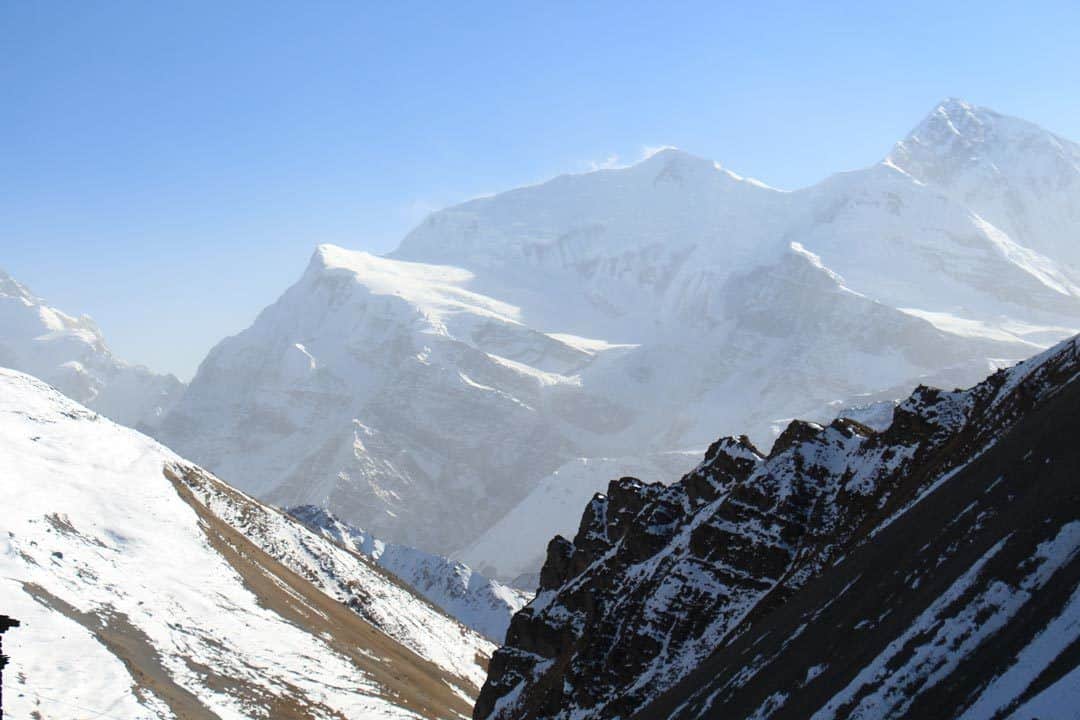
Table of Contents
When To Go – The Nepal Trekking Season
Guided or independent – how to hike in nepal, everest base camp, three passes trek, annapurna panorama trek (poon hill trek), annapurna sanctuary trek, annapurna circuit, mardi himal, upper mustang trek, around dhaulagiri trek, phoksumdo lake to shey gompa trek, kagmara la trek, kanchenjunga north trek, helambu circuit trek, around manaslu trek, the great himalayan trail (nepal only), pack accordingly, train, train, train, listen to your guide, take your own water bottle, team work wins, what to pack for hiking in nepal, trekking in nepal – the ultimate hiker’s guide.
Nepal offers short treks up to 5 days, medium treks up to 12 days and long treks for the adventurous kind where you can be out in the wilderness for up to 20 days or more.
I’ve trekking here on multiple trips and often get a lot of questions about accommodation and food, and some people think that Nepal can’t offer much in the way of luxuries.
Well in fact Nepal has some of the most warming teahouses where you can sit down and share stories with the locals over a hot cup of tea and a plate of momos.
Everywhere you go, every trek you go on, you are bound to be invited to stay at someone’s house or teahouse. Nepal’s hospitality is just awesome, and so are its treks!
So without further ado, let me share all of my knowledge to help you make your epic adventure of hiking in Nepal easier to organise.
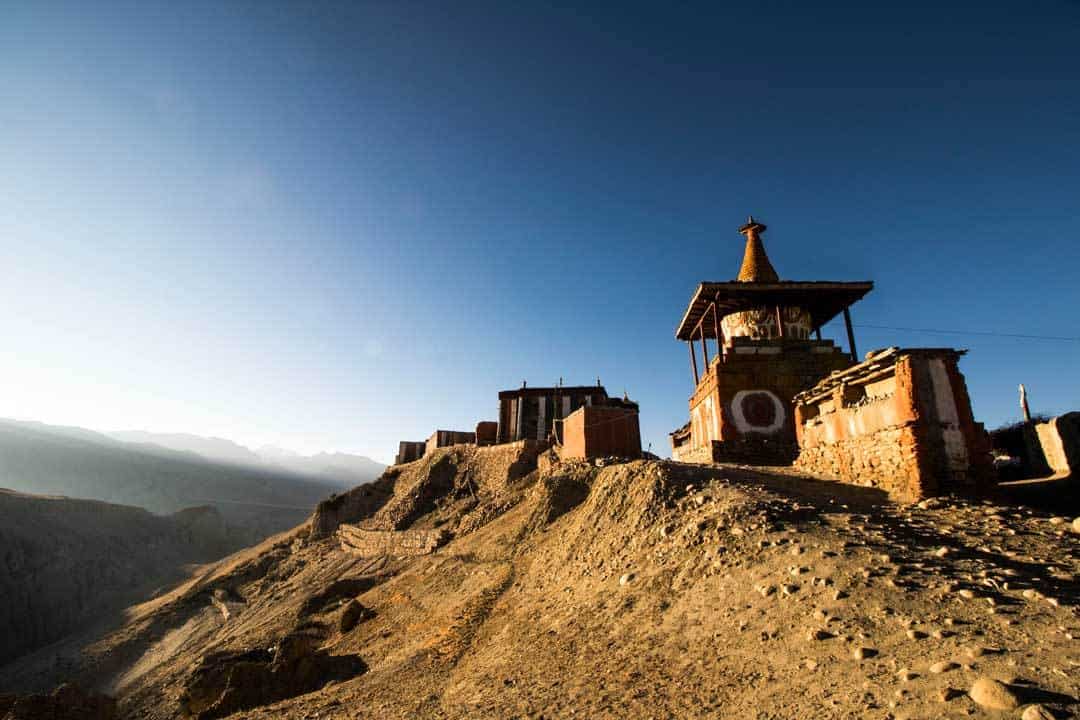
That’s a very good question and there is no definite answer. Personally I prefer to hike in Nepal at the end of the season when numbers of people on the trail have dropped by at least half.
Each of the listed months is a guideline as weather in the Himalaya and Nepal can change very rapidly so use this as a guide. The Nepal trekking season varies from year to year by days or even weeks.
Here’s a brief guide for each trek listed;
- Everest Base Camp: October to December and February to May
- Three Passes Trek: October to November and March to May
- Gokyo Trek: October to December and February to May
- Annapurna Sanctuary Trek: October to May
- Annapurna Circuit: October to November and March to April
- Mardi Himal: October to November and March to April
- Upper Mustang: May to October
- Around Dhaulagiri: Very weather dependent all year round due to avalanche danger.
- Manaslu: Mid-March to May and October to Mid-December
- Inner Dolpo: May to October
- Kagmara La: March to October
- Kanchenjunga: October to November and March to May
- Helambu Circuit: October to April
- Great Himalayan Trek: Starting time generally October
Many hikes in Nepal require the use of guides and porters such as Inner Dolpo, Kanchenjunga and Upper Mustang due to the areas being restricted.
However, places such as the Annapurna Conservation Area and Everest Base Camp do not require guides.
If a particular hike requires a guide there really is no way around it, you must use a guide and porter in order to undertake the hike.
It is best to organise your Nepal trekking tour before you get to Nepal to save time and avoid the confusion of finding a trekking company in Kathmandu or Pokhara.
Guides are awesome to trek with and are full of knowledge even though it might cost you a bit more, it is well worth it.
In my opinion it’s worth going on a guided trip when trekking in Nepal.
It’s important to keep in mind too that no matter what trek you do, you’re probably going to have to get a Trekkers’ Information Management System (TIMS) permit. Read more about it here.
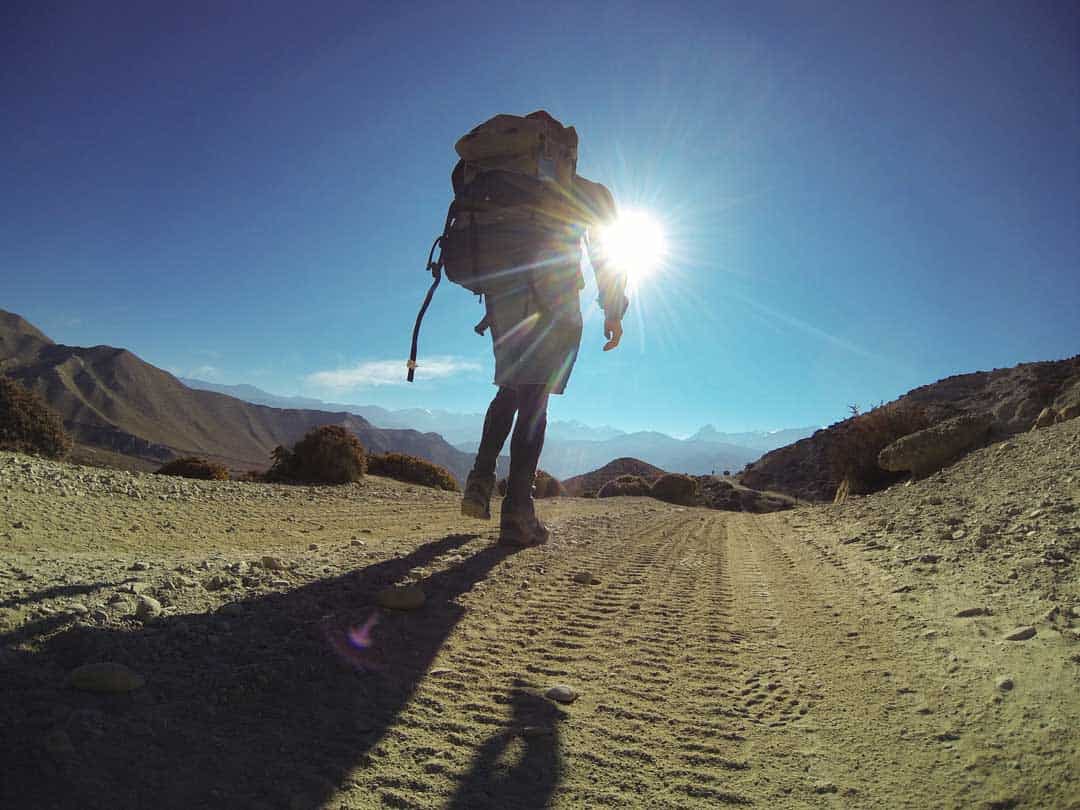
The Best Treks in Nepal by Region
Nepal offers a vast selection of different regions to which contains a multitude of trekking routes to do in Nepal; I have established a list that covers the best hikes in each of these regions.
For easy reference I will group each of the hikes to their location in Nepal.
Everest Region
Annapurna Region
- Annapurna Panorama Trek (Poon Hill)
- The Mustang Trek
Western Nepal
Eastern nepal.
- Kanchenjunga Northern Trek
Langtang, Manaslu and Helambu
- Around Manaslu
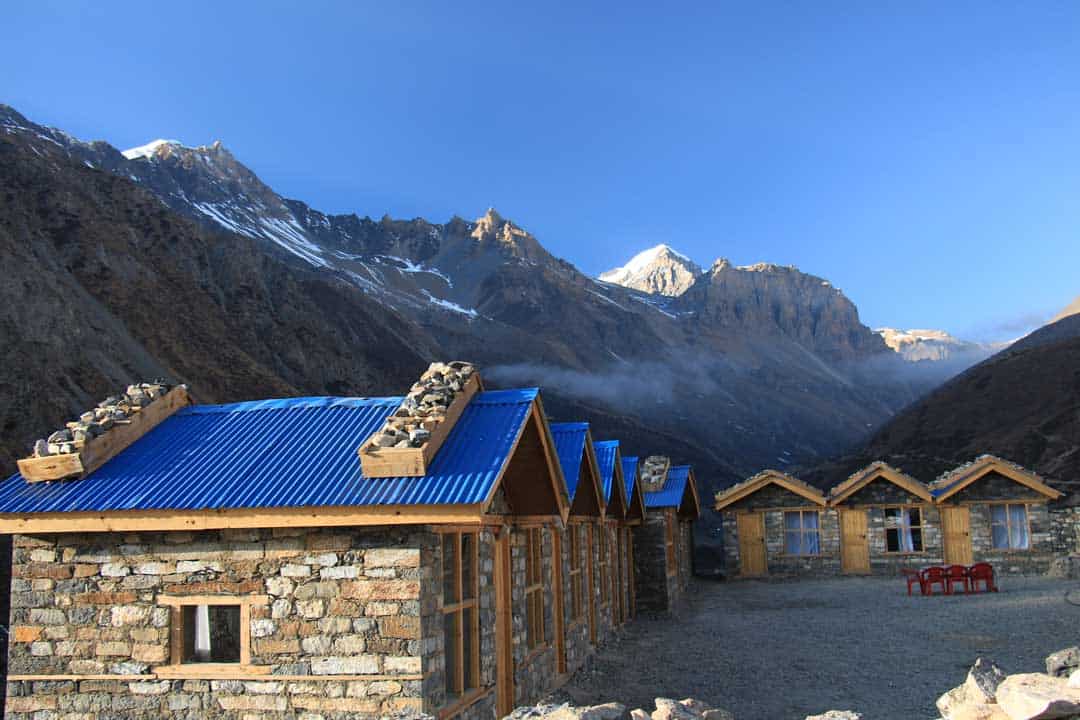
Khumbu Valley Treks – Everest Region
These are some of the most popular treks in the Khumbu Valley, which includes the famous Everest Base Camp hike.
- Time: 16 days
- Difficulty: Medium to Hard
- Elevation: 5,545 metres
- Start / Finish: Lukla to Lukla
- Permits: TIMS card, Sagarmatha National Park permit
- Accommodation: teahouses
Everest Base Camp Trek is to most the pinnacle of trekking in Nepal; a must for most avid hiker’s bucket list. But what makes this hike so good and why do so many travel to the Khumbu Valley for this hike?
Mount Everest, or Sagarmatha to the Nepalese, as you might know is the tallest peak in the world, with countless expeditions taking place to summit Everest since 1953 when Tenzing Norgay and Sir Edmund Hillary became the first to do so.
Mount Everest is one of the most amazing natural sites you can see anywhere in the world, and access to Everest’s basecamp is becoming a whole lot easier, which now attracts more people than ever.
Getting to Everest Base Camp (EBC) all starts with a hair-raising flight to Lukla from Kathmandu to which you literally fly into the side of a mountain.
But don’t worry these pilots are some of the best in the world and safety comes first.
From Lukla, there are a few options as acclimatisation becomes a priority due to Lukla’s altitude, so opt for 1 or 2 days rest in town before beginning the hike.
As you fly from Kathmandu’s altitude of 1,400 metres to Lukla’s altitude of 2,860 metres in a short period of time, the chance of altitude sickness may be low but you have to take all precautions.
From Lukla, the hiking begins!
As you will notice along the trails, there are many teahouses and guesthouses to stay at, but in peak periods they can become very busy.
A little trick of the trade is to send one of your porters ahead (if using a porter) to check if there are any vacancies available, because the last thing you want is to be sleeping outside in the cold.
Also make sure to have your TIMS card registered before leaving Lukla!
On your EBC trek things start to get more exciting as you head deep into the Khumbu Valley, where for a few days you can base yourself in Namche Bazaar for further acclimatisation so this gives you the opportunity to explore side routes.
When acclimatising, my best hiking tip is called “go high, sleep low” which basically involves hiking above the altitude of where you will be staying, having a look around for an hour or two then descending back to the altitude you will be sleeping at.
Trust me it works a treat.
While in Namche Bazaar, be sure to check out Namche Gompa where you can hear monks chanting mantras on a daily basis both morning and evening.
If possible spend at least 1 day in Tengboche which is 4 hours hike from Namche Bazaar due to changes in altitude.
Once you leave Tengboche the views start to get pretty unreal with Ama Dablam peak and Imja Tse (Island Peak) peaking their heads out the clouds to the right of the trail while Cholatse towers above from the left.
To get some extraordinary Himalayan views, opt to do the difficult trek to Ama Dablam Base Camp which will add another 5 hours to your day.
Ama Dablam is one of the most picturesque peaks in the Khumbu and one of the most iconic in the world due to its unique shape.
Dugla to Lobuche provides you with your first glimpses of true giants of the Himalaya with Pumori, which tops out at 7,165 metres.
After Lobuche you will come across a side route which opts to trek to Kala Pattar (4 hours return).
Kala Pattar offers the best views of Mount Everest, and sorry to spoil it for you, EBC won’t offer anything near the views that Kala Pattar will.
So what to expect at EBC?
You can see the Khumbu icefall which is one of the most notorious glaciers in the world for all the wrong reasons.
You can also see the camp itself which is the main place where mountaineers come to acclimatise before making their way to advanced basecamp and onwards to the 8,848 metre summit of Everest.
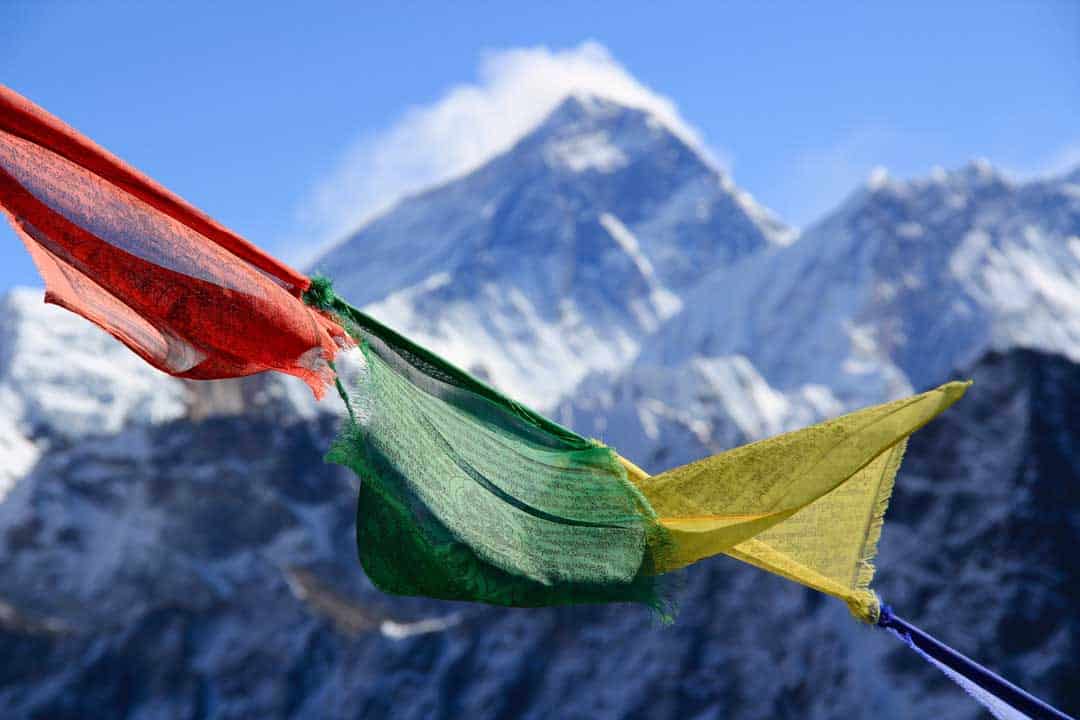
- Time: 20 days
- Difficulty: Hard
- Elevation: 5,535m
- Start / Finish: Lukla
- Accommodation: teahouses and tents
Three Passes Trek is considered as one of the hardest treks in Nepal before you start getting into the realm of trekking peaks.
Starting in Lukla you follow the same trail as if you were heading along the route to Everest Base Camp.
The Three Passes Trek consists of three mountainous passes over 5,000 metres to which you will spend a good part of the trek above 5,000 metres, so make sure you are 100% committed before taking it on.
Himalayan trekking doesn’t get any better than this!
Starting with Kongma La at an altitude of 5,535 metres, this will be your maximum altitude for the trek unless you decide to be really adventurous and add Kala Pattar which rises another 10 metres above Kongma La.
Once you have reached Lobuche, this is the junction village of which one way goes to Everest Base Camp and the other continues towards the next pass of Cho La.
Cho La is the coldest pass on the trek so it’s always good to ascend as early in the morning as possible before clouds start to roll in.
Cho La reaches an altitude of 5,420 metres before descending into a lush area of meadows prior to entering the village of Tagnag.
The last major ascent on the Three Passes Trek is Renjo La maxing out at 5,345 metres and the views are guaranteed to amaze with Everest, Lhotse and Makalu all of which are in the top 5 highest mountains in the world!
For the remainder of the trek, altitude continues to decrease making things a whole lot easier as you approach Lukla to where the trek ends.
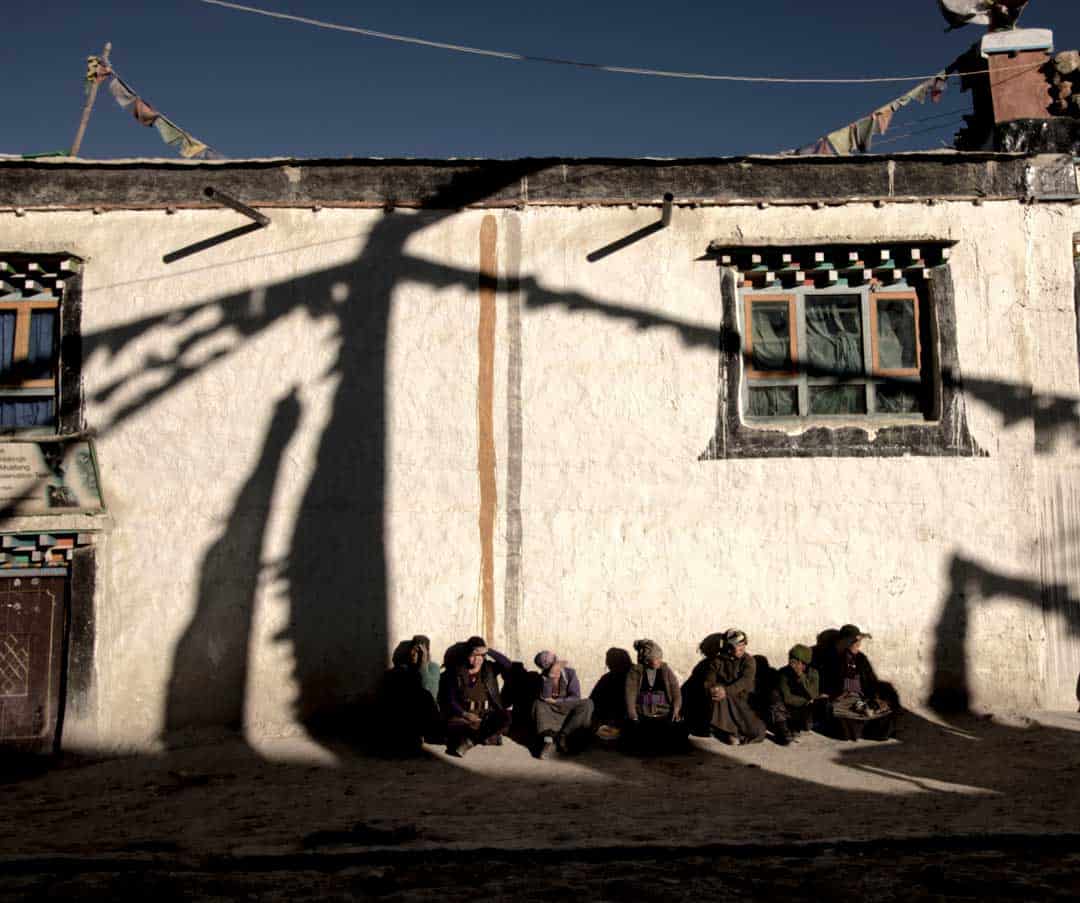
- Time: 12 days
- Elevation: 5,360 metres
- Start / Finish: Lukla via Phortse
Gokyo Trek is an alternative to Everest Base Camp and only really sees hikers who are on the Three Passes Circuit.
Gokyo is a return track trek meaning you come back the way you came but don’t worry, everything looks different when you walk in the opposite direction.
The highest altitude you will get to on this trek is a nice 5,360 metres making it crucial that you put together acclimatization practices so opt for a rest day in Lukla before hiking to Namche Bazaar for another rest day or two.
From Namche Bazaar, the hike follows the same path as the Dudh Kosi River which will lead you to the first major pass of Mong La (3,975 metres).
After Mong La, the length of days spent on the trail becomes less due to altitude to which you will average 2-3 hours due to the trail rapidly increasing in altitude.
As you approach Gokyo, Cho Oyu, the 6 th tallest mountain in the world reaching a massive 8,201 metres becomes visible directly ahead of the trail.
What makes this trek so unique is there are a series of lakes dotted throughout the landscape the first being Longponga Tsho followed by Tarujung Tsho and Dudh Pokhari which is located at Gokyo.
Once you have arrived at Gokyo, allow for at least 2 to 3 days rest before turning back and heading for Lukla.
There are some pretty awesome opportunities to see some of the most majestic mountains in the world such as Everest, Cho Oyu, Lhotse and Makalu (which are also within the top 5 highest mountains in the world) and these can be seen by taking a side route to Gokyo Ri (4 hours return).
Another option for a side trip is to Scoundrels Lookout which is 5 hours return, taking you to the origin of the river Dudh Kosi which is considered as highly sacred.
Returning to Lukla there is an alternative route via Phortse which can take up to 7 hours, where you can visit The Khumbu Climbing Centre run by the legendary Conrad Anker.
Here locals are taught alpinism and mountaineering skills making it safer for them to work and operate in the mountains. From Phortse to Lukla via Namche Bazaar, allow for 2 days.
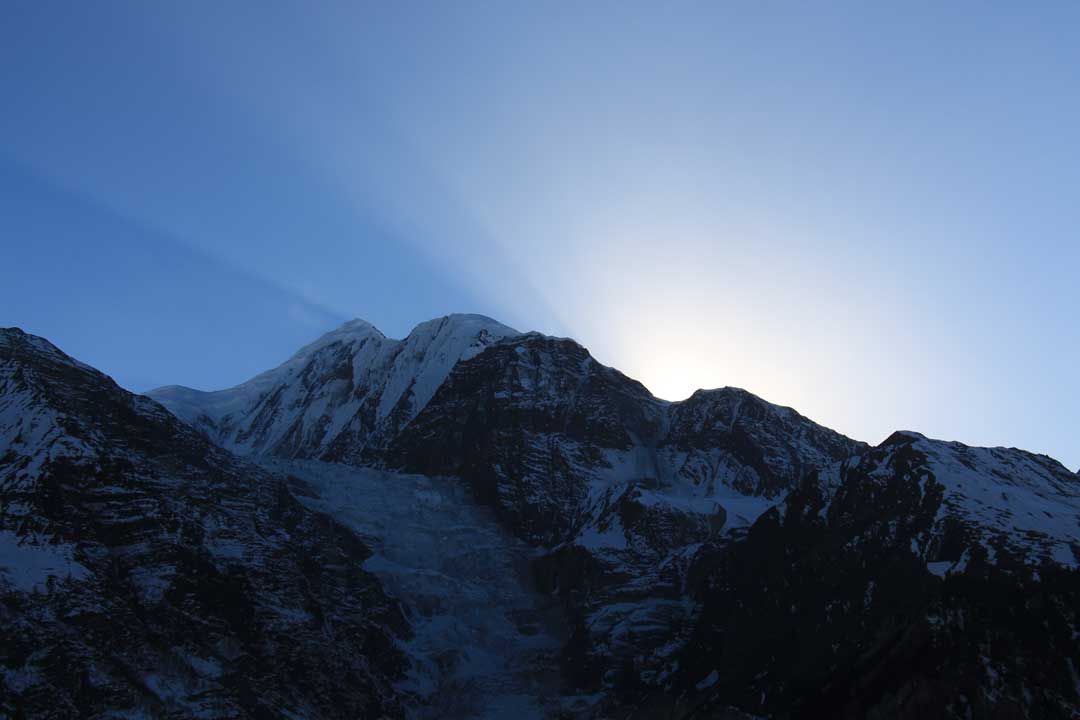
Annapurna Treks – Annapurna Region
The second most popular region for trekking in Nepal is the Annapurna Region.
Home to some incredible treks, like the Annapurna Circuit and Poon Hill, you will have tonnes of opportunities for hiking adventures.
- Time: 6 days
- Difficulty: Medium
- Elevation: 3,210 metres
- Start / Finish: Birenthanti to Phedi via Poon Hill
- Permits: ACAP permit and TIMS card
The Annapurna Panorama Trek is your classic guesthouse to guesthouse trek with stunning views of The Annapurna’s, Dhaulagiri and Machhapuchhare.
Despite being considered as one of the more easy hikes in Nepal, The APT is truly beautiful complete with lush rainforests of Rhododendrons which are unique to this particular area and when in full bloom, hiking amongst these trees is an amazing feeling.
The APT is known for its many stone steps and which you will experience from Hille to Ulleri with a very steep section taking up to 2 hours.
Opt to stay at Kamala Guesthouse in Ulleri as the views during sunrise are breathtaking.
Ulleri to Ghorepani consists of a generally easy and slippery ascent which can be completed in 2 days but if you have time restrictions can be done in one day.
Ghorepani is positioned at the foothill of Poon Hill which is highly popular with tourists.
Poon Hill offers you some incredible views and the best way to see the Annapurna’s is to get up really early i.e. 330am.
Ghorepani to Poon Hill can take anywhere between 30 minutes to 1 hour so allow enough time to ascend to the summit of Poon Hill (3,210 metres).
If the weather is clear you’re in for a treat!
On leaving Ghorepani, things go straight up to Duerali La followed by a trekking along a narrow ridge to Banthanti which incorporates stunning Rhododendron forests along Luprung Danda.
Banthanti to Tadapani is a whole lot of ups and downs and during the wet can be quite difficult due to some of the tracks not being maintained.
Tadapani offers glorious views of Machhapuchhare and is also a great place to stop for lunch before pressing onto Ghandruk.
Ghandruk is a place you want to spend at least 2 days exploring because just WOW! I thought the views from Poon Hill where amazing but Ghandruk is just a whole lot of next level.
Annapurna South, Hiunchuli and Machhapuchhare all surround the village followed by a direct view up the Modi Khola to Annapurna Base Camp.
Getting out of Ghandruk is not entirely fun as the descent will most likely give your knees a good work out (take it slow) followed immediately by an ascent to Landruk.
After this, it’s all easy as Landruk to Pothana or Australian Camp is all flat or ‘Nepali flat’ as the locals will say.
Australian Camp to Phedi is quite straight forward and will offer views of Machhapuchhare as you descend down to Dhampus and Phedi.
From hear you can arrange for a pick up back to Pokhara or a bus which will take 1 to 2 hours depending on road conditions and mode of transport.
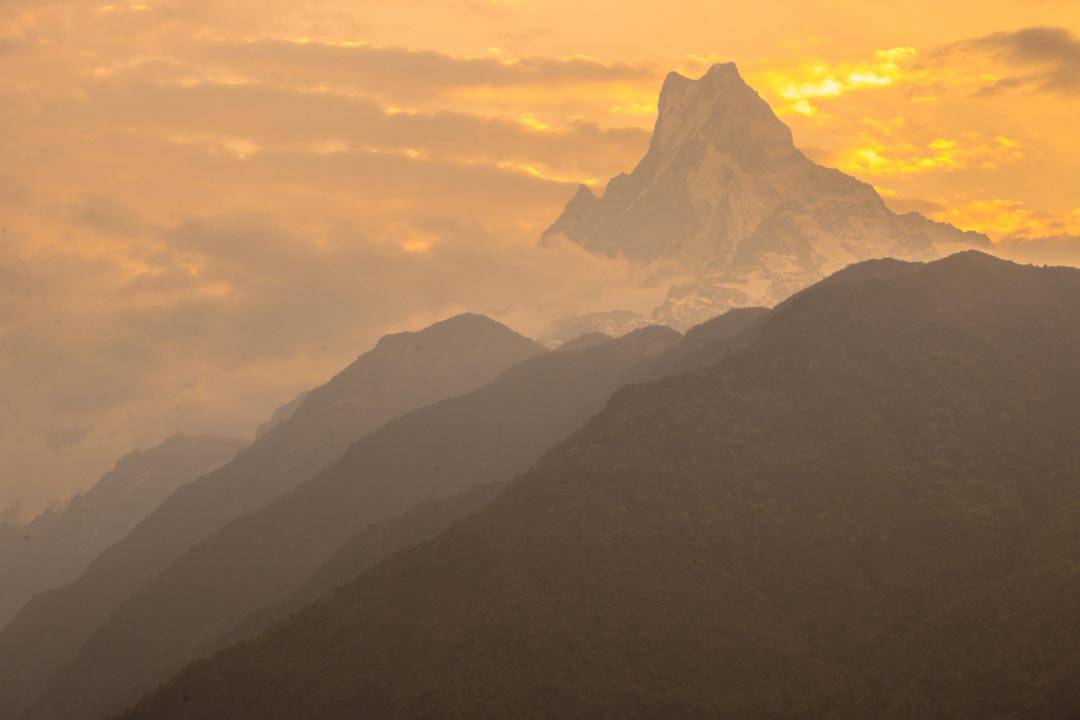
- Time: 10 days
- Elevation: 4,130 metres
- Start / Finish: Phedi to Annapurna Base Camp to Naya Pul
This demanding trek encapsulates you and places you in the midst of some of Nepal’s finest mountains.
The Annapurna Sanctuary Trek is a 10 day trek through contrasting environments of Rhododendron forests of Pothana and Ghandruk to the alpine climates of Annapurna Base Camp.
Alongside Annapurna Panorama Trek, the AST is another opportunity to see Nepal’s mountains and villages with relative ease compared to some of the more demanding hikes like the Annapurna Circuit and Everest Base Camp.
Once you are past Landruk, you enter into a valley surrounded by massive Himalayan peaks and this during periods of heavy snow can cause avalanche risks so always check with local guides to ensure your safety.
At Chhomrong, ensure you have adequately have had enough time to acclimatize as altitude after you leave increases by over 2,000 metres.
Prior to reaching Annapurna Base Camp you will come across Machhapuchhare Base Camp which really is just a small village and this doesn’t mean you can climb Machhapuchhare because it is a sacred mountain and climbing is strictly prohibited.
Half way along into your trek is Annapurna Base Camp which is the gateway to a variety of trekking peaks such as Pisang Peak (6,091 metres) and Singu Chuli (6,501 metres) which are both difficult climbs requiring advanced mountaineering skills.
ABC is a pretty cool place to hang out with early mornings being clear and crisp with exceptional Himalayan.
There are a few chortens and stupas to visit in ABC and one in particular is dedicated to one of the most famous mountaineers to ever live, Anatoli Boukreev who was a leading figure in the rescue on Mount Everest noted by John Krakauer in his book, Into Thin Air .
On returning to Pokhara, there are a few options which arise once you come to the junction at Taglung and head for Ghandruk for the night because views here are just unreal!
Ghandruk to Naya Pul drops over 1,000 metres of descents so just take your time as you don’t want to damage your knee.
Once at Naya Pul, jeeps are generally not too expensive so don’t pay any more than 600 rupees for a jeep (sharing with others) or 300 rupees for a bus.
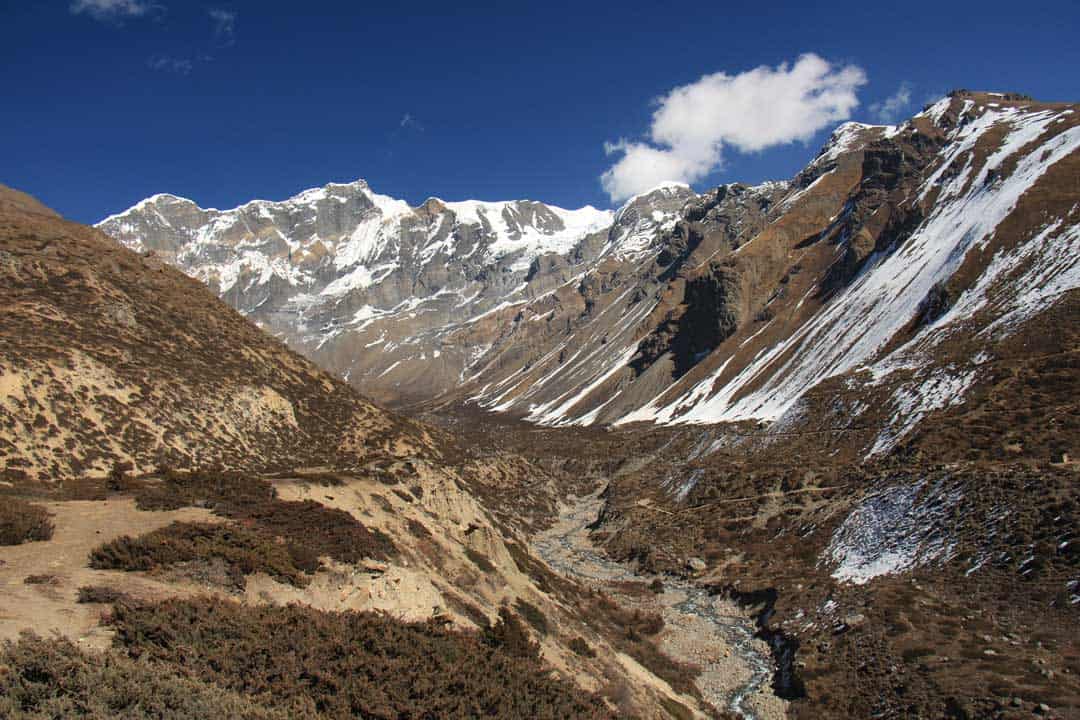
- Time: 12 to 18 days
- Difficulty: Medium to hard
- Elevation: 5,416 metres
- Start / Finish: Besi Sahar to Jomsom
- Accommodation: teahouses and guesthouses
The Annapurna Circuit is Nepal’s gem and there’s no questioning it.
It’s the trek that everyone with a passion for hiking and the outdoors come to put themselves amongst some of the world’s finest landscapes and its true, the Annapurna Circuit is truly one of the worlds must hikes and sorry to those who think Everest Base Camp Trek is the best, you’re wrong.
The Annapurna Circuit is just so unique as you transition from subtropical forests to the high alpine pass of Thorung La and then down into the Kali Gandaki which is a rain shadowed, Tibetan influenced part of Nepal.
Starting in Besi Sahar (best accessed from Pokhara) the hike slowly begins to ascend and this will gradually happen until you reach Thorung La.
The first real challenge occurs at Pisang with a rather steep ascent to Upper Pisang which can take up to 5 hours but the views become pretty awesome with Annapurna II trailing off to the left and Pisang Peak trailing off to the right.
If you have a decent amount of time on the trail, allow for the side route to Tilicho Tal which can be completed in 2 days.
At Tilicho Tal, expect breathtaking views of Gangapurna reaching a massive 7,454 metres while the reflections of the surrounding mountains beam of the surface of Tilicho Tal.
Upper Pisang to Manang, things start to get better if you decide to take the high route to Ngawal as this route elevates your views allowing you to see both Annapurna II and III.
Manang to Letdar is another one of those days where everything just goes up so just go with the flow and take your time as the next few days are sure to test out how well you have acclimatized.
Letdar is the last place at a calm 4,230 metres before you ascend above the magic 5,000 metre line. After Letdar, a short 2 hour hike brings you to Thorung Phedi (bottom of Thorung La) so make take the opportunity to rest here until you are satisfied you can safely cross Thorung La.
The day has come to cross Thorung La and the best way to safely cross is by checking with local guides and weather conditions before crossing.
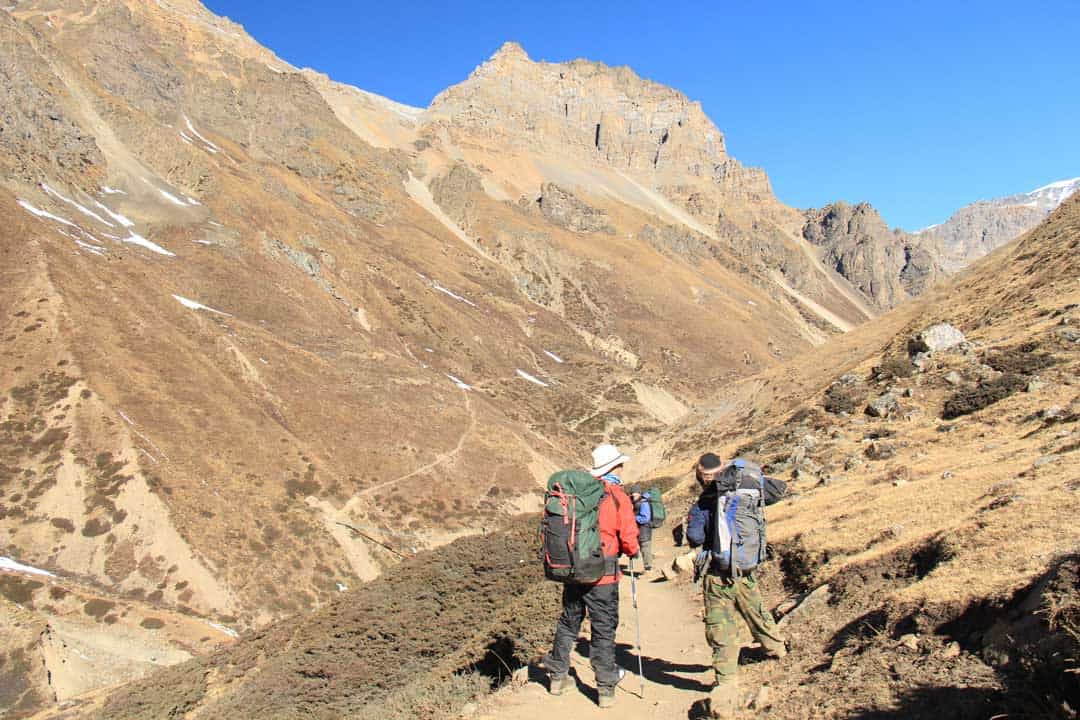
The best time to cross is early morning as conditions in the mountains will be calmer before the sun rises, but don’t go too early as the chances of getting lost on the pass are higher.
In bad conditions, snow can be quite deep making the pass very difficult if you are not experienced in the mountains.
At the top of Thorung La, you will notice the landscapes begin to change as you cross over into the Kali Gandaki.
Once you arrive at Muktinath, you’ll find yourself 1,600 metres lower than that of Thorung La.
Muktinath is a popular place to stop otherwise Kagbeni, known as the gateway to the Upper Mustang is one of most unique places you can stay will on the Annapurna Circuit.
Either option you choose, the environment and climate will have completely changed. The Kali Gandaki is the deepest gorge in the world meaning most of the valleys and mountains here don’t receive anywhere near as much rain as the Annapurna region would.
At Eklai Bhatti (sometimes spelt Ekle) follow the direction of jeeps and motorbikes to Jomsom which is a rather large town based on the edge of the Kali Gandaki with stunning views of Nilgiri Himal.
If you are having any difficulties with yourself or others in your group, Jomsom will be your last chance for direct flights back to Pokhara otherwise for a short period, you keep following the main road to Pokhara until you enter back into the mountains at Rato Pani.
If you decide to continue, you won’t be disappointed as the circuit links to Ghorepani where you can witness a stunning sunrise from Poon Hill.
From Ghorepani to Naya Pul, allow 2 days of relatively downhill walking. The last 2 days consist of hiking through lush Rhododendron forests alongside pristine waterfalls and hillside villages such as Ulleri.
From Ulleri to Naya Pul, allow 3.5 to 4 hours and this is where you finish the Annapurna Circuit!
Getting back to Pokhara can be done by hiring a jeep. Expect to pay 300 to 600 rupees for a shared jeep.
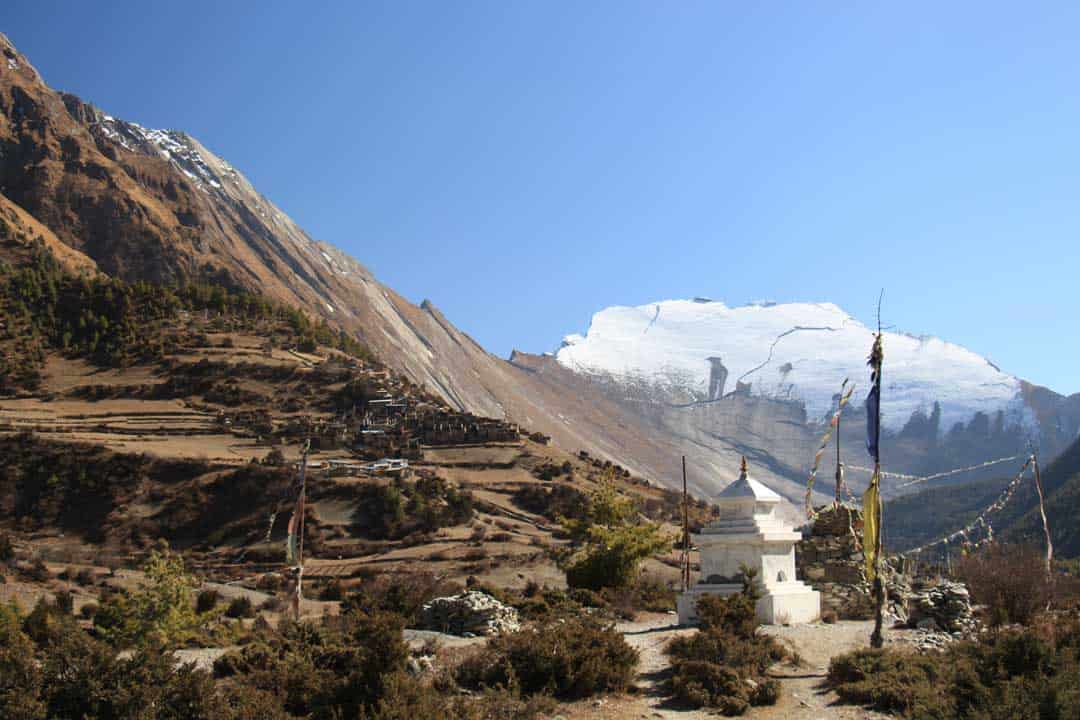
- Time: 5 days
- Elevation: 5,587 metres
- Start / Finish: Mardi Pul to Mardi Himal to Mardi Pul
- Permits: ACAP permits and TIMS card
- Accommodation: teahouses (lower altitudes) and tents
Mardi Himal is an uphill challenge bound to test you and your fitness to the maximum when trekking in Nepal.
Mardi Himal takes you to the upper foothills of Machhapuchhare to an impressive altitude of 5,587 metres.
Keep in mind that Mardi Himal is not a popular route taken by trekkers and the track at some places could be overgrown or affected by natural elements.
Most of this trek is purely up until you reach Mardi Himal and have to come back down. Kumai approximately half way along the ridge to Mardi Himal provides a good place to pitch a tent and rest up before continuing the trek.
Views from halfway along the ridge are breathtaking with exceptional views of Manaslu, Dhaulagiri and the Annapurna’s.
From Kumai to Basecamp, allow 2 days of steep trekking. Before the summit push on Mardi Himal, you will need to ensure you locate the correct trail leading up to the col.
If need, there is room to pitch a tent at 4,650 metres as from this point, steep slopes of snow and ice lead to the summit of Mardi Himal so crampons will be needed.
If you are planning to summit Mardi Himal, make sure to check with local guides about the conditions on the summit before attempting the summit. Mardi Himal and the summit is one of the harder trekking routes in Nepal.
Return the same way you came. Getting back to Pokhara can be done by hiring a jeep and expect to pay 300 to 600 for a shared jeep.

Trekking In The Mustang – Mustang
Don’t miss out on hiking in the Mustang region of Nepal as well, home to one of the best treks in Nepal!
- Elevation: 4,325 metres
- Start / Finish: Jomsom to Lo Manthang to Jomsom
- Permits: ACAP permit (generally just a small fee), TIMS card and a $500 USD fee for the first 10 days and $10 USD per day after the 10 days.
Pronounced ‘ Moo-Stang’ , this trek is possibly the most unique of all treks in Nepal due to its harsh landscapes, dry, bare mountains with a covering of fresh snow on the top.
The Mustang Trek takes you through some of Nepal’s oldest Tibetan styled villages where you will encounter some of the friendliest people in all of Nepal.
Hiking in Nepal doesn’t get any better than this! The Mustang Trek is one of, if not the best trek in Nepal.
Technically the trek begins in Kagbeni as it remains the official checkpoint where you need to have your permits checked before heading off into the Mustang.
But we are going to start back at Jomsom merely because it is such a strange place. Jomsom is located at the foothills of Nilgiri Massif, a massive 7,061 metre mountain which is just awesome.
The first section of the hike trails along the Kali Gandaki River to the Kagbeni which is the gateway to Lo Manthang.
You’ll need to spend your first night in Kagbeni just to become familiar with the altitude as the altitude hits 2,800 metres.
While in Kagbeni, be sure to check out Kag Chode Thupten Samphel Ling Monastery and opt for a monastery tour which will cost about 50 rupees.
Just as you leave Kagbeni, turn around and look back over the town as the contrast between the rice fields of Kagbeni with the clash of the towering white peak of Nilgiri.
Kagbeni to Chhusang is about 3 to 4 hours and is relatively flat with a few steep scree descents near Tangbe.
Chhusang is situated right along the Kali Gandaki and is a spot known for fossicking especially that of Ammonites.
While in Chhusang, be sure to visit the Mentsun Khang Gompa high above the Kali Gandaki which will add an additional 2 hours to your trek.
One of the issues with hiking in the Mustang is the midday dust storms which are not pleasant to hike in, so don’t forget to pack a buff and sunglasses.
If you make it to Chhusang while conditions are calm, a further 45 minutes to 1 hour along the trail is Chele (sometimes spelt Chaile) which is a high 3,010 metres up and over looks Chhusang and further down the Kali Gandaki.
There is a section of trail which requires crossing a narrow stream on the Kali Gandaki via a dodgy metal bridge extending some 40 metres.
Once you cross, look immediately above the bridge where you will see a series of high caves (a bit like windows) about 1,000 feet into the side of the red walls.
One of the most famous climbers and adventures today; Cory Richards and a team of scientists climbed this wall in order to see what lay inside these caves for National Geographic.
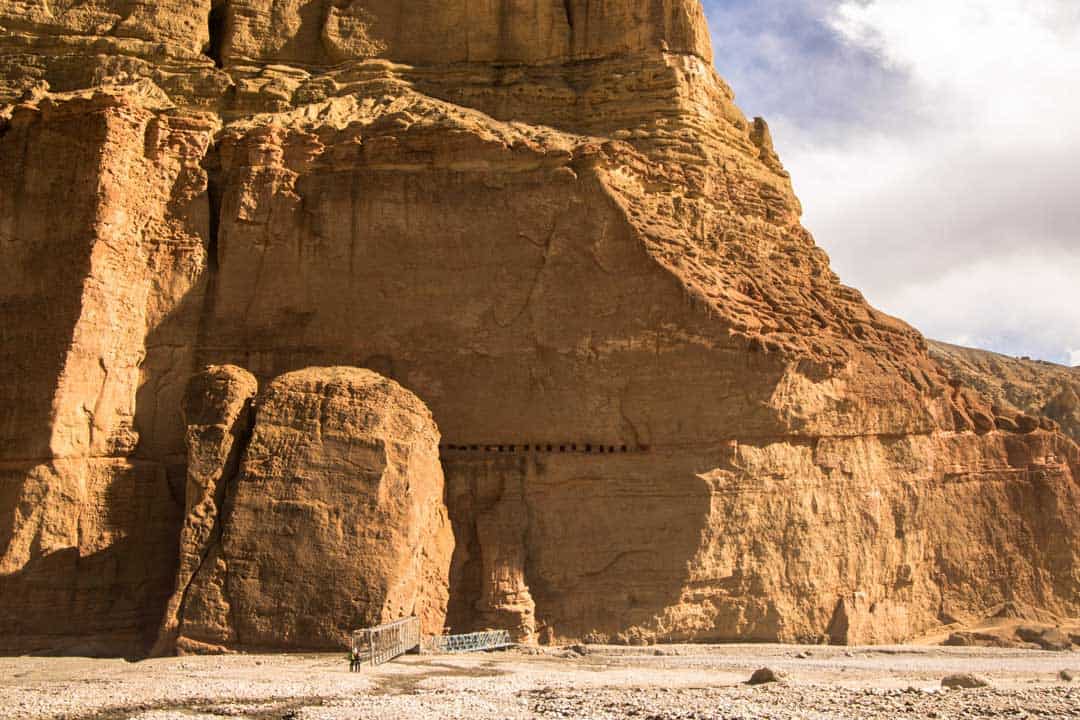
Chele to Shyangmochen or Syangboche is one of the longest days on the trail so be prepared for an awesome but tiring day.
Chele to Shyangmochen is the first real test with a continuous gradual ascent passing the cliff side village of Ghyakar to Samar, which is a beautiful little village based around apple orchards which is also ideal for a lunch break.
If you can get your hands around some of the freshly picked apples, they are seriously delicious.
As soon as you leave Samar, it’s up and down through gorges for the next 45 minutes until you come to a flat section of earth which trails to your first vantage point of the Tibetan Plateau.
Instead of taking the high road to Shyangmochen opt to take the trail down into the Tangmar Chu to visit one of the most remote monasteries in Nepal, Chungsi Cave which is built into the side of a cave thousands of feet high.
The monk we met during our hike used to live in Sydney and decided he wanted to go to Nepal to become a monk! Chungsi cave to Shyangmochen is another hour further up the valley.
Anita Hotel is one of most warming and friendly teahouses in The Mustang and one of only 3 in Shyangmochen.
I said not long ago that Chele to Shyangmochen is one of the longest days on the trail…I may have lied.
Shyangmochen to Tsarang (Charang) is a big one which can be easily managed by stopping at Ghemi for lunch, good luck finding your way out of Ghemi as it is quite like a maze.
After Ghemi, you will walk alongside the longest Mani wall in Nepal, before ascending to Choyo La (3,870 metres) which requires steep climbing along fields of loose rock.
Choyo La offers a brilliant look at the Tibetan Plateau.
From here, follow the long, winding road until you come across a Gompa on the outskirts of Tsarang which is home to Dzong Gompa perched precariously on the Tsarang Khola.
Straight out of Tsarang you descend into the Tsarang Cha which you will cross again later in the trek, followed by a relatively easy but long and flat hike past Sungda Chorten which is a lone chorten built to show the border between Tsarang and the Kingdom of Lo.
Continue following the road to Lo La sitting at 3,950 metres also boosting brilliant views of Lo Manthang and Nepal/ Tibetan border.
Lo Manthang is probably the most unique towns in the whole of Nepal due to its massive walls circling the city.
Inside the walls is the Chode Gompa, Choprang Gompa and the stunning Thubchen Gompa situated in the centre of the city.
If you have a bit of downtime, coffee is funnily a thing in Lo Manthang with various cafes spotted throughout the walled city.
After a few days rest in Lo Manthang, it’s time to take the high route out of the city to Chogo La which is the highest point on the trek reaching 4,325 metres.
If you are lucky enough, you can share a pot of tea with a monk at Ghar Gompa which just above the banks of Tsarang Chu and learn about the history of the monastery and why it is connected to Dhakmar.
Ghar Gompa to Dhakmar is just stunning as you traverse sections of rich red and orange eroded cliffs until you enter the town of Dhakmar under a banner of highly strung prayer flags.
Dhakmar by day might not look appealing but during sunrise and sunset, Dhakmar is the one place you want to experience.
Dhakmar to Geling is a viable option leaving Geling to Chhusang and Chhusang to Kagbeni for the last 3 days which consists of much of the same route back except you can take the high pass from Shyangmochen to Samar which would save a few hours and avoid heading back down to Tangmar Chu.
To finish your trek through the Mustang, finish in Jomsom for an 18 minute flight back to Pokhara or a 9 hour jeep ride.
The Mustang Trek requires a restricted area permit which is $500 USD for the first 10 days then an additional $50 USD per day afterwards.
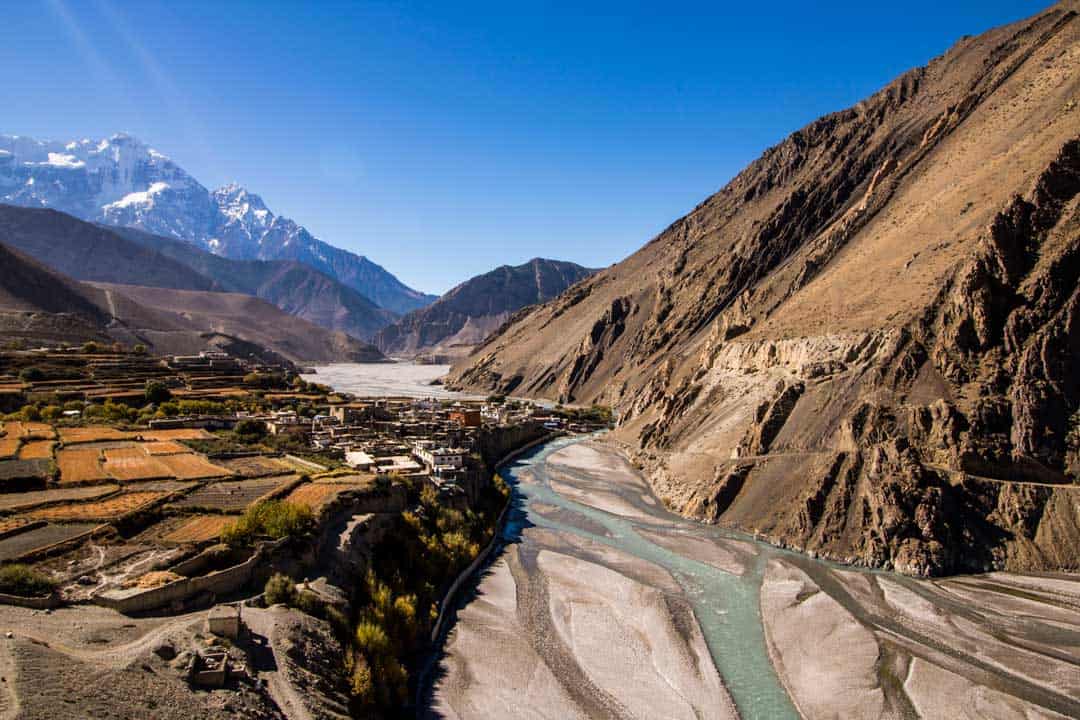
Home to some of the most difficult treks in Nepal, don’t miss the western part of the country if you’re an experienced hiker.
- Time: 16 days
- Difficulty: Advanced
- Elevation: 5,250 metres
- Start/ Finish: Beni to Marpha
- Permits: 2,000 rupees ACAP permit and TIMS card
- Accommodation: teahouses (lower altitudes) and tents
This trek is not for the faint hearted and should only be attempted if you have advanced trekking skills.
Around Dhaulagiri is bound to test your skills over a period of 16 days with various sections requiring the use of crampons like on French Pass and Dhampus Pass.
Around Dhaulagiri offers some of the finest hiking experiences in this part of Nepal along with stunning views of the Dhaulagiri Massif being the 7 th tallest mountain in the world.
Around Dhaulagiri despite being difficult is one of the best Himalayan treks to do.
Before attempting this trek, make sure to check with local guides and ensure that your porters and guide are suited to hiking in such conditions as anything over 4,500 metres is subject to avalanches.
Around Dhaulagiri will also require camping at high altitude in very cold conditions so your gear will have to be high quality.
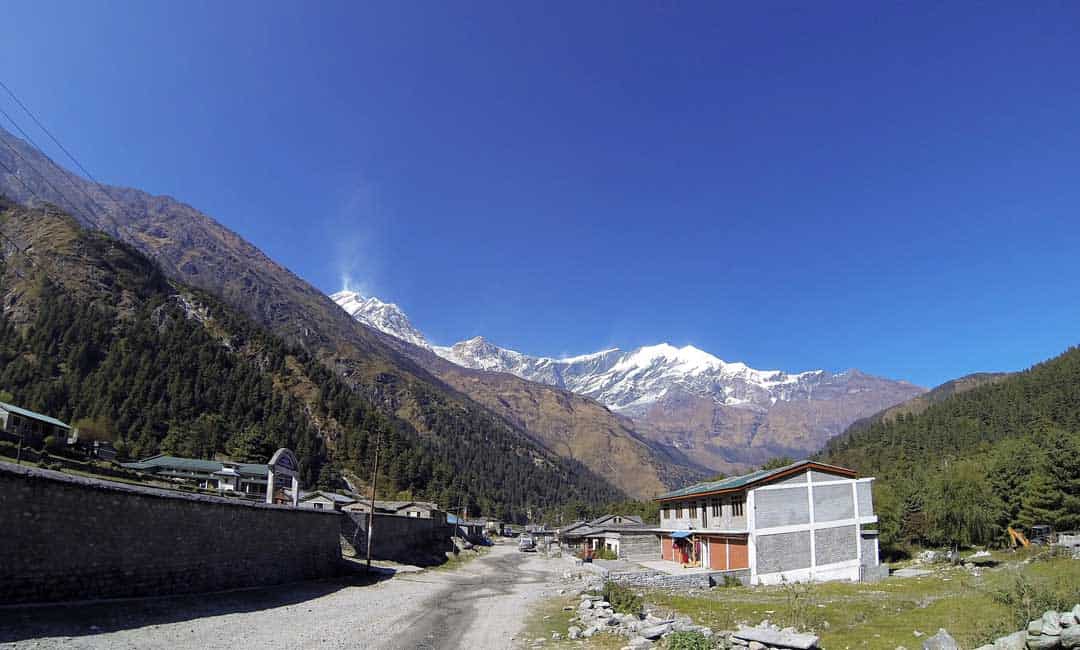
- Time: 7 to 10 days
- Elevation: 5,160 metres
- Start / Finish: Jomsom, Dunai or Tarap
- Permits: TIMS card, restricted area permit, Shey Phoksumdo National Park permit
Shey Gompa and Inner Dolpo is one of the most elusive places to visit let alone hike in Nepal which lays further west than The Mustang Valley.
This area has only been opened to visitors since 1992 and it has proven to be one of the most stunning treks although very demanding in Nepal with Shey Gompa and the Crystal Mountain.
The 2015 earthquake dealt damage to some of the older buildings so check with local guides before considering this hike.
The hike consists of a relatively high average altitude which peaks out at 5,160 metres on Sehu La while Tsakang Gompa further along the trail sits cautiously on the edge of a cliff.
Once you reach Shey Gompa at a lower altitude of 4,390 metres where apparently inside there are not any significant artefacts but it’s the age of the building that becomes the reason why people come to visit. Shey Gompa is 800 years old.
A lot like the Mustang Trek, Inner Dolpo requires a restricted area permit which is $500 USD for the first 10 days then an additional $50 USD per day afterwards.
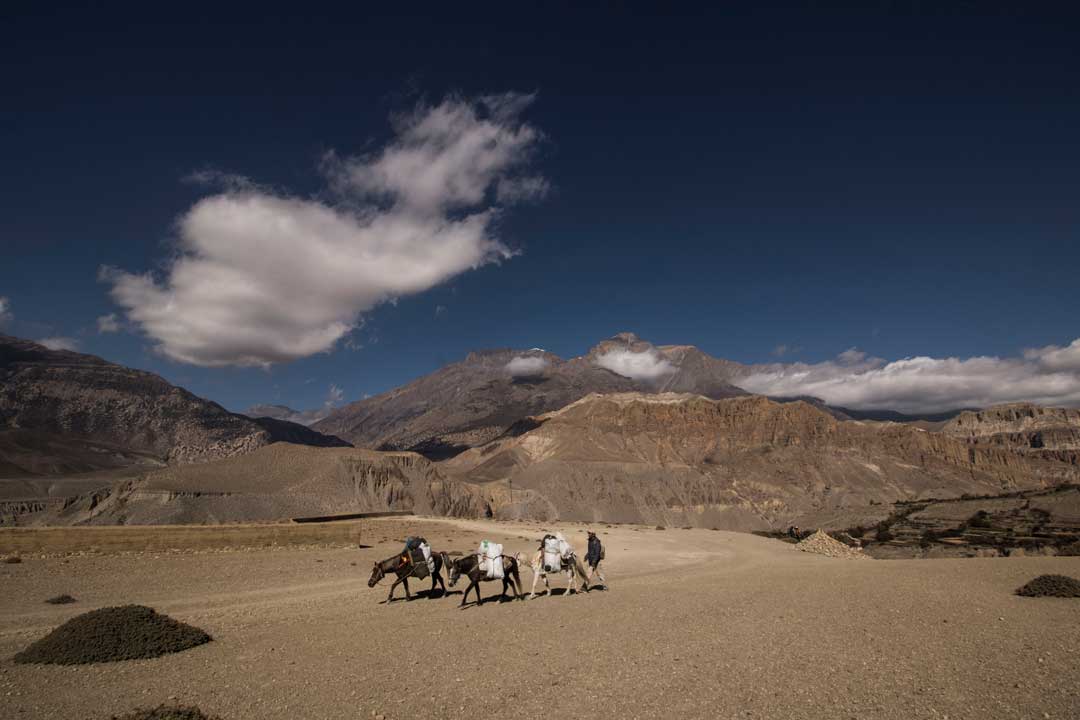
- Time: 4 days
- Elevation: 5,115metres
- Start/ Finish: Kaigaon to Sumduwa
- Permits: TIMS card and Shey Phoksumdo National Park Permit
- Accommodation: teahouses (basic)
One of the shortest hikes in Western Nepal, Kagmara La Trek is a difficult and rewarding adventure leading you to stunning mountain views as you head up to an altitude of 5,115 metres.
One of the reasons for trekkers to come to this particular area is to see the elusive snow leopard while waterfalls and blue sheep make an appearance the closer you get to Kagmara Phedi.
Getting to Kagmara La Trek can be done by flying to Jumla then joining onto to a section of trail connecting Jumla to Dunai.
When you arrive at Kaigaon, it’s time to get some altitude under your feet! At Kagmara La, there is an awesome opportunity to see the peak of Kang Chunne (6,443 metres).
Getting back to Jumla can be achieved by looping around to Dunai and then back to Jumla via Kaigaon.
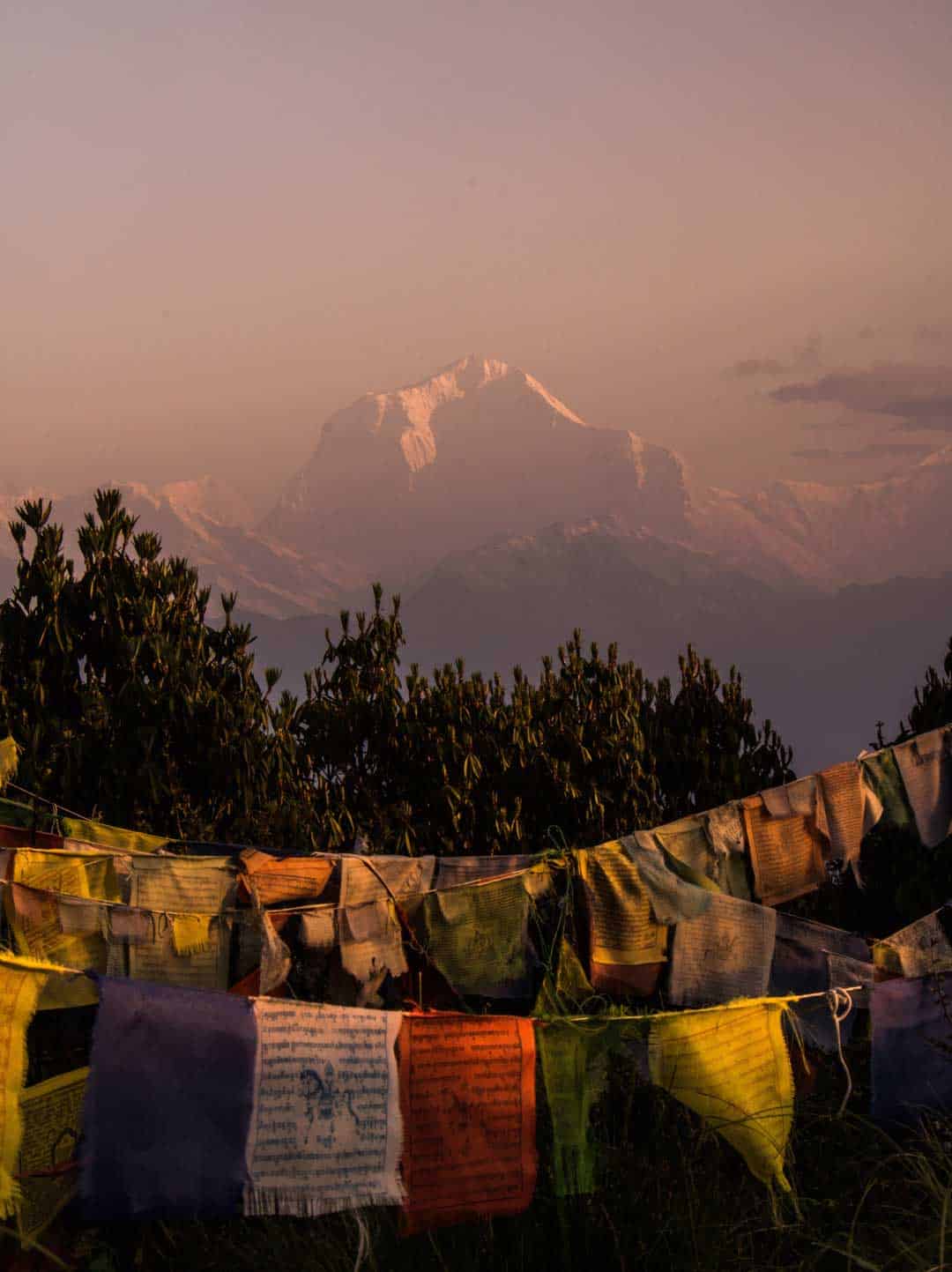
Eastern Nepal is of course home to some more epic trekking choices.
- Time: 18 to 20 days
- Elevation: 5,140 metres
- Start / Finish: Basantapur to Suketar
- Permits: $10 USD per week, per person
- Accommodation: informal teahouses (local houses)
Kanchenjunga is the 3 rd tallest mountain in the world peaking at a massive 8,586 metres and what better way to explore this mountain than to trek around it.
Due to Kanchenjunga being way east of Kathmandu, the only way to trek here is with a company who has experience in this area.
It is however possible to hire a guide and porter without the hassle of going through a larger company.
Kanchenjunga North Trek requires a fair bit of skill due to the continuous high climbs and steep descents which will take you through Rhododendron forests, along narrow ridges with spectacular mountain views even the east face of the distant Everest Range.
Pang Pema to Kambachen proves to be the ultimate days hike in Kanchenjunga with glorious mountain views of peaks over 7,000 metres including Kanchenjunga and Pyramid Peak.
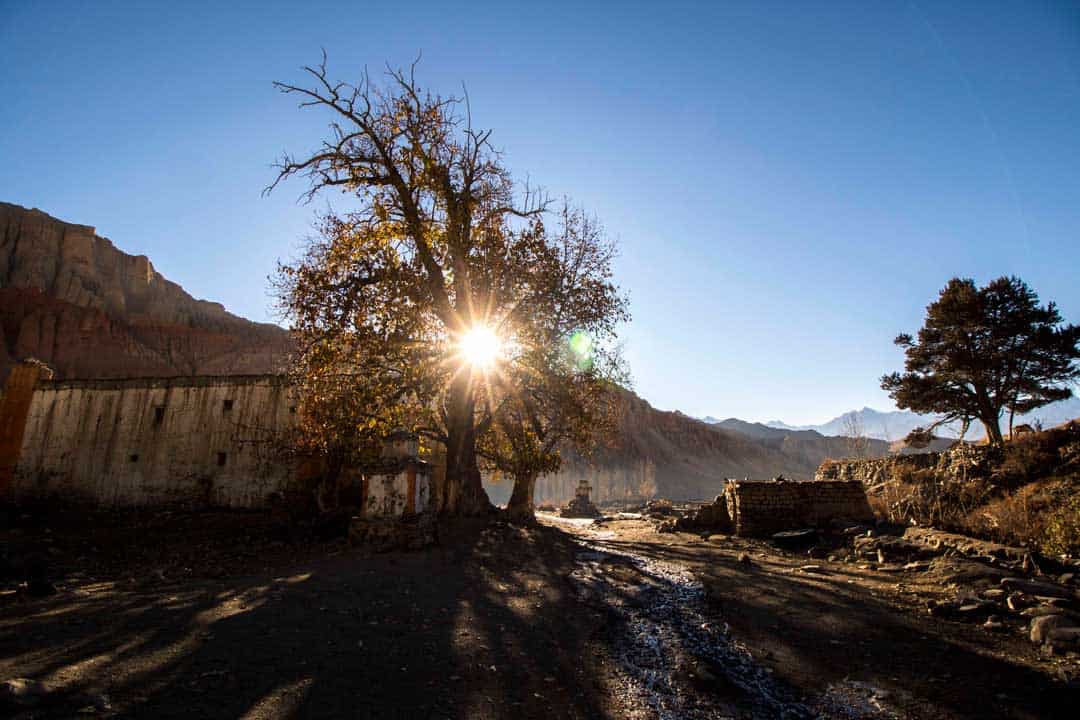
Langtang, Helambu & Manaslu Region
If you want to get more off the beaten path in Nepal, check out these treks.
- Difficulty: Easy to Medium
- Elevation: 3,640 metres
- Start / Finish: Sundarijal
- Permits: TIMS card and Shivapuri National Park pass
Helambu is only 2 hour’s drive via jeep or motorcycle from Kathmandu and promises forests of lush Rhododendrons, crystal clear waterfalls along with beautiful Himalayan views.
Helambu is a pocket of green and what better way to explore than to set out on a 6 day hike which is bound to give you a dose of healthy nature.
Helambu is surrounded by a series of khola’s (rivers) which all seem to flow towards the trail resulting in plenty of bridge crossings.
Helambu is known to most as the place where Guru Rinpoche visited especially south towards Melamchi Ghyang which is a stream. However, Helambu was affected by the 2015 so check with guides before starting this trek.
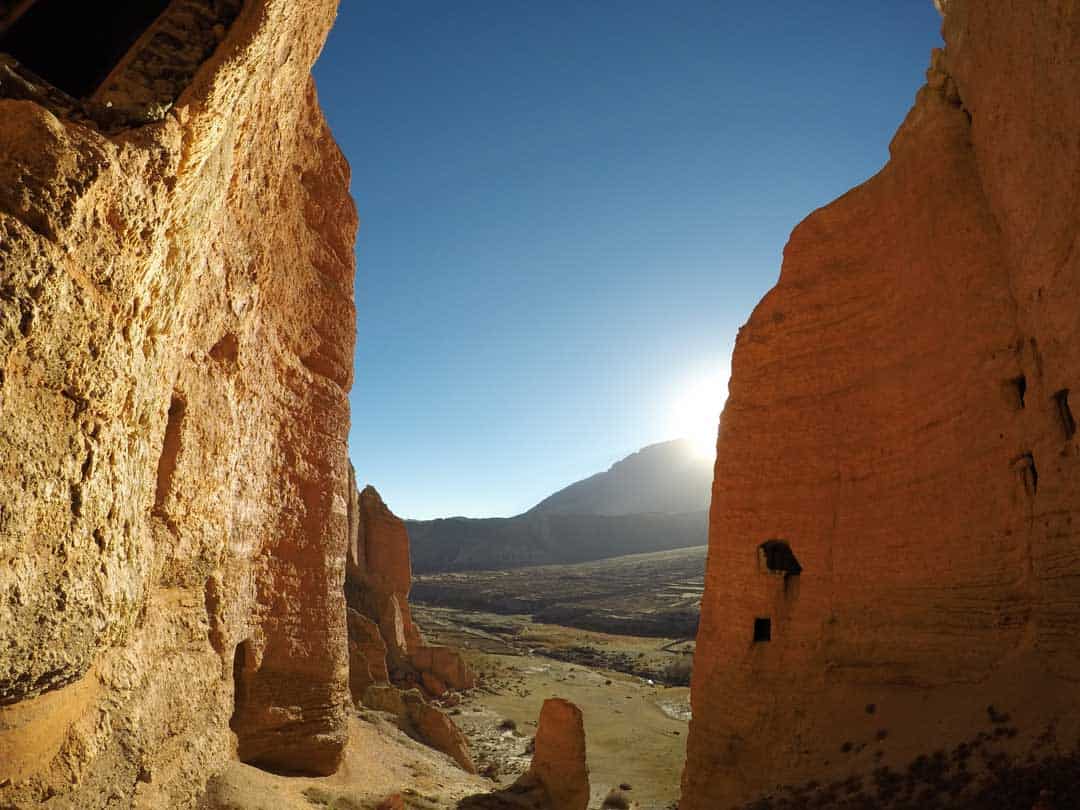
- Time: 16 to 18 days
- Elevation: 5,100 metres
- Start / Finish: Besi Sahar
- Permits: Restricted Area which requires a restricted area permit, ACAP and MCAP permit and a TIMS card
- Accommodation: Teahouses
Manaslu is the 8 th highest peak in the world and is regarded as a trek just as good as that of the Annapurna Circuit.
Unfortunately during the 2015 earthquake much of the trails and infrastructure were damaged as I am aware, efforts are being put forward to restore this beautiful trek.
Around Manaslu is a culmination of steep climbs, ancient gompas and monasteries and Mani walls all with stunning views of some of the most breathtaking mountains in Nepal with the Manaslu Himal dominating the northern part of the trek as you traverse the border of Tibet into the Annapurna Conservation Area.
Despite the earthquake damage to the trail and teahouses, Manaslu is on the rebound so check with local guides and authorities on the current situation as this trek in Nepal is a must.
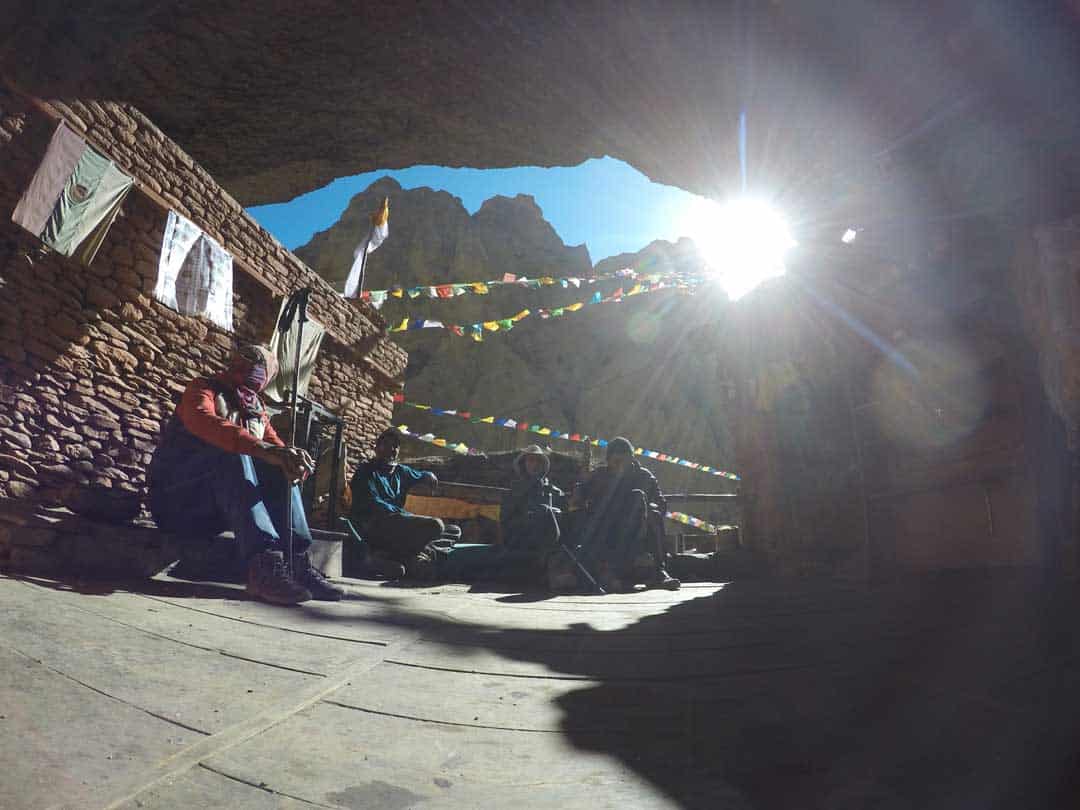
- Time: 150 days (Nepal section only)
- Elevation: Anywhere up to 5,400 metres
- Distance: 1,700 kilometres
- Start / Finish: Kanchenjunga to Darchula District (east to west)
- Permits: Check with Nepal Tourism on what permits are needed
- Accommodation: teahouse, guesthouse to tents.
Want to do it all? The Great Himalayan Trail runs through Nepal but traverses Pakistan, India, Bhutan and Tibet for the Greater Himalayan Trail.
However, the Nepal section of the hike is possible to complete trekking from east to west through most of the trails mentioned in the above.
For further information head to www.greathimalayatrail.com to sign up to one of the greatest hikes on earth!
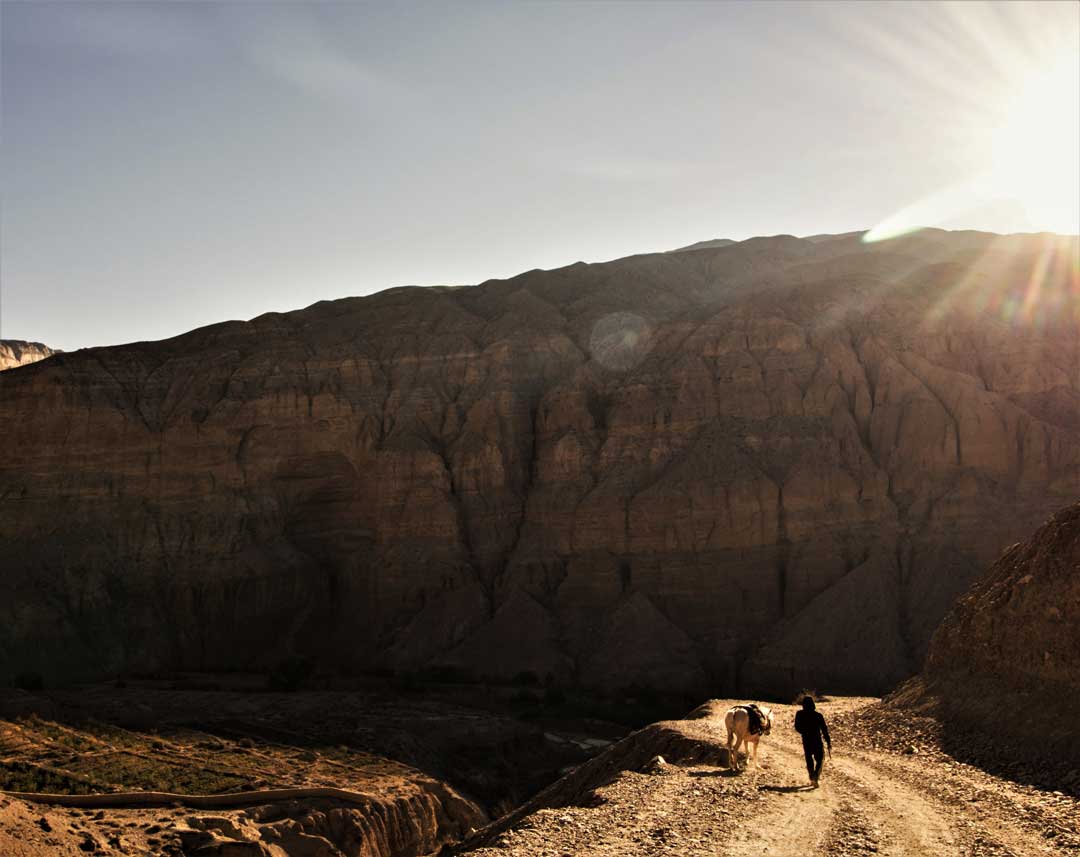
Tips for Trekking In Nepal
Nepal for a lot of people including myself is the ultimate destination for anything hiking and mountaineering with endless trails to explore.
With my past experiences of trekking in Nepal, I will share with you my best tips to get you through your hike!
I have seen so many people pack gear that simply will not be used on their hike. I simply look at my gear and ask myself “what are the chances that I actually use this?”
If I have any doubts that I will not use it, I leave it behind to save space and weight.
And always have the best backpack for hiking you can find.
Nepal is no walk in the park. I have seen so many situations where someone who has never walked further than 10 kilometres at sea level then one day attempt a hike at altitude.
This is the same at Everest with people paying big sums of money to climb the mountain without ever having used crampons or ice picks.
The harder you train, the easier you will find it and less stress you will put on your body. So where to start? Grab a back pack and put some weight in it and go walking.
Whatever you do, DON’T buy your gear when you get to Kathmandu and then go hiking.
There is nothing worse than putting on a new pair of shoes then hitting the trail immediately resulting in blisters.
Prepare your gear months in advanced to save the hassle of looking for gear in Nepal.
If you choose to have a guide accompany you on a trek in Nepal, listen to what they have to say.
Guides are very well trained are able to respond to any situation and 99% of the time they know best.
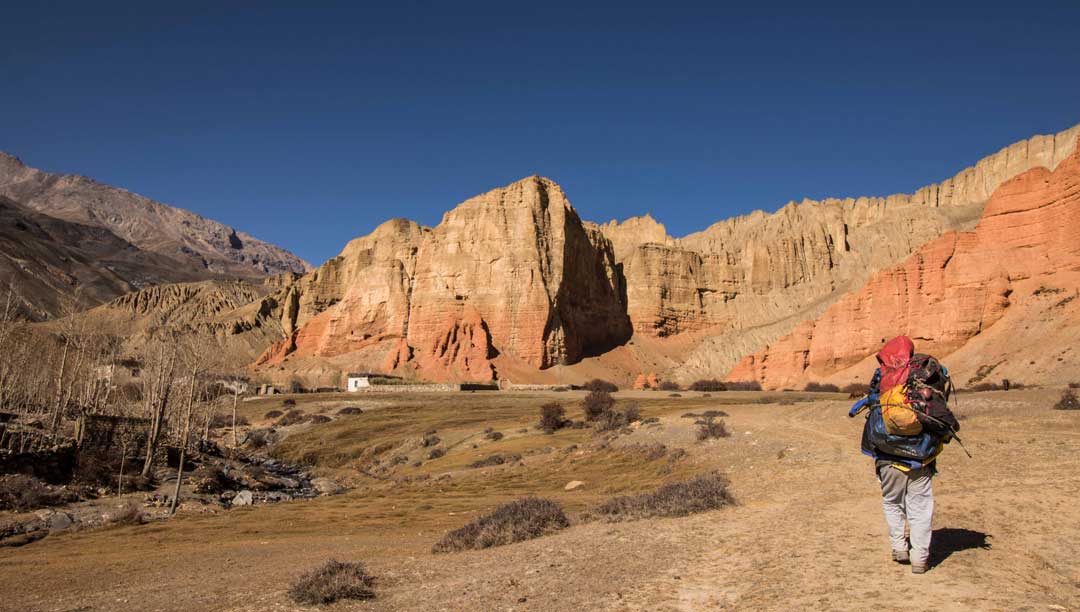
Altitude and going fast just don’t go hand in hand. If you are attempting to do Thorung La or Everest Base Camp, take it easy as there is less air higher up than there is at sea level.
The slower you go up and more frequently you rest, the better your body will be in adapting to the thinner air.
You may be thinking that this is stupid but when conditions are colder, you tend to drink much less.
Dehydration and altitude are a terrible mix so to avoid this, bring something that you can mix in with your water to encourage yourself to drink more.
If you have drunk enough fluids, your urine will be clear meaning you are hydrated.
Recycling isn’t really a thing in Nepal so you will need to take your own water bottle. I bought a Nalgene water bottle 2 years ago in Kathmandu and I still use it to this day.
I have taken it hiking on the Larapinta Trail, Annapurna Panorama and Upper Mustang Trek and I still use it on a regular basis. It cost me $4.
Hiking at altitude can bring on Acute Mountain Sickness or AMS and can sometimes be hard to spot.
AMS can only be diagnosed when discovered by your guide or another person in your group as you may not be aware you are having any difficulties at altitude.
The sooner AMS is diagnosed, the quicker you can act to relieve the symptoms.
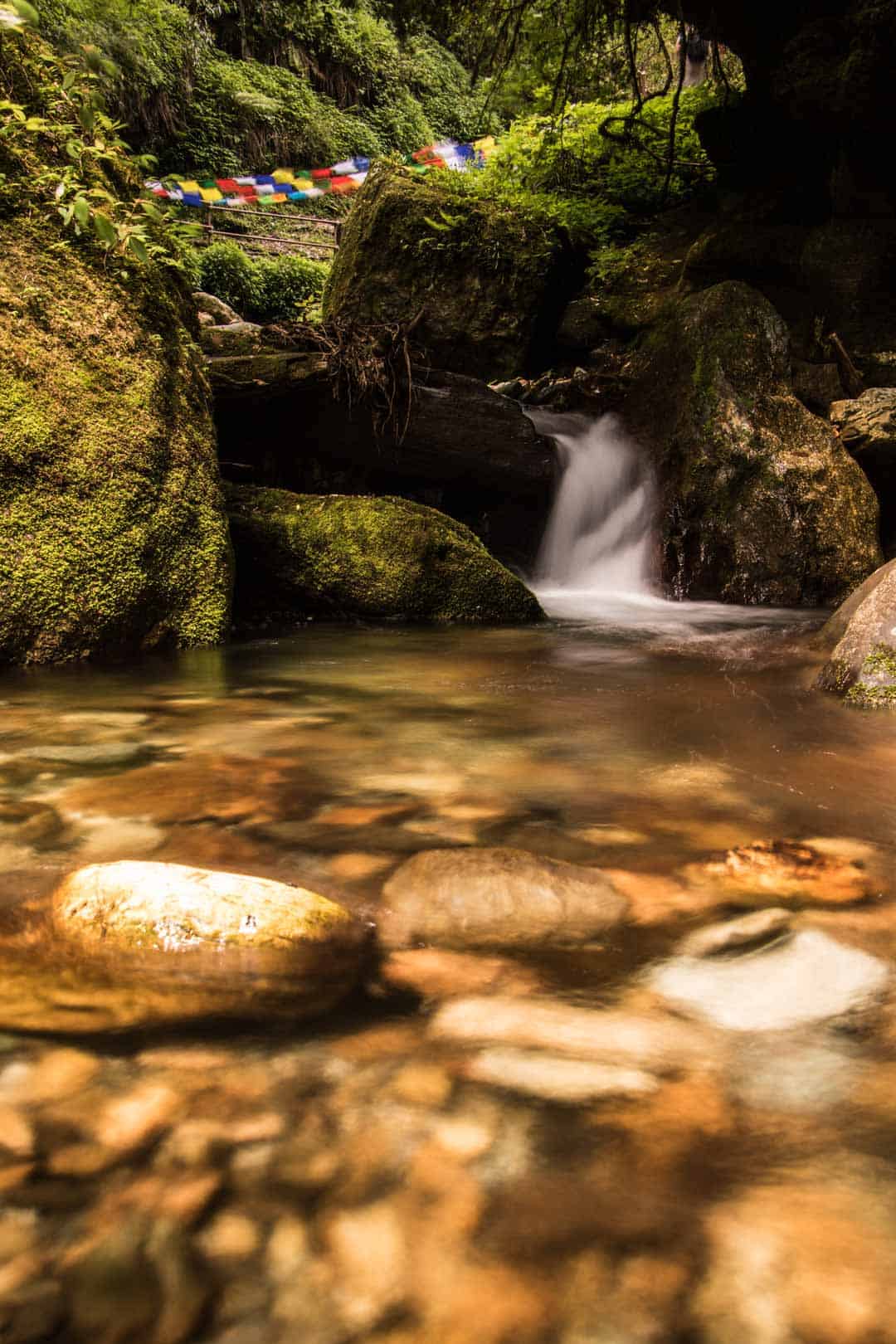
Various treks in Nepal require different equipment and gear so when you are packing your own, check weather forecasts and altitude.
I am going to list the essentials for the hikes listed above so no need to worry about things like crampons and ice picks unless you are attempting the Dhaulagiri Trek and Great Himalayan Trail.
- Thermal clothing
- Down jacket
- Wind stopper jacket which can double as a rain jacket if good quality
- Buff for protecting your face from wind and regulating temperatures that go into your lungs
- Sunglasses are a must as the higher you are up, the higher UV levels the more glare there will be plus sunglasses protect your eyes from wind and dust
- Socks; you can never have enough socks when hiking.
- Hiking pants
- Snow gaiters are fantastic for places like Thorung La if the snow is deep
- Gloves are a must. When buying gloves make sure you have the outer shell which ideally are waterproof and the inner parts made from warmer materials
- Hiking boots; make sure they are waterproof and breathable
- Sleeping bag; teahouses are warm places but there is nothing more satisfying than having your own sleeping bag. Make sure your sleeping bag has a silk liner aswell!
- Sleeping mat; a compact sleeping mat is always a must if sleeping in a tent
- Dry bag is an essential item if you are carrying camera gear. Nepal is known for its monsoon rains so a dry bag is essential to keeping your gear bone dry
- Hiking bag; make sure your bag is a comfortable fit and you are used to wearing it before heading off on a trek
- Tent; in peak season in Nepal especially Everest Base Camp and Annapurna Circuit treks, teahouses can be full everywhere you look so having a compact tent in case of situations like this can be very handy
- Hiking poles help distribute weight from your bag to your poles and help you balance. One hiking pole instead of two can be used especially if you have multiple cameras like me
Calumn Hockey
Hi, We’re Alesha and Jarryd!

We’ve been traveling the world together since 2008, searching for the planet’s best destinations and adventures.
Love Travel?
Sign up for our free weekly newsletter for the best travel tips, ideas and deals!
We respect your privacy. Unsubscribe at any time.
READ MORE...
The 12 BEST Places to Visit in Kathmandu, Nepal [2024]
Hiking the Annapurna Circuit – Trekking Information [2024]
The Ultimate Guide to Nepal’s Poon Hill Trek
Related posts, my time spent in a prison in nepal – part 2, my time spent in a prison in nepal – part 3, how to survive a natural disaster abroad, 52 thoughts on “trekking in nepal – the ultimate guide to the best hikes”.
After reading this, a Himalayan trekking adventure is at the top of my travel bucket list. I’ll be sure to refer back to this article as I start planning a trip. Great job!
Beautifully crafted article.
Calumn Hockey, nice blog. Thanks for sharing a great blog story about trekking in Nepal.
Glad you enjoyed the article Manit. 🙂
Great!!! Blog about Nepal trek.
great information Articles about your Nepal trek, it’s so detailed info about Everest base camp, Manaslu, Langtang Helambu trekking. thank you for sharing such great Informations Articles. I enjoyed to reads so much.
This is one of the best blogs I have ever read so far. Nepal is a dream destination for enthusiastic travelers and trekkers. So, this post definitely helps the keen trekkers who are planning to trek in the most wonderful destinations of the Himalayas. Whatever you have written is enough to know while trekking in Nepal. Thank you so much for the great effort. Keep writing about Nepal and Traveling.
Glad you liked our article. Thank you for your comment. 🙂
Yeap, The best country in the world for the best treks. The place of course is where the worlds tallest peak exists and other many tallest peaks in the world. Do visit Nepal for the lifetime experience and would recommend to visit the place through a satisfactory Travel Agency in Nepal. Is is mostly for your Safety during the trip. Also thank you for sharing your experience and the Beauty of Nepal.
Thank you for your comment Bijay. Take care
Hi Alesha and Jarryd!! Thanks for all the tips that i have been in your web… But i have a dude… i´m interested in Everest Base Camp Trek, but i think the first two weeks of December is late to do it, that´s right? Thank you so much!
Best to contact a tour company thaqt does the Everest Base Camp Trek. All the best.
Great post! You’re so right, hiking is no joke and having the right shoes is so important! I also think my Keens are the bomb – I got them stuck in quicksand one time and when I took them off later my socks were completely dry!! The waterproof element makes hiking so much more comfortable.
Great article, photos with inspiring contents, congratulations
Thank you so much for the blog. It was very helpful and informative too. I would prefer the Everest base camp as it is very mesmerizing and beautiful. And the second one would be the Annapurna base camp.
Thank you for your comment. 🙂
it’s my pleasure to your collection and information about many trekking trail and their difficulty ,thanks for sharing such a great post..
Thank you. Glad you liked the article.
Hi, first thx for a good site and explanation i am going to Nepal in late october, but i am unsure if i should choose a travel agency or maybe just make contact with a guide there. What is your suggestion ? If okay with just a guide, then how to find and do you have suggestions ? Regards Lars
Hi Lars, do you have a few days before hand in Nepal? It is totally up to you, but have you thought about booking it there so you can meet the travel agent or guide? We are not to sure how to get in touch with a local guide. Sorry. All the best and how you have a great trip.
Hi, it was a long but very informative nice reading. We decided to go on a Mardi Himal Trek with company called Soulful Nepal after a long discussion with their representative over phone and email. Do you guys recommend going a trek with this company? Any suggestion?
Sorry we are not too sure. We haven’t had any experiences with this company. Let us know how you go. All the best and have a great trip.
Hi – do you recommend any guides/companies that we can book with?
Thank you Alesha and Jarryd for sharing informative post, which is really helpful who will be visiting Nepal.
Thank you for sharing you experience trek , great article . if you have time to visit my mountain Rinjani Volcano in Lombok , I’m so happy to meeting you Alesha and jarryd
Hi, thank you so much for sharing this. What a great and incredibly useful post. I’m planning to travel to Nepal and want to do one or two treks. I think Everest is out of the question but have been dreaming about travelling to Mustang for a long time. Did you trek there with a tour? Or did you hire a guide? For an over 40s women solo traveller which treks would you recommend? Many thanks
Thanks for your details information about best trekking trail in Nepal and it’s tentative cost. it will more helpful for making my next trekking plan in Nepal.
Glad the article was helpful. Have a great time. 🙂
great article there. annapurna circuit & manaslu circuit might be the best treks to do in nepal but these treks does require the good physical fitness right. For absolute beginners these treks could be hard to achieve. For absolute beginners ghorepani poon hill trek, panchase village trek might be an option.
Thank you for your comment and your advice. 🙂
I would like to spend the New Zealand winter (May, June, July August) hiking in Nepal. What regions could I trek given that it’s monsoon that don’t require the US $500/10 day permit? I can only afford to go to Upper Mustang and so would like to spend the rest the time in more affordable regions
Hi Mark, thank you for your message. This is a guest post from Calumn about Nepal. You can contact Calumn and he might be able to help you. Sorry about that and all the best. https://calumnh.com/contact
Very informative series of article on trekking in Nepal, which help Himalayan trekkers to choose them destination easily with available time and budget.
Thank you Taranath 🙂
It is great and details informative blog post about the trek in Nepal thanks for sharing your experience and information to the world
Thank you for reading.
Hi! Thanks for the comprehensive article. Is it still the case that you can trek independently? Because there is some unclarity about regulations changing and the fact that guides are now compulsory for foreign toerists…
Hi Els, we are not too sure. Maybe contact some hiking companies and see what they say. Hiring a guide between a group would not be that expensive if need be.
So rad!! Congrats for the post, we are already wondering when it’s going our next trip to Nepal after soooooo many adventures there between those rock gigants & the yaks (love those animals!), definitely is an amazing country. Now we are planning to visit the Dolpo area, people say its an insane place!!
Thank you for your comment Albert. Sounds like you have done some amazing trips and have some more great ones int he pipeline. Have a great trip.
Hi Alesha and Jarryd this is the most comprehensive travel guide to Nepal. Its very informative and makes travel easier.
Thank you so much Lydia. Calumn wrote a great post for us. Glad it is helpful. 🙂
To be honest the article help me in gathering detail information on best treks of Nepal in indepth way. Its wonderful
Glad it was helpful. Thank you for your comment.
This is simply a beautiful article on Nepal trekking.
Thank you so much. We are stoked your were happy with Calumn’s article
Wow. This is very good and very helpful. I’m definite that this has helped a whole lot of bunch.
Thanks a lot for this.
Glad the article could help. 🙂
Calumn Hockey, nice blog. This is the ultimate guide to those who are looking for Trekking and Hiking in Nepal. Thanks.
Thank you so much for reading. There are so many wonderful hikes and treks to do in Nepal.
Thanks for sharing a great blog story about trekking in Nepal. Namaste!
Glad you enjoyed it. 🙂
Leave a comment Cancel reply
Save my name, email, and website in this browser for the next time I comment.
Pick your peak: discovering Nepal's best trekking regions

Apr 29, 2020 • 7 min read
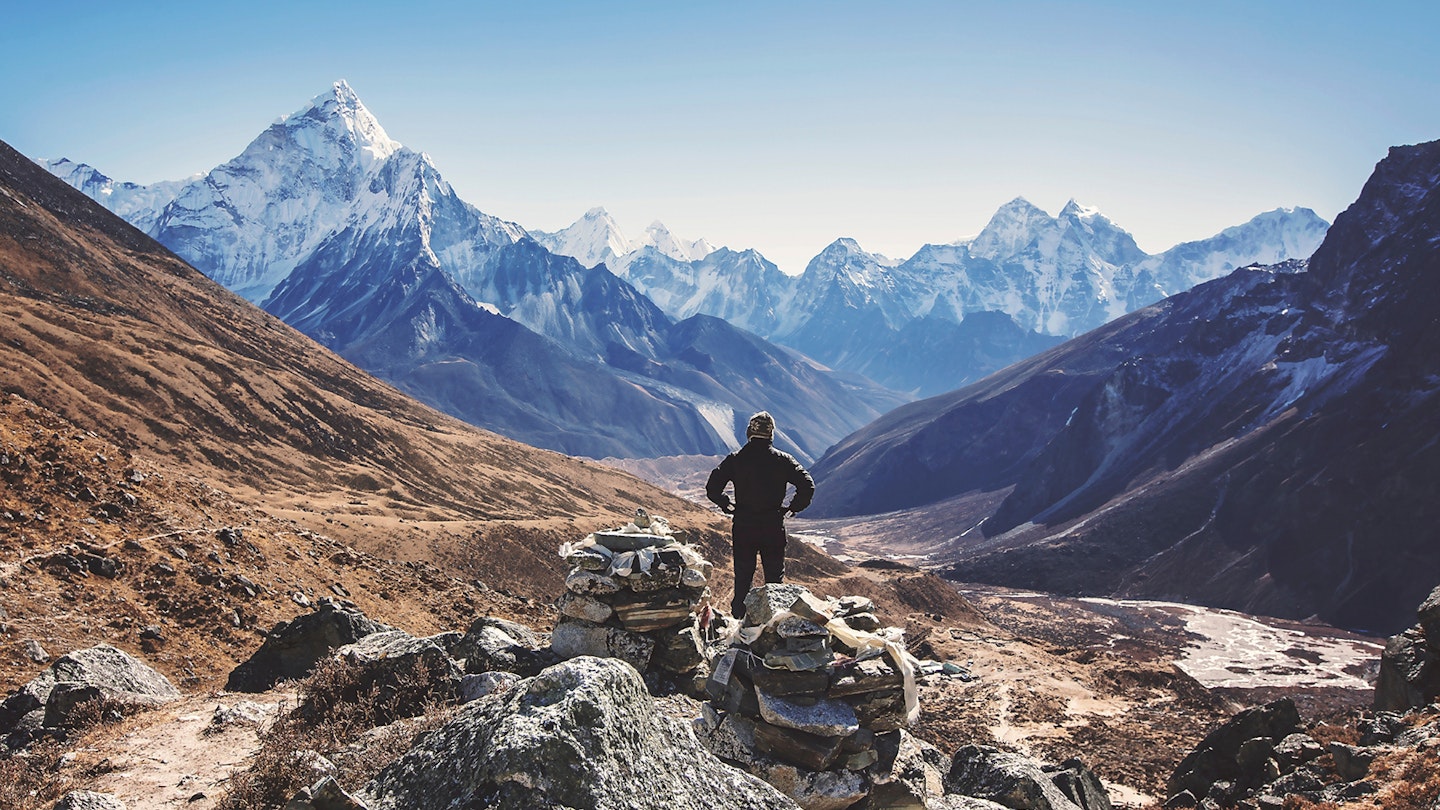
Hikers are spoilt for choice in Nepal © Fahad Mohammed / 500px
With front-row seats for the world’s highest mountains, Nepal is a country-sized adventure playground for lovers of the great outdoors. In the Nepal Himalaya, trekkers can clamber over creaking glaciers and tie prayer flags atop knife-edge mountain passes, before stopping for the night in ancient stone villages, sharing the camaraderie of the trail with a legion of like-minded trekkers over salted butter tea.
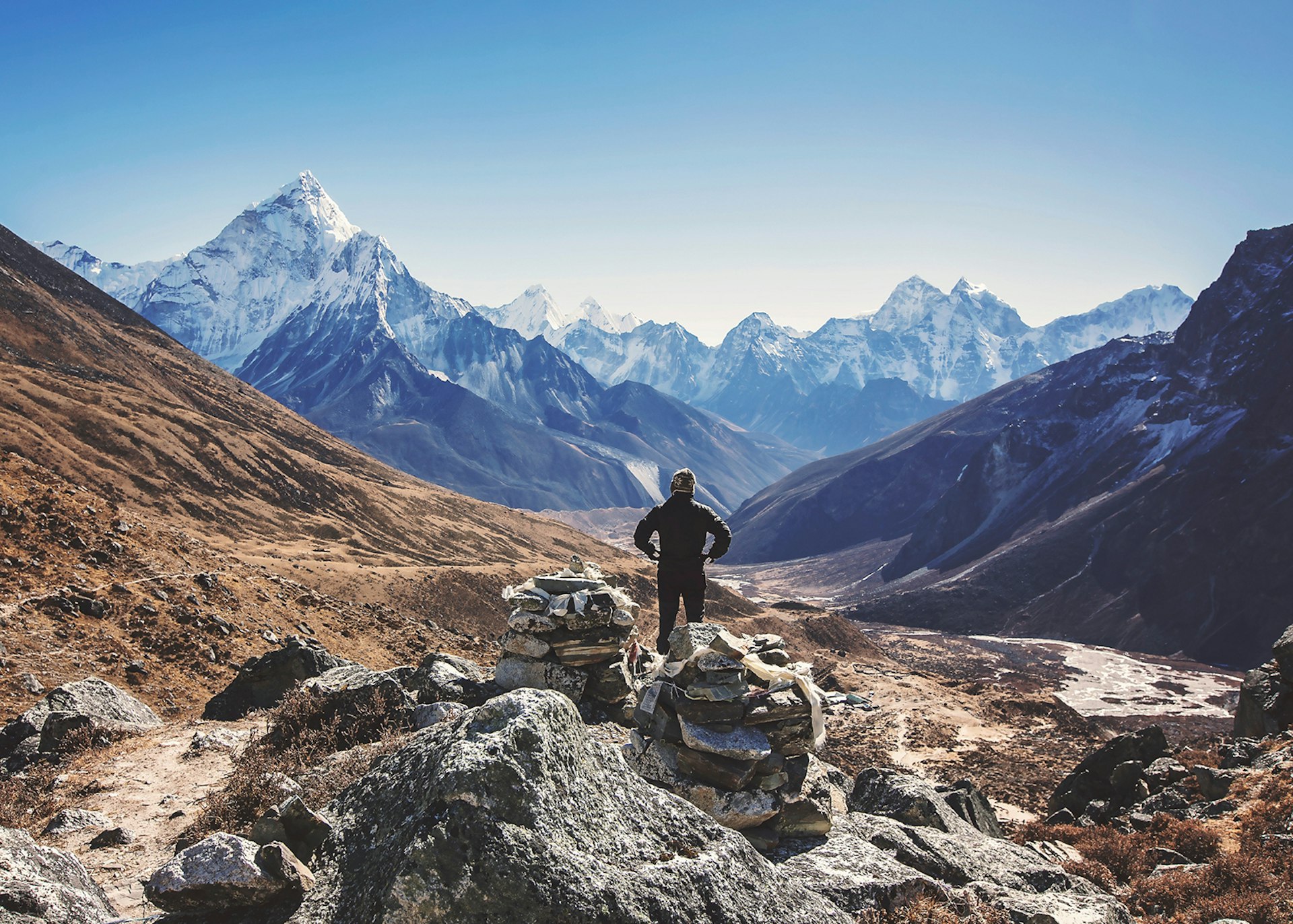
With Nepal’s fantastic trekking infrastructure, you don’t need to do much more than fly in, arrange a trekking permit, and start walking, but you do need to decide where to go – no easy task in a country with this many mountains.
Towering snowy peaks trace the northern reaches of Nepal in a mighty sweep from 7132m Mount Api in the west to 8586m Kanchenjunga in the east. Most trekkers make a beeline for Everest Base Camp, or the looping trek encircling the Annapurna Range near Pokhara , but there are dozens of other treks, some starting within walking distance of the capital, Kathmandu , and others only accessible on challenging camping expeditions with packhorses and guides. Here’s an overview of what to expect from Nepal’s top trekking regions.

Everest Region
Good for: Views Bragging rights Sherpa Buddhist culture Creature comforts
The high-altitude valleys of Solukhumbu form the main approach route for ascents of Mt Everest (8848m), and Everest Base Camp (EBC), the tent city used by mountaineers attempting the summit, is one of the most famous trekking destinations in the world. This does mean crowds. Up to 1000 trekkers arrive at the tiny mountain airstrip at Lukla every day during the peak trekking months from October to November and March to April, putting sleeping bag space at a premium.
The flip side of popularity is excellent infrastructure. Comfortable trekking lodges line the entire route from Lukla, and modern-world luxuries such as Snickers bars, hot showers and Wi-Fi internet are available all the way to Base Camp. Factor in ancient Buddhist monasteries, yeti relics and awe-inspiring views of Everest, plus side treks to glacial lakes, Ama Dablam and other landmark summits and it’s easy to see the appeal.
Classic treks: Everest Base Camp (16 days) – the definitive Nepal trek, climbing right onto the flanks of Everest, with grandstand views of the world’s highest mountain. Three Passes Trek (20 days) – the Everest Extension, linking the Gokyo, Kumbhu, and Imja valleys over three of the world’s highest navigable passes.
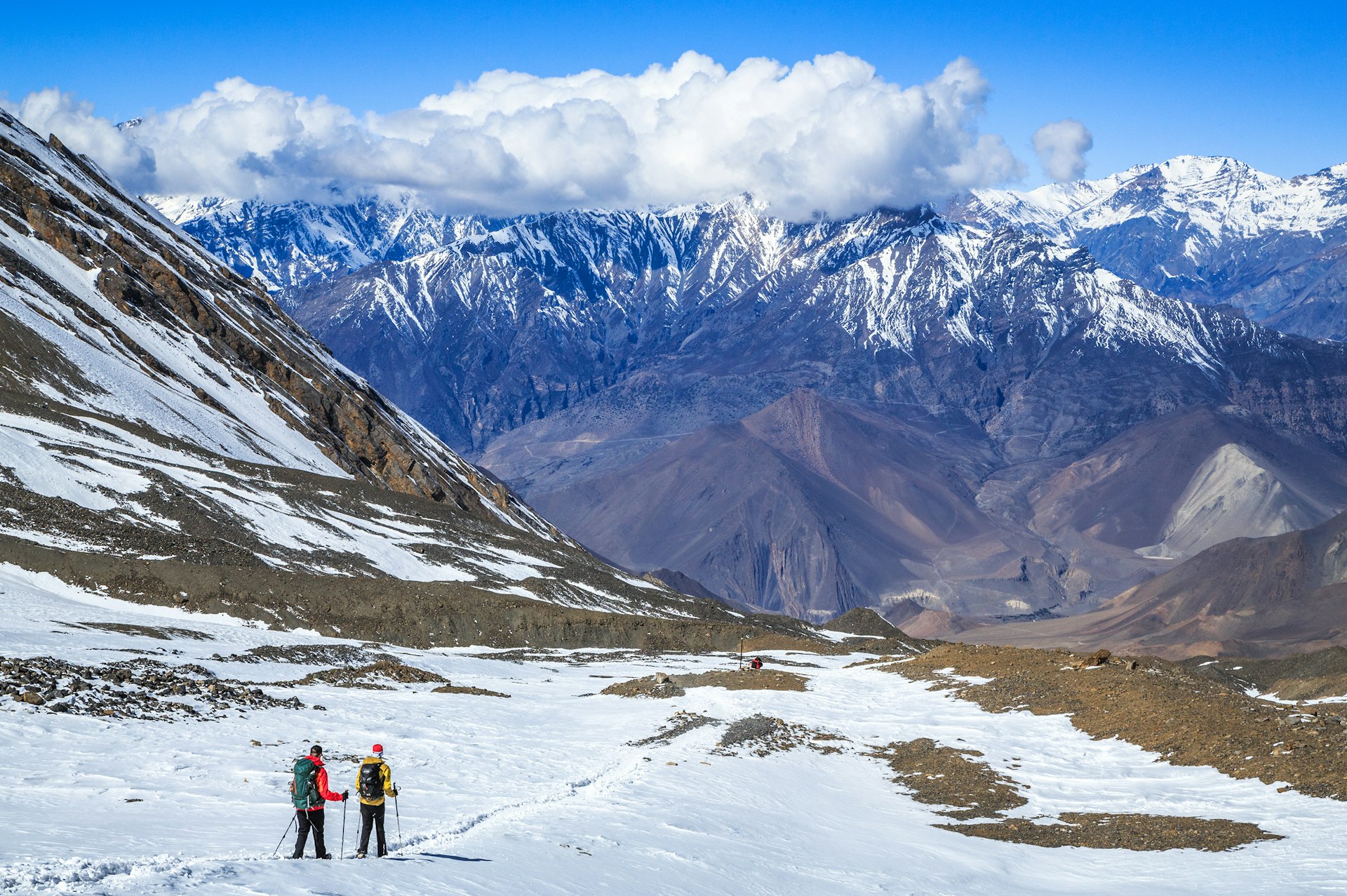
Annapurna Region
Good for: Views High Passes Comfortable lodges Apple pie
North of Pokhara, the Annapurna Massif boasts 14 peaks that exceed 7000m, including Annapurna I (8091m), the tenth highest mountain on earth. Trails approach the peaks from both the south (Annapurna Sanctuary) and north (Annapurna Circuit) and impressive tourist infrastructure lines both networks of routes (not for nothing is this known as the Apple Pie trail). Road building has had a bigger effect on trails here than in any other region of Nepal, but the accessibility of the region and its classic views of peaks like Machhapuchhare and Annapurna South ensure this remains Nepal's most popular trekking region.
The famous Annapurna Circuit is just one path through the Annapurnas. Almost as popular is the ten-day tramp to the Annapurna Sanctuary, while dozens of smaller trails link the Gurung stone-walled mountain villages north of Pokhara on routes that be done in just a few days. Most trailheads are just a couple of hours' drive from the well-connected town of Pokhara.
At the other end of the spectrum, remote Mustang and Nar-Phu offer expedition-style detours off the Annapurna Circuit for trekkers with special permits, visiting parched high-altitude deserts that are refuges for Tibetan Buddhist culture.
Classic treks: Annapurna Circuit (18 days) – The definitive Annapurna trek, circling the massif and crossing the breathless Thorung La (5416m). Annapurna Sanctuary (10 days) – A journey to the heart of the Annapurnas, through valleys iced by mighty glaciers.
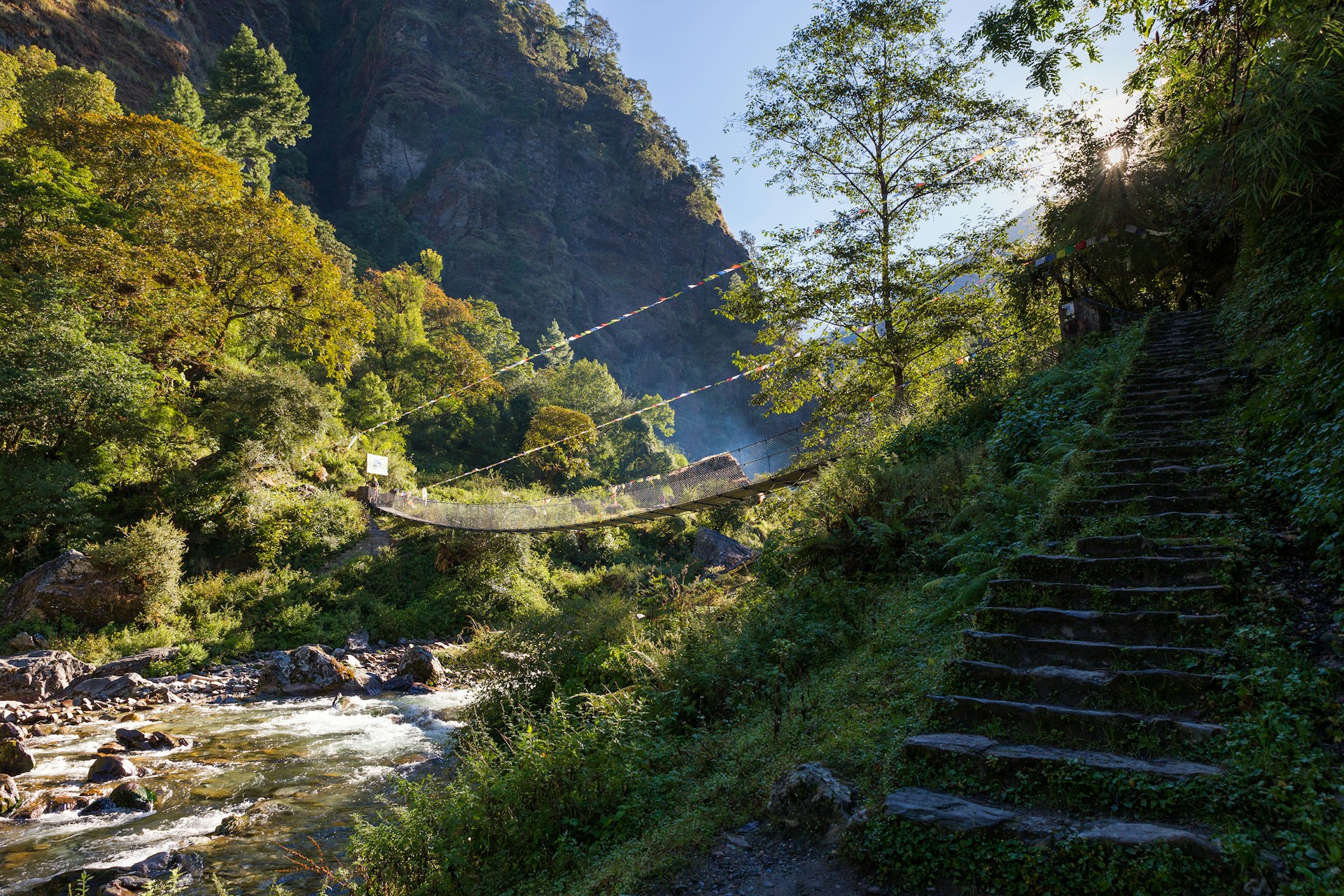
Langtang, Helambu and Manaslu
Good for: Mountains and monasteries Proximity to Kathmandu Traveller camaraderie Low elevation
Langtang and Helambu were hit badly by the earthquakes of 2015, but nothing keeps Nepal down for long, and lodges across the region have been rebuilt better than ever, offering some of the most rewarding short treks close to Kathmandu. In place of a hair-raising mountain flight, a simple bus ride will whisk you to the trailheads for exploring the Langtang Valley and a spiderweb of side-trails through the surrounding uplands. As another bonus, few trails exceed 3870m, reducing the need for rest-days to acclimatise to the altitude.
East of Langtang, epic Manaslu is Nepal's best-kept secret, offering an ever-changing palette of Himalayan scenery, as dramatic as Everest and Annapurna but without the crowds. An excellent add-on is the side trip to Tsum, a junction of high valleys bordering Tibet that combines Tibetan culture, monasteries and traditional villages.
Classic treks: Langtang Valley Trek (7-9 days) – Restored after the 2015 earthquake, the trail to Kyanjin Gompa is back on the map as a classic short trek, within easy reach of Kathmandu. Around Manaslu Trek (16-18 days) – A high-altitude epic, through valleys well off the beaten path, in the shadow of mountain giants such as Himlung Himal (7126m) and Manaslu (8163m).
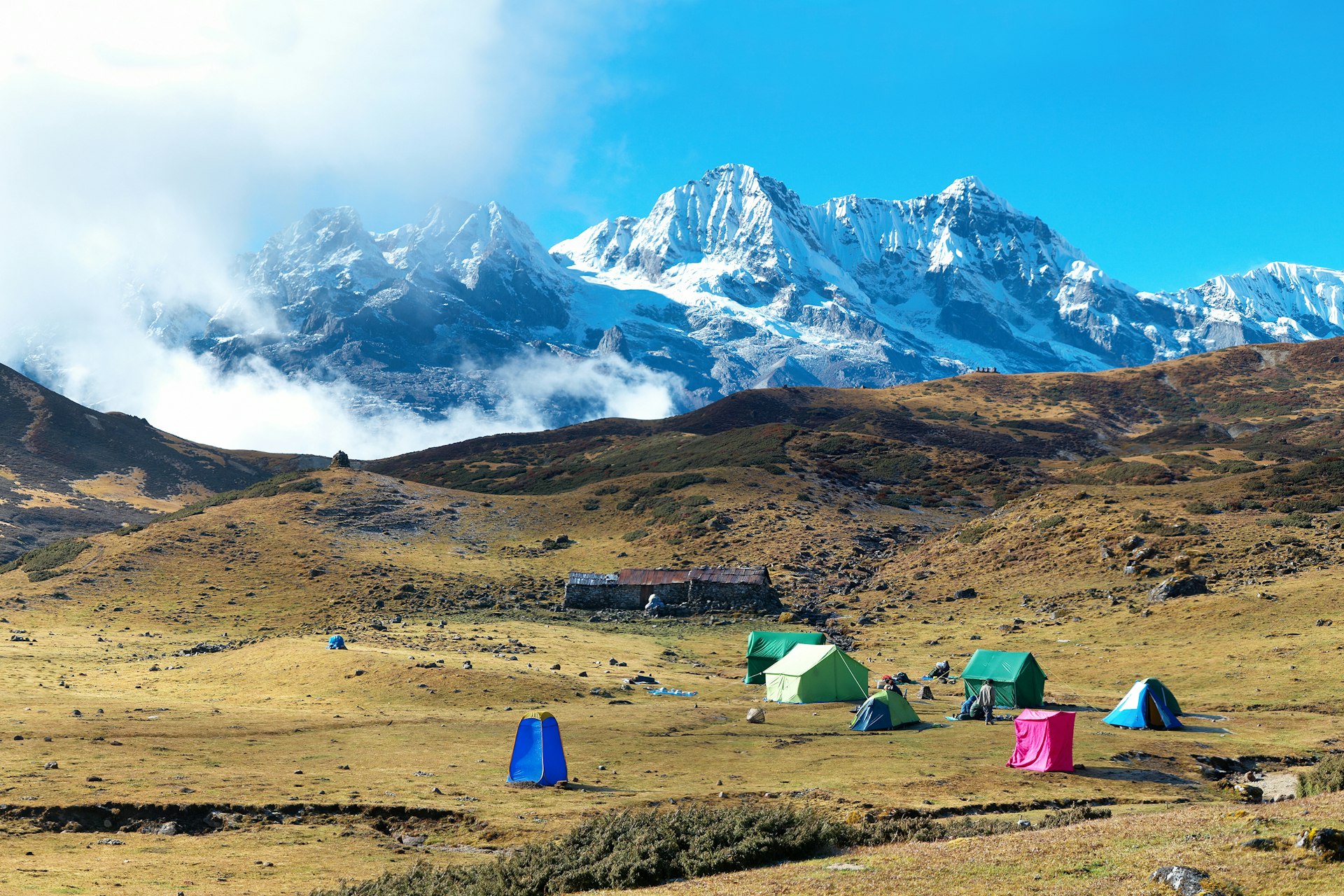
Eastern Nepal
Good for: Peace and quiet Empty trails Wildlife watching Close up views of Kangchenjunga
Compared to the established trekking routes around Everest, Annapurna and Langtang, Nepal’s rugged east is uncharted territory. Crude teahouses dot the lower slopes in summer, but the high altitude valleys are only accessible on camping expeditions, with special permits and guides. In exchange for foregoing Wi-Fi and apple pie, you get unparalleled vistas of Kangchenjunga (8586m), the third highest peak on earth.
If Kanchenjunga feels too ambitious, consider the world’s fifth highest peak, Makalu (8463m). Just a trickle of independent trekkers attempt the trail, which links widely-spaced teahouses and camping grounds en route to the mountaineers’ base camp at 4870m. Pioneering routes connect Kanchenjunga and Makalu via the remote Lumba Sumba Pass, perfect for anyone interested in a wild camping adventure
Two great advantages of trekking in eastern Nepal are the spring rhododendron blooms and the year-round tongba , traditional millet beer served warm in wooden tankards to stave off the mountain chill. This is also Nepal's wettest region, so bring good waterproofs.
Classic treks: Kangchenjunga North (18-20 days) – The most spectacular approach to Kangchenjunga, a camping climb through remote alpine valleys you may have entirely to yourself. Makalu Base Camp (13 days) – A remote ramble to the base camp for climbers attempting Makalu (8463m), through untamed country with a scattering of rustic teahouses.
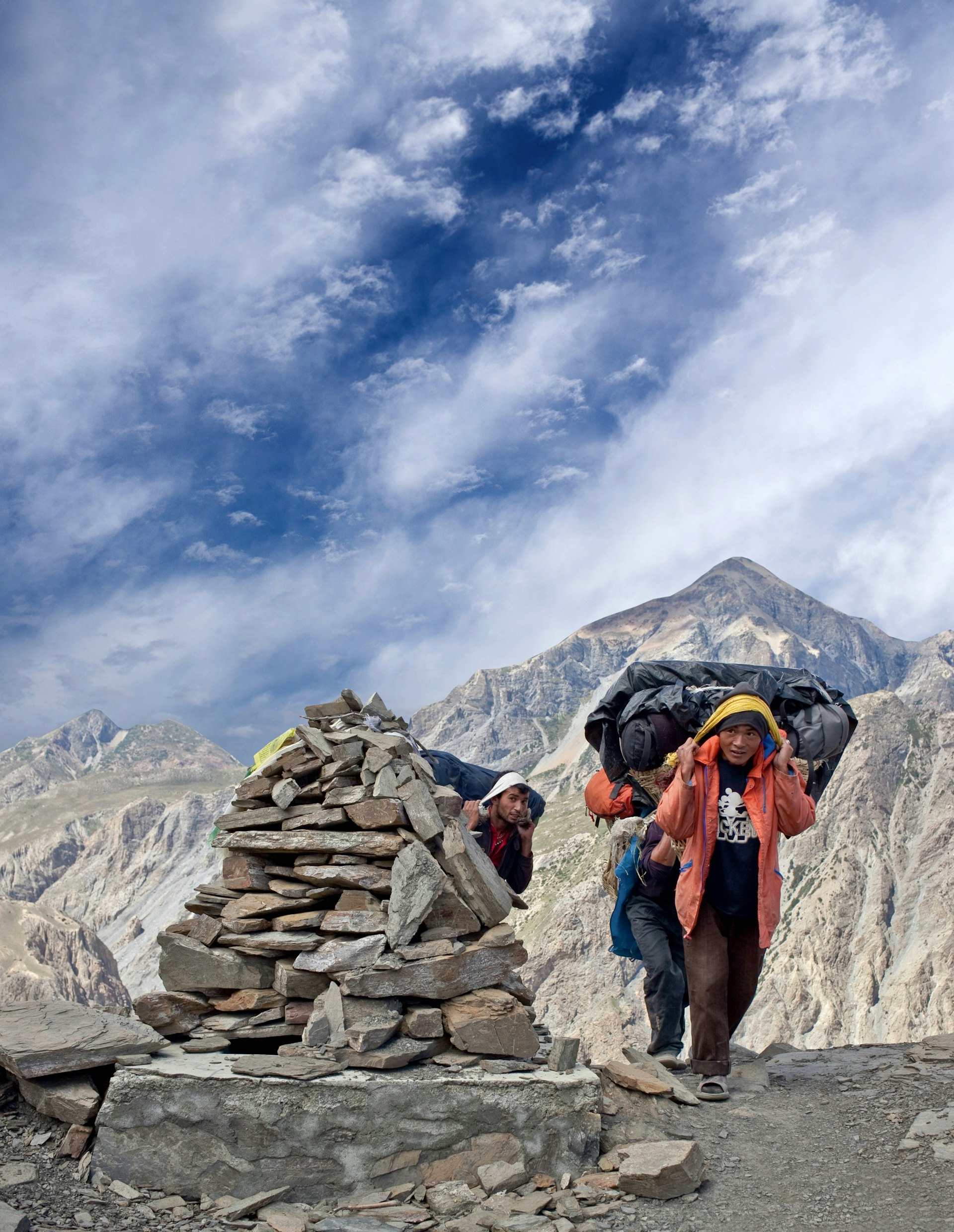
Western Nepal
Good for: Mountain lakes Remote monasteries Trekking off the map Wilderness
Trekkers who venture to the west of Nepal enter a world of pristine wild scenery, icicle-clear mountain lakes and ancient Buddhist kingdoms edging onto the roof of the world. There’s little support for trekkers here; most routes are only accessible by mountain flights, and you’ll need a trekking company to arrange restricted-area permits, guides, packhorses, camping equipment and food. The reward for all this planning, organising and expense is the chance to trek far beyond the familiar Nepal, meeting remote communities who have been touched only lightly by the modern world.
Most visitors drop in via the airstrips at Dunai and Jumla, but a few hardy souls trek into Dolpo overland from Beni, following a route made famous by Peter Matthiessen’s The Snow Leopard . The placid lakes of Phoksumdo and Rara are impossible pools of blue-ringed by unknown mountains, while Dolpo and Humla offer glimpses of ancient Buddhist civilisations that cling on only in the remotest valleys in the Himalaya. Best of all, you can trek for days without seeing a glimpse of Gore-Tex, beyond your own small trekking group. Wild routes from Dolpo to Mustang or to remote peaks like Api-Saipal are for true Himalayan connoisseurs.
Classic treks: Beni to Dolpo (12 days) – A legendary camping trek through the high valleys of Dolpo, home to elusive snow leopards, and more Himalayan blue sheep than people. Jumla to Rara Lake (9 days) – Short and strenuous, but perfectly formed, the trek to millpond-calm Rara Lake passes through scented forests that teem with Himalayan wildlife.
You might also like: 6 must-visit day-trip destinations from Kathmandu How to be a responsible Everest Base Camp trekker The best places to see tigers in the wild
This article was first published in October 2017 and last updated in April 2020.
This article was first published October 2017 and updated April 2020
Explore related stories
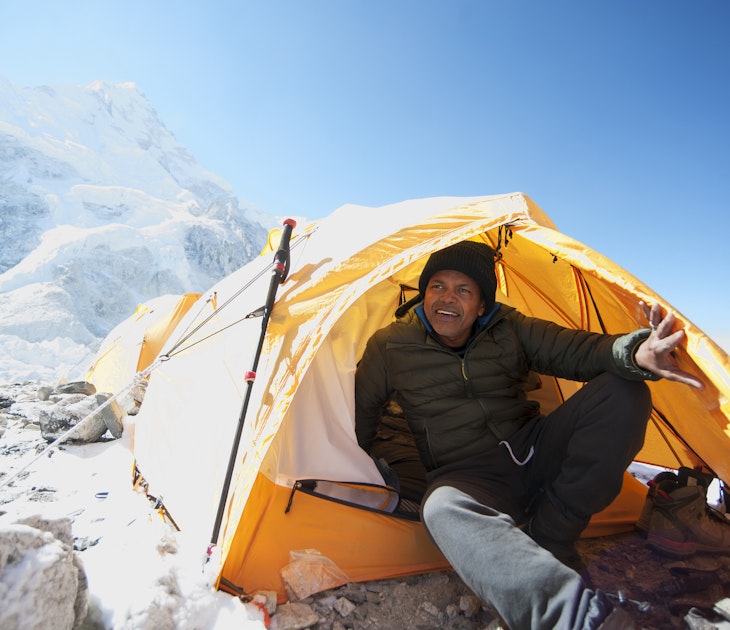
Jun 20, 2023 • 10 min read
Lonely Planet writer Bradley Mayhew recently returned from trekking to Everest Base Camp. Here’s what he thinks every visitor needs to know.

Mar 14, 2023 • 4 min read

Jul 13, 2022 • 8 min read

Jan 31, 2022 • 6 min read
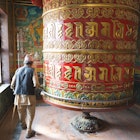
Jan 9, 2022 • 8 min read

Sep 14, 2021 • 11 min read

Jan 28, 2021 • 5 min read
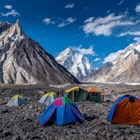
Jan 12, 2021 • 7 min read
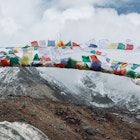
Dec 10, 2020 • 6 min read
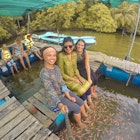
Jan 7, 2020 • 6 min read
Ace the Himalaya
Trekking in Nepal, Peak Climbing, Mt Biking and Tours in Nepal, Bhutan and Tibet
- Everest Base Camp Trek - 14 Days
- EBC Trek with Helicopter Return - 12 Days
- Everest Base Camp Luxury Trek - 14 Days
- Everest Base Camp with Island Peak - 19 Days
- Everest Three Passes Trek - 20 Days
- Annapurna Base Camp Trek - 13 Days
- Annapurna Circuit Trek - 19 Days
- Ghorepani Poon Hill Trek - 9 Days
- Manaslu Circuit Trek - 15 Days
- Gokyo to Everest Base Camp Trek - 17 Days

Ultimate Guide to Trekking in Nepal
Whether you're an experienced hiker or a novice, take your pick from the compiled list of the top 10 destinations for trekking in Nepal.
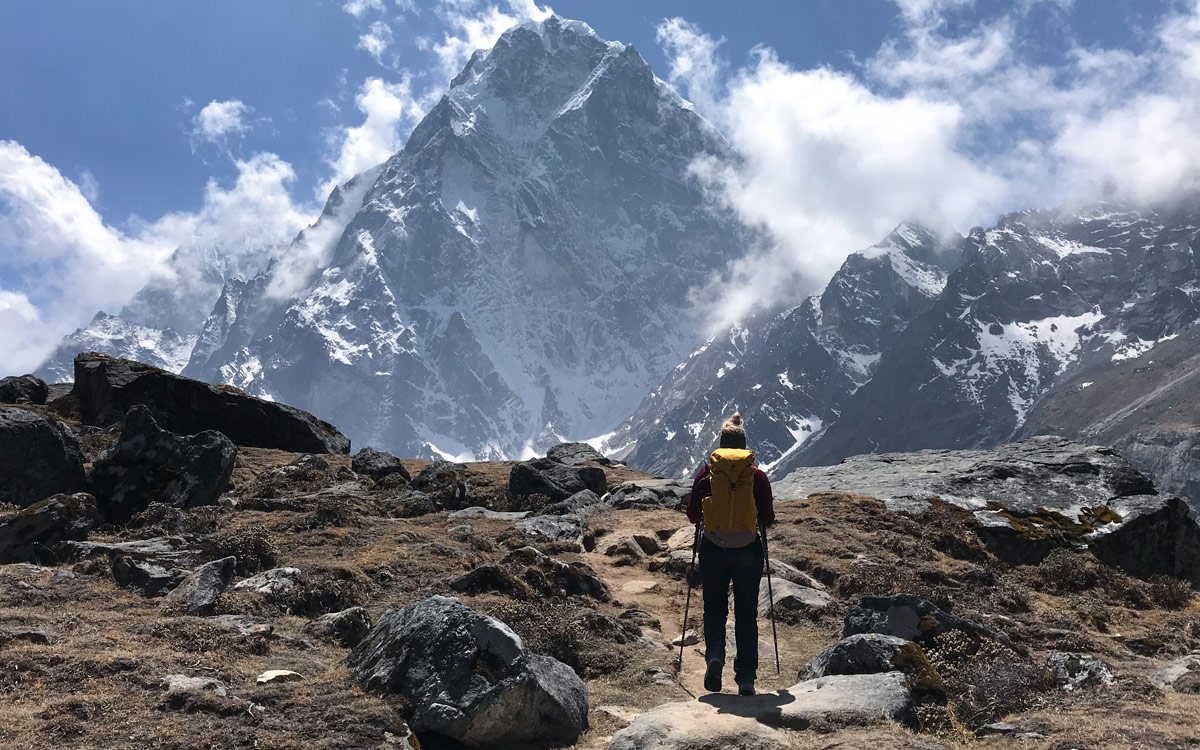
Trekking in Nepal is an affair like no other, it is a package of fresh expeditions that bring you away and push you close to the world both at the same time.
Treks in Nepal are distinguished by its offerings of natural beauty, cultural perpetuity, and diversity.
Home to the world’s tallest mountain Mount Everest and eight of the fourteen highest summits in the world, trekking in Nepal itself is a peak many wish to conquer.
Treks here are uniquely diverse, from long-term expeditions deep into the Himalayas challenging one’s resolve to short treks that readily capture hearts.
Catering not just to nature lovers that rejoice in the beauty of the natural but trekkers that value history, community and culture, your adventure in Nepal will serve you through all kinds of earthly experiences.
Why trek in Nepal?
In essence there shouldn’t be much of a difference between treks in Nepal and elsewhere, so what is the extraordinary factor that fuels the popularity of the trekking scene here and sets it apart?
The following are a few reasons why you should trek in Nepal:
From easy treks low in altitude and difficulty to treks that challenge and prod, Nepal has it all.
For beginners who are yet to climb significant altitudes, Nepal has several hikes even below 4,000m to help you adjust and enjoy.
Ghandruk Trek (1,950m), Panchase Trek (2,500m), and Ghorepani Poonhill trek (2,860m) are reasonably one of the best walks in the country.
Likewise, if you love yourself a challenge and thirst for several nights in solitude alongside views and experiences that make you feel anew, Nepal also offers numerous treks that open its wilderness to explore.
Everest Base Camp Trek , Annapurna Circuit Trek reaching its highest point at Thorung La Pass (5,416m), Everest Three Passes Trek combining three high passes of the Everest region, Kongma La (5,535 m), Cho La (5,368m) and Renjo La (5,430m), and Kanchenjunga Base Camp Trek (5,140m) could be a few options for the adventurer in you.
Spectacular Scenery
As home to the most scenic and unique landscapes, Nepal has mountains and hills that will peak your memories forever.
Away from the civils of the world, trekkers can find themselves in peace within a world that doesn’t feel like the one they often live in.
Nepal’s Himalayas that engulf the country in its grandeur are a sight for the eyes to see. The picturesque valleys, serene lakes, lush colorful forests make Nepalese landscapes incomparable to any other.
Culture and People
Trekking in Nepal allows trekkers to bask in its diverse but warm culture.
As a country that shelters people of various ethnicities, practices and formalities, Nepal is a nation that remains one but varying in its beliefs.
Trekkers can experience first-hand traditions that have been followed ever since the Nepalese community first prospered.
Through wild trails and remote valleys, with the people and culture you encounter and explore, even the hardest of treks are so worth it.
Affordability
Nepal is known for budget travels, the country humble with its finances but excellent in its offerings.
For trekkers who are travelling tight but still don’t want to compromise with quality experience, trekking in Nepal is the answer.
Biodiversity
Nepal sits on the 49 th position in the world biodiversity record. It is home to one of the most varied species of flora and fauna.
Its diverse ecosystem shelters wildlife you wouldn’t find anywhere else. There are over 22,000 species reported in Nepal which amounts to a total of 1.3% of the global biodiversity average.
For nature enthusiasts, trekking in Nepal can be a once in a lifetime opportunity to spot rare and endangered species and personally learn more about them.
Teahouse Trekking
In many trekking trails across the country, you can find various tea houses and lodges ready to accommodate and ease your tours.
The tea houses are convenient and easily accessible. This lodging experience makes it easy for trekkers to rest and recharge comfortably through the trails.
Solo Vs Guided treks in Nepal
Guided and solo treks are two exceptionally different trek options, both carrying a fair share of pros and cons.
Solo treks promise freedom and the bliss of spontaneity while guided treks ease through forethought, safety and companionship.
When it comes to choosing the best option for you, your preferences, your ability to adapt and control, alongside a thorough study of the destination, its provisions and record of conduct is significant.
In the context of Nepal starting April 1, 2023, solo treks were banned, trekkers visiting the country now are to compulsorily hire a licensed guide or porter for their treks through Nepal’s Conservation areas and National Parks.
The following table compares Solo and Guided Trek features to help you better understand and accordingly decide what could be a fitting option for you:
Choosing the right season to trek in Nepal
Nepal offers one of the most inviting escapades to the wild and intimate, from views that boast the unseen to trails that challenge and charm, each of these recourses prove the best when the seasons are studied right.
Considering your preferences and abilities ensures satisfaction while weighing all options and circumstances helps prepare and protect yourself before you embark on your journey.
Further we will discuss weather settings in different seasons of Nepal:
Spring is one of the most popular seasons for trekking in Nepal. The months that fall under the season are March, April and May.
During the spring season, the trekking trails are lush and colored, it is also the season for Rhododendrons, their beauty adds even more to the already inviting treks.
The weather is warm and stable with clear skies, high altitude treks can be safely pursued around this time.
Trekkers can expect splendid views through their trails and up the ascended mountains, picturesque landscapes of the mighty Himalayas are definitely a sight to see.
The months that fall under Autumn are September, October and November. As another excellent trekking season in Nepal, Autumn pulls a tremendous number of trekkers every year.
Since it’s the popular season tea houses and lodges are often crowded around this time.
Autumn is the perfect season for high altitude treks. The clear air and mild temperature ease trekkers through challenging walks. The trails are dry, clear skies and excellent visibility make it even better of an experience for them.
Winter is the coldest season falling in the months of December, January and February.
At higher altitudes, the weather can be quite harsh and extremely cold; heavy snowfall is apparent. Given these conditions Winter isn’t the most popular when it comes to trekking.
The lower altitudes may have mild, sunny days, but as you go higher up the circumstances aren’t even close to feasible. Many high passes are blocked by snow so getting around can be evidently taxing.
Trekking during this time is possible in some areas but proper gear, and preparation is essential.
Monsoon/ Summer
Monsoon season in Nepal brings heavy rainfall especially in the lowlands. Trekking during the monsoon months (June to August) is not highly preferred.
There could be chances of flooding, the trails can be muddy, and leech infested, making the trek uncomfortable and unsafe.
However, certain areas like the rainforests in Terai, and the upper Mustang area can still be explored.
How to choose the best trekking company?
Most of what your trek experience could result in depends on the company you choose to trust.
To ensure an adventure, safe and enjoyable it is important to take careful steps into deciding a travel partner.
A reliable trekking company ensures the best of your experience, you are protected and correctly guided, you will not need to worry about anything but making the most of your trip.
The following list will help you choose the best trekking company for yourself:
Determine your trekking goals
Before moving in to choose a trekking company, the first and the most significant step is deciding on your trekking destination. This will help narrow down your options.
Make sure to select destinations that fall under the trajectory of your planned duration, your trekking ability, and budget.
Research and Shortlist
Shortlist companies that specialize in the destination you have chosen for yourself. Make sure to take your time comparing your options and research to find the best.
Verify company registration and License
It is extremely important to confirm that the chosen company is officially registered and licensed by the country you are trekking to.
Treks can be challenging and often unpredictable, if a company is not registered or licensed, they might not be operating lawfully. Such companies could rush over various safety regulations, resulting in major mishaps.
Safety is not to gamble, ensuring the company’s authenticity will help avoid scams and secure quality.
Experience and reputation
The amount of experience a company has is directly proportional to the quality of trips they offer.
An experienced company will be able to provide you with better options, better routes, better deals and better guides.
You can quickly confirm the reputation and pace of a trekking company by gauging how travelers who have trekked with them assess their services and efficiency.
It is important to read through reviews and testimonials and contact personally if possible and required.
Guide certification
Guides are individuals you will be spending almost all of your trek with. They are equipped with vast knowledge, skills and trekking experience.
Before choosing a company, it is important to verify guide certification and their areas of expertise and experience. The quality of your trek will differ heavily in terms of your Guide and their professionalism.
Linking up with companies who provide certified guides ensures a wonderful trekking experience for you. Professional guides are well versed in minimizing risks, controlling the trek and always assisting trekkers.
Itinerary and services
Carefully study and compare the itineraries provided by different companies, choose a company that does your plans justice and best satisfies your wants.
It is important to ensure that the services provided by the company are up to your standards, from the accommodation provided and meal plans to transportation and permit provisions if required.
Compare the prices of different companies and go for the one that seems the most reliable.
The key to choosing the best trekking company in terms of its pricing is to not be swayed by cheap prices but rather check whether the services provided by the company rightfully align with the prices they have set.
To thoroughly understand how the costs are set you could request a breakdown of the pricing, this will help you decide better.
Responsible Tourism
Choose a company that is responsible in its ways and free from records of malpractice and fraud. Make sure that the company respects local cultures and performs accordingly.
Sustainable tourism practices are especially talked of in the tourism scene today, companies that practice sustainable ways and actively promote environmental consciousness are always the better options.
Best Treks in Nepal
Trekking in Nepal offers a range of diverse options, from short and easy treks to challenging high-altitude adventures, catering to all those seeking either thrill or tranquility in the lap of nature.
With the fantastic geography of the country, you have an array of trekking routes to choose from. Perhaps, let me divert your interest in what makes Nepal the ultimate trekking heaven, by bringing you the best trekking routes in Nepal, that have captured the hearts of global adventurers.
Our list is solely based on the feedback of trekkers who have explored Nepal’s trekking routes and the popularity of these routes over time. So buckle up, and let’s take you on a journey through some of the best trekking in Nepal.
1. Everest Base Camp Trek in Nepal
Highlights:
- Trek to the base of the world’s highest mountain, Mt.Everest
- Fly to the world’s most adventurous airport – Lukla
- Immerse in the serenity of the Sagarmatha National Park
- Experience the culture and tales of the ethnic Sherpa people
- Scenic views of the world’s highest mountains
Embarking on the journey towards the Everest Base Camp trek is an adventure that should be on every hiker and trekker’s bucket list.
While trekking in the Everest Region you’ll be immersed in the Sherpa culture at Namche Bazaar, the gateway to the world’s tallest mountain.
Then it takes you through the heart of the mountains, providing breathtaking views of towering peaks like Mt. Everest, Ama Dablam, Lhotse, Nuptse, Thamserku, Cho Oyu, and more.
The journey also presents the opportunity to visit the oldest and largest monastery in the region – Dingboche Monastery.
Trekking in Nepal is truly a one-of-a-kind experience that promises to leave you in awe of the majestic beauty of the Himalayas, and it’s something every adventurous traveler should experience at least once in their lifetime.
2. Everest High Passes Trekking
- Cross three beautiful high-elevation passes
- Witness remarkable views of Gokyo valley and Ngozumpa glacier
- Encounter Gokyo Lake’s turquoise waters
- Experience the remote hospitality of the region
- Catch a scenic mountain flight to/from Lukla
In case you’re looking for high-altitude trekking in Nepal with some challenging walking; Everest High Passes Trek is a once-in-a-lifetime experience that offers the perfect mixture of adventure and stunning natural beauty.
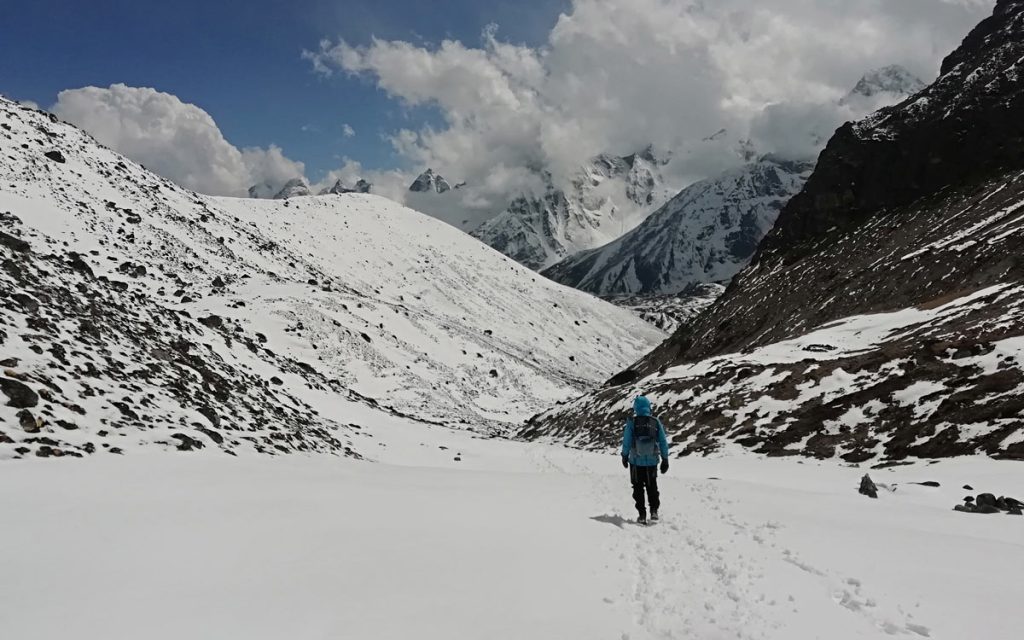
Trekking in between the Himalayas, you’ll witness some of the world’s tallest peaks and the largest glacier in Nepal, including some of the ancient monasteries of the region.
Additionally, the breathtaking views from the three high passes are sure to leave you spellbound, but it is also one of the most challenging high-altitude treks in Nepal.
The opportunity to explore the Beautiful Gokyo Valley and its pristine Lakes along with the Everest Base Camp at an altitude of 5,364 m, this trek is a must-do for anyone seeking an extraordinary and unique experience while trekking in Nepal.
3. Gokyo Lake and Everest Base Camp trek
Highlights of the Trek:
- Witness remarkable views of the Himalayas from Gokyo Ri
- Walk in the world’s highest and largest glacier in Nepal, Khumbu Glacier
- Immerse in the serene atmosphere inside the charming Tengboche Monastery
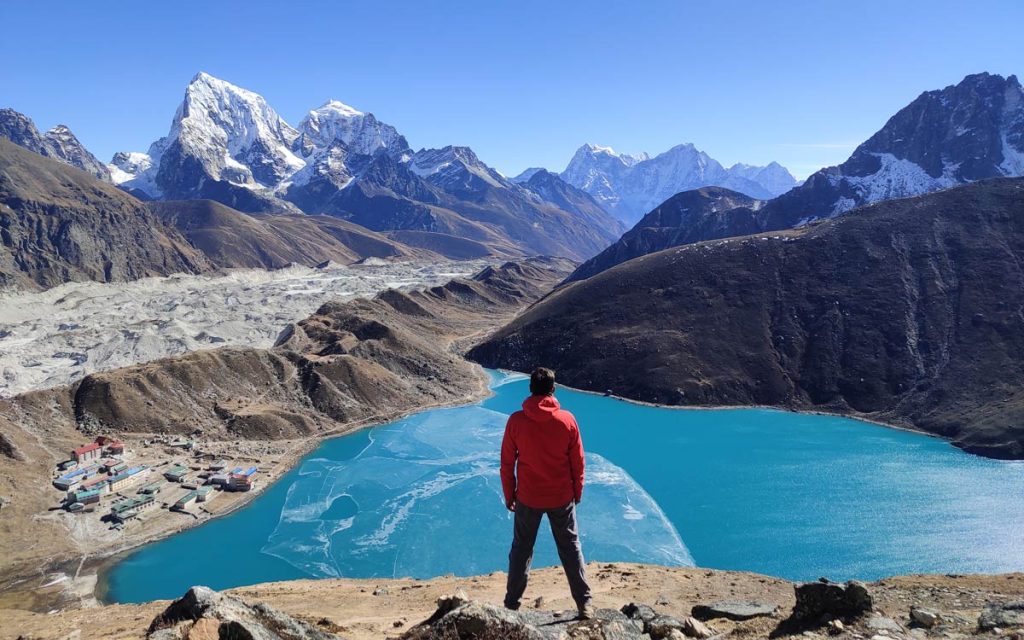
Gokyo to Everest Base Camp trek offers a thrilling variation to the classical route, making it one of the most challenging treks in the Everest Region. It is the rewarded trek for all the hikers and trekkers seeking an adrenaline rush.
In addition, you’ll be walking through the world’s highest and Nepal’s largest Glacier, the Khumbu Glacier.
The journey from the pristine Gokyo lake, through the challenging Cho-La pass, and towards Everest Base Camp, is a must-embark journey for every trekker.
Additionally, the trails of this trek provide you with a different path than the usual trail, ensuring that you won’t be retracing your steps while Trekking in Nepal.
4. Annapurna Base Camp Trekking
- Immerse in the varied flora and fauna of the Annapurna Region
- Witness the remarkable view of the world’s 7th and 8th highest mountains; Dhaulagiri and Annapurna I
- Summon in the beautiful sunrise view from Poon Hill
- Accommodate in the laps of the Himalayas; Annapurna Base Camp
- Rejuvenate in the refreshing hot spring at Jhinu Danda
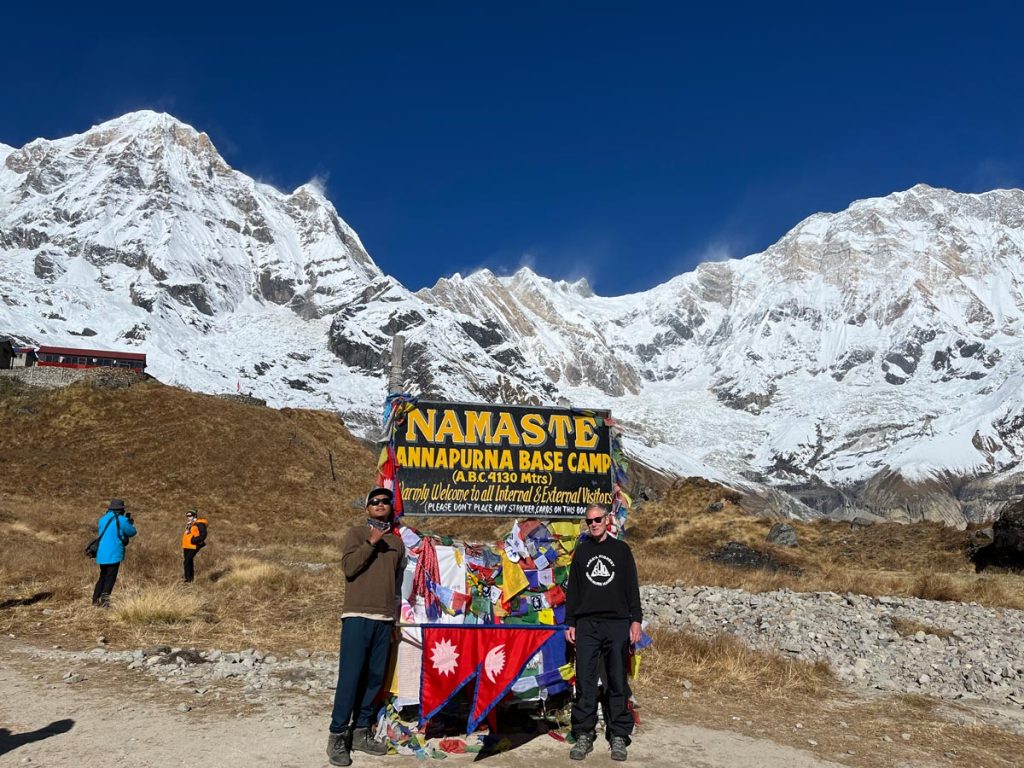
Annapurna base camp is the best-preferred trek of Nepal for mountain lovers seeking an unforgettable experience.
Spending a night at the base camp, surrounded by the majestic Himalayas, makes all the hard climb worth it.
The trek begins from the tourism hub; Pokhara, offering a range of hiking and trekking options, from short hikes to challenging high-altitude treks in the Annapurna region.
Perhaps, this trek offers breathtaking views of the Annapurna mountain range, a rich cultural experience, and a chance to immerse oneself in the natural beauty of trekking in Nepal’s Himalayas.
5. Annapurna Circuit Trek in Nepal
- Scenic Mountain long drive from Kathmandu to Syange
- Ascend along the enthralling Marshyangdi River Valley
- Behold the captivating vistas, and conquer Thorong La Pass at 5,416 m
- Find spiritual solace in the Pilgrimage town of Muktinath
- Marvel at the magnificent sunrise views from Poon Hill
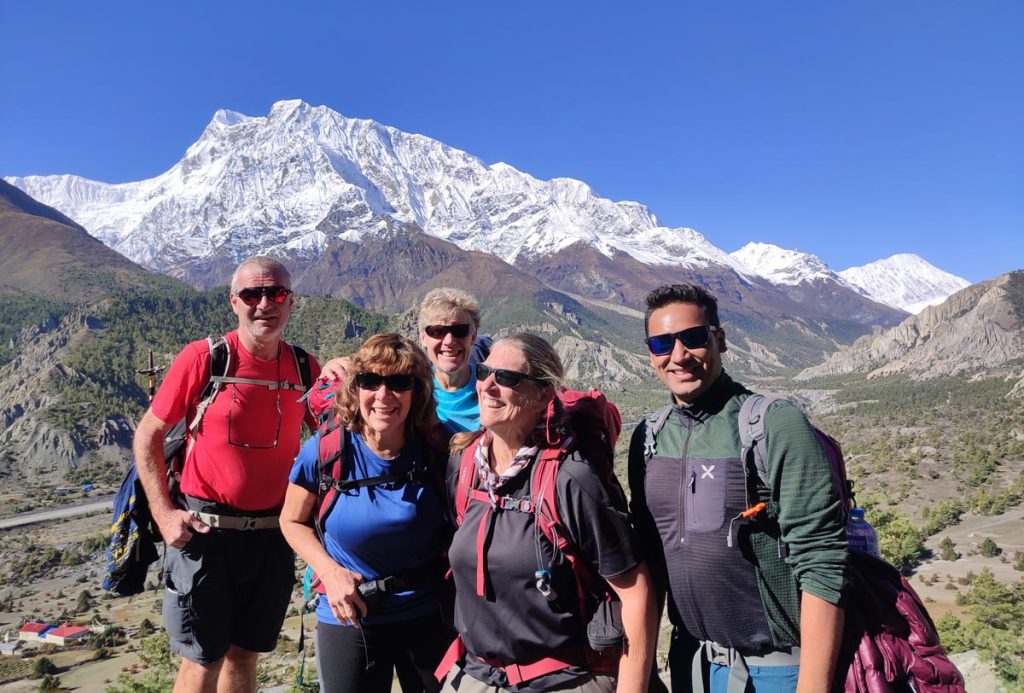
Annapurna Circuit trek is a popular and diverse destination for trekking in Nepal offering a wide range of experiences for adventure seekers while trekking in Nepal in the heart of the Himalayas.
This takes you through some of the most spectacular mountain views in the world, including the Annapurna Massif and Dhaulagiri, and takes you to the Thorong La Pass, which offers incredible panoramic views.
Moreover, the trek is also suitable for the ones who are into culture and traditions as well. The trek offers a rich cultural experience as it takes you through the traditional villages of Gurung,
Thakali, and Manangi communities where you can learn about their unique culture, traditions, and lifestyles. Hence, it is an excellent choice for those seeking a challenging and diverse trekking experience.
6. Ghorepani Poonhill Trekking in Nepal
- Experience the beauty of Nepal’s natural landscape through the drive to Pokhara
- Witness the breathtaking sunrise over the Himalayas from Poon Hill
- Immerse yourself in the fascinating traditions in Ghandruk village
- Enjoy the vibrant hues of the colorful rhododendron forests
- Savor the flavors of Nepal’s delicious cuisine
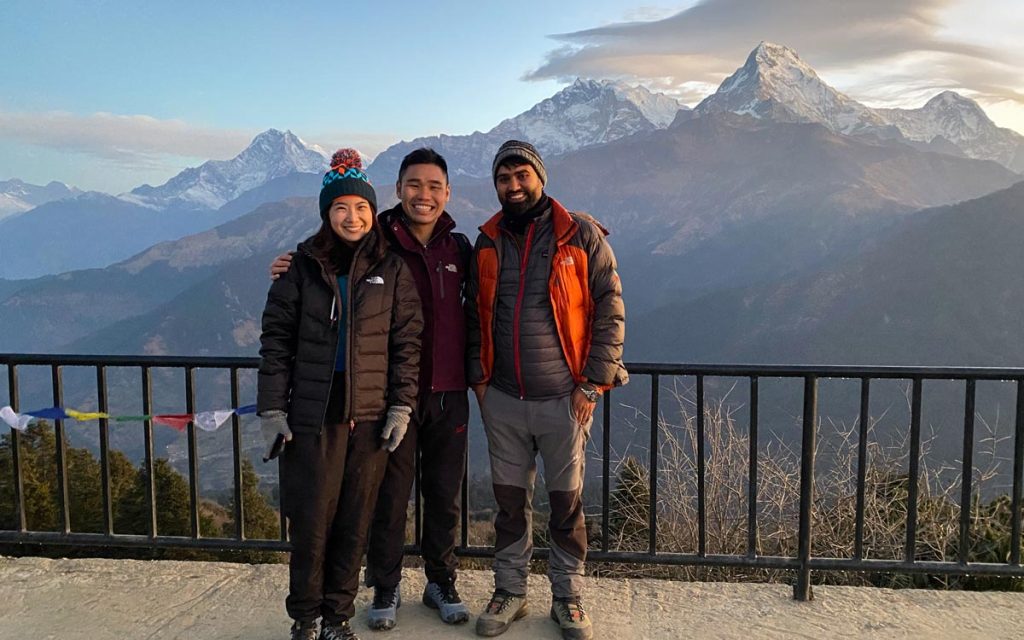
Ghorepani Poon Hill trek is the hidden gem in the majestic Annapurna region that is waiting to be discovered.
This mesmerizing trek takes you on a journey through picturesque landscapes, charming villages, and breathtaking vistas that are sure to leave you enchanted.
Walking through the lush forests of rhododendron and oak, you’ll witness the vibrant colors of Nepal’s flora and fauna, and be serenaded by the sweet songs of exotic birds.
Besides that, the true highlight of the trek is the climb to Poon Hill, where you’ll witness the most magnificent sunrise you’ve ever seen.
As the sun paints the sky with red, orange, and pink hues, the snow-capped peaks of Annapurna, Dhaulagiri, and Machhapuchhre stand tall in all their glory, offering a sight that will take your breath away.
It is one of the best short treks of Nepal as you’ll experience the charm of rural Nepalese life and get a taste of authentic Nepalese cuisine.
7. Upper Mustang Trek
- Explore hidden kingdom in Trans-Himalayan land
- Tour the manmade sky cave & picturesque Himalayan view
- Visit monasteries: Ghar, Thokten, Choten, Luri Gompa, etc.
- Hike desolate trails of “Pa-Pass” in Upper Mustang
- Discover life in the mountains; visit Muktinath, a holy temple
Upper Mustang is a mesmerizing and mystical land, tucked away in the heart of the Trans-Himalayan region of Nepal. This hidden Kingdom is a dreamland that beckons you to explore its unique and stunning landscapes, culture, and traditions.
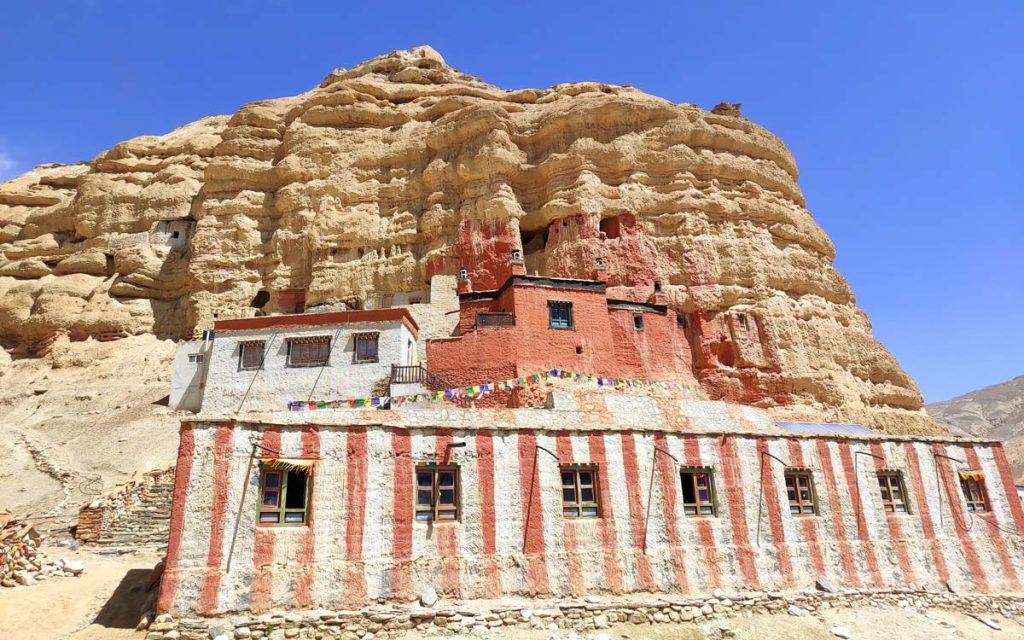
Imagine hiking across desolate trails, surrounded by rugged mountains, ancient caves, and mystical monasteries.
As you explore the hidden gems of Upper Mustang, you’ll discover the secrets of the ancient Kingdom, which was once forbidden to outsiders.
The region’s walled city of Lo Manthang, with its whitewashed building and stunning architecture, is a sight to behold. The city’s narrow alleys and winding streets will transport you to another era, where time seems to stand still.
One of the most alluring features of Upper Mustang is the Luri-Gumba, a magnificent monastery perched on a 100 m high cliff of sharp rock. The unique art and architecture of this ancient temple are a testament to the ingenuity and creativity of the Mustang people.
But that’s not all; Upper Mustang has much more to offer. You can visit Muktinath, the holiest temple in both Hinduism and Buddhism or hike across the desolate trails of “Pa-Pass,” which is a challenge that is not for the faint of heart.
8. Nar Phu Valley Trek with Annapurna Circuit
- Find peace in the tranquil Kali Gandaki River valley
- Explore the enchanting villages of Nar and Phu
- Experience vibrant monasteries along the trekking trail
- Conquer the legendary Kangla and Thorong la Passes
- Visit the sacred and stunning Muktinath temple
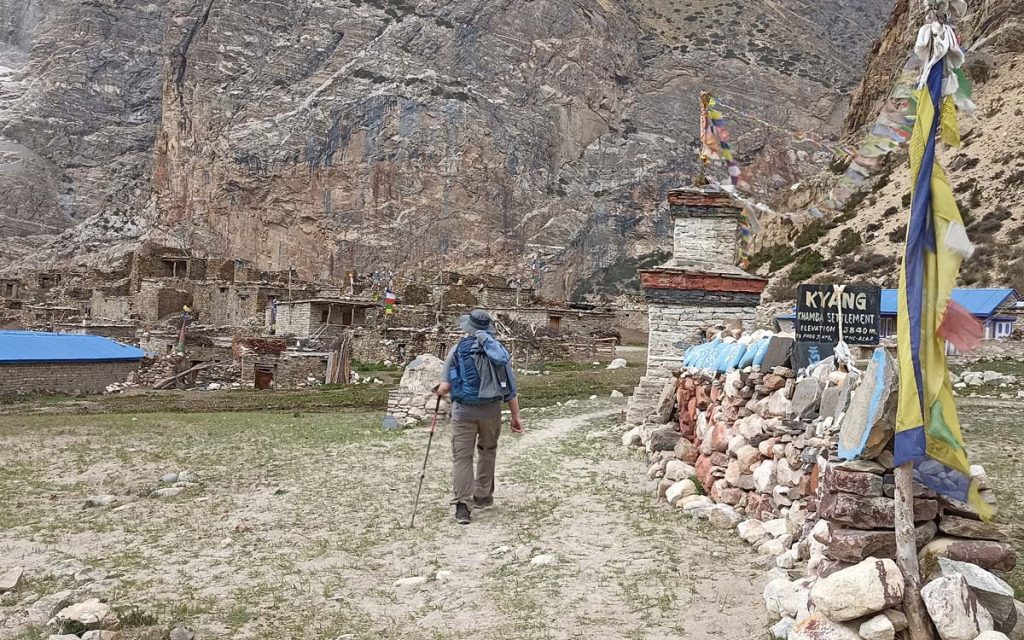
Nestled in the heart of the magnificent Annapurna region, Nar Phu Valley and Annapurna Circuit trek are the two most breathtaking treks in Nepal, each with its own unique charm and appeal.
The Nar Phu valley trek takes you off the beaten path in Nepal to discover the rich culture and unique lifestyle of locals who continue to live a nomadic life, herding yaks and sheep across the rugged terrain.
Annapurna Circuit trek on the other hand takes you through the diverse landscapes, from verdant forests to arid deserts, snowy mountains to quaint villages.
Additionally, it traverses into famous passes like Kangla and Thorong La for unparalleled views of the majestic Himalayas.
Both of these treks are done together to experience the best of both worlds. You’ll experience the serenity of Kali Gandaki River valley, ancient caves, stunning waterfalls, rugged mountains, and many more.
9. Manaslu Circuit Trek in Nepal
- Breathtaking drive from Kathmandu to Manchha Khola
- Immerse in the tranquil beauty of Budhi Gandaki River valley
- Experience the unique blend of Nepalese and Tibetan cultures
- Walk along the border between Nepal and Tibet
- Conquer the Larkya La Pass, standing tall at 5,125 m
The Manaslu circuit trek is a hidden gem in Nepal that takes you on a journey through remote villages, lush forests, and stunning mountain landscapes. It is one of the most thrilling and adventurous treks in Nepal.
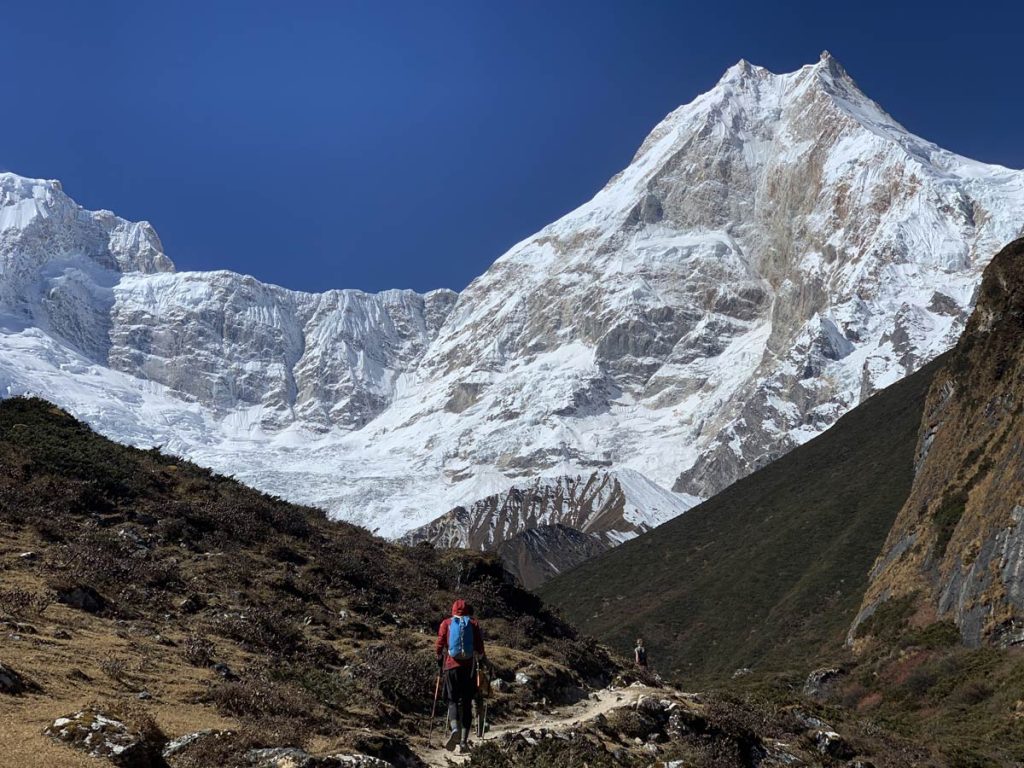
As you trek around the eight highest peaks in the world, you’ll witness the unique blend of Nepalese and Tibetan culture and experience the warm hospitality of the locals.
The trail follows the Budhi Gandaki River and passes through dense forests, beautiful waterfalls, and picturesque villages.
The highlight of the trek is the challenging Larkya La pass, standing tall at an altitude of 5,215 m. This challenging yet rewarding trek offers an off-the-beaten-path adventure that is perfect for nature lovers and trekking enthusiasts alike.
It is a unique opportunity to interact with the friendly locals and experience their daily life. The villages you pass through on the trek are remote and untouched by modernization which adds to the charm of the trek.
10. Langtang Valley Trek
- Views of snow-capped peaks such as Langtang Lirung, Dorje Lakpa, and Ganesh Himal
- Visit the traditional villages of Langtang, Kyanjin Gompa, and others
- Experience alpine landscapes and high-altitude lakes such as Gosainkunda
- Learn about the region’s history and culture at the local museum and visit the yak cheese factory
- Panoramic view of the Langtang range from Tserko Ri
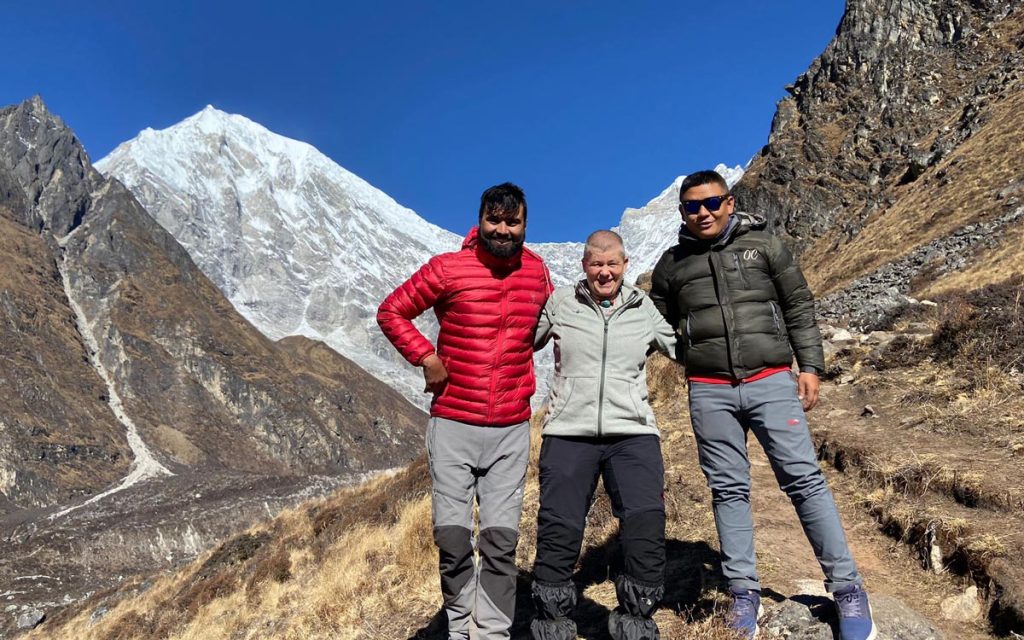
The Langtang Valley trek is a popular “trekking in Nepal” that takes you to the Langtang National park, which is home to diverse flora and fauna, lush forests, glistening glaciers, and snow-capped peaks.
It is a great opportunity to experience the warmth and hospitality of the Tamang community. You can visit the traditional Tamang villages such as Langtang and Kyanji Gompa and experience their music and dance performances.
Additionally, the highlight of the trek is the Tserko Ri peak, which offers a breathtaking panoramic view of the Langtang range.
Tserko Ri is challenging but worth the effort as you can witness spectacular sunrises and sunsets from this vantage point. Hence, it is an excellent opportunity to disconnect from technology and immerse yourself in nature.
In conclusion, Nepal is home to some of the most breathtaking trekking routes in the world. The country’s stunning natural beauty, diverse landscapes, and rich cultural heritage make it an ideal destination for trekkers of all levels.
From the world-famous Everest Base camp trek to the less crowded but equally stunning Langtang Valley trek, trekking in Nepal has something for everyone.
Best Nepal trekking tips for beginners
Trekking in Nepal is undoubtedly the most magical experience for any trekker, but as a beginner there are several aspects you need to be mindful of.
As exciting as treks can be, they are also arduous and uncertain in their ways, for someone who isn’t used to these experiences, the idea of immediately leaping into one of the most popular destinations for treks as a beginner can certainly be a little spooky.
The following tips will help ease your nerves and assist you through a wonderful trek:
Choose the right trek
As a beginner it is important to choose the right trek for yourself, as someone with little experience and knowledge it is advised to go for treks that don’t require much strain and dispute.
You should be aware of what your body and mind is capable of, this will make it easier for you to narrow down your options and decide on treks that might be best fitting for you.
According to the level of difficulty treks are divided into several grades, as a beginner it is always wise to choose beginner friendly treks in Nepal .
Acclimatize
Acclimatization is essential during high altitude treks. One of the biggest issues with trekking at a high altitude is altitude sickness . As a beginner if you are making trips in high elevations, acclimatization is a must.
While trekking remember to frequently rest if required and gradually pace up. There will be several chances for acclimatization at rest stops, this will help you get used to the altitude and minimize risks.
Go with a guide
A guide is always an advantageous addition to your trekking trip.
With a local guide you will be able to gain valuable insights not just into the geography and the natural environment of the region but also the culture and practices of local people.
When it comes to emergencies and accidents difficult to recover, a guide will be your savior.
With someone who can professionally plan, organize and assist you on your trek, you will be able to have a wonderful time free from distractions.
Pack light and prioritize essentials
When it comes to treks, it is always advised to pack light. Do not carry unnecessary loads on your backpack, only carry the essentials.
Remember to pack warm clothing, your trekking boots, trekking gear, toiletries, and other miscellaneous items you might absolutely need.
Carry a first aid kit
Although having a first aid kit could increase the weight on your backpack and take up some space, it is not unnecessary baggage.
Having a first aid kit on you will be totally handy if you happen to get some minor injuries or even major accidents along the trail.
Eat well and hydrate
With all the physical strain you put on yourself throughout the trek, it is extremely important to gain back the lost energy through food and water.
The Nepali cuisine is not just delicious but also extremely nutritious, it will help fuel your body and strengthen your mind.
It is also necessary to stay hydrated during the trek so make sure to pack a hefty water bottle for yourself.
Tea Houses and Lodging
Across many popular trails in Nepal, you will find various tea houses and lodges established to accommodate trekkers through their hike.
Offering a unique blend of local hospitality and basic amenities, tea houses are unique to Nepal’s trekking culture.
Respect the people and culture
Be mindful of the local culture and traditions, be observative and avoid offending the locals.
Nepali people are known for their unique culture and traditions, most of their beliefs and practices could be totally foreign to you but respecting their stance will bring you closer to the people and stay connected.
What to pack for trekking in Nepal?
Packing is extremely important during treks. Unlike usual trips when packing for a trek, you have an awfully limited space and several essentials to carry.
Being mindful of the things you might need and not unnecessarily overpack is the key to having the perfect trek backpack.
When all your essentials are packed well, you will be able to enjoy a smooth and efficient trek.
The items you will need to pack are listed as follows:
- Thermal underwear
- Fleece or down jackets
- Waterproof jacket and pants
- Trekking pants (lightweight, quick drying) and shorts
- Long sleeved shirts
- T-shirts (lightweight, breathable)
- Heavy weight pants and jacket for higher elevations
- Underwear and socks
- Winter hat and gloves
- Summer hats
- Woolen socks
- Buff or neck gaiter
- Sturdy trekking boots
- Camp shoes (sandals, sneakers)
Trekking Equipment
- Backpack (size depends on whether you have porters or not)
- Sleeping bag
- Trekking poles
- Head lamp and extra batteries
- Sunglasses with UV protection
- Water bottles
- First aid kit
- Camera and essential electronics
- Extra zip log bags
Personal items
- Passport and Permits
- Moisturizer
- Toiletries (Toothbrush, Hand Sanitizer, Toothpaste, Toilet paper)
- Insect repellent
- Personal hygiene items (Sanitary Napkins)
- Prescribed medication
- Snacks, instant food
Miscellaneous
- Waterproof backpack covers
Packing Tips
- Choose a comfortable backpack, one that is spacious and easy for you to carry.
- Prioritize your essentials (clothes, shoes, passport and documents, and trekking equipment)
- Test your trekking gear before packing
- Keep your electronics and important documents in waterproof bags safely
- Be mindful of the weight, keep your backpack light
- Check the weather conditions and pack accordingly
Buying equipment in Nepal
As a popular destination for trekking and mountaineering Nepal offers a good range of trekking equipment and gears for rent as well as for sale.
You can buy all the required trekking equipment from either Kathmandu or Pokhara. The cities have several retailers that primarily focus on trekking gears, comparing the prices and quality before purchase is essential.
When you’re buying your equipment make sure to keep the altitude of your trek in mind, according to what gears might be needed or might not be, purchase wisely.
Frequently asked questions about trekking in Nepal
What is the best month to trek in nepal.
The ideal months for trekking in Nepal extend from March and April in spring to September through November in Autumn.
Spring days are longer and warmer, while bustling trails and the colorful scenery enhances the trekking experience. Autumn is dry and the temperature is moderate, ensuring clear skies and marvelous views.
How much does it cost to go trekking in Nepal?
The cost of trekking in Nepal can differ according to the type of trek you want to go on, the region you want to trek, the duration of your trek, the services and the level of comfort or luxury you seek.
For trekking through trails that require a permit you will need to pay depending on the area, different regions have different permit fees.
Guides and porters charge could also differ according to the region and duration. Food and accommodation costs for basic meals and teahouses are lower in comparison to comfortable lodges with attached bathrooms and better amenities.
The cost throughout your trek could also largely vary in terms of the season and demand trend, it is never quite fixed.
What are the safety considerations for Hiking in Nepal?
Prioritizing safety is of great importance, particularly when engaging in outdoor activities. Hiking in Nepal presents a wonderful opportunity to discover the country’s stunning landscapes and immerse oneself in its rich culture but to fully enjoy this experience, it is crucial to ensure your safety.
Here are some essential safety tips to keep in mind when hiking in Nepal:
Physical fitness
Before the trek make sure to check and confirm whether you’re fit enough to handle it. Regular exercise and warmups can help you prepare for longer walks at higher altitudes.
First aid Kit
Having a first aid kit on you is extremely crucial during hikes. Make sure to include pain relief and altitude sickness medications in your kit, and don’t forget medications personally prescribed to you.
Learning when and how to use certain medications and a basic understanding of how first aid operations work will definitely be worth it.
Hydration and Nutrition
Through long, demanding hikes it is extremely essential to hydrate well and eat when you can. Having some snacks on you will also help keep your energy and spirits up.
Weather considerations
Be aware of weather conditions in Nepal that can vary largely depending on the season. For your safety avoid treks when the weather is particularly harsh or unstable.
Guides and permits
Hiring local guides will help you through most of your hurdles when hiking in Nepal. They don’t just provide you with insightful knowledge but handle emergencies, minimize risks, and help you settle through trails and localities.
Obtaining all necessary permits is also made easier through connections with the local travel agency. To ensure security through your travels, this is very important.
Communication
Do not forget to carry your mobile phone, fully charged with a portable charger, along with you always.
In case of riskier expeditions, it is nice to have alternative communication devices like satellite phones to help during emergency situations.
How to train for trekking in Nepal?
Certain treks in Nepal can be challenging and often formidable. To persevere through trails and not lose purpose, proper training is crucial.
First off, it is important to assess your fitness level, being aware of your strength, endurance, flexibility and overall health is extremely important before you begin training accordingly.
Tailor your workout plan to align well with the intensity of your trek, ideally initiating training about 2-3 months prior. This will help you get used to the demanding mobility and boost your stamina.
Going on regular hikes, especially ones at an impressive altitude, will help familiarize you to both the elevation and the intricacies of the trails.
How difficult is trekking in Nepal?
Trekking in Nepal can significantly vary in difficulty according to the region you choose to trek to. The country offers an impressive variety of treks from easy short-term treks to challenging long-term expeditions.
Treks high in altitude with steep, rocky terrains, longer durations and unpredictable weather conditions can be quite difficult to navigate.
How to choose the right trekking agency for your Nepal adventure?
Choosing the right trekking agency makes all the difference through your travel experience. It is important to research and put your time into searching for agencies that compliment your trekking plans.
Carefully verify and confirm the agency registration and license along with the certification of their guides. Read reviews and testimonials from people who have trekked with the agency before and look for a positive pattern.
Compare prices, services and the itinerary to finally decide on what agency could be the best for you.
What are the permit requirements for trekking in Nepal
Trekking permits provisioned to protect the cultural and natural resources of the country are essential to secure the peace of its environment and to ensure safety.
Depending on the region you are trekking to there are various types of permits you will need to have to proceed. Different rates will be applicable for different routes and regions.
Tour operators can apply for permits on the trekkers’ behalf by contacting the department of immigration where all the necessary formalities will be taken care of.
The following are major permit requirements for trekking in Nepal:
TIMS (Trekking information management system) card is required for all trekkers through most trekking regions of Nepal.
It is a management system that ensures the safety of trekkers and helps regulate the trekking operations in the country.
The TIMS card is not available for FIT’s but only group trekkers with a licensed guide. To purchase a TIMS card, trekking agencies are to register with information of trekkers, guides and trekking routes.
Restricted Area Permit
To enter the restricted areas in Nepal like the Upper Mustang area, Tsum Valley, and Upper Dolpo, you will need special restricted area permits.
These permits can be obtained from the Department of Immigration through an authorized tour operator.
National Park or Conservation Area Permit
If you’re planning to enter any National Park or Conservation Area in Nepal, you will need specific permits for every park or area.
The Annapurna Conservation area needs you to obtain the Annapurna Conservation Area Permit (ACAP). Likewise, to enter the Sagarmatha National Park you will also need a Sagarmatha National Park entry permit.
You can issue these permits at the Department of National Parks and Wildlife conservation in Kathmandu, the Tourist Service Center also in Kathmandu or any of the entry points.
Do you need to hire a trekking guide?
There is a lot you could gain from having a certified professional guide you through trails and terrains foreign to yourself.
Trekking guides ensure your safety, provide you with knowledge on the diverse ecosystem you could encounter, and help you acquaint yourself with the local people, their culture and traditions.
Guides also help navigate through complex trails, mishaps and accidents that could occur during the trek.
What is the availability of phone and internet services at higher altitudes during treks in Nepal like?
Phone and internet services at higher altitudes during treks in Nepal can be limited but still present.
When it comes to remote, less known trekking regions there is low to almost no coverage at all but with popular destinations you can find decent network coverage.
Many well-traveled trails offer exclusive Wi-Fi services that are dependable and affordable. You can purchase Wi-Fi through lodges and tea houses along your route too.
However, it is important to note that elevation and weather conditions also have much to do with how strong your signal is so although phone and internet services are available, they cannot always be relied on.
Related Blogs & Articles
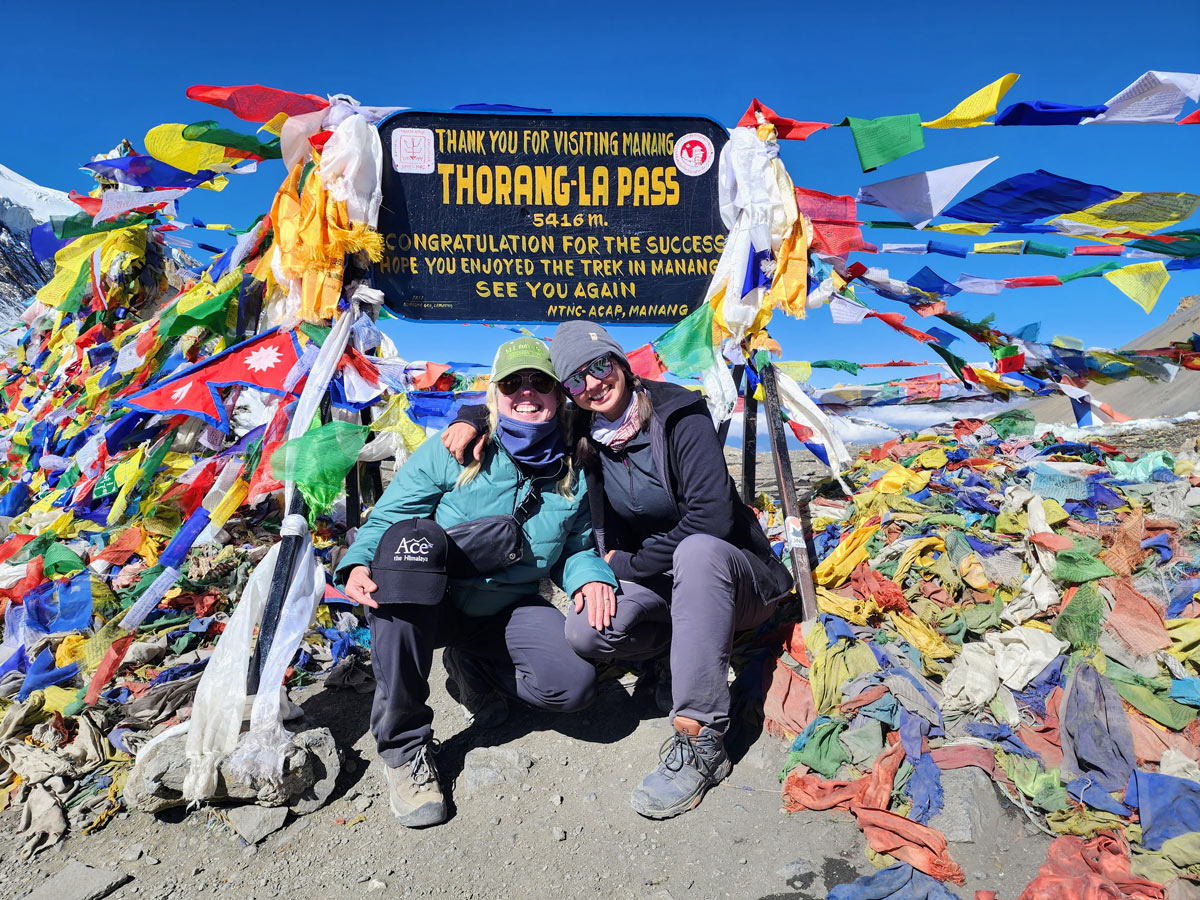
Best Time for Annapurna Circuit Trek
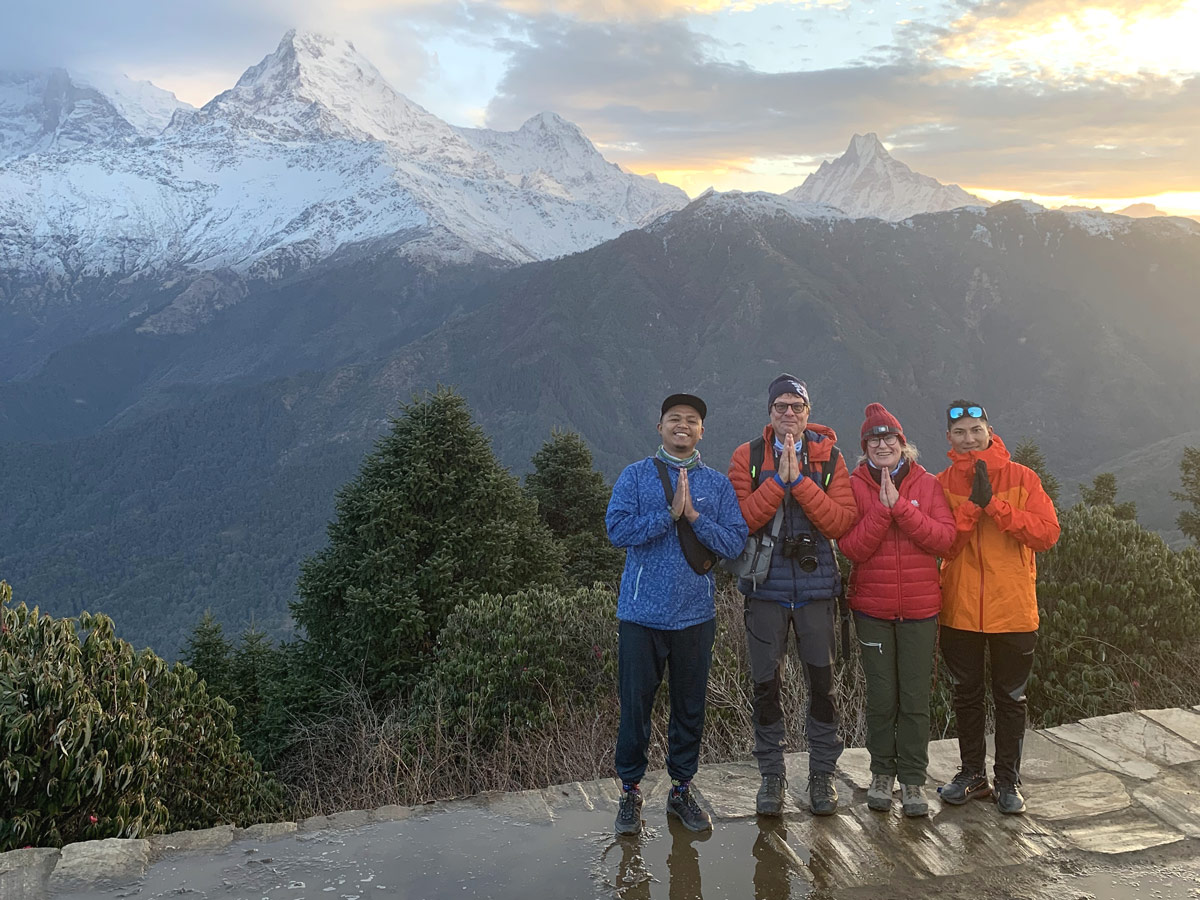
Beginner Friendly Treks in Nepal: Easy Yet Breathtaking
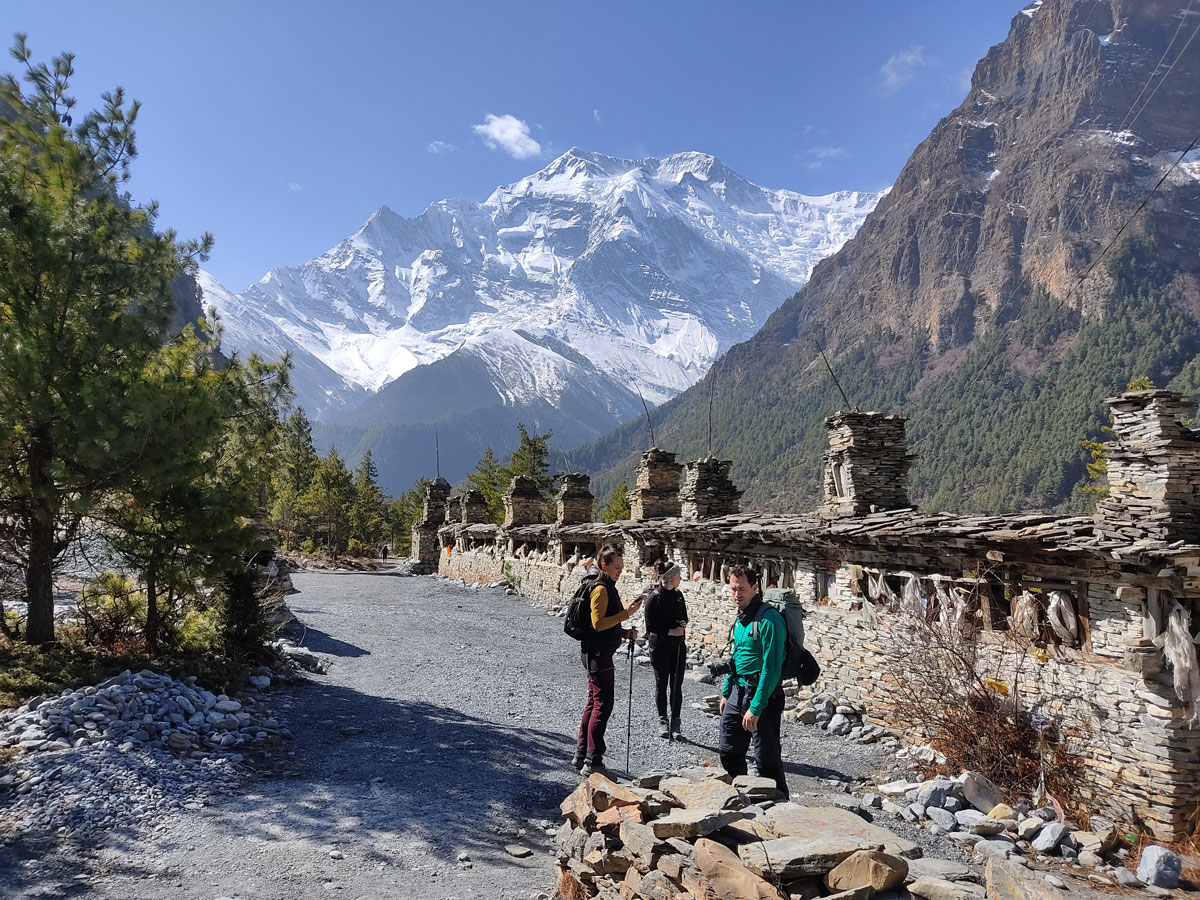
Everest Base Camp vs Annapurna Circuit

- Name This field is for validation purposes and should be left unchanged.
Trekking in Nepal
Climbing and expedition, cultural tour and sightseeing, cycling and mountain biking, luxury treks, luxury tours, multi country tours, voluntourism trips, extend your trip.
- Everest Panorama Trek – 9 Days
- EBC Trek with Helicopter Return – 12 Days
- Everest Base Camp Trek – 14 Days
- Gokyo Lake Trek – 13 Days
- Gokyo and Renjo La Pass Trek – 14 Days
- Everest Base Camp Trek without Lukla Flight – 17 Days
- Gokyo to Everest Base Camp Trek – 17 Days
- Everest Base Camp with Island Peak – 19 Days
- Everest Three Passes Trek – 20 Days
- Everest High Passes and Island Peak – 23 Days
- Classical Everest Base Camp Trek – 21 Days
- Langtang Valley Trek – 10 Days
- Langtang Valley Ganja La Pass Trek – 14 Days
- Langtang Helambu Trek – 17 Days
- Ghorepani Poon Hill Trek – 9 Days
- Mardi Himal Trek – 10 Days
- Annapurna Base Camp Trek – 13 Days
- Himalayan Highlights – 13 Days
- Nar Phu Valley Trek with Annapurna Circuit – 18 Days
- Annapurna Circuit Trek – 19 Days
- Tilicho Lake Trek With Thorong La Pass – 19 Days
- Khopra Danda Trek – 11 Days
- Shivapuri-Chisapani Trek – 4 Days
- Upper Mustang Trek (Drive & Trek) – 16 Days
- Tsum Valley Trek – 16 Days
- Manaslu Circuit Trek – 15 Days
- Dhaulagiri Circuit Trek – 21 Days
- Upper Dolpo Trek – 25 Days
- Kanchenjunga Base Camp Trek – 29 Days
- Yala Peak Climbing – 13 Days
- Island Peak Climbing – 15 Days
- Mera Peak Climbing – 19 Days
- Everest Base Camp and Lobuche East – 18 Days
- Tent Peak Climbing with Annapurna Base Camp – 18 Days
- Pisang Peak and Thorung La Pass – 21 Days
- Ama Dablam Expedition – 29 Days
- Kathmandu Cultural Heritage Tour – 3 Days
- Kathmandu Heritage – 3 Days
- Inheritances of Kathmandu – 4 Days
- Glimpses of Kathmandu & Nagarkot – 5 Days
- Kathmandu and Pokhara Unveiled – 5 Days
- Explore Kathmandu – 6 Days
- Glimpse of Nepal – 8 Days
- Nepal Heritage Tour – 10 Days
- Nepal Adventure Tour – 11 Days
- Nepal Multi Sports Adventure – 11 Days
- Nepal Vista – 10 Days
- Nepal Highlights – 14 Days
- Experience Nepal – 15 Days
- One Day Biking Trip – Kathmandu – 1 Day
- Annapurna Circuit Biking – 14 Days
- Upper Mustang Biking – 16 Days
- Kathmandu Valley Rim Biking – 8 Days
- Annapurna in Luxury – 9 Days
- VVIP Everest Base Camp Trek – 10 Days
- Everest View Luxury Trek – 11 Days
- Everest Base Camp Luxury Trek – 14 Days
- Everest Base Camp Deluxe Trek – 16 Days
- Mt Everest Base Camp to Gokyo Trek – 19 Days
- Kathmandu Luxury Tour – 3 Days
- Kathmandu and Pokhara Luxury Tour – 5 Days
- Nepal Multi Sport Luxury Adventure – 11 Days
- Best of Nepal – 14 Days
- Trishuli River Rafting – 1 Day
- Everest Base Camp Helicopter Tour – 1 Day
- Everest Base Camp Heli Tour with Gokyo Extension – 1 Day
- Langtang Heli Sightseeing – 1 Day
- Pokhara and Annapurna Heli Sightseeing – 1 Day
- Paragliding in Nepal (Pokhara) – 1 Day
- Scenic Mountain Flight (Everest Flight) – 1 Day
- Ultra Light Flight – 1 Day
- Jamacho Day Hike-One day hiking trip – 1 Day
- Kathmandu Uncovered with Nagarkot – 1 Day
- Day Tour to UNESCO Heritage Sites – 1 Day
- Nepal and Tibet – 15 Days
- Nepal and Bhutan – 15 Days
- India, Nepal and Bhutan – 19 Days
- Nepal, Tibet and Bhutan – 20 Days
- Arupokhari School Volunteer Program – 14 Days
- Rebuild Home Volunteer Program – 9 Days
- Bardiya Jungle Safari – 4 Days
- Chitwan Jungle Safari – 3 Days
Trekking in Bhutan
Festival tours, motorcycling.
- Druk Path Trek – 8 Days
- Chomalhari Trek – 12 Days
- Laya Ghasa Trek – 18 Days
- Bhutan Vistas Tour – 5 Days
- Cultural Heartland Tour – 10 Days
- Hidden Valley – 11 Days
- Bhutan Multi Sports Tour – 11 Days
- Paro Tshechu Festival – 8 Days
- Punakha Tsechu – 9 Days
- Trongsa Lhuntse Tshechu – 9 Days
- Bumthang Tangbi – 11 Days
- Bhutan Ura Yakchoe – 12 Days
- Tamshingphala Choepa – 12 Days
- Mongar and Trashigang – 16 Days
- Bhutan Biking – 8 Days
- Bhutan Motorcycle Tour – 12 Days
Trekking in Tibet
- Tibet Advance Everest Base Camp – 21 Days
- Cho Oyu Expedition – 45 Days
- Shishapangma Expedition – 47 Days
- Everest Expedition via North Side – 63 Days
- Kathmandu and Lhasa Tour – 7 Days
- Tibet Heritage Tour – 8 Days
- Overland Tour to Everest Base Camp – 10 Days
- Mount Kailash Mansarovar Lake Tour – 15 Days
- Everest Base Camp Biking Tour – 21 Days
The 12 Best Treks in Nepal

Last Updated: July 12, 2021
When it comes to views and mountains, nothing beats Nepal. Eight of the fourteen eight-thousanders (mountains above 8000m) in the world are located in Nepal: Mount Everest, Mount Kanchenjunga, Mount Lhotse, Mount Makalu, Mount Cho Oyu, Mount Dhaulagiri, Mount Manaslu and Mount Annapurna I. Nepal is the ultimate destination for trekking. There is no substitute!
Trekking is one of my favorite travel activities. Whether it’s for 3 days or 3 weeks, trekking is the best way to disconnect from the world and to find time for yourself.
Many hidden gems in Nepal are only accessible by foot. The good news is Nepal has something for everyone; there is a wide variety of places to suit every type of traveler, no matter what your interests, budgets, comfort levels and trekking styles. Of course, there are the already well-loved Nepal treks, such as Annapurna, Everest, Langtang and Poon Hill. But if you’re looking for something a little different, then go off-the-beaten-path and explore the Manaslu Circuit, Mardi Himal, Kanchenjunga, the Far West Humla, Upper Dolpo or the Kingdom of Mustang.
It was very difficult for me to narrow this list down to just twelve. But here we are! Below are my 12 favorite trekking trips in Nepal. They range in length, variety, terrain, and difficulty but they all have one thing in common: spectacular views!
1. Manaslu Circuit, the Authentic Himalayan Trek

The Manaslu Circuit Trek is my favorite trek in Nepal. It is SO beautiful; the terrain is remarkably diverse and the views are simply breathtaking.
Only open to foreign travelers since 1991, the Manaslu Circuit remains relatively untouched compared to the other well-known treks. It is an excellent alternative to the busier Annapurna treks.
But the reason why I love this trek so much is for its authenticity. With its customs and traditions still intact, the Manaslu Circuit is more than just a trek, it is a true immersion in a new culture. Many trekkers say it is basically Annapurna circuit 30 years back.
From subtropical forests to mountainous terrain, Manaslu has it all. The trek begins through the terraced rice fields. Then, the trail becomes little more challenging with a rocky terrain. During this trek, you will hike through many forests (Manaslu region possesses 19 different types of forests!) and you will be rewarded by jaw-dropping views along the way, including the spectacular views on Mt. Manaslu (8,163m), the eighth highest mountain in the world. Birendra Tal (a beautiful frozen lake) and Manaslu Base Camp are among the most mesmerizing places you’ll visit. But the highlight of your trip will undoubtedly be the crossing of Larkya La Pass (5,125m) offering astounding views on Himlung Himalayan, Kang Kuru, Annapurna II and Cheo Himal.
March to May. October and November.
Duration:
This trek typically takes anywhere from 14 to 17 days to complete.
Highest Point:
Larkya La Pass (5,125m).
Difficulty level:
The Manaslu Circuit Trek is considered challenging. Good for experienced trekkers who have a good level of fitness.
For those who want to immerse themselves in the local culture and experience an authentic way of life away from the tourist crowds.
If you have ‘ time ’, you can add ‘Tsum Valley’ to your itinerary (you will need 22 days in total). Tsum Valley was only opened to foreign trekkers since 2008 and the region is one of Nepal’s most pristine lands.
Regulations and permits:
The Manaslu region is a restricted area. You’ll need the following permits to access it:
- Manaslu Conservation Area Permit (MCAP): NPR3,000
- Annapurna Conservation Area Permit (ACAP): NPR3,000
- Manaslu Restricted Area Permit: $75 USD per week ($10 USD per day beyond one week) from December to August / $100 USD per week ($15 USD per day beyond one week) from September to November.
In order to get the Manaslu permits, Nepal immigration requires a minimum of two trekkers (foreigners) plus a certified trekking guide.
2. Annapurna Circuit, the Classic Himalayan Trek

The Annapurna Circuit was (for a very long time) considered the greatest trek on the planet. It is still one of the most stunning (and challenging) treks in the world, and one of the most famous treks in Nepal. However, since the road constructions, the trek became shortened; the trail now starts around Chamje (in fact, the road goes up to Manang) and the part from Muktinath to Tatopani is now fully paved (but you can avoid partially the jeep road).
Despite the road constructions, the Annapurna Circuit still wins the heart of many trekkers (including mine) every year. If you choose the Annapurna Circuit, you’ll cross diverse landscapes from subtropical jungles to alpine forests.
You’ll visit the beautiful Manang, the popular resting point of trekkers, and Muktinath, a famous sacred pilgrimage site for Hindus and Buddhists. You’ll trek along the world’s deepest canyon – the Kali Gandaki. The most challenging part of your trip will be the crossing of Thorong La Pass (5,416m) where you’ll be rewarded with breathtaking views on the Annapurna and Dhaulagiri massifs and Mustang high altitude desert. If you complete the total loop of the Annapurna Circuit, you’ll have the chance to enjoy the relaxing Tatopani’s hot springs and witness a stunning sunrise over towering peaks in Poon Hill.
The Annapurna Circuit, it isn’t only about views and trekking, it’s also a full immersion in the Thakali culture.
February to May. October to Mid-December.
This trek typically takes 16 days if you include Poon Hill in your itinerary (otherwise, 10 to 11 days will do).
Thorong La Pass (5,416m).
The Annapurna Circuit trek is considered demanding. A good level of fitness and an initial trekking experience are required before embarking on this journey.
For solo travelers, for social trekkers and for those who want to enjoy different landscapes during their trek in the Himalayas.
I cannot recommend enough to add a side trip to Tilicho Lake (4,919m), the highest lake for its size in the world (add 3 days).
To trek the Annapurna circuit, you’ll need permits:
- Annapurna Conservation Area Permit (ACAP): NPR3,000
- TIMS Card (Trekking Information Management System): NPR1,000 (NPR2,000 if you hike solo).
3. Everest Base Camp, the Most Iconic Himalayan Trek

The Everest Base Camp Trek is the most popular trek in Nepal and one of the most famous treks in the world. Thousands of trekkers come each year to follow in Edmund Hillary and Tenzing Norgay’s footsteps up to the legendary Everest Base Camp.
Experience the Sherpas lifestyle en route and enjoy the breathtaking vistas and spectacular views on Mt. Everest, Mt. Lhotse, Mt. Nuptse, Mt. Ama Dablam, Mt. Pumori and many other Himalayan peaks. Be ready to cross many impressive suspension bridges swinging high over rivers. During your trek, you’ll also explore the authentic local villages of the Khumbu region. The highlight of your trip will be the ascension of Kala Pattar (5,644m) where you’ll be rewarded by the stunning panoramic view of the Himalayan giants and Mt. Everest, the highest mountain in the world.
This trek typically takes 12-14 days.
Kala Pattar (5,644m).
The Everest Base Camp trek is considered challenging. A decent shape and an initial trekking experience above 3000m are required. Training beforehand is highly recommended.
For bucket-listers. There is a wonderful feeling of accomplishment after reaching the top of Kala Pattar and standing in front of the highest mountain in the world.
The tougher route via the spectacular Gokyo Lakes is really worth it. You will be rewarded with surreal panoramas and there won’t be crowds. A privilege that you should consider!
To trek in the Everest region, you’ll need permits:
- Khumbu Pasang Lhamu Rural Municipality Entrance Permit: $20 USD.
- Sagarmatha National Park Permit: NPR3,000.
4. Langtang, Gosaikunda & Helambu, the Spiritual Trek

The Langtang, Gosaikunda & Helambu Trek is one of the most beautiful treks in Nepal. One of the highlights of this trek is the Holi Lake of Gosaikunda and its (many) surrounding lakes, an important pilgrimage site for Hindus. The legend says that Gosaikunda was formed by Lord Shiva’s trident to extract water after he has swallowed poison and needed to quench his thirst.
The Langtang, Gosaikunda & Helambu trek is a challenging trek with the crossing of Laurebina La Pass (4,610m) and Tharepati La Pass (3,600m), and the ascension of Tserko-Ri (4,984m). During your trek, you’ll be rewarded with fantastic panoramic views on Langtang Lirung, Dorje Lakpa, Shishapangma, Ganchenpo, and many other Himalayan peaks.
The region is a wildlife lover’s paradise; Langtang is home to the red pandas, Himalayan black bears, snow leopards, tahrs, and many other animals.
Trekking in the Langtang region also means trekking with purpose. The Langtang Region suffered significantly after the 2015 Earthquake. The trails have been repaired and the region is open and safe again.
March to May. September to November.
This trek typically takes 14 days to complete.
Tserko-Ri peak (4,984m).
The Langtang, Gosaikunda & Helambu Trek is considered challenging. You’ll need a good level of fitness and an initial trekking experience.
For those who want to engage in a community trek while challenging themselves.
The Tamang Heritage Trek is a nice add-on if you wish to get closer to the local culture.
To trek in the Langtang region, you’ll need the following permits:
- Langtang National Park Entry Permit: NPR3,000.
- Rasuwa Restricted Area Permit (for Gosaikunda): $20 USD per week.
5. Annapurna Base Camp, the Best Himalayan Trek for First-Timers

The Annapurna Base Camp Trek, also known as the ‘Annapurna Sanctuary Trek’, is one of the most popular treks in Nepal but also one of the most beautiful. Often chosen as a first trek in the Himalayas, the Annapurna Base Camp Trek never disappoints. Accessible to any good walker and relatively easy compared to other Himalayan treks, the Annapurna Base Camp Trek is the promise of a wonderful, challenging and unique experience!
In the heart of Nepal, the legendary Annapurna Base Camp is a gigantic amphitheater surrounded by Himalayan giants. Perched at an altitude of 4,130 m, you will be rewarded with a spectacular view on the Annapurna massif and its thirteen peaks over 7,000m.
During this trek, you’ll stay in many Gurung, Thakali and Magar villages. An excellent immersion in the diverse Himalayan cultures.
This trek typically takes 10 days if you include Poon Hill in your itinerary.
Annapurna Base Camp (4,130m).
The Annapurna Base Camp Trek is considered moderate and accessible to good walkers. A good level of fitness is recommended before embarking on this journey.
An excellent choice for first-timers in the Himalayas.
To trek in the Annapurna region, you’ll need permits:
6. Poon Hill, the Family Trek

Want to experience the Himalayas but are too short on time? Then, the Poon Hill Trek will fulfill your expectations. Besides, this trek is quite easy, making it a great choice for families with children.
The Poon Hill Trek in the Annapurna Region is one of the most famous short mountain treks in Nepal, with breathtaking mountain views of Mt. Dhaulagiri, Mt. Machhapuchhre, Annapurna I, Mt. Manaslu, Annapurna II and many other peaks.
During your trek, you’ll walk through impressive rhododendron forests, witness stunning sunrises over towering peaks in Poonhill and Tadapani, experience the true lifestyle of the Gurung and Magar and enjoy delicious food and warm hospitality.
February to May. September to December.
This trek typically takes 4-5 days.
Poon Hill (3,210m).
This trek is considered easy, accessible to all good walkers, including children.
For families with children. Or for those who have limited time in Nepal but still want to experience a Himalayan trek.
To do the Poon Hill trek, you’ll need permits:
7. Makalu Barun Valley, the Adventurous Trek

The Makalu Barun Valley Trek is one of the most hidden treks in Nepal, and yet, considered by professional mountaineers, one of the most beautiful, diverse and pristine regions in the world.
The Makalu Barun Valley Trek is totally off-the-beaten-track; and that’s for a good reason: not long time ago, this trek was only possible as a camping trek, meaning lots of camping gear to carry and a big fee to pay to bring a team with you. NOW, numbers of tea houses and homestays have emerged along the route, making this trek affordable and accessible to all of us! A true immersion in the heart of the Himalayas!
March to May. October to November.
This trek typically takes around 16-18 days to complete.
Makalu Base Camp (4,870m).
The Makalu Barun Valley Trek is considered challenging. A very good level of fitness is required. It is recommended that trekkers engage in physical training before the trek.
Only for adventurous travelers!
To trek in the Makalu Barun Valley region, you’ll need the following permits:
- Makalu Rural Municipality Fee: NPR2,000.
- Makalu Barun National Park Entry Fee: NPR3,000.
8. Mardi Himal, the Alternative Short Trek

Off-the-beaten-path, Mardi Himal is a great short-trek. Yet, it is still one of the least visited trekking trails in the Annapurna region. Mardi Himal is one of Annapurna’s best kept secrets and the diverse hiking route is perfect for those who want to explore uncrowded new paths. As the altitude increases, forests are replaced by fields of rhododendrons and the route up to the Base Camp offers spectacular views of the entire Annapurna mountain range.
If you are short on time, Mardi Himal is a great alternative to the busier Poon Hill Trek; it is a trek without the crowds but more challenging.
Mid-February to May. September to December.
This trek typically takes 7 days.
Mardi Himal Base Camp (4,500m).
The Mardi Himal Trek is considered moderate, accessible to good walkers. A good level of fitness is recommended.
The Mardi Himal Trek is ideal for the adventure travelers looking for a short but challenging trek in the Himalayas.
To do the Mardi Himal trek, you’ll need permits:
9. Upper Dolpo, the Unspoiled Trek

Venture into the unspoiled Nepal wilderness! The Upper Dolpo Trek is undoubtedly one of the most exceptional treks in the world. Nowhere you’ll get these unique unparalleled scenic views with mineral valleys, high altitude deserts, pristine lakes and snow-capped peaks. Be prepared! It is a challenging camping trek along ‘The Great Himalayan Trail’ with the crossing of many high passes over 5,000m.
Because of the lack of tracks and roads to get there, Upper Dolpo remains one of the most remote and inaccessible places on earth. If you embark on this trek, you’ll also step back in time. Upper Dolpo is a remote trek that wasn’t altered by tourism. It is one of the last nomadic caravans in the world, and known as the last enclave of pure Tibetan culture. The region has been forbidden to foreigners until 1989; foreign visitors still need to obtain a special permit to enter the restricted land of Upper Dolpo.
Upper Dolpo is also home to the Snow Leopards, white wolves, Himalayan black bears and Himalayan blue sheep. Quite unique, huh?
April to May. September to November.
The Upper Dolpo Trek typically takes anywhere from 20 to 30 days to complete.
Jungben La Pass (5,550m).
The Upper Dolpo Trek is considered difficult with the crossing of many high passes over 5,000m including Kang La (5,300m), Saldang La (5,050m), Jeng La (5,125m), Jhyarko La (5,400m), Mola La (5,027m), Jungben La (5,550m) and Niwas La (5,120m). It is recommended that trekkers engage in physical training and regular weekly hikes at least 3 to 4 months before the trek.
For survival trekkers who don’t mind camping in extreme conditions for more than 20 days.
The Dolpo Region is a restricted area. You’ll need the following permits to access it:
- Lower Dolpo Restricted Area Permit: $20 USD per week and after 1 week, $5 USD per week
- Shey-Phoksundo National Park Permit: NPR3,000
- Upper Dolpo Restricted Area Permit: $500 USD for 10 days and after 10 days, $50 USD per day.
In order to get the Dolpo permits, Nepal immigration requires a minimum of two trekkers (foreigners) plus a certified trekking guide.
10. Kanchenjunga Circuit, the Wild Trek

Do you want to experience a real wilderness adventure and immerse yourself in an unusual and authentic trekking experience? Then, the Kanchenjunga trek is for you!
The Kanchenjunga Circuit is a hidden gem and definitely one of the most spectacular treks in Nepal. Located in the eastern Himalayas on the border between Nepal and India, Mt. Kanchenjunga, the third highest in the world (8,586m) after Everest and K2, is called “Five Treasures of Snow” because of its five peaks (four of them are above 8,400 meters!).
The Kanchenjunga Circuit Trek is one of the most challenging treks in Nepal but also one of the finest. The Indian trekking route is quite popular but the Nepalese trekking route is almost unspoiled. It is an exceptional trekking adventure in the heart of the Himalayas and a true immersion experience in the Limbu, Rai, Sherpa and Tamang cultures.
April to May. October to November.
This trek typically takes around 20 days to complete.
Pang Pema (5,120m).
The Kanchenjunga Circuit Trek is considered challenging. A very good level of fitness is required.
For all intrepid travelers!
The Kanchenjunga region is a restricted area. You’ll need the following permits to access it:
- Kanchenjunga Conservation Area Permit: NPR2,000
- Kanchenjunga Restricted Area Permit: $20 USD per week
In order to get the Kanchenjunga permits, Nepal immigration requires a minimum of two trekkers (foreigners) plus a certified trekking guide.
11. Humla and Limi Valley, the Unexplored Trek

Following the ancient salt trade route between Nepal and Tibet, the Humla and Limi Valley Trek is a remote camping trek unaffected by tourism. This trek takes you through the Trans-Himalayan Limi valley, and Humla, one of the most isolated regions in the world. The Area is one of the most culturally fascinating places in Nepal. You’ll witness ancient shaman traditions, and you’ll have the opportunity to interact with the local communities and visit ancient monasteries, including the Buddhist monastery “Namkha Khyung Dzong Gompa”, one of the largest gompas in the district.
During your trek, you’ll cross 3 high passes: Nara La Pass (4,535m), Lamka La Pass (4,300m) and Nyalu La Pass (4,949m), you’ll enjoy spectacular views on the Himalayas (including Api Saipal and Mt. Kailash), but also fantastic views on the Tibetan plateau, and you will probably meet many caravans of mules, goats and dzos (a dzo is a hybrid between a yak and a cow).
April to May. Mid-September to November.
This trek typically takes around 15-16 days to complete.
Nyalu La Pass (4,949m).
The Humla & Limi Valley Trek is considered challenging. A very good level of fitness is required.
For the travelers who really want to disconnect and discover an unexplored world!
The Humla & Limi Valley region is a restricted area. You’ll need the following permits to access it:
- Humla Restricted Area Permit: $50 USD per week, and beyond 1 week, $10 USD per day.
In order to get the Humla permit, Nepal immigration requires a minimum of two trekkers (foreigners) plus a certified trekking guide.
12. Upper Mustang, the Exotic Trek Beyond the Himalayas

The Upper Mustang Trek is definitely one of the most unique treks in Nepal. Known for its beautiful lunar landscape and ‘Sky Caves’, Upper Mustang is one of the most mysterious places in Nepal.
The ancient Kingdom of Mustang was forbidden to foreigners until 1992. The region is still restricted and foreign visitors need to obtain a special permit to enter the magical land of Upper Mustang. However, the reward is priceless: trekking in the Last Forbidden Kingdom is a once-in-a-lifetime experience unlike any other.
During the trek, you’ll walk through a magnificent desert-like landscape and enjoy the views of spectacular sandstone cliffs. Among the many incredible places that you’ll discover, there will be:
• The walled city of Lo Manthang, one of the most preserved medieval fortresses in the world,
• Ghar Gompa, the oldest monastery in Mustang and one of the most ancient Buddhist monasteries in the world (8 th century),
• The Mani Dong wall, the longest Mani wall of Mustang,
• The Chhoser valley and its mysterious “Sky Caves”, one of the World’s Greatest Archaeological mysteries.
From April to November. If you visit Upper Mustang in May, plan to stay a little longer and participate in the colorful Buddhist Festival, Tiji.
This trek typically takes 12-13 days.
Paha La Pass (4,200m).
The Upper Mustang Trek is considered moderate. Anyone with a good level of fitness and a positive attitude can do this trek.
For those who want to experience a truly special mountain adventure. For those who want to step back in time and discover a local tribe and their unique culture.
If you have ‘ time ’, you should add the adventurous ‘Nar Phu’ trek to your itinerary (you will need around 25 days in total).
To trek in the Upper Mustang region, you’ll need the following permits:
- Upper Mustang Restricted Area Permit: $500 USD for 10 days and after 10 days, $50 USD per day.
In order to get the Upper Mustang permit, Nepal immigration requires a minimum of two trekkers (foreigners) plus a certified trekking guide.
If you’re looking for an authentic experience in the Himalayas, you won’t find better guide than Rukman Lama, helpful, extremely knowledgeable, funny and passionate.
Think I missed a trek? Share your favorite Nepal trek below.
For more travel inspiration in Nepal, visit my Instagram account: https://www.instagram.com/paris_kathmandu/
Pin this article to read it later:

If you liked it, share it 😀
- Click to share on Twitter (Opens in new window)
- Click to share on Facebook (Opens in new window)
- Click to share on Tumblr (Opens in new window)
- Click to share on LinkedIn (Opens in new window)
- Click to share on WhatsApp (Opens in new window)
- Click to share on Skype (Opens in new window)
- Click to print (Opens in new window)
- Click to share on Pinterest (Opens in new window)
- Click to share on Reddit (Opens in new window)
My favorite trek is also Manaslu and Tsum Valley trek. But I plan to trek again in Nepal, maybe Makalu or Kanchenjenga! Very good article!

Manaslu is the best! 🙌 So many (different) treks to experience in Nepal.
Great article! Very informative. Upper Mustang is amazing, it is a great place for moto trip! My favorite trek is the Upper Dolpo trek. Unspoiled and magical!
Thank you for your feedback. Upper Dolpo is in fact one of our favorites as well. 😉
Comments are closed.
Trekking In Nepal – A Comprehensive Guide

Some of the links on this page are affiliate links
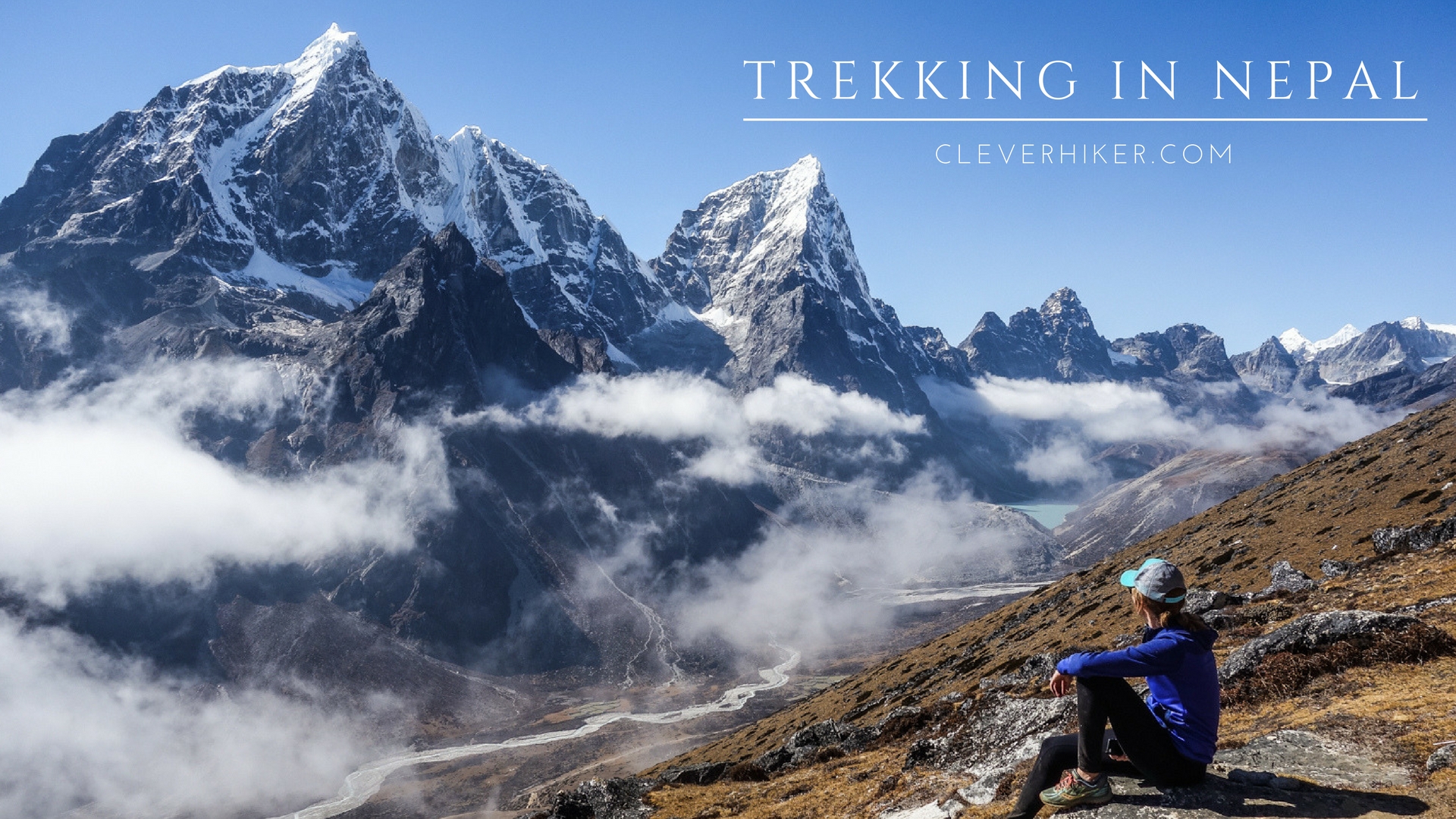
Nepal is one of the most stunningly beautiful countries on the planet. It’s a place where towering white peaks touch the sky, monks peacefully meditate in ancient mountainside monasteries, and lumbering yaks haul goods to quaint villages largely disconnected from the outside world. To put it simply, Nepal is a backpacker’s dream come true.
For all it’s grandeur and immensity, planning a trek in Nepal isn’t as difficult as you might think. Trekking tourism has been popular in Nepal for decades and Nepalis are excellent hosts. Kathmandu has hundreds of quality guiding companies and “teahouse” lodges bring an entirely new level of comfort to the backcountry. Even for those with little backpacking experience, trekking in Nepal is likely to be accessible, affordable, and absolutely unforgettable.
So if you enjoy stunning views, radiant culture, and epic adventure, chances are you’ll fall in love with Nepal. We hope you find this guide useful for planning your next trip.
Check out our Nepal Trekking Gear Checklist to help you with planning your adventure.
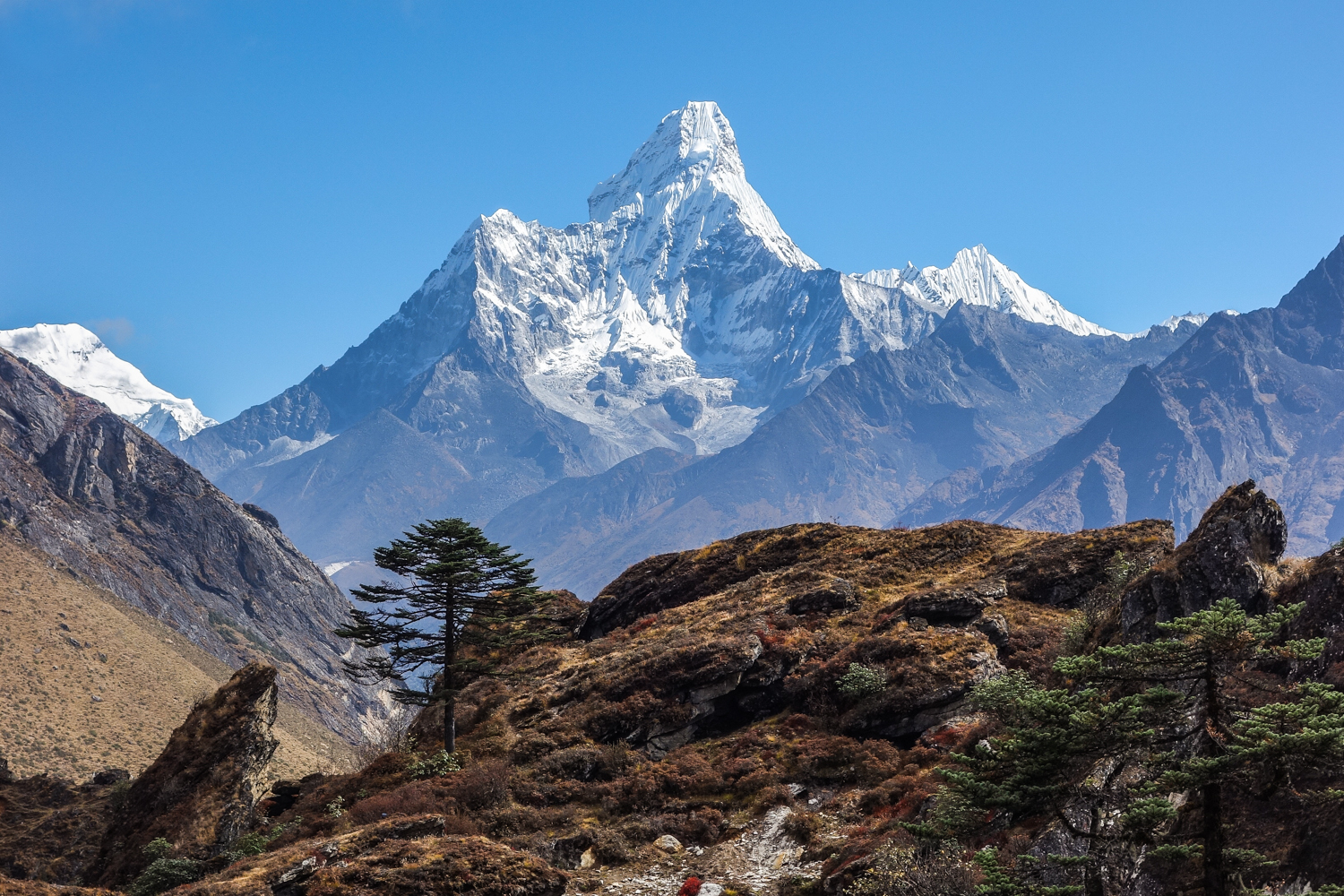
BEST TIME TO TREK
Technically you can hike in Nepal year round, but most trekkers choose between the two peak hiking seasons of fall and spring. If it’s your first time trekking in Nepal, we recommend visiting during one of these peak seasons. The trails will be more crowded, but the benefits tend to be worth it in our opinion.
Fall (October – November) : This is the most popular trekking season in Nepal. During this time you’ll have the best chance for clear mountain views, sunny skies, mild temperatures, and little precipitation. The downside is that you’ll be sharing the trail with throngs of other tourists and teahouses will be bumping, especially along the most popular routes.
Spring (March – April) : Spring is the second most popular time of year to trek in Nepal. As the snowpack melts on high mountain passes, giant rhododendron trees bloom across the hillsides of Nepal. Temperatures are generally mild this time of year and it’s a good time for viewing wildlife too. The two main downsides to spring hiking are busy trails and the possibility of hazy skies, which can obscure mountain views. That said, hazy skies tend to be less of an issue as you climb in elevation.
Off Peak Season : Trekking outside the peak seasons in Nepal can be rewarding as well. Solitude is easier to find, prices are cheaper, and befriending locals is easier too. That said, there are significant downsides to trekking outside the peak seasons in Nepal, so don’t be too cavalier when choosing your travel dates.
Experienced winter travelers ( December – February ) can find sunny days and brilliant mountain views this time of year. That said, temperatures can be bitter cold, daylight hours are shorter, and harsh winter storms can disrupt travel plans with little warning. Also, many popular trails will not be accessible this time of year due to heavy snowfall at high elevations.
Trekking during monsoon months ( May – September ) is not usually advised. Monsoon rains bring landslides and leaches to Nepal. The former makes mountain travel very difficult (if not dangerous) and the latter is just gross and obnoxious. The weather can also be hot and humid this time of year and the mountains are often obscured by clouds.
TEAHOUSE TREKKING
One of the reasons Nepal is such an amazing place to hike is the teahouse trekking culture. “Teahouses” are essentially small mountain lodges frequently spaced along popular trails. On most trails in the Everest, Annapurna, Manaslu, and Langtang regions you’ll pass a teahouse every hour or two. They’re a great place to meet other travelers, eat a home-cooked meal, warm your toes by the fire, and bed down for the night.
On a teahouse trek you’ll sleep in one of these lodges every night and you’ll eat almost all of your meals in teahouses too. Accommodations are usually simple, comfortable, and very affordable. It’s expected that you’ll eat your meals wherever you stay, which is one of the reasons rooms are so cheap. Teahouses also sell snacks, candy, hot showers, beer, and sometimes even halfway decent wifi.
Most teahouses cost around $3-5 per night and can be booked upon arrival. The usual setup is a small room with two twin beds and a shared bathroom down the hall. Some teahouses have rooms with attached bathrooms, but you’ll likely pay a premium for the upgrade. Blankets may be provided, but we recommend hiking with a sleeping bag for warmth, comfort, and cleanliness (learn more: Nepal Equipment Guide ).
For those looking to hike in Nepal’s more remote areas, camping treks can be arranged through most trekking agencies in Kathmandu. This option will add cost and complexity, but could lead to a unique and rewarding trek. That said, camping treks aren’t nearly as popular as teahouse treks and camping won’t be necessary on any teahouse trekking route.
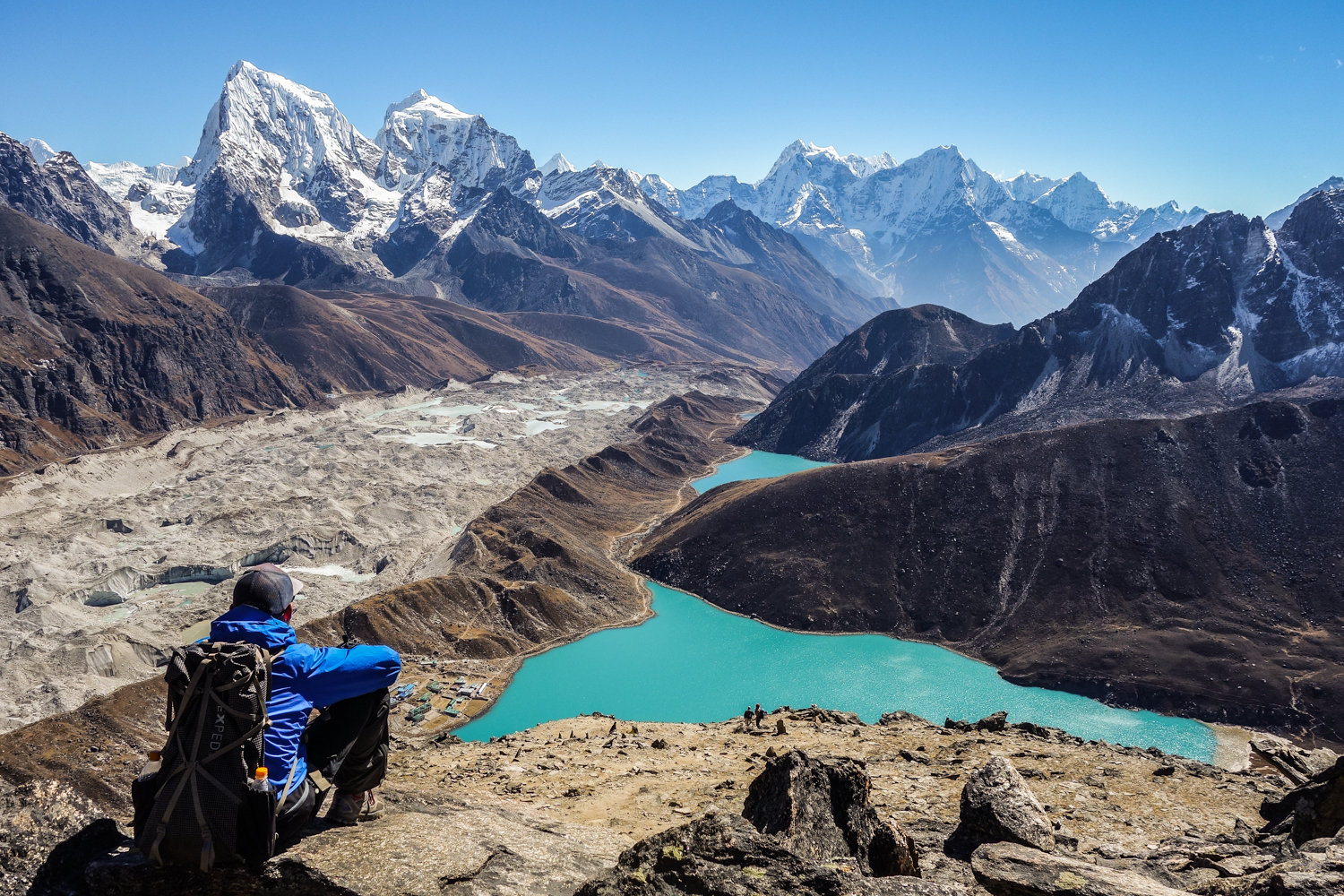
POPULAR TEAHOUSE TREKS
It would be impossible to list all the fantastic and unique trails in Nepal. So instead, we wanted to highlight a few of our favorites and some popular recommendations. These teahouse trekking routes are all exceptional hikes, and they’re a great place to start.
Everest Base Camp
Difficulty: Moderate to Difficult
Best Time: March-April & October-November
This is the most popular trekking route in Nepal, and with good reason. Walk in the footsteps of the world’s most famous climbers and gain a spectacular view of Everest from the peak of nearby Kala Patthar.
Annapurna Circuit
An extremely popular and stunning trek with lots of variety. This route combines spectacular mountain scenery with Tibetan-influenced culture and culminates at one of the highest trekking passes in the world, the Thorong La.
Annapurna Base Camp
Difficulty: Moderate
A fantastic trek for those with limited time still wanting to experience a stunning Himalayan amphitheater of mountains. This is also a lower elevation hike, which may make it better for those worried about altitude or hiking off-peak season.
Everest Three Passes Loop
Difficulty: Difficult
For those with the time and physical ability, this is one of the most spectacular trekking routes on the planet. Hit the highlights of the Everest Base Camp route and the stunning Gokyo Lakes on this epic and increasingly popular loop.
Langtang Valley
Once among the most popular trekking routes in Nepal, this area was hit hard by the 2015 earthquake, but it’s on the rebound. Trekkers looking to avoid crowds on a hike filled with Tibetan culture, natural diversity, and fantastic Himalayan scenery should definitely take a closer look.
Manaslu Circuit
This trek features spectacular mountain scenery coupled with a rich and authentic Tibetan culture. Though Manaslu is gaining in popularity, it still sees a fraction of the travelers drawn to the Everest and Annapurna treks. Also, if you have the time, a side trip up the Tsum Valley should not be missed.
Gokyo Lakes
This is a great trek for those looking to avoid the crowds of hikers headed to Everest Base Camp but still seeking majestic Everest scenery. The views from atop Gokyo Ri may be the finest in all the Himalayas.
Upper Mustang
Best Time: May-October
This heavily Tibetan-influenced district oozes with culture and panoramic Himalaya views. The uniquely arid mountain landscape of this region makes it a good choice when other areas are soaked in monsoon rains. This is a restricted area though and permits are pricy.
Difficulty: Easy to Moderate
This lower altitude trek is a popular option among hikers looking for a shorter taste of Nepal’s trekking culture. The route isn’t nearly as remote as many treks, but the views from Poon Hill are still stunning.

DIFFICULTY RATING
Trekking difficulty will depend on a multitude of factors including your experience, physical fitness, pack weight, and weather conditions. There are many different types of treks to choose from in Nepal with varying degrees of difficulty. Make sure to choose a trek that fits your fitness level and train adequately before your hike.
Trekking trips in Nepal are not technical (no ropes, ice axes, or crampons), but there will still be big ups and downs. There are sure to be long days and sore legs, but treks in Nepal are paced to give a lot of time for rest and acclimatization, so don’t fret. It certainly won’t be easy, but most active hikers fair very well on Nepal’s trails, especially with some training beforehand.
Porters are another consideration for reducing the difficulty of your trek. A porter can be hired to carry heavy gear, so all you have to tote is a small daypack. This option greatly increases accessibility along Nepal’s trails. We were surprised and impressed by the amount of people in their 50’s, 60’s and even 70’s who we met on the trail.
INDEPENDENT OR GUIDED TREKKING
Update: Effective April 1, 2023, new requirements require solo or foreign independent trekkers to use a local guide or porter while trekking in Nepal’s national parks and protected areas.
This is an important question for many trekkers and the choice will likely come down to experience and personal preference. If you’re a highly experienced backpacker traveling along a popular route (Annapurna Circuit, Everest Base Camp, etc.), it’s likely that you’ll get by just fine without a guide. That said, Nepali guides bring more to the table than just logistics management. A good guide can help you learn about local culture and may even become a close friend.
For many popular trekking routes in the Annapurna and Everest regions you won’t be required to hire a guide. These trails are mostly well marked and have lots of travelers. This leaves the door open for experienced trekkers to hike independently, which is a nice benefit for those with the skills and know-how. If you’re unsure of your preparedness or nervous about high altitude safety, we recommend hiring a guide. Also, for trekking trips to any restricted area, you will be required to hire a guide.
If you plan to hike independently, make sure you have a good map, the proper permits, and a good guidebook before you leave Kathmandu (see map & guidebook section below). Also, expect to put in a good amount of planning time to fully prepare for your hike.
Guided Trekking Pros
All pre-trip details handled (permits, fees, etc.)
All transportation arranged (bus, plane, jeep, etc.)
Little worry about any details while hiking (lodging, route, schedule, etc.)
Guidance & safety while trekking at high altitude
Local information on religion, culture, food, etc.
Independent Trekking Pros
Can be much less expensive
Hike on your own schedule
More direct interaction with locals
More choice on where to stay & eat (though guides usually know the best spots)
No group dynamics to deal with, just you and the trail.

GUIDES AND PORTERS
Guides and porters are very common in Nepal (though not always mandatory) and prices are quite competitive. In general a guide will cost around $25-30 per day and a porter will cost around $10-15 per day. A guide will help with logistics, information, and safety on your trek. A porter will carry heavy gear, so you only have to hike with a small daypack.
If you choose to trek with a guide, make sure they speak fluent English because they’ll be the point person on your hike. They’ll manage transportation, lodging, food, hiking schedule, routes, and safety on the trail. Your guide will also be a good source of information on local culture, customs, festivals, and norms. A good guide can be an extremely useful resource on the trail and they may even become a lifelong friend.
Porters are also useful and very common along trails in Nepal. Porters have the job of carrying heavy gear, so you don’t have to. This is especially beneficial for older trekkers, novice trekkers, or groups with children. Just remember, even if you do decide to trek with a porter, it’s still very important to keep your gear weight to a minimum. Porters have an absolutely backbreaking job, so please don’t make it any harder on them.
Also, make sure to tip your guide and porters well. A good tip is about 15% of the total you paid for their services. Hand the money directly to each person to ensure they get the full payment. Guides and porters have very tough jobs and they often get surprisingly little compensation for their work.
Guide Recommendation
Looking for a guide on your trip to Nepal? I highly recommend reaching out to our friend Ganesh in Kathmandu. Ganesh is truly an exceptional guide and you’ll love trekking with him if he’s not booked up. He’s knowledgeable, friendly, funny, and highly experienced. Here’s his contact info: [email protected] , Ace Vision Treks & Tours or ACE Vision Nepal , and Ganesh on Facebook . Just tell him Dave & Annie sent you.
TREKKING COMPANIES
There are literally hundreds of trekking companies in Kathmandu and many of them are very good. With a little online research (try tripadvisor ) you should be able to find a bunch of highly qualified companies to help you plan a trek. Most companies plan treks advance, but you can also fly into Kathmandu and plan a trek in person surprisingly easily. Planning things in person will require more flexibility, but you’ll likely save a good chunk of change and have the chance to interview guides before your trip.
Trekking Company Recommendation
During our most recent three months in nepal, we worked with Ram at Outdoor Himalayan Treks . Ram was absolutely fantastic and we’d highly recommend contacting him if you have any questions. He gave us tons of useful information and helped us plan transportation, accommodation, and trekking permits on a few of our hikes. Here’s Ram’s contact info: [email protected] or Ram on Facebook . Just tell him Dave & Annie sent you.

GROUP OR SOLO TREKKING
Some trekking companies offer group packages for popular trails. This can be a good way for solo travelers and couples to link up with other hikers and save a little money in the process. There are downsides to traveling in a large group as well, so make sure you know what you’re getting into before you sign up. Many trekkers (us included) prefer hiking in small groups or with a personal guide. That type of travel will give you more flexibility and less compromise as you trek.
TEAHOUSE TREKKING GEAR
Need to know what to bring? Visit our Nepal Gear Guide & Checklist for personal recommendations on the best trekking equipment. You can also check out the CleverHiker Gear Guide for all our favorite non-Nepal equipment (tents, stoves, sleeping pads, etc.).
NEPAL GEAR GUIDE & CHECKLIST
CLEVERHIKER GEAR GUIDE
GUIDEBOOKS & MAPS
For general trip planning and research, we highly recommend picking up the Trekking in the Nepal Himalaya book. This book covers all the popular trails and some less popular routes too. It has extremely helpful information about trekking, accommodation, food, and general Nepal travel advice. We used this book nearly every day on the trail (we took pictures of pages with our phones to save weight) and found it very useful.
Once you decide on a trek, it should be easy to find specific maps and guidebooks when you reach Kathmandu. Just walk around Thamel (the main tourist hub in Kathmandu) and you’ll find lots of bookstores catering to trekkers with the most updated resources.
Make sure at least one member of your group is carrying a detailed map of your trek. You may not need it much for navigation (most popular routes are well marked), but it will still be useful. Also, a good guidebook with detailed trail descriptions can be helpful as well. It’s nice to know what challenges lie ahead and get excited for upcoming highlights.

TREKKING SAFETY
When hiking in Nepal, you’ll be heading into remote areas far from reliable hospitals. That’s why it’s important to take every precaution before you set out. Below you’ll find some of our safety tips for trekking in Nepal. Also, check out our emergency first aid skills tutorial video to brush up on your wilderness safety knowledge.
Educate yourself on Acute Mountain Sickness (more info below). Take the prescribed acclimatization days on high-altitude treks, stay hydrated, and listen to your body.
Helicopter evacuations are not uncommon in Nepal, and many of them are preventable. Evacuations like these can be incredibly pricy, so we recommend picking up trekking travel insurance before you trip.
Don’t trek alone. If you’re traveling solo consider hiring a guide or making friends to hike with.
Always pay close attention to weather conditions, especially on long pass days. Storms can develop quickly in the mountains and can be fatal if you’re unprepared.
Always hike with a lightweight first aid kit and the 10 backpacking essentials .
Leave a detailed itinerary with an emergency contact and write important phone numbers on a piece of paper that will be easy to find in an emergency.
When encountering yak or donkey caravans, move to the inside (away from any cliff) and let them pass. These animals can sometimes be clumsy and may bump into you.
Crime is not common in Nepal, but it’s not unheard of either. Keep a close eye on your belongings, especially your backpack filled with valuables.
Always carry enough water on the trail and stay hydrated. Also, bring a water purifier (more info below) to make sure your drinking water is clean.
Keep your eyes on the trail to avoid any missteps that could end your trek.
Be very careful around landslide and avalanche areas. Consult a guide or locals if a crossing looks difficult and don’t take unnecessary risks. Turning around is always an option.
HIGH ALTITUDE SAFETY
If you’re trekking in Nepal, there’s a good chance you’ll be hitting some high elevations, so it’s important to know the basics of high altitude hiking. Acute Mountain Sickness (AMS) is no joke, and if you make reckless decisions or ignore symptoms, it could even kill you. Most hikers take the time to acclimatize properly and experience limited AMS symptoms if any, so there’s no need to freak out. But you do want to understand AMS and take it seriously. Check out our high altitude safety tutorial video for more info.
TRAVEL INSURANCE
We highly recommend purchasing travel insurance if you plan to trek in Nepal. In fact, we wouldn’t trek in Nepal without it. Most trekking locations in Nepal are very remote, so if something goes wrong, you’re likely to need an emergency evacuation, and that can get insanely expensive.
When choosing travel insurance, make sure to buy a plan that will cover high altitude trekking and helicopter evacuations in Nepal. We did a bunch of research and ended up choosing World Nomads . Their rates were reasonable, their coverage was excellent, and communicating with them was easy. We fortunately didn’t need to use our travel insurance, but the peace of mind alone was well worth it.

POST EARTHQUAKE CONDITIONS
Nepal was hit by a massive earthquake in April of 2015 . Thousands died in the disaster and widespread damage affected many temples, buildings, roads, and some trekking infrastructure.
We spent 3 months trekking around Nepal in the fall of 2016 and had very few inconveniences due to the earthquake. Some signs of the devastation remain, but most trails have been fully repaired. Accommodations were safe and plentiful, especially along popular routes.
Teahouse food options are generally simple but sufficient. Menus are roughly the same at most teahouses (see example menu below) with the ubiquitous dhal bhat as a hearty and delicious staple. You will also commonly find momos (dumplings), pasta, rice dishes, soups, pizzas, and in some places yak steak and apple pie. A home-cooked warm meal will always be a nice treat at the end of a long day on the trail.
Although teahouse menus are always similar, you’ll notice that prices increase as you move farther away from cities. Most supplies must be carried by yak or donkey to remote locations, which explains the increase in cost. It’s also always a good idea to carry snacks when trekking between villages and on long pass days.
*Note: If you plan to book a trip through a trekking agency, make sure to talk about food costs ahead of time. Most companies will give you two options: 1) you pay an up-front fee that will cover all food costs on your trip or 2) you bring money and pay for meals as you go. The first option is easier because you won’t have to hike with lots of cash and handle money throughout the day. The second option can be much cheaper though, because you’ll only pay for exactly what you order.
Below is an example of a typical teahouse menu. Prices are displayed in Nepalese Rupees (about 100 = 1 USD). For reference, this was one of the most expensive teahouses we visited.

It’s important to have a water treatment plan before you trek in Nepal. Water is usually easily accessible, but you’ll want to purify it first for safety. Water treatment pills, UV sterilizers, and water filters are all popular options. You can also purchase bottled water from teahouses, but that’s an eco-unfriendly strategy that will greatly increase cost and waste on your trip. We used a SteriPEN Ultra on our last Nepal trip and we highly recommend it. It was fast, easy to use, and we didn’t have to ingest any funky tasting chemicals.
While hiking, we recommend carrying at least 1-2 liters of water and filling up often. Staying hydrated is essential while trekking and it becomes increasingly important as you hike higher in elevation. Also, it’s easy to forget about drinking water when it’s chilly outside, but it’s imperative to stay hydrated. Ordering pots of hot tea can be a great way to ensure you’re getting enough fluids on cold days.
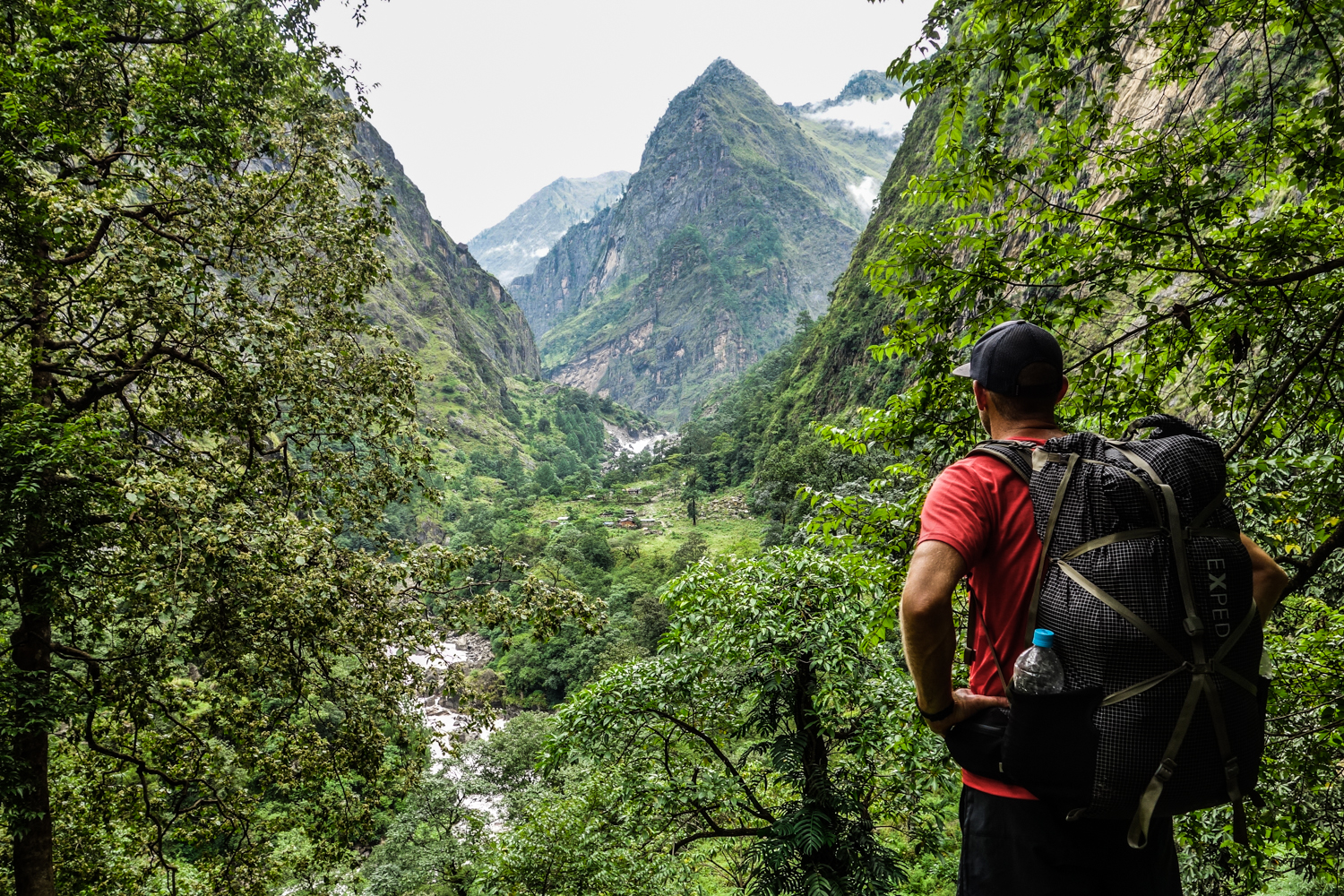
Trail towns don’t have ATM machines and teahouses rarely accept credit cards, so you’ll want to make sure you bring plenty of cash for your trek. In the fall of 2016, we budgeted around $30 per person per day for food and accommodation on our treks. In the Annapurna and Manaslu regions that budget covered our daily expenses and then some. We often had extra funds for treats like hot showers, beer, and baked goods. In the Everest region our $30 per day didn’t go quite as far, but we were still able to buy the occasional treat.
In general, it’s always smart to carry more cash on the trail than you might think. Luxury items like chocolate, tea, beer, wifi, and hot showers are all great morale boosters, but the costs add up. You may also want to buy small gifts, replace broken equipment, or hire transportation if your travel plans fall through.
It’s also important to consider the costs of charging your electronic devices. Some teahouses will let you charge batteries for free, but most collect a fee. Usually you’ll be able to get a full battery charge for $2-5, but in remote areas it can cost more.
Most teahouses offer hot showers for a fee, usually around $3-5 per shower. Showers will range in quality from a bucket of hot water to the rare proper shower. We found it often wasn’t worth the cost for a mediocre shower, so we recommend bringing wet wipes for quick cleaning.
*Note: Namche Bazaar in the Everest region does actually have an ATM machine, but it can be inconsistent, so we wouldn’t recommend counting on it.
TRANSPORTATION
Most visitors fly into the Tribhuvan International Airport (KTM) in Kathmandu, the capital city of Nepal. Kathmandu is a great base for sightseeing, planning a trek, or any last minute hiking preparations.
In general, transportation around Nepal is very slow going. Long bus rides, cancelled flights, and unexpected delays are sadly part of the norm. So make sure to give yourself a couple buffer days when planning your trip and embrace the adventure.
Most popular treks depart directly from Kathmandu or Pokhara, the second largest city in Nepal. Some treks are accessible via flight, but many require a long bus or jeep ride to the starting point. Depending on your destination, there will usually be a couple different options to get there. Local transportation tends to be cheaper, but “tourist” options will often be far more comfortable.
If you organize a trip through a trekking company, they will take care of the logistics for you. If you choose to trek independently, you’ll need to get the proper permits and pay any park/conservation fees before your trek.
Every trekker in Nepal needs a TIMS card ( Trekking Information Management System ), which costs around $20. You can get your TIMS card and pay your park fees at the Nepal Tourism Board offices in Kathmandu or Pokhara before your trek.
It’s also likely that you’ll need to pay conservation or national park fees. These can be obtained ahead of time and commonly cost around $20-$30, depending on where you’ll be hiking. You may be able to pay some park fees on the trail, but we found it much easier to take care of everything ahead of time.
UPDATE- JANUARY 13, 2018 – There have been some changes to the TIMS requirements for the Khumbu (Everest) region. It is no longer necessary to obtain a TIMS Card for this area. Instead, they are collecting a Khumbu pass, which costs NRS 2000 or USD 20 per person. It is uncertain how long this change will stay in place as many people in the travel agencies are unhappy with the system. We always recommend checking the most current requirements before beginning your trek.
PERMITS – RESTRICTED AREAS
There are several restricted areas in Nepal that require special trekking permits. If you’re heading to one of these areas you’ll need to obtain permits through a registered trekking agency and travel with a guide. As of March 2017, the following areas require restricted-area permits: Manaslu, Nar-Phu, Tsum Valley, Upper Mustang, Dolpo, Kanchenjunga, and Humla.
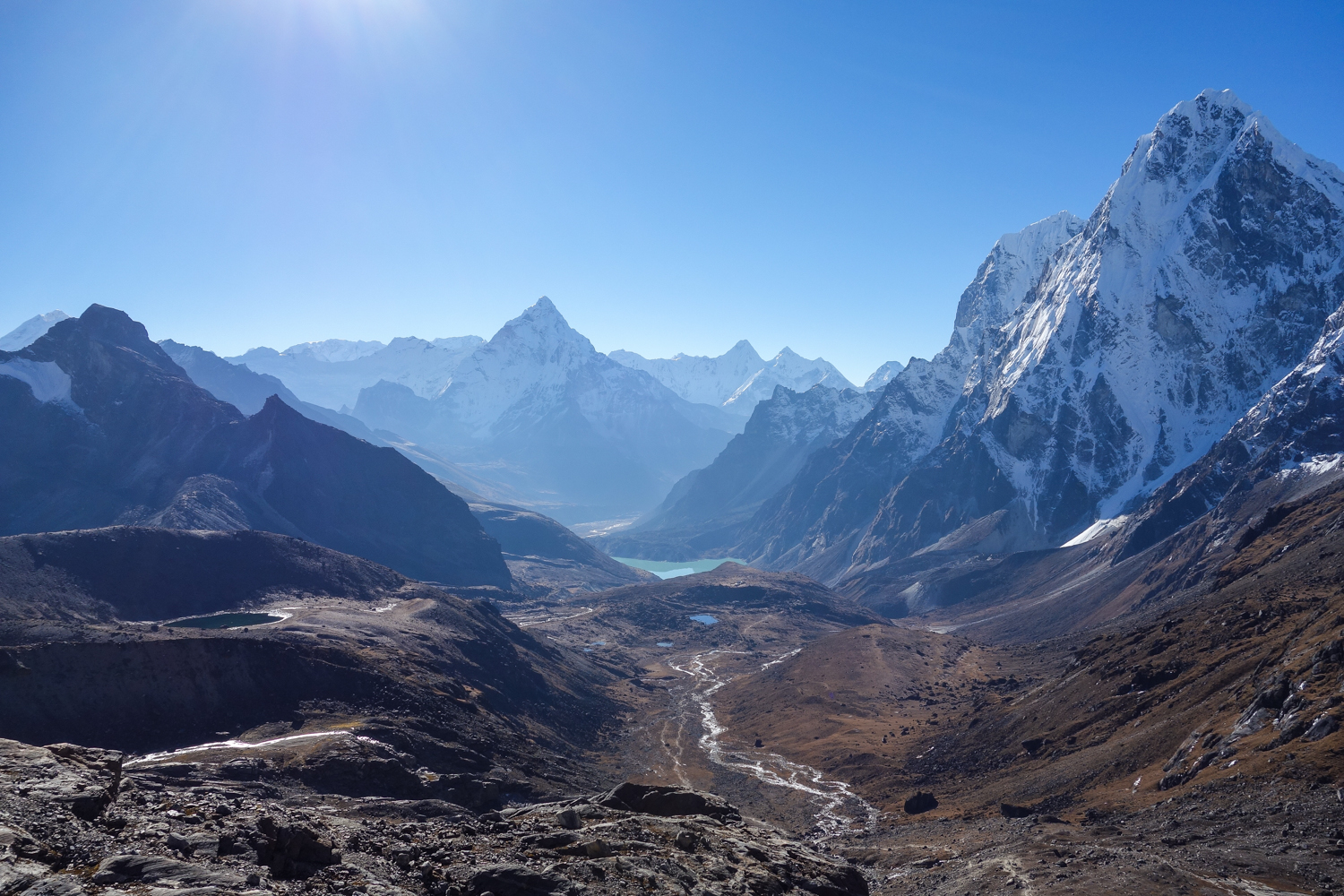
PHONES AND WI-FI
For better or worse, it’s becoming increasingly easy to stay connected while trekking in Nepal. Along the most popular routes, some teahouses sell wifi and you may even get a phone signal using a local SIM card. Don’t count on staying connected though, because service is often unreliable at best.
If you buy a local SIM card in Kathmandu, there are two main companies to choose from: Ncell and Nepal Telecom. As of fall 2016, there was minimal (if any) coverage in remote regions, such as Manaslu, Tsum Valley or Dolpo. In the Annapurna region, Nepal Telecom SIM cards seem to work okay, while in the Everest region, NCell was a better bet. We were far from impressed by phone connectivity on the trail, but we expect coverage will get better in the coming years.
Wifi may be available at some teahouses along your trek as well, though speed and functionality will be highly variable. In the Everest region they sell pre-paid wifi cards (around $3 for 100mb) that work well but get used up quickly. In contrast, on the Annapurna Circuit you may pay a one time fee of $3-5 for wi-fi access, but connections can be very slow (if working at all).
VISA INFORMATION
In order to enter Nepal you will need to obtain a tourist visa. Most people get a visa on arrival at the Tribhuvan International Airport in Kathmandu. You can also do this ahead of time at a Nepal Embassy if you are traveling overland from India.
As of March 2017, US travelers had three tourist visa options. You could choose a 15 day visa ($25), a 30 day visa ($40), or a 90 day visa ($100). There are electronic visa machines at the international airport and staff to assist with forms. We applied for a 90 day visa on arrival and found the process to be surprisingly quick and efficient.
Please check current visa guidelines for specific information as these policies can change and this website is not an official source of information on Nepal visas.

RESPONSIBLE TREKKING & CULTURAL CONSIDERATIONS
The number one rule of backpacking conservation is Leave No Trace . Learn it and live it.
Don’t buy bottled water in teahouses. The extra cost and waste are not worth it. Instead, use treatment pills, a water filter, or a UV sterilizer. We used the SteriPEN Ultra and loved it.
Don’t litter. Pack out your trash and keep Nepal beautiful for generations to come. If you really want to be a superstar, pack out trash that you find along the trail.
Deforestation is a real problem in Nepal. Avoid using firewood and stay in lodges that use eco-friendly fuel.
Dress conservatively, especially when sightseeing in towns. For women, this sadly means no shorts or shirts that show shoulders.
Public displays of affection are frowned upon in Nepal, so save it for private time.
Walk to the left of religious monuments such as mani walls, chortens, and prayer wheels. If you spin a prayer wheel, always spin it clockwise.
Follow the rules when visiting temples. Shoes off, no exposed shoulders, cover your legs, and don’t take pictures inside. Also, don’t enter Hindu temples wearing leather products.
Always ask permission before taking a photo of a person. Most people won’t mind, but if they decline, respect their wishes.

MORE RESOURCES
Hopefully you found this guide helpful for planning your trip to Nepal. We have truly fallen in love with Nepal and we know you will too. For more helpful resources check out the following links:
Nepal Gear Guide & Checklist
Best Backpacking Gear – CleverHiker Gear Guide
CleverHiker Top Gear Awards
Essential Trail Skills Video Series
L ightweight Gear Basics Video Series
And as always, please feel free to leave a comment below if you have any recommendations, questions, or suggestions. Take care and happy hiking!
Disclosure: Some of the links on this page are affiliate links, which means we may receive a small commission if purchases are made through those links. This adds no cost to our readers and helps us keep our site up and running. Our reputation is our most important asset, which is why we only provide completely honest and unbiased recommendations.

- Nepal Travel Guide
The 10 Best Treks in Nepal
This list has been updated in September 2023 to cover the most recent conditions. Most treks listed here take about 2 weeks to complete. All of these treks offer incredible views and a close-up view of cultures and nature of the Himalayas. The summary, below, will help you figure out which trek is ideal for you.
For adventure, spiritual meditation and cultural experiences, Nepal is an ideal place. When you are in Nepal, there are plenty of choices for you to choose from: hiking, mountaineering, camping, rafting, and wildlife safari and more or simply a luxury trip. If you want to participate in ethnic and cultural celebrations, this country’s diverse terrain will offer you the best experiences !
Nepal has become the world’s most popular hiking destination in recent years. You can enjoy gentle walks to the mesmerizing treks, just in the same country.
1. Gokyo Lake Trek
- Maximum Altitude : 5357m, Gokyo Ri
- Duration : 12 – 14 days
- Best Seaso n: March – May & October – November
- Trek Grade : Moderate to difficult
- Accommodation Type : Guesthouse
- Trek Permits : Yes (Sagarmatha National Park)
Gokyo Lake trek is a beautiful valley of iced lakes and glaciers. The journey passes through rhododendron and oaks forests, with a rich diverse of flora and fauna. The waterfalls, which are mostly frozen is interesting. The valley preserves numerous high-altitude wetlands and freshwater lakes ecosystems. The Valley is a home for solitary Sherpas with ancient monasteries and its rich cultures.
Gokyo Ri is the little less known and slightly farther away viewpoint of Everest comparison to its more popular Kala Patthar. The views of Everest are amazing too and some trekker considers it even better than Kala Patthar because more of the surrounding Himalayas can be observed.
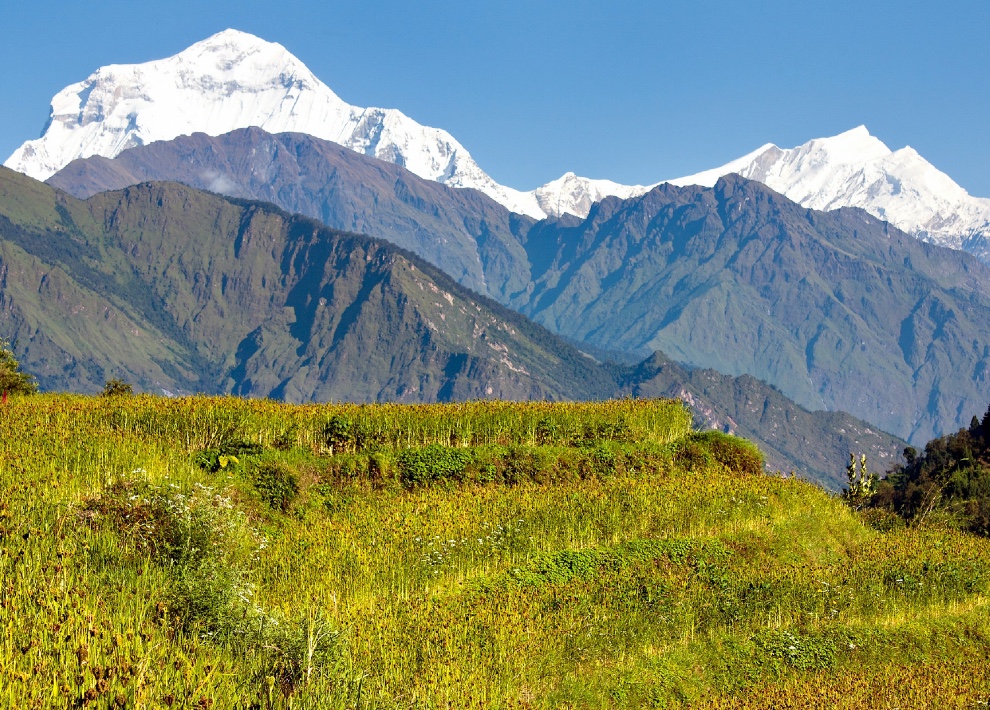
2. Everest Base Camp Trek
- Maximum Altitude : 5600 meters, Kala Patthar
- Duration : 14 – 16days
- Trek Grade : Moderate to Difficult
- Best Season : March – May & October – November
- Trek Restrictions : No
- Trek Permits : TIMS, Sagarmatha National Park
The Everest Base Camp trek is one of the wonderful and most hiked trails in Nepal. Many tourists visit Nepal to trek in the Everest region to experience the enticing Himalayan Mountain views. The trek begins at Lukla, a flight from Ramechhap which will take around 5 hours’ drive from Kathmandu.
Alongside with warm Sherpa culture and ancient monasteries. Unique glaciers, hanging icicles and the stunning landscapes en route add adventure to your journeys.
It is also possible to this journey by helicopter. Everest Helicopter tour is perfect for anyone who don’t want to trek but still want to see Mount Everest.
3. Nar Phu Valley Trek
- Maximum Altitude : 5416 meters
- Duration : 9 – 12 days
- Best Season: March – May & October – November
- Trek Permits : Yes
- Trek Restrictions : RAP, ACAP
Nar Phu Valley is a rugged and wild trek in the north of Annapurna area. Following the famous Annapurna Circuit route, the trek begins from Kyoto on the off-the-beaten-path to the Nar Phu Valley.
The valley preserves ancient villages and grazing valleys at high altitudes. When you interact with the locals of the village, you encounter Tibetan cultures and traditions.
4. Mardi Himal Trek
- Maximum Altitude : 4,250 meters
- Duration : 5 – 7 Days
- Best Season : March – May & September – December
- Trek Grade : Easy
- Trek Permits : ACAP, TIMS
It is a short and pleasant hike in the Annapurna region. On the trek, you walk through wonderful glacial villages and breathtaking landscapes. You will walk through the Rhododendron blossoms during spring.
Mardi Himal used to be the less-known trek in the Annapurna region. On this trail, there are still fewer trekkers than on Poon Hill, Annapurna Base Camp or Annapurna Circuit . Also, they have cozy homes ready for your service if you want to spend time with the locals.
5. Annapurna Circuit Trek
- Maximum Altitude : 5416 meters, Thorong La Pass
- Duration : 12 to 18 days
- Trek Garde : Moderate to Difficult
- Trek Permits : TIMS, ACAP
The Annapurna Circuit Trek is a wonderful trek in the mountains of the entire Annapurna range. The trek takes you to the Alpine forests from the lush pastures.
To finish in the barren desert-like terrains of Mustang and Manang. And the advantage is that each corner of the route offers a majestic view of the Annapurna range. This trek offers a diverse trek route that gives you the opportunity to collect as many memories as you like.
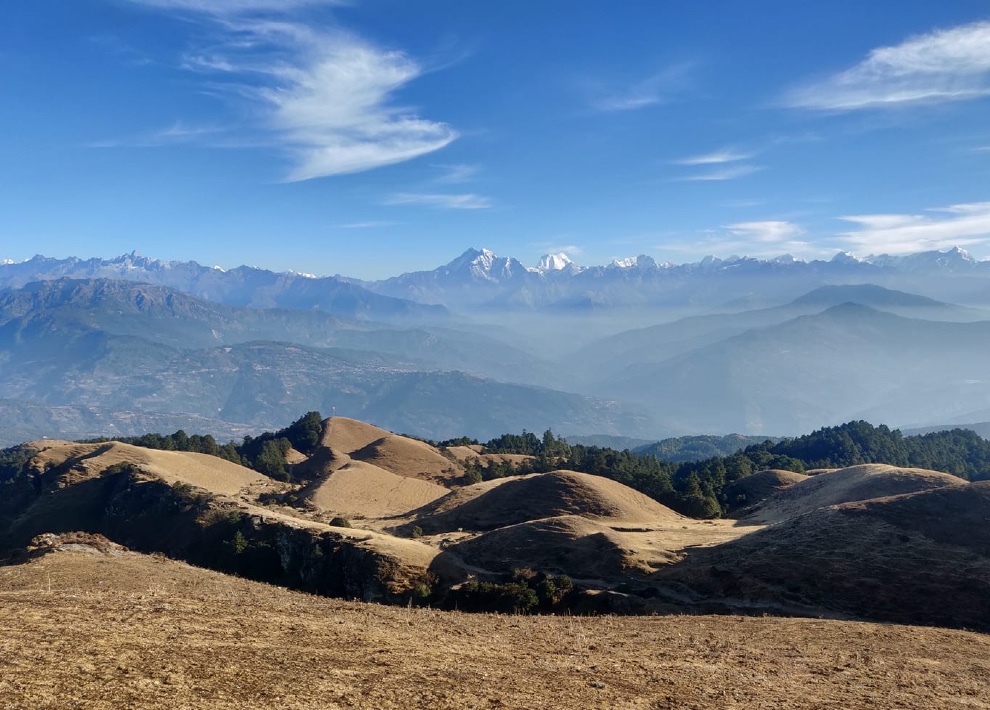
6. Langtang Valley Trek
- Maximum Altitude : 4,984 meters, Tserko Ri
- Duration : 8 Days
- Trek Grade : Moderate
- Best Season : March – May & October – November
- Trek Permits : TIMS, LNP
Langtang Valley Trek is not far from Kathmandu city, but it is one of the most popular treks. The trek begins at Syabrubesi, 7 hours’ drive from Kathmandu.
During this trek, you pass the snow-capped peaks of the Langtang high Valley, the rugged beauty of the Gosainkund Lake (if you combined) and its satellites and the rich cultural heritage of the Helambu Valley.
This easy access and traditional tea houses along the route make it absolutely attractive for those looking for a quieter alternative to the ever-popular Everest and Annapurna regions
7. Manaslu Circuit Trek
- Maximum Altitude : 5,160 meters, Larke La Pass
- Trek Duration : 12 – 16 days
- Best Season : March to May, September to December
- Trek Grade : Difficult
- Trek Permits : TIMS, MCAP, RAP
- Trek Restrictions : Yes
The trip circles around Mount Manaslu, which is 8th highest mountain in the world. On this trek, you’ll see epic scenery crossing several suspension bridges. Also, temporary wooden plank bridges at higher altitudes. With a side trip to Tsum valley, the trek can be extended to 21 days.
8. Upper Mustang Trek
- Maximum Altitude : 3,810 meters, Dhakmar
- Trek Duration : 10 – 14 days
- Best Season : March to December
- Accommodation Type : Teahouse
- Trek Permits: ACAP, RAP
The Upper Mustang Trek offers unique experience in the rugged Trans Himalayas of Nepal. On this trek, you will have wonderful views of Nilgiri, Annapurna range, Dhaulagiri and many other Himalayas.
The trek starts from Jomsom to enter the rain-shadow region of Nepal’s treeless zone, Mustang. The hiking trail follows the old salt caravan route. The place is beautiful with white painted homes, extended barley fields, old gompas (monastery) chortens and Buddhist peace flags.
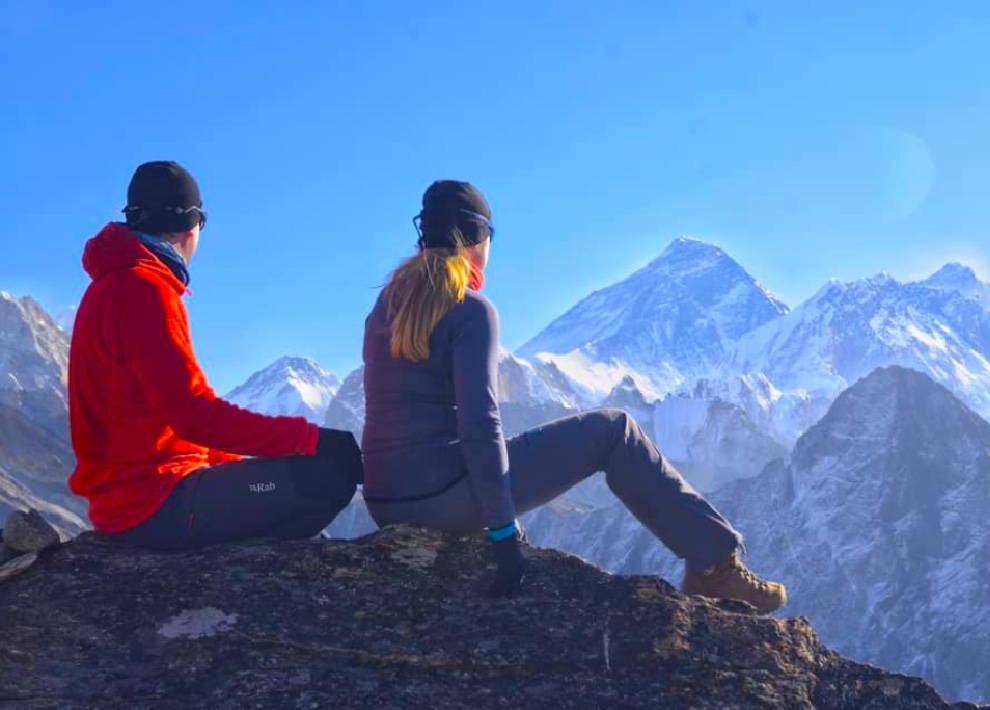
9. Kanchenjunga Circuit Trek
- Maximum Altitude : 5,200 meters, Pang Pema
- Duration : 21 – 28 Days
- Best Season : March – May & October – December
- Accommodation Type : Lodge, Camping
- Trek Permits : ACAP, RAP
This Kanchenjunga Circuit trek is much less visited by trekkers and includes a wide variety of spectacular landscapes, from lush tropical jungle to rhododendron, chestnut and oak forests and up to the third highest peak in the world.
You will pass through the villages of the Sherpas , Rais, Limbus. The trek starts at Suketar, 4 hours’ drive from Illam.
10. Ghorepani Poon Hill Trek
- Maximum Altitude : 3210 meters, Poon Hill
- Duration : 3 – 7 Days
- Best Season : All year round
- Trek Permits : Yes (TIMS, ACAP)
Ghorepani Poon Hill trek is a famous Himalayan trek in the Annapurna region . The trek starts at Nayapul, 45-minutes’ drive from Pokhara, and take you to the typical villages of the settlements of Gurung and Magar. En route, you cross the blossoms of Rhododendron, especially in Spring. You will get the chance to see the Annapurna range in your face from Poon Hill and a beautiful sunrise view.
General Frequently Asked Questions
Can I trek in Nepal without a guide?
Yes, you can trek in Nepal without a guide restriction to some restricted area like Manalsu Circuit, Nar phu, Upper Mustang, Kanchenjunga, Upper Dolpo. The guide is compulsory for restriction regions to get the permit.
How much does it cost to trek in Nepal?
It depends with trek, the number of people and the type of service you prefer. We suggest allocating USD 35 person, in a day, if you are hiking without a guide. A 7-day trek (Langtang Valley Trek, Ghorepani Poon Hill Trek) starts at around USD 570 to 760 per person all-inclusive, if you are planning to trek with a company.
When is the best season to trek in Nepal?
It depends on the trek. Generally, the best time to trek in Nepal is from March to May and from September to mid-December. December, January and February are the best months for those who want to hike in quietness and don’t mind the cold on a popular trek. The rainy season is good for Upper Mustang and Upper Dolpo treks (June to early September).
Is Nepal Safe to travel?
Nepal is pretty safe. Having said, you are traveling/hiking in the Himalayas. In the mountain things are unpredictable. We suggest no solo trekking for an inexperienced hiker unless you know what you are doing. Hire a guide at least If you are hiking solo.
This article is based on experiences, thorough research, people on the treks and provides the latest information.
Are you dreaming of walking in the Himalayas? Share your trek preferences with us and click here to get started . We promise to organize the best trek, as per your desires.
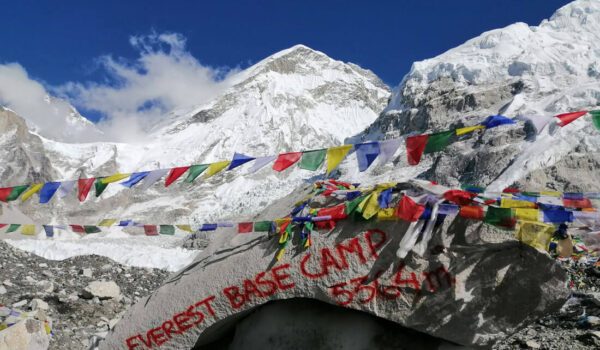
Best Time To Trek Everest Base Camp
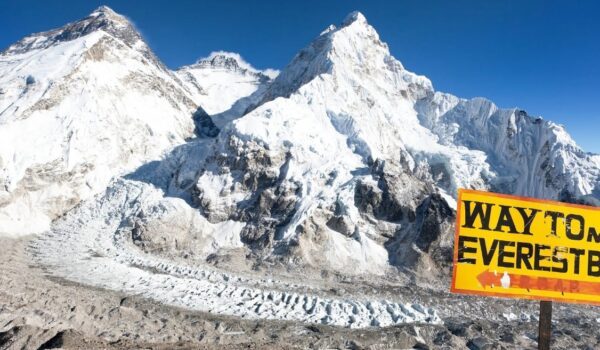
Everest Base Camp Trek Cost
Posts you might be interested in.
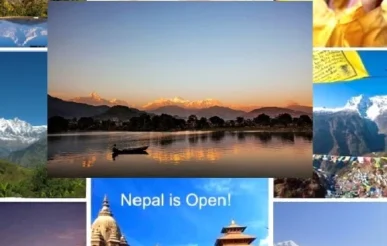
Nepal Travel 2022 – No PCR test required for fully vaccinated travelers
Upper mustang trek difficulty.
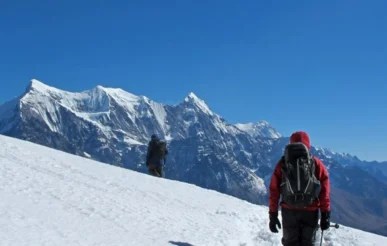
7 Things you need to know before going on a hike in Nepal
Personalize trip.
"I was born and raised in Nepal, nearby Everest region. I am proud to be a native Sherpa, and I have been a Mountain guide over a decade now. Following my passion, I decided to start helping travelers with their travel plans! I think life is a journey, a trip where you collect experiences when you share with other people and with nature."
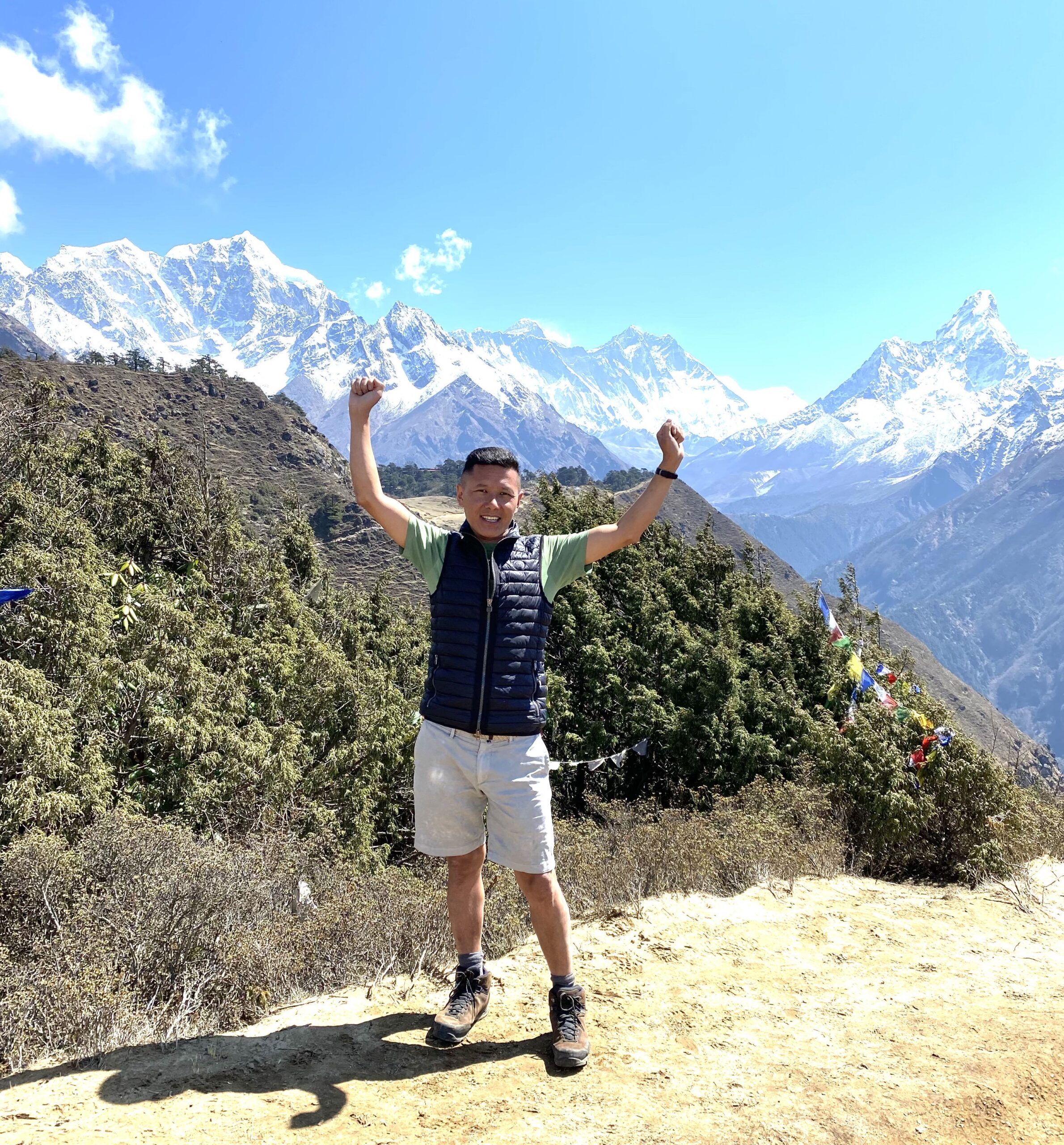
Chhiring Sherpa
We are certified.
- Nepal Tours
- Nepal Travel Guide
- Trekking in Nepal
Trekking in Nepal: Top 14 Best Treks in Nepal
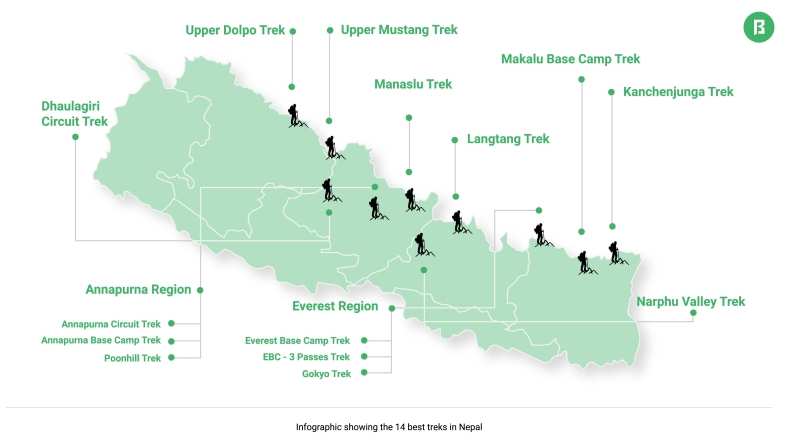
- 25.92K views
- ~ mins read
Home to the magnificent Himalayas, Nepal offers a multitude of breathtaking trekking opportunities for adventurers of all levels. From the legendary hike to Everest Base Camp that winds through the shadow of the world's tallest peak to the enchanting Annapurna Circuit, which showcases diverse terrain and stunning vistas, as well as lesser-known (but no less spectacular) hiking trails, Nepal has something to captivate every trekking enthusiast. Below we have handpicked the 14 most popular trekking tours in Nepal , along with highlights, lowlights, and some trek facts for ‘a best trek in Nepal’ crash course!
What is the best trek in Nepal?
While some may believe there’s an ultimate answer to what the best trek in Nepal is, it really comes down to individual trekking preferences. Consider these relevant aspects of trekking before zooming in on what the best trekking tour in Nepal is for you, personally:
- What level of trekking difficulty are you seeking?
- How many days do you have available for trekking in Nepal?
- Are you trekking with your family or children?
- Looking for a remote trekking destination or a touristy one that may have more amenities?
- Are you a budget traveler, or is price less relevant for you?
- During which season(s) are you trekking in Nepal? (Some treks are not recommended during the monsoon or winter seasons)
- Looking for an adventurous camping trek (also sometimes named ‘adventure treks’) or a simpler guesthouse trek?
- Do you require restricted permits? Some treks in Nepal have restricted permits and hence require a minimum of two people, and the company of a Nepali guide or porter.
We have curated this list of the best trekking trails below, taking into account the above-mentioned trekking parameters.
- Palsang Sherpa
- From Swaziland
1. Everest Base Camp trek

As one of the most famous treks in the world, the Everest Base Camp trekking trail is also likely the most popular trek in Nepal — and not without good reason. Depending on your route, you’ll trek through the Sherpa village of Namche Bazaar , learn more about the mountain culture at the impressive Sherpa Culture Museum, take in beautiful Himalayan vistas that include Nuptse and Lhotse, and perhaps pass the Khumbu Glacier. As it’s so popular, you’ll need to get a couple of permits before you hike and book way in advance to secure your spot.
How to get there: Fly from Manthali Airport in Ramechhap to the small town of Lukla during the high season (March to May and September to November). In other months, the flights are regularly operated from Kathmandu Airport. You can also travel overland from Kathmandu to Jiri by bus (approximately 186 km) and begin your trek here.
- Stand face-to-face with Mount Everest and experience Everest Base Camp itself.
- Summit Kala Patthar at 5,600 m, a vantage point providing fantastic views of majestic peaks such as Nuptse, Lhotse, and Mount Everest.
- Get amazing views of the Himalayas, pass high suspension bridges and climb steep inclines.
- Explore the temporary settlement of Gorakshep and interact with local Sherpas who reside in the area only during the trekking season in Nepal .
- You'll trek up and down on more or less the same trail.
⇒ Compare prices for Everest Base Camp or Get 5 Free Trekking Offers for Everest Base Camp
More information: Best time to trek to Everest Base Camp How long does Everest Base Camp trek take How to get to Everest Base Camp
2. Annapurna Circuit trek

Commonly known as one of the best trekking routes in Nepal, the trek to Annapurna Circuit takes you between tea houses (mountain hut accommodations) and small mountain villages, all the way up to the Thorong La Pass with stunning views of both the Annapurna and Dhaulagiri Ranges. It is also one of the busiest trekking routes in Nepal, so it can get really crowded, especially in the fall season.
How to get there: You can fly from Pokhara to Jomsom to start your trek or get the bus from Pokhara to either Chame or Manang.
- Crossing the world's widest pass—the Thorong La Pass at 5,416 m.
- Diverse trekking terrain as a result of high differences in altitudes.
- Very well-developed trekking trail with a high degree of comfort (lots of choice in terms of restaurants, accommodations, and amenities).
- Explore Tilicho Lake and Ice Lake, both above 4000 m of elevation.
- Get amazing views of Machhapuchhre, Annapurna I, and Gangapurna.
- Higher altitudes mean an increased risk of altitude sickness, symptoms of which include nausea, dizziness, headaches, and more.
⇒ Compare prices for Annapurna Circuit or Get 5 Free Trekking Offers for Annapurna Circuit
3. Annapurna Base Camp trek
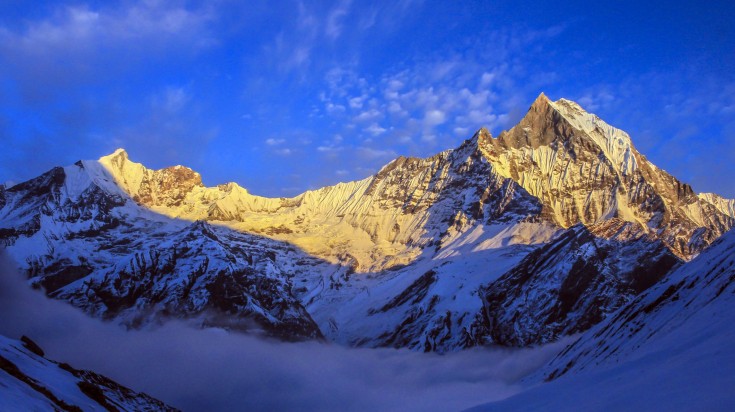
The Annapurna Base Camp trek only takes a maximum of 14 days but will leave you with a lifelong experience. Marvel at the amazing views of the Annapurna range, stop at tea houses along the way and enjoy lunch at Poon Hill Station , the historically and culturally rich spot that many elite Gurkha soldiers call home. Don’t forget to relax in Jhinu Hot Springs! It’s a relatively difficult trek with a lot of stairs, so keep that in mind.
How to get there: To begin this trek, get the 2-hour bus from Pokhara to Nayapul.
- Get majestic views of Annapurna I, Annapurna South, Machhapuchhre, and Hiunchuli.
- Explore Annapurna Conservation Area and its unique flora and fauna, including the rhododendron forest.
- Post-trek, spend a few days in the nearby lake town of Pokhara for good food, cafes, an after-trek massage, or a boat ride
- The trail has quite a few stairs.
⇒ Compare prices for Annapurna Base Camp or Get 5 Free Trekking Offers for Annapurna Base Camp
4. Poonhill trek

If you only have four days to spare for trekking in Nepal, jump on a Poon Hill trek . On this relatively short trek, you will explore the historic and culturally-rich Ghandruk area and take in views of both the Dhaulagiri Mountain Ranges and Annapurna. One of the best things is that this route is viable during the winter season, which is rare when trekking in Nepal. It is also a great trekking option for families trekking with children.
How to get there: Start from the popular city of Pokhara, which is accessible from Kathmandu by bus or by plane, and travel by bus to Nayapul.
- The trek only takes about four days which is great if you are short on time.
- Sunrise atop Poon Hill with a fantastic panoramic view of the Himalayas.
- Traverse terraced fields, dense forests, and picturesque valleys.
- Enjoy the warm hospitality of the Gurung and Magar communities.
- The trekking trail can be quite crowded during the high season.
⇒ Compare prices for the Poonhill Trek or Get 5 Free Trekking Offers for the Poonhill trek
5. Langtang trek

If you’re heading up to the northern border with Tibet, check out the Langtang Trek . Ranging anywhere from 7–13 days, it’s a moderately difficult trek that takes in monasteries such as Kyanjin Gompa , immerses you in the culture of the brightly dressed Tamang people, and offers stunning views of Tserko Peak—your eventual goal!
How to get there: You will need to either drive or catch the bus from Kathmandu to Syabrubesi which takes anywhere between 6–9 hours depending on the road conditions and type of vehicle — consider sharing a Jeep. Some tours include this transfer as part of the experience.
- Reaching the top of Tserko Peak at an altitude of 4,984 m.
- Trekking terrain includes meadows, yak pastures, and the glacial Langtang River.
- Explore Langtang National Park, home to the endangered red panda and lush bamboo groves.
- Optional visit to the scenic Gosainkunda Lake (4,380 m), which holds religious significance for Hindus and Buddhists.
- The trail is out and back for most of the way, so you’ll need to retrace your steps
⇒ Compare prices for the Langtang Trek or Get 5 Free Trekking Offers for the Langtang Trek
6. Manaslu trek

Spend two weeks trekking this circular route, including a day crossing the Larke Pass . Along the way, you’ll visit the Tsum Valley, home to the Tsum people and known as the “Hidden Valley of Happiness" thanks to its Tibetan Buddhist way of life. The Manaslu trek used to be one of Nepal’s best-kept trekking treasures, but now word has spread. It is still one of the best treks in Nepal and remains fairly remote. The Manaslu trek is classified as a hard trek and you will need to be accompanied by a Nepali guide or porter.
How to get there: Get a bus or drive from Kathmandu to Soti Khola to begin the trek. There are a few jeeps that go this way as well which might be better with the dodgy terrain and takes around 6 hours. Again, this transfer is included in many Manaslu Trek tours.
- The day of crossing the Larke Pass — a day of challenge and full adventure!
- The entire trail is a highlight. It is diverse, remote, and secluded, enriched by very different topography as a result of varying altitudes. You'll walk in a circuit and won’t retrace your steps.
- The cozy village of Samagaun from where you'll also visit Manaslu Base Camp.
- Get scenic views of Himalchuli, Ngadi Chuli, and Ganesh Himal.
- Encounter snow leopards, Himalayan musk deer and Himalayan tahr at Manaslu Conservation Area.
- Accommodation may be scarce, especially during high season.
⇒ Compare prices for the Manaslu Trek or Get 5 Free Trekking Offers for the Manaslu Trek
7. Everest Base Camp 3 Passes trek

Looking for the ultimate Everest Base Camp adventure? The Everest Base Camp 3 Passes Trek is a challenging route that takes from 16–18 days to complete. Hike up to Everest Base Camp via the Renjo La Pass and Cho La Pass before descending via the Kongma La Pass .
How to get there: Fly from Manthali Airport in Ramechhap to Lukla to start this trek. In the low season, the flights are regularly operated from Kathmandu Airport itself. Alternatively, you can catch the bus to Jiri from Kathmandu, which is considered the “classic” way to start this trek.
- Crossing each of the 3 passes is a challenge and a great adventure. Kong Ma La represents the biggest challenge as it is the highest of the three passes.
- The trekking trail includes three high passes, each over 5,000 m, making it diverse and secluded.
- The three passes route is one of the less-trodden areas of the Everest region which means the landscape is pristine and untouched.
- See the stunning reflections of the Himalayas on Gokyo Lakes, situated at 4,700 m.
- Cross the Himalayas' widest glacier — the Ngozumpa Glacier.
- The trek requires significant effort, endurance, and proper acclimatization as you need to cross three passes.
⇒ Compare prices for the Everest Base Camp 3 Passes Trek or Get 5 Free Trekking Offers for the Everest Base Camp 3 Passes Trek
8. Gokyo Lakes trek

Trek up to the five different emerald Gokyo Lakes , nestled in the mighty Himalayas. Visit the mountain village of Gokyo, check out the historic Tengboche Monastery, follow along the stunning Dudh Koshi River, and stop off at the Gokyo Ri viewpoint for one of the best mountain views in the world. As many tourists opt for mountain treks, this is a relatively remote and empty route. Check out our Gokyo Lakes trek .
How to get there: To get to the Gokyo Lakes, you actually follow the start of the Everest Base Camp trek, so you’ll fly into Lukla and trek around seven days to the lakes. Again, you can also go overland via bus from Kathmandu to Jiri and start from there
- Visit Sherpa villages such as Namche Bazaar, Dole, and Machhermo and interact with the locals.
- The five emerald-green lakes of the Gokyo Region.
- Gokyo Ri — a peak and vantage point providing the best panoramic view of Mount Everest, Lhotse, Makalu and Cho Oyu.
- Visit Sagarmatha National Park, a UNESCO World Heritage Site.
- Unless you are also crossing the Renjo La Pass, it's almost the same trail up and down.
⇒ Compare prices for the Gokyo trek or Get 5 Free Trekking Offers for the Gokyo Trek
9. Upper Mustang trek

If you’re looking for an other-worldly experience trekking in Nepal, head up to the treeless and isolated Upper Mustang Region. This Tibetan cultural mecca is rife with hospitality (including many opportunities for homestays with locals), and benefits from warmer weather in the winter months. Once extremely remote and cut off from many outside influences, the Upper Mustang Trek is becoming increasingly popular, especially for adventurers who want to enjoy a longer hike in the winter season. This region was known as the Kingdom of Lo until pretty recently (the monarchy was abolished in 2008), and the fascinating Lo culture, which includes cave dwellings and the springtime Tiji festival, is alive and well!
How to get there: Fly from either Kathmandu or Pokhara to Jomsom in the north to start this trek.
- The Mustang area's capital city — Lo Manthang . This ancient walled city is deeply rooted in Tibetan Buddhist culture and features unique architectural techniques such as white-washed mud-brick structures.
- Treeless and barren landscapes make it strikingly different from other treks in Nepal.
- Explore ancient caves and discover intricate rock carvings, ancient manuscripts, and Buddhist paintings.
- Relentless afternoon winds can be a challenge.
- Special restricted permits are needed.
⇒ Compare prices for the Upper Mustang Trek or Get 5 Free Trekking Offers for the Upper Mustang trek
10. Upper Dolpo trek

Looking for the ultimate remote trekking experience in Nepal? The three-week Upper Dolpo trek takes two full days from Kathmandu to even get to the starting point. For those who do, you’re rewarded with Tibetan-style villages, rolling rice terraces juxtaposed against barren plains and rugged mountains. It’s a remote route that has it all!
How to get there: You’ll have to fly from Kathmandu to Juphal , but there are no direct flights, so you’ll have to fly to Nepalgunj and then travel overland to Juphal.
- The secluded Shey Phoksundo Lake and the Shey Gomba monasteries.
- High and secluded Himalayan valleys resembling the Tibetan plateau.
- Superb views of the Kanjirowa Himal mountain.
- Explore Phoksundo National Park and appreciate its untouched wilderness and natural beauty.
- Cross-challenging high passes such as Kang La Pass (5,360 m) and the Numa La Pass (5,190 m).
- Due to its remote location, infrastructure—such as restaurants and tea houses—are limited along the route.
- The special restricted permits can get expensive.
⇒ Compare prices for the Upper Dolpo Trek or Get 5 Free Trekking Offers for the Upper Dolpo Trek
11. Kanchenjunga trek

Another amazing but remote Nepal trek is the Kanchenjunga Trek . With a rural landscape that winds and takes you to the base camp of the world’s third-tallest mountain, this route is not for the faint-hearted. In fact, you can only complete this trek if you have a Nepali guide or porter with you and climb with at least one other person. Along the way, you’ll trek through the Kanchenjunga Conservation Area , famed and protected for its rhododendrons, snow leopards, and even black bears! As well as wildlife, you’ll experience amazing views of Rathong, the Sele La Pass, Kabru, and more.
How to get there: Fly from Kathmandu to Biratnagar and take a second flight to Suketar.
- The day of crossing the Lapsang La Pass at an altitude of 5,160 m.
- The trek lies in a remote location which means that its natural beauty is pristine and untouched.
- Splendid views of Mount Kanchenjunga and Mount Makalu, the world's 3rd and 5th highest mountains in the world, respectively.
- Interact with the local Rai, Limbu, and Sherpa communities and immerse yourself in their unique cultures, traditions, and way of life.
- Transportation to and from the Kanchenjunga trek may take up to 3–4 full days.
⇒ Compare prices for the Kanchenjunga Trek or Get 5 Free Trekking Offers for the Kanchenjunga Trek
12. Makalu Base Camp trek

Looking for a challenging route that is pretty much entirely self-sufficient? The Makalu Base Camp trek takes place on the world’s fifth-highest mountain. You’ll be camping among unspoiled natural landscapes with amazing views of Everest, Kanchenjunga, and Lhotse, and you might even spot a red panda, as this area is famous for them! Definitely a route for experienced trekkers and not to be attempted in the winter months!
How to get there: Fly from Kathmandu to Tumlingtar and drive up to Num to begin the trek. Many tours will include this transfer.
- Encounter unspoiled trails, untouched landscapes, dense forests, cascading waterfalls, and serene alpine meadows during the entire trek.
- Stunning mountain scenery, including the vantage point Shersong Ridge at 5,250 m.
- 100% authentic trekking in terms of self-sufficiency and self-equipping.
- Head to Makalu Barun National Park , home to endangered species such as the Himalayan black bear.
- Get breathtaking views of the surrounding peaks, glaciers, and deep valleys.
- It's the same trail up and down.
Trek Facts
⇒ Compare prices for the Makalu Base Camp Trek or Get 5 Free Trekking Offers for the Makalu Base Camp Trek
13. Dhaulagiri Circuit Trek

Often overlooked in favor of the more popular Annapurna Circuit, the Dhaulagiri Circuit trek is only for very experienced trekkers and mountaineers. You’ll journey through quaint farming villages like Muri , Boghara , and Beni and traverse deep valleys like the Kali Gandaki Valley in one of the lesser-visited parts of Annapurna. This route is definitely a no-go in winter when the avalanche risk is high.
How to get there: Drive 2–3 hours from Pokhara to Beni to start this trek.
- A high-altitude trek through some of the lesser-visited parts of the Annapurna Region.
- Takes you to the base of Dhaulagiri, the seventh-highest mountain in the world, and along the Chhonbardan Glacier.
- Test your physical endurance by trekking through the French Pass (5,360 m) and the Dhampus Pass (6,012 m).
- The route is less crowded as most trekkers choose the nearby Annapurna Circuit.
- Travel through quaint highland villages along the way.
- High elevation, which means multiple days of acclimatization.
14. Nar Phu Valley Trek
If you’re looking to immerse yourself in ancient Tibetan culture while enjoying remote cliffs and valley passes— maybe even meeting a sheep or two —check out the Nar Phu Valley Trek . You will have to get a special trekking pass, as the whole Nar Phu area is protected, and hire a porter for your journey. Along the way, you’ll also take on the Kang La Pass, which is quite challenging. That does mean that the area has stayed in pristine condition and you won’t be joined by hordes of hikers.
How to get there: Drive or get the bus from Kathmandu to Besishahar, then either drive or jump in a shared jeep to Koto .
- Experience Tibetan culture in the remote Himalayas.
- Trek through largely uninhabited areas that hardly see any travelers.
- Explore hidden monasteries and gompas such as Nar Phedi Monastery and Tashi Lakhang Monastery.
- Witness the sheer beauty of Annapurna II, Gangapurna and Tilicho mountains.
- Food and water are more expensive in this region than in the Annapurna Circuit.
Tips for Trekking in Nepal
- Altitude sickness is common when trekking in Nepal. Bring altitude sickness tablets from home as they may not be available when you arrive. Home remedies for altitude sickness also include ginger and garlic - not together!
- Many routes now require trekking permits and the hiring of guides. Make sure you hire a guide through a reputable source or agency, as there are scams that need to be avoided.
- Make sure you check if you need a guide for the trekking trail you are attempting. As of April 1st, 2023, guides are now mandatory on many routes, with the exception of the Khumbu (Everest) region. So, for instance, Gokyo Lakes and 3 Passes are fine for independent trekking, but Annapurna and Upper Mustang are non-starters unless you have a guide.
- Check well in advance which routes are viable in which season. Many are impassable or highly dangerous in winter, whereas some will be uncomfortably busy in spring or fall.
Independent vs Guided treks

If you’re choosing to trek a route in Nepal that doesn’t require a guide as a compulsory part of your access permit, you can opt to enjoy an independent trek. At the moment, you can still trek without a guide in the Khumbu (Everest) Region and on the shorter hikes around Pokhara and Kathmandu. This is where you organize all your own gear, accommodation, permits — everything. It doesn’t mean you’re solo — you can easily trek in a group — but you won’t have a guide at hand to steer you in the right direction.
The benefits of this are that it’s normally cheaper and you can be more flexible with your trekking dates. From a more romanticized point of view, you are also striking out on your own to connect with nature and the mountains in the most remote and challenging setting there is, and that is highly attractive for many travelers.
However, guided treks in Nepal mean that you don’t have to worry about permits or logistics — they’re all taken care of for you. All you need to do is focus on putting one foot in front of another and enjoying the experience. Many routes, including Upper Mustang and all the routes around the Annapurna Circuit, now have to be guided. It’s also a lot safer. Nepal treks are some of the most dangerous and challenging in the world and having an experienced Nepali guide to show you the way is invaluable — it’s the reason that having a guide is compulsory on many treks!
For a trek anywhere in Nepal, reach out to Bookmundi. Our trusted partners in Nepal can connect you with experienced local guides and provide all logistics to help you navigate these iconic trails. This ensures safety, eliminates hassle, and helps create a memorable trekking experience. Get ready to conquer the Himalayan trails!
Related Articles
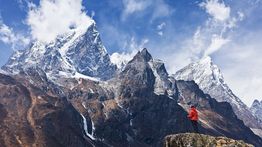
Trekking Seasons in Nepal
For every trekking season below we list the a... read more
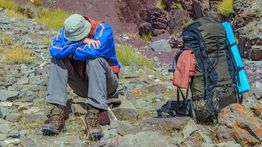
Altitude Illness while Trekking in Nepal
Altitude illness occurs due to changed pressu... read more
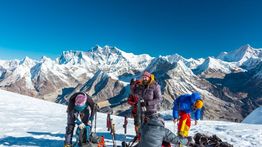
Health and Safety while Trekking, Including Altitude Sickness
Trekking is generally very rewarding and a on... read more
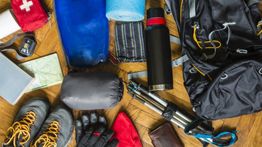
What to Pack for Trekking? Equipment Guide
In order to fully enjoy your trek in the Hima... read more
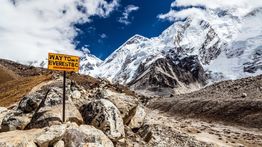
How to Get to Everest Base Camp
Nestled in the heart of the Himalayas, surrou... read more
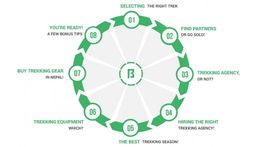
Trekking in Nepal Guide
Every year around 210,000 tourists spend thei... read more
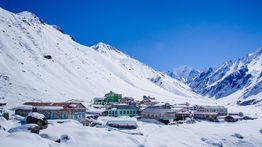
Top 6 Best Short Treks in Nepal - Snapshot Overview
If you’re thinking about visiting Nepal, this... read more
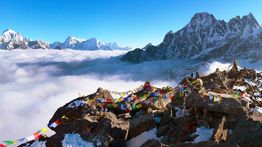
How Long Does an Everest Base Camp Trek Take?
A trek to Everest Base Camp has long been a ‘... read more
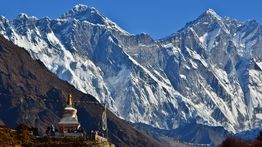
Everest Base Camp Trek in 14 Days: Our Recommendations
If you are planning to trek to the Everest Ba... read more
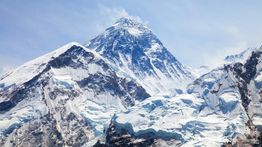
Short Everest Base Camp Trek: Top 3 Recommendations
The thought of the Everest Base Camp hike see... read more
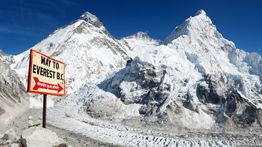
Best Time To Trek To Everest Base Camp
Everest Base Camp sits at an impressive heigh... read more
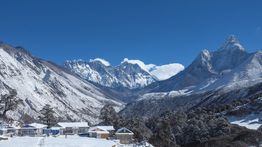
Everest Base Camp Trek in March
March is a transition period from winter to s... read more
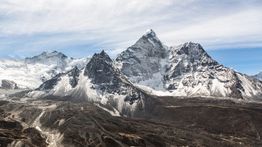
Everest Base Camp Trek in April
All things considered, April might be the bes... read more
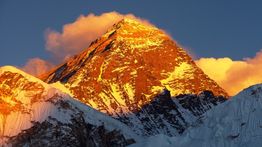
Everest Base Camp Trek in May
If you are planning to take on the Everest Ba... read more

Everest Base Camp Trek in October
October is one of the most popular months to ... read more

Everest Base Camp Trek in November
Most people do the Everest Base Camp hike in ... read more

How Much Does it Cost to Trek to Everest Base Camp?
The cost to hiking the Everest Base Camp depe... read more
Related Categories
- How Long To Stay In Nepal
- Nepal Travel Advice
- Trekking In Nepal
- What To Do In Nepal
- When To Visit Nepal
- Where To Go In Nepal
- Previous Post

- P Pasang Lama May 05 2020 REPLY Bookmundi is a biggest platform to get best holiday trekking trips around the world.
- M Marek Navrátil Feb 12 2019 REPLY Hi there, this is great website, very helpful, thank you for it. Please I have a question about tibetan buddhism in Nepal, can you recommend the best trek from there or others where I can meet the real tibetan buddhism?(that this feeling from the people is very strong and also there is some "non-commercial"monasteries, maybe with lamas)Thank you :)
- F Federico Jamine Oct 18 2018 REPLY Great information, thanks for posting, we appreciate it.
Popular Destinations
- Europe Tours
- Everest Base Camp Trek
- Italy Tours
- Spain Tours
- Argentina Tours
- Canada Tours
- Sri Lanka Tours
- Chile Tours
- Antarctica Tours

No recent searches!

Bookings are currently open for Himalayas during the 2024 / 25 season. Book Now
- Everest Base Camp Trek - 14 Days
- EBC Chola Pass and Gokyo Trek - 18 Days
- Everest Base Camp Short Trek - 12 Days
- Everest Base Camp Luxury Trek - 16 Days
- Luxury Everest View Trek - 8 Days
- Everest Panorama Trek - 9 Days
- Everest Three High Passes Trek - 22 Days
- Everest Base Camp Trek with Helicopter Return - 11 Days
- Everest Base Camp Trek for Seniors - 20 Days
- Everest View Trek - 7 Days
- Everest Helicopter Tour - 3 Hours
- Annapurna Base Camp Trek - 14 Days
- Annapurna Circuit Trek - 14 Days
- Mardi Himal Trek - 8 Days
- Jomsom Muktinath Trek - 13 Days
- Short Annapurna Base Camp Trek - 8 Days
- Annapurna Circuit Tilicho Lake Trek - 17 Days
- Annapurna Family Trek - 9 Days
- Annapurna Base Camp Heli Return Trek - 10 Days
- Annapurna Hot Spring Trek - 10 Days
- Annapurna Trek with Chitwan Tour - 9 Days
- Express Annapurna Base Camp Trek - 10 Days
- Langtang Valley Trek - 10 Days
- Bhairav Kunda Trek - 14 Days
- Helambu Trek - 8 Days
- Langtang Helicopter Tours - 3 hrs
- Langtang Gosainkunda Helambu Trek - 16 Days
- Tamang Heritage Trail - 10 Days
- Manaslu Circuit Trek - 14 Days
- Manaslu Tsum Valley Trek - 20 Days
- Tsum Valley Trek - 13 days
- Upper Mustang Trek - 16 Days
- Mustang Tiji Festival Trek - 18 Days
- Lower Mustang Trek - 14 Days
- Upper Dolpo Trek - 25 Days
- Rara Lake Trek - 16 Days
- Makalu Base Camp Trek - 21 days
- Pikey Peak Trek - 12 Days
- Lower Dolpo Trek - 18 Days
- Kanchenjunga Trek - 22 days
- Australian Camp Short Trek in Pokhara - 5 Days
- Nepal Adventure Tour - 12 Days
- Bhaktapur Patan Tour - 6 Hours
- Kathmandu Day Tour - 5 Hours
- Chitwan Jungle Safari Tour - 3 Days
- Kathmandu Nagarkot Sightseeing Tours - 4 Days
- Explore Nepal Tour - 10 Days
- Bardia National Park Tour - 4 Days
- Nepal Discover Tours - 11 Days
- Pisang Peak Climbing - 19 days
- Lobuche Peak Climbing - 18 Days
- Island Peak Climbing - 20 days
- Tharpu Chuli Peak Climbing - 0 days
- Naya Kanga Peak Climbing - 15 days
- Mera Peak Climbing - 19 Days
- Mera and Island Peak Climbing via Amphu Laptsa Pass - 23 days
- Nepal Tibet Bhutan Tours - 13 days
- Bhutan Experience Tour - 10 days
- Nepal Bhutan Darjeeling Tour - 14 days
- Glimpse Tours Bhutan - 8 days
- Chomolhari Trek - 0 days
- Laya Gasa Trek - 0 days
- Druk Path Trek - 0 days
- Simikot Kailash Lhasa Tour - 0 days
- Tibet Everest Base Camp Tour - 11 days
- Lhasa Sightseeing Tours - 1820 days
- Lhasa to Kathmandu Tours - 10 days
- Saga Dawa Festival Tours - 0 days
- Everest Advanced BC Trek - 20 days
- Travel Guide
- How to Book a Trip
- Why Escape Himalaya
- Terms and Conditions
- Legal Documents
- Nepal Tourist Visa Information
- Travel Insurance
- Equipment Checklist
- +977 9851006121
- [email protected]
- Nayabazar-16, Kathmandu, Nepal

Escape Himalaya - Himalaya Holiday Specialist more...
The Best Treks in Nepal - 12 epic hikes in the Himalayas!
Nepal is one of the top hiking destinations for the world's best treks. It is home to many highest Himalayas and multicultural ethos amid amazing unique terrains. Nepal's trapezoidal land is approximately 800 km long (East to West) and 200 km wide (North to South). Nepal's distinct topographical features embed a beautiful Himalayan ambiance with cultural riches.
Trekking in Nepal lets the trekkers enjoy every aspect of fantastic destinations. Indeed there are various adventure choices, whether challenging journeys or beginner-friendly trips. However, it has a lot to offer in trekking to the Himalayas. In this article, we shall discuss the best treks in Nepal.
September to November is the autumn season in Nepal. During this time, the sky is clear, and days are warm. Thousands of trekkers opt for trekking in Nepal during this time of the year due to the most favorable weather conditions.
In the same way, the spring season, which falls from March to May, is another peak season for trekking in Nepal. The weather is warm as it invites the summer season simultaneously. In this season, flowers fully bloom, and trails are green. In general, it offers spectacular weather to view the mountains.
The winter season in Nepal lasts from December to February. During winter most of the high-altitude trekking is not possible due to extremely cold weather and heavy snow covering most of the trail. Some trekkers also engage in winter hiking to accessible destinations as the views are most beautiful when snow covers the trail. Enough preparation is a success key to any winter hike in Nepal.
From June to August, we experience the monsoon season in Nepal. The monsoon rain brings landslides, which increase the chances of blocking roads and trails. Also, the clouds obscure mountain views and nobody wants to do the long walking while it's raining. Even though monsoon seems to be the worst season for trekking, certain rain-shadowed areas of Annapurna and Dhaulagiri Himalayas in the north of Nepal let travelers explore the magical semi-arid regions.
Everest Base Camp Trek, the world's best trek
The trail to Everest base camp is the most popular trekking route in Nepal. It takes trekkers to the beautiful Khumbu region, home to the mighty Mount Everest. Hiking to Everest's base camp is a great way to experience Sherpa culture and watch the breathtaking Everest Peak. The trekking journey meanders through the Dudh Koshi and Imja River Valleys.
In contrast, it includes many popular destinations like Namche Bazaar, Tengboche, Dingboche, and Gorakshep. The Kalapatthar's magisterial beauty shows the panoramic beauty of the majestic Mt. Everest. A journey to the base camp takes travelers hiking through Sagarmatha National Park- a UNESCO Natural World Heritage Site. Likewise, the trail follows the Dudh Koshi River and alpine forests to the glacial valley of Gorakshep holds incredible sights of the Everest Himalayas. There are skylining peaks like beautiful Ama Dablam, Lhotse, Nuptse, Khumbutse, Kongdi Ri, Kusum Kanguru, Thamserku, and many more.
Furthermore, the terrain consists of alpine woodlands and emerald pastures that trekkers go through. Along the way, trekkers can see rich Sherpa Buddhist cultural practices. Their culture weaves its threads into the landscape in the form of monasteries, Gumbas, and Mani stone walls. They are all carved with Buddhist prayers mounted with prayer flags. Many more distinctive attributes make the EBC Trek one of the best treks in Nepal.
- Annapurna Base Camp Trek
The Annapurna Base Camp Trek is amongst Nepal's most visited trekking adventures. It is a journey that is both naturally uplifting and culturally diverse. The trek lets trekkers go through many ethnic Rai and Limbu villages of the Annapurna region. Annapurna Massif ( I, II, III), Machhapuchhre, Dhaulagiri, and Gangapurna majestically tower over the trail for the company throughout the trip. Moreover, one particular highlight of the Annapurna base camp trek is its natural features.
The journey goes through the most diverse region of Nepal. It presents trekkers with mesmerizing acreages of thick chartreuse woodlands and forests. Trekkers get to catch rare glimpses of wildlife like Himalayan Monal and Musk Deer as they hike ahead. Another unique hallmark of the Annapurna Base Camp Trek is Pokhara City- the tourist hub of Nepal. Pokhara is where the trekking journey starts. Pokhara is a lovely city near the Annapurna Himalayas with pristine Phewa Lake. Trekkers can hike to Poon Hill to view Mt. Annapurna and Dhaulagiri in full bloom.
Everest Base Camp Trek with Cho La Pass
The Everest Base Camp Trek with Cho La Pass is one of Nepal's most challenging journeys. This hike stands out among the best treks in Nepal by crossing the renowned mountain pass. The initial journey of the adventure is quite similar to the typical EBC Trek. Still, the latter half of the trip includes a steep climb toward Cho La Pass.
One requires good agility as it involves a strenuous hike up and down the mountain terrains. Prior trekking experience will be a great help while doing this trek. However, the extra effort is worth the trouble. The panoramic views of the Dudh Koshi and Imja Khola valleys from the top of these passes are mesmerizing. The Chola Pass seems to lie above the clouds, feeling like heaven with incredibly hypnotic views. The cloud-laden acreage with views of Everest peaks rises like ivory serrations in the skies. There is nothing quite like it in the world!
- Gokyo Lake Trek
The Gokyo Lake Trek is among Nepal's best treks because it involves visiting the Everest region's sapphire Himalayan lake of Gokyo. The pilgrims from all over the country come here to celebrate the Janai Poornima festival at the holy lakes. The trekking journey traverses the Khumbu's river valleys to the Himalayan Lake. The hike to Gokyo Ri represents some of the best mountain views with the azure lakes of Gokyo Valley.
The Gokyo Lakes also hold religious significance to the Hindu people. As per Hindu mythology, it was an abode of the Nagas- Snake Gods. They used to live in the Himalayan turquoise water. It is best to visit during the autumn and spring as the lake tends to freeze over during the winter. Moreover, the trek also involves visiting the vantage point of Gokyo Ri, which presents a fantastic view of Everest and its flanking Himalayan peaks.
Annapurna Circuit Trek, the best of classic treks in Nepal
The Annapurna Circuit Trek is one of the best classic treks of Nepal. The journey lets trekkers circumambulate the Annapurna range and important Kali Gandaki River Valley destinations. The journey is an exemplary adventure, including crossing Thorong La Pass (5,416m), the highest mountain pass in the world.
Further, phenomenal peaks like the Annapurna (I, II, III), Gangapurna, Machhapuchhre, Dhaulagiri, and Manaslu give impressive company along the trail. Trekkers make their way through the beautiful Marshyangdi Valley, experiencing the ethnic Limbu and Chhetri culture of local people. The trek is stunning, from beautiful paddy fields, subtropical frets, waterfalls, and gigantic cliffs flanking the gorges and villages. That is why it is almost always mentioned while discussing Nepal's best scenic treks.
The Annapurna Circuit presents a cornucopia of climatic variations and diverse terrains with distinct cultural ethos. Hindu villages lie in the lower Himalayan foothills, while Tibetan culture dominates in the Manang and Mustang valleys. Trek also goes across the Annapurna Sanctuary, which presents some of Nepal's most magical natural terrains.
Langtang Valley Trek with Gosainkunda
The Langtang Valley Trek with Gosainkunda is one of the relatively obscure trekking adventures in the country. The Langtang Valley trekking trail is 20km from Kathmandu, near the Tibetan border. The journey is an unforgettable hike in one of the most captivating landscapes ever, Langtang - a glacier valley.
The Langtang Valley presents trekkers with thrilling views of the Langtang Himalayas alongside the alpine villages of Rasuwa. The valley's many glacial lakes have made it one of the best regions for flourishing wildlife. Likewise, visitors can enjoy hiking through the landscape ornamented with jade-green woods, vast open pastures and Himalayan meadows. Besides, the trek includes visiting Kyanjin Gompa and the local Cheese Factory producing yak milk cheese.
In addition, the trekking journey also includes visiting the revered Gosainkunda Lake. A holy Gosainkunda lake holds a special place in Hindu and Buddhist mythos. The hike goes via Langtang National Park to the country's ethereal freshwater lake with the distinct lake-side natural biosphere.
According to Hindu legend, Lord Shiva struck his trident into a Himalayan side, which caused lake formation. He drank water to quench his thirst by swallowing a poison that threatened to destroy the world. Travelers get company by dazzling Langtang and Ganesh Himal views throughout their journey.
- Manaslu Circuit Trek
One of the spell-bounding off-beaten-path journeys, the trek to Manaslu , is a perfect option for trekkers looking for an isolated journey with fewer crowds. The trail passes through the Manaslu Conservation Area, the natural habitat for many endangered Himalayan flora and fauna species.
The journey to Manaslu involves visiting the hidden gem of Nepal – Manaslu. Indeed, the trekkers can experience the region's distinct cultural features unique to others. The people have their customs and speak a dialect not found anywhere else. Trekking in the Manaslu region started just in 2008. The area fosters striking Manaslu Range, Ganesh Himal, Shringi Himal, and the Baudha Himal Range.
However, the Manaslu Circuit expedition presents rich natural beauty and cultural penchant. Having a long history of Buddhism, the Manaslu Circuit Trek offers trekkers culturally distinct remnants of an ancient kingdom whose attributes are still alive today. People believe that the Buddhist Saint Milarepa meditated in the caves of Mt. Manaslu, which gives the trekking journey a serene spiritual ambiance.
- Makalu Base Camp Trek
The Makalu Base Camp Trek is a coruscating journey through the enchanting Makalu Barun Valley of Nepal's Sankhuwasabha district to the base camp of the Makalu Peak- the 5th highest mountain peak. It is among the best Nepal treks because of its unparalleled natural beauty and pulchritude.
The trekking journey also presents traversing through one of the seven Beyuls of the Himalayas. According to Buddhist legends, "Beyuls" are mystical evergreen places where people do not age. It is said that life will only prevail in those seven places of the world in times of global destruction. One of them is mentioned to be somewhere in the Makalu Barun region. The valley's biodiversity offers visitors tremendously varied flora and fauna while trekking.
- Kanchenjunga Base Camp Trek
Kanchenjunga Base Camp Trek is one of the best off-beaten-paths treks in a remote area of the Nepal-India border. The trip presents majestic Kanchenjunga (8,586m)- the third-highest peak. Indeed, the Kanchenjunga Valley is a daring acreage that has not yet seen modernization changes.
Regardless, the trek perfectly combines natural wonders and a rustic cultural tenor. It is an authentic trekking experience through the Tamur River Valley in Nepal's Taplejung District. The peak also holds a special place in Buddhist legends as per their scriptures. Kanchenjunga , meaning 'The Five Treasures of The High Snow,' is derived from the Tibetan word. The treasures comprise salt, gold, turquoise, precious stones, sacred scriptures, invincible armor or ammunition, grain, and medicine. Trekkers pass through perplexing natural terrains of the Kanchenjunga Conservation Area.
- Mardi Himal Trek
Steadily gaining popularity and mass appeal in recent years, the Mardi Himal Trek is one of the unknown trekking journeys in the Annapurna region. Limited trekkers access it in a short time. The trek presents homely villages with traditional houses flaunting the Annapurna Peaks and the Mardi Himal as their backdrop.
Trek to Mardi Himal is a diverse hike with quaint cultural features and alpine woodlands. The local people still follow the old way of life. In summer, they take their cattle to graze in Himalayan pastures and do terrace wheat and barley farms.
The journey starts from the tourist hub of Nepal- Pokhara City. Similarly, it follows the path toward prominent destinations like the region's High and Low campgrounds.
Upper Mustang Trek
Upper Mustang Trek allows you to enjoy trekking even in the monsoon seasons. The Upper Mustang region lies in the Annapurna and Dhaulagiri peaks' rain-shadow zone, which experiences significantly less rainfall.
Generally, the geography has an arid desert-like environment that presents some incredible rock formations. It is among the best treks in Nepal because it has a lot to offer its visitors. It is a journey to the Kingdom of Lo, practicing Tibetan-Buddhist culture unique from other parts of Nepal. Upper Mustang is one of the last places on Earth to experience intricate layers of Tibetan Buddhism that have been unchanged for centuries.
Moreover, the trek presents spellbinding hallmarks like the Lo Manthang settlement- the capital of Upper Mustang. The prominent monasteries hold secret scriptures, statues of Buddhist deities, and priceless Thanka paintings. Archeologists discovered many mysterious sky caves over the terrains with decadent high cliffs in National Geographic.
- Annapurna Panorama Trek
The Annapurna Panorama Trek is one of the best options for people looking for a trekking journey in the lowlands of the Annapurna region. It is best for people who do not necessarily want to undergo an extensive trekking journey to experience the Himalayas.
Furthermore, the Annapurna Panorama Trek presents panoramic views of the magnificent Annapurna Mountains from the vantage point of Poon Hill. Usually, the trek to Poon Hill from Ghorepani is done early in the morning. The hike before dawn offers a magical moment of the rising sun amidst the striking Annapurna and Dhaulagiri ranges.
Indeed, the glorious sunrise and sunset are phenomenal to watch from Poonhill.
Need Help Organizing A Trip In Nepal?
If you have queries and looking forward to planning a Nepal trip, please don't hesitate to contact us . We assure prompt responses to all your inquiries and help plan an exceptional journey around the Himalayas as preferred.
- Annapurna Circuit Trek
- best treks in Nepal
- Everest Base Camp Chola Pass Trek
- Everest Base Camp Trek
- Langtang Valley Trek
- trekking in Nepal
- Treks in Nepal
- treks to Nepal
- Upper Mustang trek
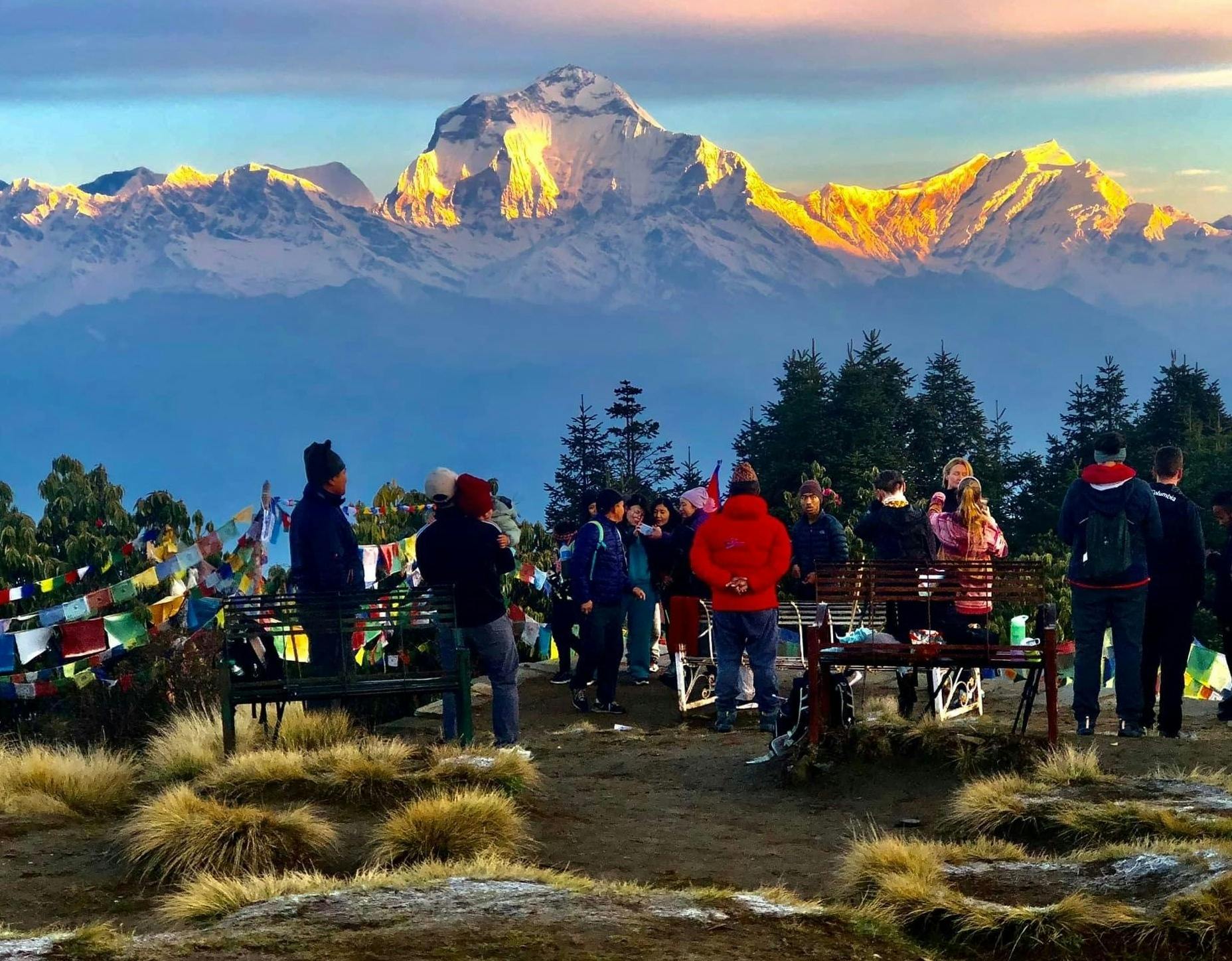
Send Inquiry


10 Best Treks in Nepal
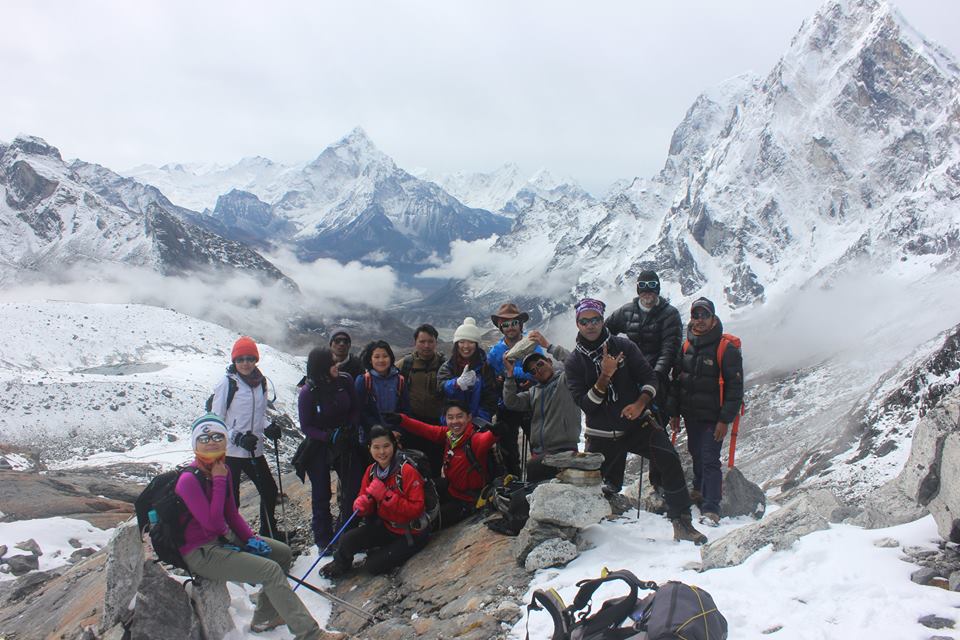
Nepal- a landlocked country in south Asia- ensconced in the heart of towering Himalayas , represents an exquisite blend of natural beauty and cultural heritages. Trekking in this beautiful country presents a one-of- a-kind of adventure that you’ve never been to before. Nepal offers a plethora of awe-inspiring and mind blowing trekking destinations, each characterized by its own panoramic landscape, unique culture experiences and challenges. So, here are the 10 Best Treks in Nepal that you should be ready to explore this year:
- Annapurna Base Camp Trek: Also referred to as ABC trek, the Annapurna Base Camp Trek is an iconic trekking trail in Nepal, renowned for its breathtaking beauty and mountainous landscapes. The adventurous journey of ABC trek starts from the beautiful city of Pokhara, accessible either by a flight from Kathmandu along with a two-hour drive to Nayapul or an eight hour long drive from Kathmandu to Nayapul. This trek typically takes around 15-20 days, covering a distance of 160-230 kilometers (approx), based on the route chosen. The best seasons to visit ABC trek are either during spring (March to May) when rhododendrons bloom or during autumn (late September to early December) with clear skies and pleasant temperature. The temperature on the trek usually decreases upto 17-20 degree celsius. However, the weather remains unpredictable because of the increasing altitude. The average height of the trial peaks upto 4130 meters, providing an opportunity for the trekkers to trek through the beautiful sceneries of Chomrong Village, Poon Hill, Deurali, Machhapuchre Base Camp, Tadapani, and rejuvenate and cleanse themselves in a natural hot spring in Jhinu Dada and Tatopani. Accommodation during this trek typically include tea houses and lodges where the trekkers can peek into the typical gurung and magar culture of Nepali villages and connect with fellow travelers on the way. ABC trek is considered as a moderately difficult trek, offering the trekkers with a beautiful scenery of towering peaks of Annapurna I, Machapuchre, and Hinchuli and cultural richness.
- Upper Mustang Trek: The Upper Mustang Trek is one of the popular trekking trails in Nepal guiding to the forbidden kingdom of Nepal. The Upper Mustang Trek commences from Kagbeni, jomsom which is accessible by two connecting flights from Kathmandu to Pokhara and then from Pokhara to Jomsom. Covering a distance of about 160-170 kilometers based on the chosen route and travel itinerary, it usually takes 12-18 days for this entire enthralling and adventurous trek. Elevated upto a maximum altitude of 3800 meters (approx), this trek usually culminates in Lo Manthang-the capital of Upper Mustang-which surrounds the mystery of forbidden kingdom. The trekkers can enjoy the breathtaking views of the sky-scaring mountain peaks like fishtail Annapurna South, Annapurna II, Dhaulagiri, Dhaulagiri II, Nilgiri and Damodar. The best season for this trek is spring and fall. Tiji festival-a 3 day fascinating festival, usually celebrated in the month of April or May amongst the Tibetan people-is a must see for the trekkers. Thakali, Gurungs and Tibetans are the local residents of lower and upper Mustang Area. Trekkers can reside in tea houses and lodges where they are provided with basic yet comfortable stay and authentic Nepali cuisines. It is advisable for the trekkers to try some local cuisines like Tibetan bread, Khapse, Marpha, Local tea, etc. The dazzling architecture of Lo Manthang, the Shaligrams of Kaligandaki river, and a pony ride are a must do for the trekkers for a fun experience along their trek.
- Lantang Valley Trek: The Lantang Valley Trek is considered as one of the best treks in Nepal, commences from Syabru Besi, easily accessible by a 9 hours of long drive to the north of Kathmandu valley. Depending upon the specific itinerary and trekker’s pace, this trek can be completed in 7 to 9 days covering a distance of approximately 80-90 kilometers. The altitude in this trek gradually increases upto the maximum height of 4,600 meters above sea level which is the Kyanjin Ri Hill. This trek offers the breathtaking views of mountain peaks like Lantang Lirung, Gang Chhenpo, Dorje Lakpa and Ganesh Himal along with the traditional tamang villages and their cultures and beautiful monasteries and traditionally built stone houses. Along the way, there are guest houses—also referred to as tea houses—where hikers can stay comfortably and eat hot meals. The meals typically include thakali cuisine like dhido and gundruk, sel roti, yak cheese, and nepalese curd called yum, thukpa along with other nepali cuisines. The best time for the Lantang Valley Trek is during the spring and fall when the weather is stable.
- Everest Base Camp Trek: The thrilling Everest Base Camp trip, sometimes referred to as the EBC trip, takes participants to the base of Mount Everest, the highest peak in the world. The exciting helicopter ride to Tenzing-Hillary airport, one of the world’s most dangerous and high-altitude airports, begins the exciting EBC trek adventure in the Lukla village in the Khumbu district of Nepal. The 35-minute helicopter ride provides breathtaking views of the surrounding mountainous landscape. The EBC trek is regarded as one of the more difficult treks, taking 10 to 15 days to complete and spanning 130 miles, depending on the route and level of physical ability. March through May or mid-September through November are the ideal times to visit the EBC Trek. During the EBC trip, the elevation progressively rises, with hikers reaching a maximum elevation of 5,364 meters. Trekkers must therefore take the necessary pauses in Namche Bazaar, Dinboche, and Gorak Shep in order for their bodies to acclimate to the rising altitude and stay in good health throughout the entire journey. These rest periods give the hikers the chance to see a Sherpa village, learn about their customs, and visit stunning monasteries along the way. During these vacations, lodging options often consist of lodges and tea houses that provide delicious meals and a cozy stay. Along the way, you should sample Nepali delicacies like momos (dumplings), tsampa (roasted barley flour), and dal bhat tarkari (lentils, rice, and vegetables). Important locations on the journey include the Tengboche Monastery, a center of spirituality.
- Manasalu Circuit Trek: The Manasalu Circuit Trek takes place in the Manasalu Conservation Area, renowned for its stunning landscapes , diverse culture and challenging trials. This trek begins from Soti Khola which is an 8 hour drive from Kathmandu valley. It takes around 13-18 days for the trekkers to complete this trek, covering up a distance of about 117 kilometers. Larkya La Pass-which is at the altitude of 5160 meters-is the highest point on this trek. This trekking traill winds through the remote villages inhabited by the diverse ethnic groups of Gurungs, Tamangs and Tibetan-influenced communities, providing an opprtunity to peek into their unique cultures, traditions and ancient monasteries. This trek encircles Mt. Manasalu, the eight highest peak in the world. During this trek, trekkers can enjoy the glorious and awe inspiring mountain panoramasm like Himlung Himal, Hiunchuli, Ngadi, Cheo Himal, Kanguru, Siringi, Ganesh Himal and Annapurna II. Trekkers can stay in tea houses and lodges where they can enjoy a comfortable sleep along with authentic Nepali delicacies like dal bhat tarkari. The manasalu trek is one of the challenging and less trodden path amongst the trekking trials in Nepal. Spring and autumn are considered to be the best seasons for this trek.
- Gokyo Lake Trek: Gokyo Lake Trek is considered to be one of the best treks in Nepal, leading trekkers to the home of glacial lakes-Gokyo Valley. The Gokyo Lake Trek, situated in the Everest region of Nepal, within the Sagarmatha National Park, commences from Lukla, accessible by a 30 minutes flight from Kathmandu Valley. This trek usually takes around 12 days to complete, covering a distance of 92 kilometers. Gokyo Ri is the highest peak in this trekking trail-elevated at the altitude of 5,357 meters- provides a spectacular view of Everest, Makalu, Lhotse and Cho Oyu. Trekkers are provided with a cozy stay at tea houses and lodges, offering Nepali dishes like dal bhat tarkari, where trekkers can engage with the friendly Sherpa and ethnic commuinties. The ideal trekking seasons for this trek are spring (March to May) and autumn (September to November). One of the key highlights of this trek include Nozumpa Glacier which is the largest glacier in the himalayas. The Gokyo Lake Trek is a challenging trek that can be substituted for the standard Everest Base Camp trek.
- Upper Dolpo Trek: The Upper Dolpo Trek is one of the remote and one of the most challenging trekking adventures located in the Dolpa District of Nepal. The trek usually begins with a flight from Kathmandu to Nepalgunj, followed by a short flight to Jhupal. This trek approximately covers a distance of approximately 10 to 12 kilometers and can be completed within 8-27 days based on the travel itinerary. The key highlight of Upper Dolpo Trek includes crossing the challenging passes of Kang La Pass which is elevated at a height of 5,151 meters and the Numa La Pass at an altitude of 5,190 meters. These passes offer the breathtaking views of the towering peaks of world-renowned 8000-meter mountain Dhaulagiri and Annapurna, dolpo peak, Mt. Kanjirowa, Mt. Putha Hiuchuli peak, Chureni Himal, Guraj Himal, and many more. The accommodations during this trek are limited due to the remote and isolated nature of the region with trekkers relying on their own camping gear including tents, sleeping bags and cooking equipment. The best time to undertake the Upper Dolpo Trek is during the spring (March to May) and autumn (September to November) seasons.
- Mardi Himal Trek: The Mardi Himal Trek is a compelling and relatively unknown trekking route in the Annapurna region of Nepal, which normally starts from the picturesque city of Pokhara where the trekkers drive to Kande to begin their exciting journey. It takes about 5-12 days to complete this trek based on the chosen route and travel itinerary. At an elevation of about 4,500 meters, the Mardi Himal Base Camp is the highest point reached during the Mardi Himal Trek. Trekking up Annapurna Himal, Dhaulagiri Himal, Manaslu Himal, and other nearby summits in the region provides breathtaking vistas of pristine landscapes and mountain ranges. Trekkers are likely to encounter friendly Gurung and Magar Communities along the trial offering an insight into their culture and traditions. Trekkers will find tea houses and lodges, providing a basic and comfortable facility for night stays along the route and can enjoy Nepali cuisines like dal bhat tarkari. Spring and autumn seasons are preferred for this trek when the weather is mostly stable, with clear skies and moderate temperatures.
- Kanchenjunga Base Camp Trek: The Kanchenjunga Base Camp Trek is an extraordinary and challenging adventure, leading trekkers to the base of Mount Kanchanjunga, the world’s third highest peak. The trek usually begins with a flight from Kathmandu to Biratnagar, followed by a drive to Taplejung. It usually takes 16-30 days for this trek, covering a distance of 220 km based on the chosen route and travel itinerary. Pangpema viewpoint, elevated at the altitude of 5,143 meters, is the highest point of this trek. This trek takes the travellers through the Kanchanjungha Conservation Area along with the panoramic view of towering peak of Mt.Kumbhakarna, Kanchenjunga I, Kanchenjunga II, Kanchenjunga south, Kiratchuli, Pathivara Chuli and many other peaks. The Kanchenjunga region is inhabited by a mixed community of Sherpa, Rai, Limbu, and Gurung, which provides an opportunity for trekkers to understand their culture and lifestyle. The accommodations provided along the trail are simple, with shared rooms, basic facilities of bed, blankets and hot meals which include typical nepali dishes dal bhat and tarkari, momos and noodles. The preferred seasons for this trek are considered to be the spring (March to May) and autumn (September to November) seasons, when the weather is relatively stable, offering clear views of the mountains and comfortable trekking conditions.
- Ghorepani Poonhill Trek: The Ghorepani Poonhill Trek is a popular and relatively easy trekking route in the Annapurna region in Nepal which takes about 4 to 5 days to complete, covering a distance of about 35 to 40 kilometers depending on the specific route taken. The trek usually starts from Nayapul, which is easily accessible by a drive from Pokhara. The highlight of the Ghorepani Poon Hill Trek is reaching Poon Hill, located at an altitude of approximately 3,210 meters (10,532 feet). Poon Hill is renowned for its stunning sunrise views over the Annapurna and Dhaulagiri mountain ranges and the scenic views of mountain peaks such as the Annapurna I, Annapurna South, Machhapuchhre (Fishtail), and Dhaulagiri. The route passes through picturesque settlements like Tikhedhunga, Ulleri, and Ghorepani where trekkers can witness the traditional lifestyle of the local friendly Gurung communities.Trekkers can enjoy comfortable accommodations in teahouses, enjoy local cuisines and immerse themselves into the traditional gurung culture. Spring (March to May) and autumn (September to November) are considered to be the best seasons for this trek.
Associated With

WE ACCEPT CARDS

10 Best Treks in Nepal – The Ultimate Guide for Trekking in Nepal
Nepal is famous for adventure and trekking.
The terrain of the Nepalese Himalayas offers various stunning trekking routes. It is rather unfair to name one as the best trek in Nepal. As, these routes are different and best on their own way.
You can find the best treks that suits you by looking at the features offered by those treks.
The best trek for one depends on his/her choice of difficulty. Also, number of days you spend for treks. The budget and trek style also plays role in shaping your treks. Here, we have listed down the ten best treks in Nepal based on popularity, scenery, culture, and price.
Find out which treks in Nepal is the best for you and meets your preferences
Bonus Content: Download checklist for Everest Base Camp Trek/Trekking in Nepal
Table of Content
1. Everest Base Camp Trek
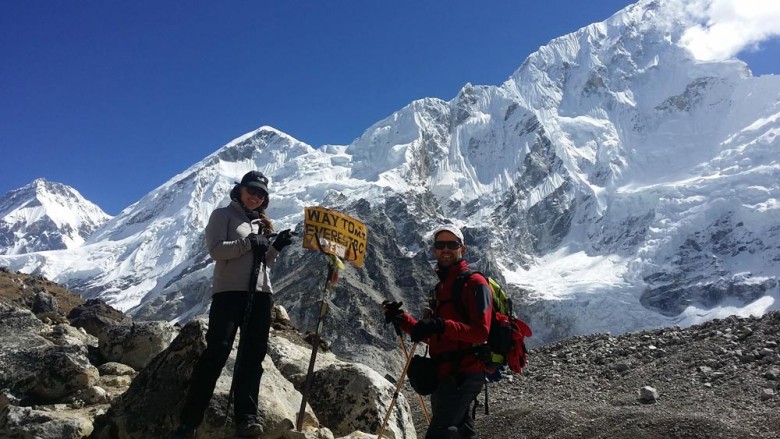
The Everest Base Camp Trek is the best option for those looking to relish the spectacular close up views of the world’s highest mountains. This trek offers you a chance to explore the Sherpa villages and their lifestyles. This is one of the best treks in Nepal and offers an exclusive trekking experience.
Reaching the summit of the world’s highest Mountain, Mount Everest may be the pinnacle of all the adventures. But, walking to the base camp of Mount Everest is no less adventurous.
In this trek, you experience the glorious walk on the footprints of legendary mountaineers. En route you pass through beautiful High Passes and roaring Dudhkoshi River. Along with renowned Namche bazaar, serene Imjatse valley and several Buddhist Monasteries on the trail.
Planning trip to Nepal and need help?
Tell us about your trip to Nepal and what you expect from it. We will answer your questions in 24 hours and help you design a trip with a comfortable itinerary to best meet your needs.
- Solo Traveler
- Number of Adults *
- Number of Children *
- Age of children at time of trip *
- I have my exact travel dates
- I have approximate dates
- I don't have my dates yet
- Travel Start Date * MM slash DD slash YYYY
- Travel End Date * MM slash DD slash YYYY
- Month of departure * Choose Month December 2020 January 2021 February 2021 March 2021 April 2021 May 2021 June 2021 July 2021 August 2021 September 2021 October 2021 November 2021 December 2021
- Approximate Duration * Less than a week 1 week 2 weeks 3 weeks More than 3 weeks
- Full Name *
- Give your trip a short title * A short descriptive headline that describes what you're looking for.
- Describe your trip *
2. Annapurna Circuit Trek
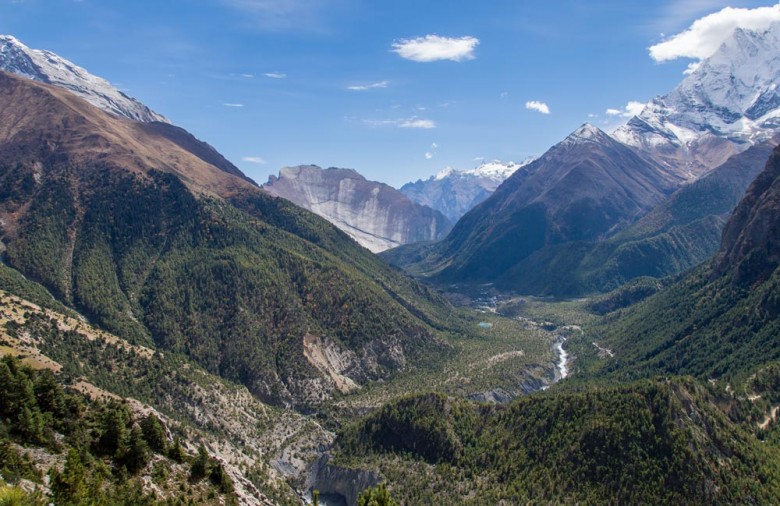
Annapurna Circuit is one of the most famous trekking routes in Nepal. The trail traverses a variety of terrain in the Annapurna region. And explore the rich cultural and natural diversity. The trek offers an amazing view of the Annapurnas, Macchupucchre, Dhaulagiri, Manaslu and Langtang Himal.
Despite the issues on road construction, Annapurna Circuit Trek is still one of Nepal’s greatest treks. The trek offers ample of cultural and natural beauty to awe-inspire any visitors in the region.
The trail allows a gentler acclimatization as you traverse the variety of landscapes. From jungle to high alpine, lush valley and up to arid peaks. Along the trail, you pass through hospitable villages and the world’s deepest gorge.
3. Manaslu Circuit Trek
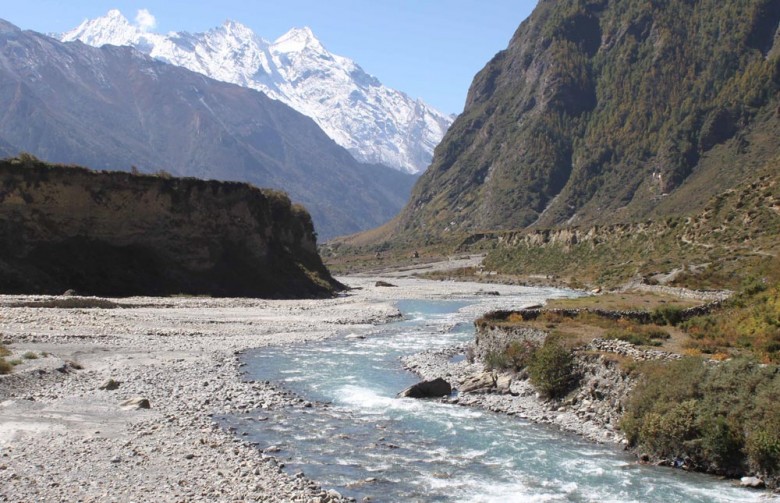
The Manaslu Circuit Trek is a remarkable trek flaunting amazing panoramas of the peaks on the Nepal-Tibet border. The trek goes around the stunning Mount Manaslu, the 8th highest mountain in the world. In this trek you reach the highest at Larkya Pass along with other challenging Mountain Passes. The trail traverses Hindu and Tibetan-style villages. And, diverse cultures of ancient Buddhist monasteries. Manaslu Circuit trekking route is diverse, remote, secluded and enriched topography. It offers a fabulous experience for those looking for an adventurous journey. And wish to explore the scenic beauty of the Himalayan region. No wonder, the trail is among the best treks in Nepal.
Restrictions:
This trek demands an at least two trekkers accompanied by a Nepali guide or Porter. And, a restricted area permits to trek. So, make sure you have a Trekking Partner or a trekking agency for the trek.
4. Ghorepani Poon Hill Trekking
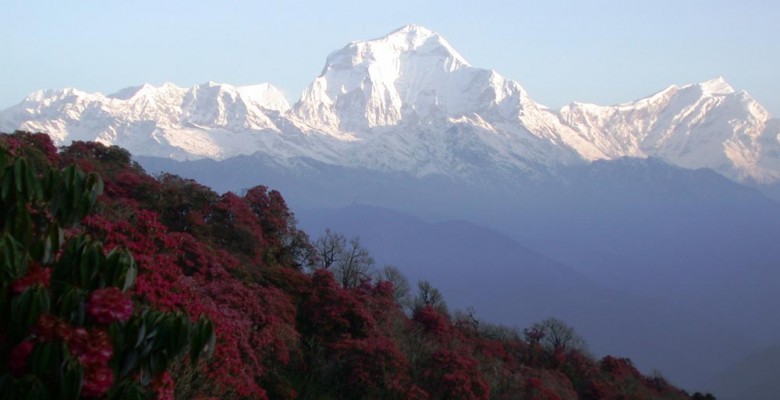
Ghorepani Poon Hill Trek is much easy and short trekking. In this trek, you walk along the terraced farmlands. Along with the beautiful rhododendron forest and hospitable Gurung Villages. The trek is quite beautiful during the spring when the rhododendron forest is in bloom. Plus, the panorama of the high mountains on the vista is no less alluring. The spectacular sunrise view over the Annapurna range is the highlight of the trek. This is the best trek in Nepal to explore the beauty of the Annapurna Region in a short period of time.
5. Langtang Valley Trek
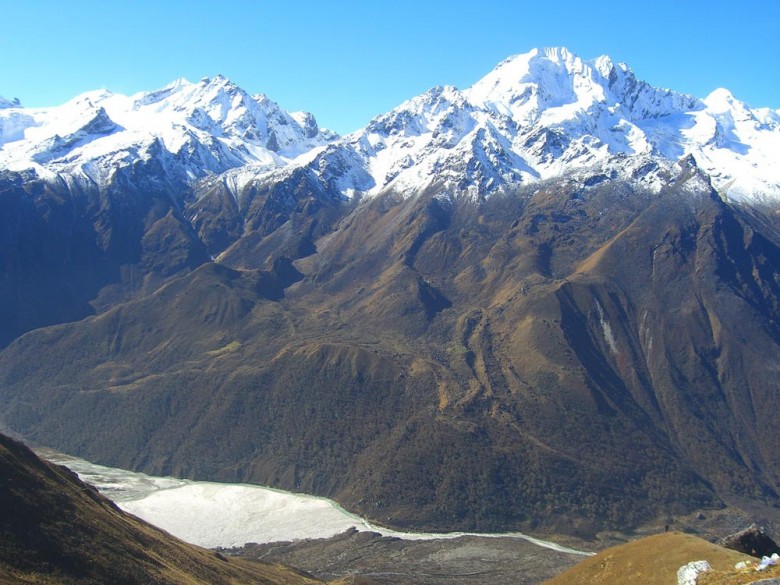
The Langtang Valley Trek is popular for its diverse vegetation and cultured villages. The trek offers a great vantage point of Langtang Ri and views of the Annapurnas and Makalu. Despite the proximity to Kathmandu, the region is as wild as any other Tibetan highlands. Surrounded with tranquil rural landscape. The trek offers exposure to the unique Tamang culture and a chance to walk past the beautiful glaciers at a quite low altitude. The Langtang valley offers the stunning view mountain panorama. The trek is an ideal option for the one. Are you looking to explore the rich Tamang culture, beautiful landscape and vegetation? This is the trek for you.
6. Upper Mustang
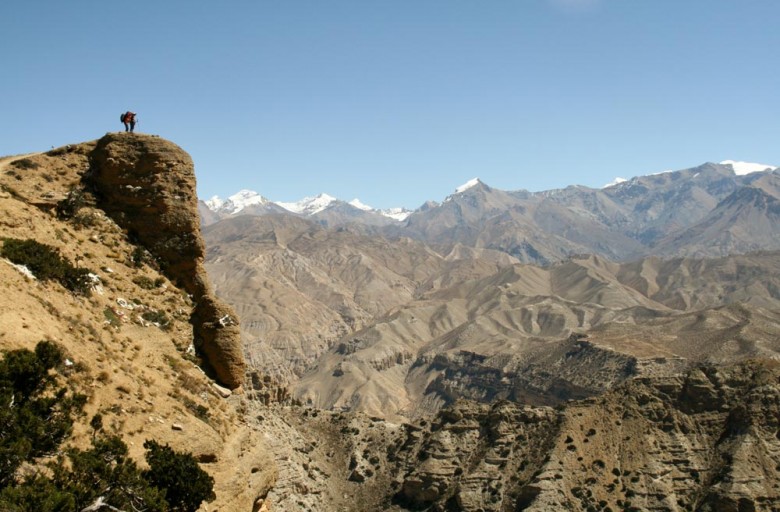
Upper Mustang is a culturally and geo-politically sensitive area and wasn’t open for trekking until 1992. The culture and landscape of the region is close to that of Tibet. Due to the isolation from the world, the region is able to maintain its centuries old culture and landscape. The 16th century Buddhist monasteries and the caves carved into sheer cliff walls in mustang draws many trekkers to the region. Mustang has a striking terrain of a semi-arid desert with deep ravines and rock shelves, fringed with snowy peaks. Hidden behind the majestic Himalayan ranges, Mustang is a hidden paradise in Nepal. This is a must trek for the one yearning to explore the fascinating landscape and the rich Tibetan culture.
Restrictions
This trek requires at least two trekkers accompanied by a Nepali guide or Porter. Along with a restricted area permit make sure you have a trekking partner or a trekking agency for the trek.
7. Kanchenjunga Base Camp Trek
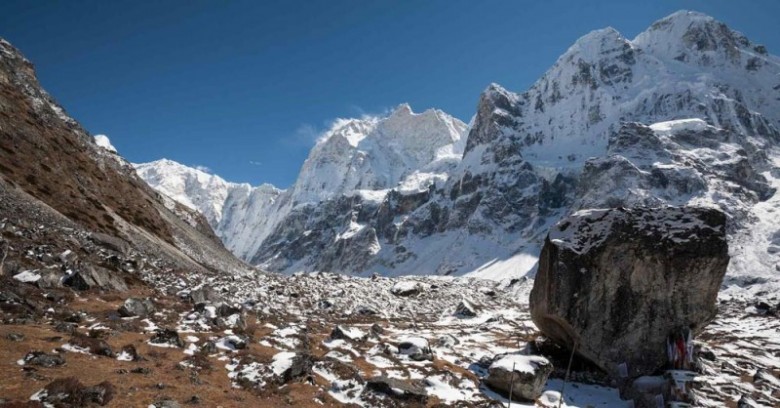
This is a journey to the Camp of the world’s second highest peak, Mount Kanchenjunga. In this trek you explore the culture and natural beauty of the eastern Nepal . The journey takes place in the wild high-mountain terrain, deep into the secluded mountain ranges on Nepal’s border with Sikkim and Tibet. The region is the home to some of the Asia’s most exotic wildlife. The trek allows exposure to the unspoiled local culture and wonderful nature making it the rewarding adventure.
This trek requires at least two trekkers accompanied by a Nepali guide or Porter. Along with a restricted area permit make sure you have a trekking partner or a trekking agency for the trek to Kanchenjunga Base Camp .
8. Annapurna Base Camp Trek
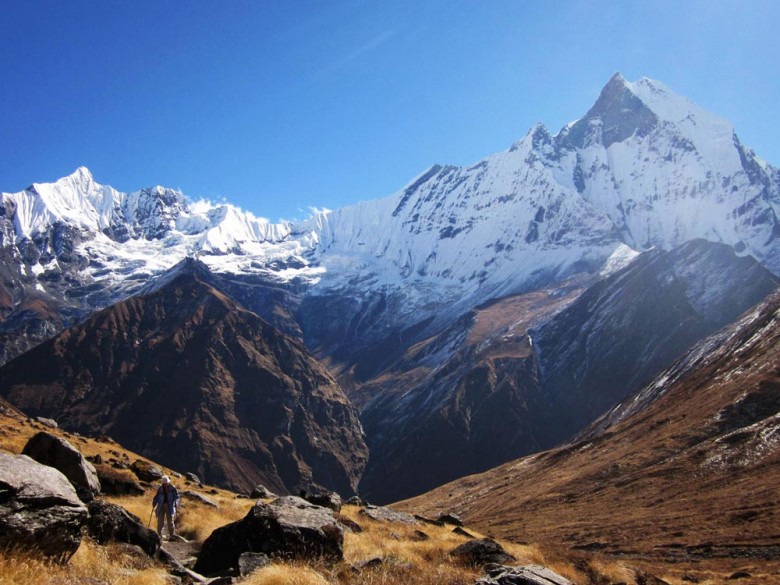
Wandering through the beautiful hills, the Annapurna Base Camp Trek takes you to the base of Mount Annapurna. The trail passes through hospitable villages and picturesque valleys . The trek combines different landscapes and brings the trekkers so close to the base of peaks above 8,000 m in a short period of time. The trek is the perfect blend of superb natural scenery and rich cultural diversity of Annapurna region. Trekking to Annapurna Base Camp is a spectacular, breathtaking walk that rewards trekkers in many ways.
9. Gokyo Ri Trek
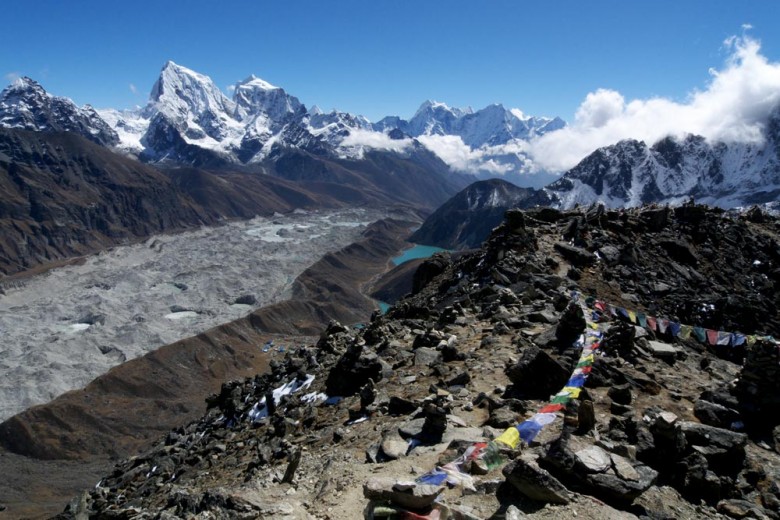
With its alluring side glens, turquoise lakes, the country’s biggest glacier and an arc of snow mountains, the Gokyo valley is the most attractive region in the Khumbu. The Gokyo Ri Trek is a scenic trek to the Gokyo valley through forests and many suspension bridges. Also, the scenic ridges with shrines on top, charming little hamlets, the alpine valleys and glacial moraines beautifies this trek.. The views of the five Emerald Lakes together in the shadow of the majestic mountain peaks in the Gokyo Valley is the main highlight of the Trek. The trek offers the fabulous view of the wonderful ice ridge between Cho Oyu and Gyachung located in Khumbu region. This is an ultimate trek for seeking exclusive adventure and scenic grandeur.
10. Upper Dolpo
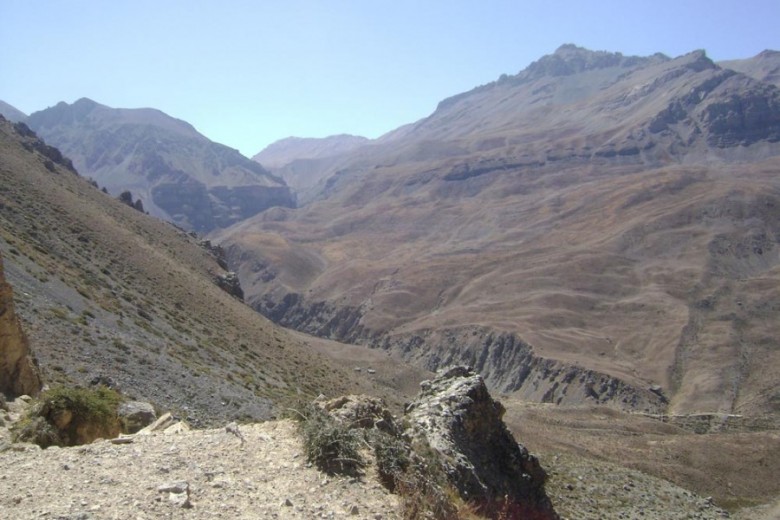
Upper Dolpo is a hidden gem of Nepal with its Tibetan style villages, stunning barren landscapes, and picturesque mountain peaks. The region holds a centuries-old culture untouched by the modern world. The trail requires the crossing of the three high passes Nagdalo La (5350m), Shey La (5000m) and Jeng La (5110m). It involves long climbs and strenuous descents. The trekking in this region is very challenging yet rewarding. As it displays most stunning landscapes, spectacular mountain views and an insightful cultural exposure.
A minimum of two trekkers accompanied by a Nepali guide or Porter is required for a permit to trek Upper Dolpo region. So, make sure you have a Trekking Partner or a trekking agency for the trek.
There are many trekking routes in Nepal which are quite beautiful, but including all is quite impossible. So, we may have missed some of your favorite trekking destinations. Which of these treks in Nepal have you accomplished? And, which of these are in your wish list? Tell us which these trekking did you loved the most and what were its highlight?
Nepal Trekking and Tour Booking Open for 2024/25

Nepal lion Treks & Tours
Name: Greg Brick
[email protected], +7167252828.
Name: Mr Grayson Bot
[email protected], +61401212992.

(716) 725-2828
Name: sunil adhikari, [email protected].

Top 20 Best Treks in Nepal – Best Nepal Trek Packages
Best treks in nepal.
Nepal, a landlocked Himalayan nation, is a trekker’s paradise renowned for its breathtaking landscapes, rich cultural tapestry, and towering mountain peaks.
Nestled between India and China, this small yet diverse country offers many trekking opportunities, attracting adventure enthusiasts from around the globe.
The best treks in Nepal seamlessly blend the awe-inspiring beauty of nature with the warmth of local hospitality, creating an unforgettable journey for those seeking an immersive experience.
As you traverse the well-trodden paths of Nepal, you’ll find yourself immersed in a kaleidoscope of landscapes, ranging from lush subtropical forests to arid alpine deserts.
The country is synonymous with the mighty Himalayas, home to eight of the world’s 14 highest peaks, including Mount Everest.
However, Nepal’s trekking offerings extend far beyond the iconic Everest Base Camp trek, encompassing a variety of routes that cater to different skill levels and interests.
Whether you’re an avid mountaineer aiming for challenging high-altitude adventures or a nature lover seeking serene trails that wind through traditional villages, Nepal has a trek for everyone.
Each tour is a cultural and geographical odyssey, offering glimpses into the diverse ethnic communities that call the Himalayan region home.
From the Annapurna Circuit, with its spectacular mountain views and cultural encounters, to the remote trails of Upper Mustang, where ancient Tibetan traditions endure, Nepal’s trekking destinations promise physical exertion and a profound connection with the country’s soul.
Join us as we embark on a virtual journey through some of the best treks Nepal offers, exploring the Himalayas’ magic and the cultural tapestry that makes this destination a must-visit for every adventure seeker.
Everest Base Camp Trek in Nepal
Nepal’s Everest Base Camp Trek is an iconic pilgrimage for adventure seekers and nature enthusiasts. Nestled in the heart of the majestic Khumbu region, this trek offers a captivating blend of awe-inspiring mountain vistas, rich cultural encounters, and a challenging yet rewarding journey through some of the world’s most breathtaking terrain.
The trek typically begins in Lukla, a small mountain airstrip that serves as the gateway to the Khumbu.
From here, trekkers weave through quaint Sherpa villages adorned with prayer flags and surrounded by terraced fields, providing a glimpse into the unique Himalayan way of life.
As the trail ascends, so does the anticipation, culminating in the arrival at the legendary Everest Base Camp Trek .
In route, trekkers navigate the Khumbu Glacier, traverse high suspension bridges over rushing rivers, and ascend through alpine forests, all while enjoying panoramic views of towering peaks, including Ama Dablam, Lhotse, and, of course, the world’s highest, Mount Everest.
The trek’s zenith is when trekkers stand in the shadow of the iconic Everest, a testament to the indomitable human spirit and the allure of conquering nature’s grandest challenges.
Beyond the physical demands, the Everest Base Camp Trek is a cultural odyssey, offering encounters with the warm and resilient Sherpa people. Teahouses along the route provide shelter and opportunities for cultural exchange, allowing trekkers to savor traditional Sherpa cuisine and hospitality.
At every step, the Everest Base Camp Trek weaves a tapestry of natural beauty and cultural richness, leaving an indelible mark on those undertaking this extraordinary journey in the shadow of the world’s highest peak.
Annapurna Base Camp Trekking
The Annapurna Base Camp Trek, nestled in the spectacular Annapurna region of Nepal, stands as a testament to nature’s grandeur and cultural richness.
This trek is a captivating journey through diverse landscapes, charming villages, and a mosaic of ethnic cultures, culminating in the breathtaking amphitheater of the Annapurna Sanctuary.
Commencing in the vibrant city of Pokhara, known for its serene lakes and stunning mountain views, the trek winds through terraced fields and traditional Gurung and Magar villages.
As trekkers ascend, the landscape transforms from subtropical forests to alpine meadows, providing a stunning backdrop of Annapurna and Machapuchare peaks.
The trek’s crescendo is the arrival at Annapurna Base Camp, a natural sanctuary surrounded by towering Himalayan peaks.
The panoramic views include Annapurna I, Annapurna South, Machapuchare, and Hiunchuli, creating an awe-inspiring panorama that leaves an indelible mark on all who venture here.
Along the trail, teahouses offer respite and opportunities to immerse oneself in the local culture.
The warmth of the Gurung and Magar communities is evident in their hospitality, traditional dances, and delicious local cuisine, providing a holistic experience beyond the physical challenge of the trek.
The Annapurna Base Camp Trek is a perfect blend of adventure and cultural exploration, making it accessible to many trekkers.
Whether navigating through dense rhododendron forests, crossing picturesque suspension bridges, or gazing upon the towering peaks, every step celebrates the Himalayan spirit and the enchantment of the Annapurna region.
Ghorepani Poonhill Trekking
The Ghorepani Poon Hill Trek, nestled in the Annapurna region of Nepal, is a short yet enriching journey that combines breathtaking mountain views with charming villages and lush rhododendron forests.
This trek has become a favorite among those seeking a taste of the Himalayan experience within a relatively concise timeframe.
Commencing from Nayapul, the trail meanders through terraced fields and picturesque villages inhabited by the Gurung and Magar communities.
As trekkers ascend, the landscape transforms into dense rhododendron forests, creating a vibrant tapestry of colors during the spring bloom.
The destination, Poon Hill, is renowned for offering one of the most stunning panoramic views of the Annapurna and Dhaulagiri mountain ranges during sunrise.
The trek’s highlight is the magical dawn ascent to Poon Hill, where the first rays of sunlight illuminate the snow-capped peaks, creating a breathtaking spectacle.
Annapurna South, Dhaulagiri, Machapuchare, and surrounding Himalayan giants paint the skyline, providing an unforgettable backdrop to the trekking experience.
Throughout the journey, cozy teahouses provide comfortable accommodation and an opportunity for cultural exchange with the local communities.
The warm hospitality of the Gurung and Magar people and delicious local cuisine add a rich layer to the trekking adventure.
The Ghorepani Poon Hill Trek is not only a feast for the eyes but also a manageable trek suitable for individuals with limited time or those new to high-altitude trekking.
Its accessibility, with the stunning vistas and cultural immersion, makes it a gem in Nepal’s diverse tapestry of trekking experiences.
Annapurna Circuit Trek
The Annapurna Circuit Trek is a legendary odyssey that encircles the entire Annapurna Massif, offering trekkers a comprehensive and awe-inspiring exploration of the diverse landscapes, cultures, and elevations found in the central Himalayas of Nepal.
Commencing in the lakeside city of Pokhara, the trek follows a well-established route that takes trekkers through the picturesque villages of Besisahar, Chamje, and Manang.
As the trail ascends, the landscape transforms from terraced fields and rhododendron forests to high-altitude desert terrain, offering panoramic views of Annapurna, Dhaulagiri, Machapuchare, and other peaks.
The trek reaches its pinnacle at Thorong La Pass, one of the world’s highest trekking passes at 5,416 meters (17,769 feet).
The crossing of Thorong La is a physically demanding but gratifying experience, providing trekkers with unparalleled vistas of the surrounding peaks.
One of the unique aspects of the Annapurna Circuit is the opportunity for cultural immersion. Trekkers encounter diverse ethnic communities, including Gurung, Thakali, and Manangi, each with its traditions, architecture, and cuisine.
The ancient monasteries, chortens, and prayer flags that dot the landscape add a spiritual dimension to the journey.
The Annapurna Circuit Trek allows trekkers to witness dramatic changes in climate and terrain, from subtropical lowlands to high-altitude arctic conditions.
The variety of experiences, combined with the warmth of local hospitality, creates a trekking adventure that is both physically challenging and culturally enriching, making it a bucket-list destination for those seeking a comprehensive Himalayan experience.
Gokyo Lake Trekking
The Gokyo Lake Trek stands as a jewel in the Khumbu region of Nepal, offering a unique and enchanting alternative to the more frequented trails.
Renowned for its pristine turquoise lakes, dramatic mountain vistas, and the opportunity to ascend Gokyo Ri for panoramic views, this trek is a captivating journey into the heart of the Everest region.
Commencing from Lukla, the trek diverges from the classic Everest Base Camp route, leading trekkers through picturesque Sherpa villages and rhododendron forests.
The tour’s highlight is the cluster of Gokyo Lakes, a series of glacial lakes set against towering peaks, including Cho Oyu, the sixth-highest mountain in the world.
As trekkers ascend, the landscape transitions from lush greenery to alpine terrain, providing opportunities to witness the unique flora and fauna of the region. Gokyo Ri, a vantage point reached during the trek, offers a breathtaking panorama of Everest, Lhotse, Makalu, and the Ngozumpa Glacier, providing an alternative perspective to the classic Everest Base Camp views.
The trek also includes crossing the Cho La Pass, a challenging but rewarding high-altitude experience that adds an adventurous dimension to the journey. Along the trail, teahouses provide warm hospitality and a chance for cultural exchange with the local Sherpa communities.
The Gokyo Lake Trek is a visual feast for nature lovers and an opportunity for trekkers to immerse themselves in the tranquility of the high Himalayas.
The combination of pristine lakes, towering peaks, and the warmth of Sherpa hospitality makes this trek a unique and unforgettable experience in the Everest region of Nepal.
Langtang Valley Trek
The Langtang Valley Trek is a captivating journey through the pristine landscapes of the Langtang region, offering trekkers a perfect blend of natural beauty, cultural exploration, and stunning mountain vistas.
Known for its accessibility from Kathmandu and its unique blend of Tibetan and Tamang cultures, the Langtang Valley Trek has become a popular choice for those seeking an immersive Himalayan experience.
Beginning in the village of Syabrubesi, the trail winds through lush rhododendron and bamboo forests, traditional Tamang villages, and terraced fields.
The warm hospitality of the Tamang people of Tibetan descent provides trekkers with a glimpse into their rich cultural traditions and lifestyle.
As the trek progresses, the landscape reveals alpine meadows, yak pastures, and snow-capped peaks, including Langtang Lirung.
The Kyanjin Gompa, a Buddhist monastery in the valley’s heart, serves as a cultural and spiritual focal point and offers panoramic views of the surrounding mountains.
For those seeking further adventure, the trek can include Tserko Ri, a vantage point providing a stunning 360-degree panorama of the Langtang range.
One of the distinctive features of the Langtang Valley Trek is its relative tranquility compared to more popular routes, allowing trekkers to enjoy the serene beauty of the region in a more secluded setting.
The trek also serves as a gateway to the Langtang National Park, a protected area renowned for its diverse flora and fauna.
The Langtang Valley Trek, with its cultural richness and natural splendor, offers a fulfilling Himalayan adventure that leaves a lasting impression on those who traverse its trails.
Manaslu Circuit Trek
The Manaslu Circuit Trek presents an off-the-beaten-path adventure in the heart of the Nepalese Himalayas, encircling the majestic Manaslu, the eighth-highest peak in the world.
This trek is a compelling alternative to more popular routes, offering a perfect blend of diverse landscapes, rich cultural encounters, and awe-inspiring mountain scenery.
Commencing in Arughat, the trail follows the Budhi Gandaki River through subtropical forests, terraced fields, and traditional villages inhabited by diverse ethnic communities.
The trek gradually ascends, revealing the grandeur of the Manaslu massif and traversing through remote landscapes that have retained their unspoiled beauty.
The Larkya La Pass, standing at an elevation of 5,160 meters (16,930 feet), marks the climax of the trek and provides unparalleled views of Manaslu, Himlung Himal, Cheo Himal, and the Annapurna range.
The pass also serves as a transition point between the lower regions’ predominantly Hindu culture and the upper reaches’ Tibetan-influenced Buddhist culture.
The Manaslu Circuit Trek allows trekkers to experience the authentic culture and hospitality of the region. Villages like Samagaun and Samdo offer insights into the daily lives of the local inhabitants, mainly of Tibetan origin.
Monasteries, prayer flags, and chortens adorn the landscape, adding a spiritual dimension to the journey.
Due to its restricted nature, the Manaslu Circuit requires a special permit to preserve its pristine environment and ensure a more serene trekking experience.
The route also takes trekkers through the Manaslu Conservation Area, home to diverse flora and fauna, including the elusive snow leopard.
For those seeking a less-trodden path with cultural richness and unparalleled mountain views, the Manaslu Circuit Trek is a hidden gem in the Himalayas, promising a unique and unforgettable adventure.
Upper Mustang Trekking
The Upper Mustang Trek is a remarkable journey into the hidden kingdom of Lo, nestled in the rain shadow of Nepal’s Annapurna and Dhaulagiri ranges.
This restricted region, once a part of the ancient Tibetan Kingdom of Lo, offers a unique blend of arid landscapes, ancient culture, and awe-inspiring views of the Himalayas.
Beginning in Jomsom, the trek winds through the Kali Gandaki Valley, a stark desert-like terrain flanked by soaring cliffs.
The landscape has unique geological formations, including eroded cliffs and dramatic gorges. Mustang’s arid environment starkly contrasts the lush landscapes in other parts of the Himalayas.
The cultural aspect of the Upper Mustang Trek is equally captivating. The region opened to foreigners only in 1992 and has retained its ancient traditions and Tibetan-influenced culture.
The walled city of Lo Manthang, the capital of Upper Mustang, is a cultural centerpiece with its medieval architecture, monasteries, and labyrinthine alleyways.
The king’s palace, sanctuaries such as Thubchen and Jampa, and the Amchi Museum offer glimpses into the rich history and spirituality of the region.
The trek also includes visits to ancient caves, such as the Chhoser Cave Dwellings, which served as meditation retreats for Buddhist monks.
The caves contain intricate murals, manuscripts, and ancient artifacts, providing a window into the spiritual practices of the past.
The unique combination of cultural preservation and striking landscapes makes the Upper Mustang Trek an extraordinary adventure.
Trekkers traverse high mountain deserts, visit centuries-old monasteries, and witness a way of life that has stood the test of time.
The Annapurna region is renowned for its diverse trekking routes that cater to various preferences and timeframes.
Suppose there have been developments or changes in trekking nomenclature or new trekking routes introduced since my last update.
In that case, I recommend checking with local authorities, travel agencies, or updated trekking resources for the latest and most accurate information on trekking destinations in Nepal, including any areas referred to as “Lower Mustang.”
Makalu Base Camp Trekking
The Makalu Base Camp Trek is an adventurous and less-trodden trekking route that leads to the base camp of Mount Makalu, the fifth-highest mountain in the world. This trek provides:
- It is a unique opportunity to explore Nepal’s remote and pristine eastern part.
- Showcasing diverse landscapes.
- Rich biodiversity.
- Breathtaking mountain views.
Commencing from Tumlingtar, the trek follows the Arun River valley, gradually ascending through lush rhododendrons and oak forests.
The trail traverses traditional villages inhabited by diverse ethnic communities, offering glimpses into the local way of life. As trekkers ascend, the vegetation changes and alpine meadows replace the lower-altitude forests.
One of the highlights of the Makalu Base Camp Trek is reaching the Shipton La Pass (4,125 meters), which provides stunning panoramic views of Makalu, Baruntse, and the surrounding peaks.
The trek continues through the Barun Valley, home to various wildlife, including the elusive red panda, Himalayan tahr, and multiple species of pheasants.
The Makalu Base Camp is situated at the foot of the imposing Makalu (8,485 meters), surrounded by towering peaks. The landscape is characterized by glaciers, icefalls, and moraines, creating a dramatic and serene environment.
Unlike more popular trekking regions, the Makalu Base Camp Trek offers a quieter and more remote experience, allowing trekkers to immerse themselves in the tranquility of the Himalayan wilderness.
The trek also presents an opportunity for cultural exchange with the local communities, primarily Sherpas and ethnic groups like the Rai and Limbu.
Due to its challenging terrain and the need for careful acclimatization, the Makalu Base Camp Trek is recommended for experienced trekkers seeking a more off-the-beaten-path adventure in the eastern Himalayas of Nepal.
Upper Dolpo Trekking
The Upper Dolpo Trek is an extraordinary journey into Nepal’s remote and culturally rich Dolpo region. Renowned for its stunning landscapes, traditional Tibetan culture, and ancient monasteries, this trek offers a rare and off-the-beaten-path experience for those seeking a unique adventure in the Himalayas.
Beginning in Juphal, the trek takes you through Shey Phoksundo National Park, home to the pristine Phoksundo Lake—the deepest lake in Nepal. The turquoise waters of the lake, surrounded by snow-capped peaks and lush forests, create a mesmerizing setting.
As the trek continues, you traverse high-altitude desert landscapes, barren hills, and ancient trading routes that have connected Dolpo with Tibet for centuries.
The region is known for its unique Bon and Tibetan Buddhist cultures, reflected in the monasteries and chortens scattered along the trail. The Shey Gompa, with its ancient murals and spiritual significance, is a cultural highlight of the trek.
One of the challenges and attractions of the Upper Dolpo Trek is the crossing of high passes, including the Kang La Pass (5,350 meters) and the Saldang La Pass (5,200 meters). These passes provide breathtaking views of the surrounding peaks and valleys.
The trek also takes you through traditional villages like Dho Tarap, inhabited by the Dolpo people, who have preserved their distinct culture and lifestyle for centuries. The architecture of the towns and the local festivals add to the cultural richness of the journey.
Due to its remote location and restricted status, the Upper Dolpo Trek requires special permits to preserve the region’s unique environment and cultural heritage.
The trek is well-suited for those seeking a challenging and culturally immersive adventure away from Nepal’s more popular trekking routes.
As with any high-altitude tour, thorough preparation and adherence to local regulations are essential for a safe and rewarding experience.
Luxury Everest Base Camp Trek With Helicopter Return
Embarking on the Luxury Everest Base Camp Trek with Helicopter Return is an unparalleled fusion of adventure and luxury, elevating the classic trekking experience to new heights.
Nestled in the heart of the towering Himalayas, this exclusive journey offers discerning travelers the chance to explore the iconic Everest region while indulging in the comforts of luxurious accommodations and the convenience of a helicopter return.
Commencing in the vibrant city of Kathmandu, the trek unfolds with a seamless blend of cultural immersion and high-altitude adventure.
Participants are treated to exquisite accommodations, fine dining, and personalized services, ensuring a rejuvenating experience after each day of trekking.
The trek follows the legendary route to Everest Base Camp, where every step unveils breathtaking landscapes and panoramic views of the world’s highest peaks.
As trekkers traverse traditional Sherpa villages and alpine terrain, the luxury element of the journey comes to life in the form of sumptuous lodges and high-end amenities.
The accommodations, strategically located to offer both comfort and spectacular views, provide a haven for relaxation amidst the rugged Himalayan environment.
The pinnacle of this luxury trek lies in the Helicopter Return, a bespoke aerial experience that allows participants to soar above the majestic Himalayan landscape, relishing unparalleled views of Everest and its neighboring peaks.
This adds an extraordinary dimension to the journey and ensures a swift and scenic return, sparing travelers the physical demands of retracing their steps.
The Luxury Everest Base Camp Trek with Helicopter Return is a testament to the harmonious coexistence of adventure and indulgence.
It caters to those with a taste for refinement, promising an exclusive and memorable exploration of the Everest region, where the lap of luxury complements the thrill of the journey in the heart of the world’s most iconic mountain range.
Kanchenjunga Base Camp Trekking
The Kanchenjunga Base Camp Trek is an exhilarating odyssey into the remote and pristine landscapes surrounding the third-highest mountain in the world, Mount Kanchenjunga.
Tucked away in the easternmost corner of Nepal, this trek is a hidden gem that beckons adventurers seeking untouched natural beauty, rich cultural diversity, and a challenging yet rewarding journey.
Commencing in the village of Taplejung, the trek follows trails that wind through dense rhododendron forests, charming villages, and terraced fields.
As trekkers ascend, the Himalayan panorama unfolds, revealing the towering presence of Kanchenjunga and other majestic peaks like Jannu, Makalu, and Kabru.
One of the distinctive features of the Kanchenjunga Base Camp Trek is the exploration of the Kanchenjunga Conservation Area.
This protected region harbors a diverse range of flora and fauna. Rare species such as the red panda, snow leopard, and pheasants inhabit this pristine environment.
The trek takes trekkers through remote villages inhabited by diverse ethnic communities, including the Rai and Limbu people.
The warmth of the local hospitality, traditional architecture, and cultural practices offer a glimpse into the unique way of life in this secluded corner of Nepal.
The base camp, surrounded by glaciers and towering peaks, provides a serene and awe-inspiring setting for trekkers to savor.
Due to its remote location and challenging terrain, the Kanchenjunga Base Camp Trek is recommended for experienced trekkers seeking an off-the-beaten-path adventure.
The trek’s emphasis on conservation and its cultural and natural richness make it a genuinely immersive Himalayan experience for those willing to venture into the eastern frontier of Nepal.
Everest Three-Pass Trek
The Everest Three Pass Trek is an ultimate Himalayan adventure that pushes the boundaries of exploration and endurance.
This challenging trek takes brave adventurers through the heart of the Khumbu region, offering an exhilarating traverse over three high mountain passes: Renjo La Pass (5,360m), Cho La Pass (5,420m), and Kongma La Pass (5,535m).
This extraordinary journey combines the iconic Everest Base Camp trek with the additional challenge of conquering these formidable passes, promising unparalleled views and a sense of accomplishment.
The trek in Lukla follows the classic Everest Base Camp route, passing through traditional Sherpa villages, lush rhododendron forests, and alpine landscapes.
The path to each pass unveils a breathtaking panorama of the world’s highest peaks, including Everest, Lhotse, Nuptse, and Ama Dablam.
The trek diverges from the standard route as it leads trekkers to Renjo La Pass, where the mesmerizing views of the Gokyo Lakes and the Everest massif unfold.
The journey then descends into the serene Gokyo Valley, known for its turquoise lakes and stunning mountain reflections.
The adventure continues with the crossing of Cho La Pass, a challenging ascent that rewards trekkers with unparalleled vistas of the Khumbu Glacier and surrounding peaks.
The trail eventually converges with the classic Everest Base Camp route, leading to the iconic base camp.
The descent from Kongma La leads to the picturesque Chhukung Valley, providing a fitting finale to this high-altitude odyssey.
The Everest Three Pass Trek is a test of physical resilience and cultural immersion, with encounters in Sherpa villages, visits to ancient monasteries, and a chance to witness the daily lives of those who call the Khumbu region home.
For trekkers seeking an unparalleled Himalayan challenge and an opportunity to stand amidst the world’s highest peaks, the Everest Three Pass Trek is an adventure of a lifetime.
Pikey Peak Trekking
The Pikey Peak Trek is a hidden gem in the lower Khumbu region of Nepal, offering trekkers a unique and off-the-beaten-path adventure.
Standing at an elevation of 4,065 meters (13,336 feet), Pikey Peak provides stunning panoramic views of some of the world’s highest peaks, including Everest, Lhotse, Makalu, Kanchenjunga, and more.
This trek is celebrated for its breathtaking mountain vistas and its cultural richness and tranquility.
Commencing in Jiri, the trail takes trekkers through lush rhododendron forests, charming Sherpa villages, and terraced fields.
The landscape is dotted with monasteries, stupas, and prayer flags, showcasing the cultural and spiritual heritage of the region. The trek offers a unique opportunity to experience the Sherpa way of life away from the more popular Everest Base Camp route.
Pikey Peak is renowned for its sunrise and sunset views. As the sun graces the horizon, the surrounding peaks glow with alpenglow, creating a spectacle that captivates trekkers.
The trek also includes visits to ancient monasteries, such as the Thupten Chholing Monastery, adding a cultural dimension to the journey.
One of the appealing aspects of the Pikey Peak Trek is its tranquility. The trail is less frequented, allowing trekkers to immerse themselves in the serene beauty of the Himalayas without the crowds found on more popular routes.
The route is accessible year-round, offering flexibility for those seeking a trek with fewer logistical challenges.
The Pikey Peak Trek provides a genuine Himalayan experience, combining breathtaking natural beauty with cultural exploration.
It is a trek for those who appreciate the tranquility of the mountains, panoramic views, and an artistic journey through the heart of Sherpa territory.
Everest Panorama Trek
The Everest Panorama Trek is a captivating journey into the heart of the Khumbu region, offering a shorter yet equally rewarding exploration of the world’s highest peaks.
This trek is designed for those seeking a taste of the iconic Everest experience without the commitment of an extended journey, making it accessible to a wide range of adventurers.
Commencing in Lukla, the gateway to the Everest region, the trek follows well-trodden paths that wind through traditional Sherpa villages, vibrant rhododendron forests, and terraced fields.
The trail presents a gradual ascent, allowing trekkers to acclimate and savor the breathtaking mountain views that unfold with each step.
One of the highlights of the Everest Panorama Trek is the visit to Tengboche Monastery, a spiritual and cultural centerpiece of the region.
Surrounded by awe-inspiring vistas, the monastery provides a serene setting for trekkers to immerse themselves in the local Tibetan Buddhist traditions.
As the journey continues, trekkers reach vantage points such as Namche Bazaar and Syangboche, offering panoramic views of Everest, Lhotse, Ama Dablam, and other surrounding peaks.
The trek provides ample opportunities for cultural exchange with the Sherpa communities, known for their warm hospitality and rich cultural heritage.
The Everest Panorama Trek is ideal for those with limited time, offering a condensed yet fulfilling Himalayan experience.
Compared to more extended routes, the trek’s lower elevation minimizes the risk of altitude-related challenges, making it suitable for trekkers of various fitness levels.
At every step, the Everest Panorama Trek unveils the grandeur of the Khumbu region, creating lasting memories of mountain vistas, cultural encounters, and the indomitable spirit of the Everest region.
PoonHill Teahouse Trekking
The Poon Hill Teahouse Trekking is a charming and accessible journey into the picturesque landscapes of the Annapurna region, offering a delightful blend of natural beauty, cultural encounters, and comfortable accommodations in traditional teahouses.
This trek is renowned for its suitability for trekkers of varying fitness levels, making it an ideal choice for those seeking a Himalayan adventure with a touch of comfort.
The trek begins in Nayapul and follows well-maintained trails that wind through terraced fields and rhododendron forests and welcome Gurung and Magar villages.
The highlight of the tour is the ascent to Poon Hill, a vantage point that unveils a spectacular sunrise over the Annapurna and Dhaulagiri mountain ranges.
The panoramic views of peaks like Annapurna South, Machapuchare, and Nilgiri create a breathtaking backdrop for trekkers.
One of the unique aspects of the Poon Hill Teahouse Trekking is the accommodation in traditional teahouses along the route.
These cozy lodges, run by local families, offer a comfortable and intimate setting for trekkers to relax and recharge.
The teahouses provide shelter and an opportunity for cultural exchange as trekkers enjoy hearty local meals and warm hospitality.
The trek continues through charming villages like Ghorepani and Tadapani, each with distinct character and cultural nuances.
The Poon Hill Teahouse Trekking is often chosen for its accessibility and shorter duration, allowing trekkers to experience the beauty of the Annapurna region in a condensed timeframe.
Whether admiring the sunrise from Poon Hill, strolling through rhododendron-filled forests, or engaging with local communities, every step of this trek offers a delightful immersion into the natural and cultural wonders of the Himalayas.
Khopra Ridge Trekking
The Khopra Ridge Trekking is an enchanting and off-the-beaten-path adventure in the Annapurna region of Nepal, offering trekkers a unique journey through diverse landscapes, charming villages, and breathtaking mountain vistas.
This trek, less frequented than some of the more popular routes, provides a peaceful and immersive experience for those seeking a quieter Himalayan exploration.
Commencing in Nayapul, the trek takes trekkers through terraced fields and traditional Gurung villages, gradually ascending to the serene landscapes of Khopra Ridge.
The tour provides a stunning variety of scenery, from lush rhododendron forests to alpine meadows, and showcases panoramic views of iconic peaks such as Annapurna South, Dhaulagiri, and Machapuchare.
A notable feature of the Khopra Ridge Trekking is the destination itself—Khopra Ridge.
This vantage point offers a unique perspective of the surrounding mountains, and trekkers can ascend to Khayer Lake for even more stunning views.
The peaceful atmosphere of the ridge, away from the crowds, creates an intimate connection with the Himalayan landscape.
Accommodations along the route are in teahouses, providing a comfortable and authentic experience. Trekkers can enjoy local cuisine and warm hospitality, contributing to a sense of cultural immersion throughout the journey.
Interaction with local communities, including the Gurung and Magar, adds a rich cultural dimension to the trek.
The Khopra Ridge Trekking is well-suited for those who appreciate tranquility, natural beauty, and a more remote trekking experience.
The route offers a balance between the allure of the Annapurna region and the serenity of less-traveled trails, making it a captivating choice for trekkers seeking a distinctive Himalayan adventure.
Annapurna Sanctuary Trek
The Annapurna Sanctuary Trek is a spellbinding odyssey into the heart of the Annapurna Massif, offering trekkers a breathtaking combination of natural beauty, diverse landscapes, and a profound sense of sanctuary surrounded by towering peaks. She was also known as the Annapurna Base Camp Trek.
This journey is celebrated for its accessibility, cultural richness, and the awe-inspiring amphitheater of mountains that encircle the sanctuary.
Commencing in Nayapul, the trek meanders through terraced fields, charming villages, and lush rhododendron forests, gradually ascending toward the spectacular Annapurna Sanctuary.
As trekkers progress, the panoramic views of Annapurna, Machapuchare, Hiunchuli, and surrounding peaks become increasingly captivating.
The Annapurna Sanctuary, nestled at an elevation of 4,130 meters (13,550 feet), is a glacial basin surrounded by towering peaks, creating a natural amphitheater that feels like a sanctuary amidst the grandeur of the Himalayas.
The trail also leads to Machapuchare Base Camp, offering stunning views of the iconic “Fishtail” peak.
Accommodations along the route are in teahouses, providing a comfortable and authentic experience. Trekkers can engage with local communities, primarily Gurung and Magar villages, learning about their traditions and enjoying warm hospitality.
One of the unique features of the Annapurna Sanctuary Trek is the diversity of landscapes encountered, from subtropical forests to alpine meadows and glacial terrain.
This diversity contributes to the trek’s allure, creating a dynamic and ever-changing backdrop.
The Annapurna Sanctuary Trek suits trekkers of varying experience levels, offering a harmonious blend of adventure and cultural exploration.
Whether standing at the base of towering peaks, breathing in the crisp mountain air, or reveling in the region’s cultural tapestry, every step of this trek is a celebration of the magnificence of the Annapurna Massif.
Poon Hill Hot Spring Trekking
The Poon Hill Hot Spring Trekking is a delightful and rejuvenating journey through the picturesque landscapes of the Annapurna region in Nepal.
This trek combines the mesmerizing views from Poon Hill with the therapeutic relaxation of natural hot springs, offering trekkers a perfect blend of natural beauty and wellness.
Commencing in Nayapul, the trek follows scenic trails that wind through traditional villages, terraced fields, and lush rhododendron forests.
The highlight of the tour is the ascent to Poon Hill, a vantage point that unveils a breathtaking panorama of the Annapurna and Dhaulagiri mountain ranges during sunrise.
After the awe-inspiring views from Poon Hill, the trek descends to the natural hot springs in Jhinu Danda. Nestled along the banks of the Modi Khola, these thermal baths provide a soothing and well-deserved respite for trekkers.
The therapeutic properties of the hot springs offer a relaxing experience, allowing trekkers to unwind and rejuvenate amid the tranquil surroundings.
The Poon Hill Hot Spring Trekking is well-suited for those who appreciate both the stunning mountain views and the therapeutic benefits of natural hot springs.
The trek perfectly balances adventure and relaxation, making it an appealing choice for trekkers seeking a holistic Himalayan experience.
Mardi Himal Trekking
The Mardi Himal Trekking is a captivating adventure into the less-explored landscapes of the Annapurna region in Nepal.
This trek, named after the striking Mardi Himal peak, offers trekkers a pristine and off-the-beaten-path experience, combining breathtaking mountain vistas, lush forests, and a sense of tranquility away from the more frequented trails.
Commencing from Phedi or Kande, the trek follows scenic trails that wind through rhododendrons, oak forests, charming villages, and terraced fields.
As trekkers ascend, the views of the Annapurna and Machapuchare (Fishtail) mountain ranges become increasingly spectacular.
One of the highlights of the Mardi Himal Trekking is the High Camp, situated at around 3,580 meters. This vantage point provides a stunning panorama of Mardi Himal, Machapuchare, Annapurna South, and Hiunchuli.
The trek allows for an optional ascent to Mardi Himal Base Camp for those seeking a closer view of the majestic peak.
The route is less crowded than some of the more popular treks in the region, offering a more secluded and intimate experience with the Himalayan wilderness. Accommodations along the route are typically in teahouses, providing a comfortable and authentic experience.
Trekkers can enjoy local cuisine and warm hospitality while immersing themselves in the cultural nuances of the region.
The Mardi Himal Trekking is suitable for trekkers seeking a less-trodden path, stunning mountain views, and a sense of serenity in the heart of the Annapurna Himalayas.
The trek’s diverse landscapes, from lush forests to alpine meadows, create a memorable journey that captures the essence of the natural beauty of this hidden gem of the Annapurna region.
Related Some FAQs
What is the best time to undertake these treks?
The best time for trekking in Nepal is during the pre-monsoon (spring) season (March to May) and the post-monsoon (autumn) season (September to November). These periods offer stable weather conditions, clear skies, and favorable temperatures for trekking.
Are permits required for these treks?
Yes, trekking permits are required for most trekking destinations in Nepal. The specific licenses vary based on the region you are trekking in.
For example, the Annapurna and Langtang regions have their permits, and special permits are needed for restricted areas like Upper Mustang and Upper Dolpo.
How complex are these treks?
The difficulty level varies for each trek. The Everest Base Camp Trek and Annapurna Base Camp Trek are considered moderate in difficulty and suitable for trekkers with a reasonable fitness level.
Treks like the Manaslu Circuit and Nar Phu Trek are more challenging due to higher altitudes and rugged terrain, requiring a higher fitness level and acclimatization.
What is the accommodation like during these treks?
Accommodations during treks are primarily in teahouses or lodges, especially in popular trekking regions like Annapurna and Everest.
How do I acclimatize to the high altitudes?
Acclimatization is crucial to prevent altitude sickness. Trekkers should ascend gradually, allowing their bodies to acclimate to higher altitudes.
What should I pack for these treks?
Essential items include trekking boots, weather-appropriate clothing, a good backpack, a sleeping bag, trekking poles, and necessary documents (permits, identification). Packing layers is crucial to accommodate changing temperatures during the trek.
Are these treks suitable for beginners?
Yes, some treks, such as the Poon Hill Trek and parts of the Annapurna region, are suitable for beginners with a reasonable fitness level. Choosing a trek that aligns with your experience, fitness, and time available for the tour is essential.
Table Of Contents

- Our Services
- Our Projects
- Discussions

13 Best Treks In Nepal
Sarba -in mountain's embrace , my soul finds its grace.
- Last Updated on Aug 23, 2023
Nepal has been extending its horizons as one of the most alluring tourist destinations in the world. Travelers from different countries visit Nepal in order to fill their life with enormous thrilling adventures ; certain categories of which can only be matched by the stirring trails of Nepal. Though small in size, the variety of landscapes offered by the treks in Nepal leaves one in instant surprise and utter appreciation. As you walk deeper into the wonders of Nepal, you will be humbled by the magical beauty laid down by Great Himalayas and wilderness which keeps on surprising the human race with its greatness. That is what Trekking in Nepal offers you; a deep connection with the forgotten world of peace and glorious wonders.
Nothing can bring you as close to the profound existence of nature, as a trek through the soulful paths of Nepal . No matter how challenging one may call a certain trek, at the end, all you will be remembering is the surreal company of magnificent mountains, wildlife, magical waterfalls, refreshing mountain air, love and kind gesture of the local community, calmness of the forests, calling of the hills, teasing of the peaks, warmth of the morning sun, the taste of local production, the tranquility of the routes of Nepal and even more. A trip to Nepal can indeed prove to be an adventure of a lifetime through the walks in the trails of various Himalayan regions of Nepal . The Nepal trekking route leads you to the lap of Everest Base Camp, Annapurna Circuit, Manaslu Circuit, Kanchenjunga trek, and many other incredible trekking regions of Nepal. With all the great trekking sections on the list, one is likely to be confused while choosing one. So, we are here to provide you with a list of the top 13 treks in Nepal, from which you will easily be able to choose a trek that suits your taste.
Trekking is one of the most rewarding ways for travelers to figure out their purpose and the essence of life. One can truly find themselves only at the heart of nature, nowhere else. And to explore nature, one needs to act as a part of it. Buses, flights, and train journeys are only a medium, but it’s the walk that will be making all the difference. Trek in Nepal, here in this land of diversity, will bring you closer to whatever you are seeking; the journey offers you more than what you have known of, certainly leaving a positive mark in your heart with a memory too difficult to erase. Each one of your steps will lead you closer to a destination as surreal as one thinks of heaven.
There are treks of different natures that Nepal offers you. There are short treks as well as longer ones which you can choose as per your choice of trekking. Some treks involve easy hiking whereas some bring a little challenge to the climb. But as the saying goes, 'the best view can be seen after the hardest climb', one needs to put on a little effort from their side, for nature to put in a huge effort on its part.
But before undertaking any trek, here are some things which you will need to ask yourself:
- For how many days are you planning to visit Nepal?
- What is your estimated budget for the trek?
- Are you traveling in a group or with a single friend?
- Are you looking for a solo trip?
- What kind of environment are you expecting to explore?
- Did you have any trekking experiences before?
- Do you consider yourself fit enough for any sort of trek?
- Are you looking for a tranquil trekking experience or a touristy one?
Thus, being greatly blessed by nature, the country has a lot to offer in the category of trekking. However, to choose among all the treks offered here, which is indeed a difficult task to do, some of the top treks in Nepal are:
Table of Contents
Everest base camp trek.
Highlights:
- Be humbled by the hospitality of the local tea houses and the people of this region
- Enjoy the heartwarming views of various snow-capped mountain peaks
- Experience the local culture and learn about the mountain lifestyle
- Explore the incredible existence of wildlife
- Get awe-struck with magical waterfalls, prayer flags, Mani stones, and many other beauties held by the region.
- If you wish to know in further detail about this trek, click here .

This is one of the most sought-after treks in the country and is widely associated with the highest peak in the world; Mt. Everest. This trek is for the ones in love with a little adrenaline rush, waiting to explore the challenges led by nature to get the best experience of its glory. One gets surrounded by the magnificent mountains of Everest Range including other magical peaks. This trek gets you in touch with the unaltered local culture and the undisturbed wildlife. The paths welcome you with prayer flags, Mani stones, and the humble smiles of the locals and travelers. The forest grabs you with its diverse beauty, decorated with wildlife and rhododendrons. This trek is indeed magical.
Annapurna Base Camp Trek
Wash your tiredness away through the hot spring and refreshing mountain air
Explore the local way of life while going through the traditional villages
Enjoy the amazing views of magnificent mountain peaks in the Annapurna region
Let yourself feel the beautiful existence of wildlife
You can know more in detail about this astounding trek by clicking here. This trek has been able to grab the attention of many travelers with its heavenly paths leading to the most extraordinary scenarios laid down by nature. With little ups and downs and a few challenges, one closely gets to encounter the gratifying view of Annapurna Mountain Range. However, the path we intake is magical in itself with shining rivers, the serene existence of forests, the raw nature of locals and the villages, the diverse beauty of wildflowers, magical waterfalls, the warming welcome from tea houses, and many more.
Poon Hill Trek
Poon hill trek is one of the top treks with comparatively fewer challenges and easier nature in the Annapurna region. But it doesn’t mean, it is any less beautiful. It involves an extraordinary path leading to the top which itself is a treat for any trekkers. However, the destination brings you a magical encounter of sunrise over the Annapurna mountain range, showing us the incredible beauty of the Himalayas. The paths offer you the fresh air of liveliness, welcomes you with varieties of flowers growing out of the wildlife, calm you with the sound of rivers and streams, and the falls are magical in themselves. Poon Hill trek gives you all the magical vibes and gives you a new outlook towards this life and nature.
Highlights of the Poon Hill trek:
- Enjoy the amazing waterfalls of various heights and kinds
- Get in touch with the essence of local culture and way of life
- Fill your soul with fresh energy through the glorious view of sunrise over the mountains
- Get Wonderstruck by the wondrous sights of the magnificent Annapurna range
- Explore the wilderness in its rawest form
- For further details, click here.
The trek to the three passes in the Everest Region:
Renjo La Pass, Chola Pass, and kong mala pass are the three extraordinary passes in the Everest Region. Renjo La Pass trek is however popular in comparison being one of the challenging treks in the Khumbu region bringing remoteness as beauty to its travelers in its raw form leading to the Gokyo lakes and Gokyo Ri Peak.
On the other hand, the Chola Pass trek takes you through both the Gokyo lakes and the Everest Base Camp region with its own deal of challenges. It is suitable for anyone seeking something wild in nature.
Similarly, we have the Kongmala Pass trek, one of the less crowded trekking trails which is indeed a beautiful serene path to intake. Once one travels this path, one cannot get enough of it. It is indeed extraordinary.
Highlights of a trek to three passes of the Everest region:
- Get amazed by the astounding sight of Gokyo Ri peak
- Get yourself on an amazing journey in the wild with rewarding views of Gokyo lakes and the landscapes formed around it
- Enjoy a trekking experience filled with solitude through its unspoiled trails
Manaslu Circuit Trek
Manaslu Circuit Trek is one of the most amazing treks in the country. This trek gets you closely in touch with its wildlife through Manaslu Conservation Area. This trek to the Manaslu region rewards your efforts with the extraordinary view of the eighth tallest mountain in the world named Manaslu. It provides you with the beauty of the Himalayas and glimpses of Magical snowcapped peaks. This journey through Manaslu Circuit Trek surrounds you with the beauty of the wild, at the same time giving you all the feels of home through the heartwarming nature of the locals. You can know further about this amazing trek by clicking here, Manaslu circuit trek.
Highlights of the Manaslu Circuit trek:
- Find yourself in the lap of the third tallest mountain in the world widely known as Mt. Manaslu
- Get awestruck with the beauty of wilderness
- Get stunned by the amazing sights of wildlife within the Manaslu conservation area
- Explore the mountain way of life
- Enjoy the wondrous scenarios of various snow-capped mountain peaks
Annapurna Circuit trek
Annapurna Circuit trek carries you through various landscapes within the Annapurna Range area of Central Nepal. You can enjoy the great view of Annapurna Massif throughout the journey in the Annapurna region. Filled with humble and honest Thakali people in most parts, you will be warmed by their kind gestures and heartwarming cultural ways of welcoming you. Annapurna Circuit trekking is regarded as one of the best trekking in the whole world. While the Annapurna Base Camp trek takes fewer days as it is a trip only up to the Annapurna Base Camp, the Annapurna Circuit trek takes you through all the amazing parts of the region encircled by the whole Annapurna mountain range. This trek is filled with diversity whether it be traditional, culture, wildlife, or the beauties laid down by nature. You will certainly be humbled by the glorious views of Machapuchre, Gangapurna, Manaslu, and Tilicho peaks. Trek through Annapurna Circuit is truly magical.
Highlights of the Annapurna Circuit trek:
- Explore the wilderness through the incredibly rare existence of floras and fauna in this region
- Get accompanied by the view of mountain massifs and glorious waterfalls
- Fill yourself with warmth and joy by enjoying the local culture and ingredients
- Enjoy the mouth-gasping view of magnificent mountain peaks such as Annapurna I-IV, Machapuchre, and Manaslu.
- Gain the experience of a lifetime with this trek to the amazing wonders of nature and culture
Langtang Trek
Langtang trek is one of the very popular treks in the country. This trek takes you to the beautiful world of monasteries, meadows, wildlife, and mountains.
Being located north of Tibet, it is highly influenced by and rich in Tibetan Culture. The beauty of its path is highly gratifying and you will certainly be accompanied by picture-perfect scenes throughout. Trek to Langtang has proven to be an amazing trekking experience for many of its past travelers. Explore the hidden beauties of this region by taking on this magical trek to the top. The wonders of Langtang are waiting for you.
Highlights of Langtang Trek:
- Get closely in touch with the Tibetan cultures and Tradition
- Enjoy the extraordinary views of glorious mountain peaks
- Experience the parallel existence of yourself and the wildlife
- Refresh your body and soul with the amazing walks through the magical forests offering beautiful wildlife
- Bring yourself closer to the symbolic and highly valued existence of its monasteries
Kanchenjunga Trek
Located in the Eastern region of Nepal, the Kanchenjunga trek gives you an unspoiled trekking experience through the region. Trek to Kanchenjunga brings you closer to its authentic remote existence. You will certainly be awe-struck by its diverse wildlife. Through this trek, you will find yourself passing through the Kanchenjunga Conservation Area where the wildlife has been protected for quite some time. You will get a magical experience with this journey through the coniferous forests, beautiful grasslands, and alpine shrubs. You will be greatly gratified by the wondrous views of Mt. Kanchenjunga, Mt. Makalu, and Jahnu Himal. The journey to Kanchenjunga is truly wonderful.
Highlights of Kanchenjunga Trek:
- Get awestruck with incredible Himalayan scenarios
- Explore the raw existence of wildlife such as snow leopards, black bears, and red pandas.
- Experience the local lifestyle through the mixed ethnic communities and tribes
- Get yourself an unspoiled trekking experience with diverse landscapes
Upper Dolpo Trek
Upper Dolpo Trek, being recently opened up for travelers to explore, gives you an unaltered experience of its trails, culture, traditions, wildlife, and other nature's wondrous creations. You will get to experience the magical existence of Shey Phoksundo Lake through this trek. Mostly resided by Tibetan people, this part of its population follows the ancient 'Bon po' religion whereas there is a Hindu population as well. This region is rich in wildlife and beautiful monasteries. You will be able to enjoy scenic views of beautiful mountain peaks throughout this trip to Upper Dolpo.
Highlights of Upper Dolpo Trek:
- Explore the historical connection of mankind with your visits to the monasteries
- Enjoy the jaw-dropping sights of varieties of landscapes
- Know furthermore about the remote mountain life
- Get wonderstruck by the beauty of Shey Phoksundo Lake
Lower Dolpo Trek
Lower Dolpo Trek takes you through the enormous wonders of Western Nepal. Most areas of Lower Dolpo are covered by Shey Phoksundo national park. It is home to varieties of rare wildlife species and is known for being a hub for various medicinal plant species. This trek upholds its beauty through its raw trails and ancient monasteries. The trek to Lower Dolpo gives you the unique scenic beauty of its rainshadow areas. Its devised landscapes, vegetations, and wildlife make this trip to Lower Dolpo even more magical.
Highlights of Lower Dolpo Trek:
- Explore the existence of rare Medicinal Plant Species
- Enjoy the aesthetic beauty of ancient monasteries
- Get awestruck by the beautiful scenarios of its landscapes and mountain peaks
- Get in touch with the essence of local culture and lifestyle
Makalu Base Camp Trek
The Makalu base camp trek extends its horizons in the Eastern part of Nepal. It upholds its beauty with the fifth tallest mountain in the world widely known as Mt. Makalu. This trek to Makalu base camp provides you with jaw-dropping scenarios of snow-capped mountain peaks and incredible landscapes. The existence of wildlife in this region is simply astounding. One can hardly get enough of this extraordinary trek.
Highlights of Makalu base camp:
- Enjoy the journey through the extraordinary trails to the Base Camp
- Get stunned by the glory of the fifth-highest mountain in the world, mt. Makalu
- Experience the scenic beauty of varieties of landscapes
- Get in touch with the essence of the mountain lifestyle
- Explore the wilderness through the incredible existence of wildlife in this region
Gokyo Lakes Trek
Composed of five shining green lakes, Gokyo Lakes is indeed a beautiful creation of nature residing proudly on the western side of Everest Base Camp. The Gokyo Lakes trek takes you through the beautiful Gokyo Villages with its authentic cultural way of life. You will certainly be stunned by the beauty of its landscapes and the view of the glorious Gokyo Ri Peak.
Highlights of the Gokyo Lakes trek:
- Get in touch with the authentic culture and traditions of the local people
- Get yourself to feel the warmth from the cozy existence of Gokyo Village
- Get stunned by the magical view of Gokyo Ri Peak
- Enjoy the mouth-gasping existence of Gokyo Lakes
Mardi Himal Base Camp Trek
Mardi Trek is one of the shortest and easiest forms of trek in the country. You will get accompanied by glorious Macchapuuchre mountain all throughout this trek to Mardi Himal Base Camp. Similarly, you will certainly feel refreshed with the walks through beautiful unspoiled forests and wildlife. Wildflowers welcome you gracefully throughout the trails. At the top of the trek, you will be awe-struck by the beautiful existence of the Annapurna mountain range and Mardi Himal itself.
Highlights of Mardi Himal Base Camp:
- Get a lifetime experience by trekking through the unspoiled trails decorated with wildflowers
- Get humbled by the magical dense existence of forests and wildlife
- Experience the jaw-dropping views of Mt. Machapuchre, Annapurna, and Mardi Himal
- Get amazed by its amazing landscapes and local way of life
Thus, these were the top thirteen treks in Nepal which could be a lifetime experience for any trekkers undertaking the journey. Each trek has its own values and beauties to offer you, being different yet similar in a certain way. These treks are known to wash all your troubles and tensions away making you dive deep into their glorious wonders.
Nepal Nomad is a Kathmandu-based tour operator offering sustainable trekking, touring, and peak climbing services in the Himalayas. Our aim is to simplify the process of choosing the right path for your footsteps. We prioritize your safety and ensure that each journey is filled with the desired level of adventure. As a team, we are committed to providing honest and accurate information about the treks and tours we offer. We are here to support you throughout your journey and address any inquiries or concerns you may have. For the ultimate travel experience in Nepal, feel free to contact us.

Sarba is the multifaceted leader behind Nepal Nomad, a reputable travel company with an extensive 16-year history in tour operations. As the team leader, owner, tour manager, and managing director, Sarba has spearheaded the company's growth and success. With a strong emphasis on safety and enjoyment, Nepal Nomad boasts a dedicated team comprising experienced guides, potters, and mountaineers.
The team's expertise extends to various critical areas, including first-aid, map reading, and evacuation protocols, ensuring the well-being of all travelers. Notably, the team is also adept at conversing in foreign languages, facilitating seamless communication between the office and a diverse range of travelers. Nepal Nomad stands out by offering both personalized itineraries and fixed departure options, catering to the unique preferences of our clients. For those seeking information on costs and other specifics, the friendly in-office staff is readily available to assist with inquiries. If you're looking for a travel experience that blends expertise, safety, and personalized service, Nepal Nomad is the go-to choice.
Ask a Question
Latest blog posts.

Christmas and New Year Tour Package 2024-2025

Pokhara Valley

Best Trekking Boots for your Everest Base Camp
We use cookies to ensure that we give you the best experience on our website.

Beginner Treks in Nepal: 10 Easy Trekking Routes [2023]
- June 30, 2023
Welcome to the enchanting world of Nepal, a land blessed with breathtaking landscapes, majestic mountains, and a rich cultural heritage. Nepal is renowned as a trekker’s paradise, offering a plethora of trekking opportunities for adventure enthusiasts from around the globe. If you are a beginner seeking an unforgettable trekking experience, we are here to help with our beginner treks in Nepal rundown!
Trekking in Nepal not only challenges you physically but also gives you the chance to immerse yourself in the beauty of nature. As a beginner, it is essential to choose a trek that provides a balanced blend of adventure, scenic beauty, and a manageable level of difficulty.
In this guide, we will take you on a journey through some of the best treks in Nepal specifically designed for beginners. Whether you dream of walking in the shadows of towering peaks, exploring quaint Himalayan villages, or witnessing cascading waterfalls and serene valleys, Nepal has something to offer every trekking enthusiast.
10 Best Beginner Treks in Nepal
We will delve into the magnificent Annapurna region, where you can experience the magic of the Annapurna Base Camp trek or the picturesque beauty of the Ghorepani Poon Hill trek. If you seek a taste of Nepal’s rich cultural heritage, the Langtang Valley trek presents an excellent opportunity to immerse yourself in the unique traditions of the Tamang and Sherpa communities. Alternatively, the Everest Panorama trek offers a shorter but no less spectacular journey, allowing you to witness the iconic Mount Everest up close.
Throughout this guide, we will provide you with valuable insights, practical tips, and essential information to ensure your trekking experience in Nepal is safe, enjoyable, and truly unforgettable. From the best seasons to travel and quick facts about the treks, we have got you covered with these beginner treks in Nepal.
1. Balthali Village Trek
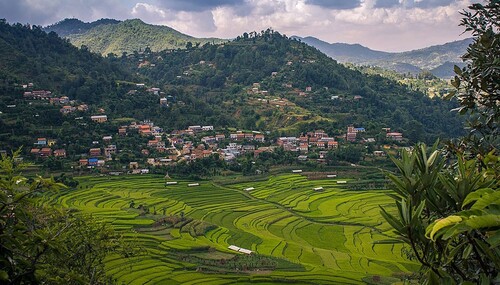
Quick Trip Information:
- Duration: 3 days
- Maximum Elevation: 1,750 meters
- Starting and ending point: Kathmandu
- Accommodation: Teahouse
- Best season to travel: September to May
Balthali Village Trek, a hidden gem near Kathmandu, is one of the easiest treks you can shoot for. This unique trek presents a delightful blend of traditional Nepalese villages, breathtaking mountain vistas, and a tranquil environment, making it an ideal choice for beginners and families seeking a memorable adventure.
You will get panoramic views of majestic snow-capped mountains, including the impressive Langtang Himal, the formidable Manaslu, the sacred Gaurishankar, and the majestic Dorje Lakpa.
Traverse through Newar, Tamang, and other ethnic tribal villages, where you can witness the vibrant traditions, warm hospitality, and fascinating way of life. This off-the-beaten-path trek provides a sense of solitude, allowing you to embrace the tranquility of your surroundings.
Your journey commences with a drive from Kathmandu to Dhulikhel. From Dhulikhel, embark on a picturesque hike to Namo Buddha. This sacred place holds a compelling legend of Lord Buddha’s compassionate act, as he selflessly saved the life of a hungry tigress and her cubs.
Continuing on your trek, you will make your way to the charming Balthali village. Take a day to explore this village, immersing yourself in its rustic beauty and savoring the serenity that envelopes the area. A hike up to Danda Gaon will reward you with a majestic view of the snow-capped mountains, providing a breathtaking panorama that etches itself into your memory.
Uncover the hidden treasures of the Balthali Village Trek, where nature’s beauty intertwines with the vibrant tapestry of Nepalese culture. Let the serenity of the surroundings and the warmth of the local communities leave an indelible mark on your heart.
2. Dhampus Sarangkot Trek
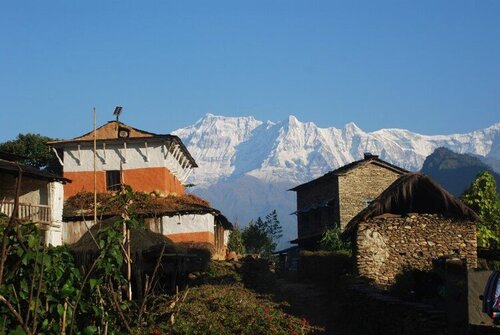
- Duration: 2- 4 days
- Maximum Elevation: 1,600 meters
- Starting and ending point: Pokhara
- Best season to travel: All year
With the Dhampus Sarangkot Trek, adventurers will embark on a journey to three renowned vantage points in Pokhara: Sarangkot, Dhampus, and Naudanda. Marvel at the panoramic spectacle of majestic mountains, including Annapurna I, Annapurna II, Fishtail, Annapurna South, Dhaulagiri, and Lamjung Himal.
Sarangkot, renowned for its enchanting sunrise over the Himalayas and captivating vistas of Lake Phewa and Pokhara city, is a favorite spot for paragliding enthusiasts. As you explore the area, you’ll encounter the Damai settlement. Dhampus, predominantly inhabited by Gurung communities, offers a glimpse into local culture and showcases warm hospitality. Throughout the trek, you’ll witness the authentic rural life of Nepal. This trek is particularly suitable for beginners and families, as it falls under the category of easy treks in Nepal.
Begin the trek with a hike to Sarangkot via Bagar, where you’ll be treated to breathtaking views of the Annapurna range and Phewa Lake. Witness an awe-inspiring sunset and rise early to witness one of Nepal’s finest sunrises. After breakfast, continue your trek to Naudanda, relishing the vistas of Pokhara Valley and Phewa Lake along the way. Traverse a forested trail leading to Dhampus Phedi, which marks the final leg of the journey. Conclude the adventure with a scenic drive back to Pokhara. Make sure to check out our Pokhara travel guide so you don’t miss out on anything while staying in the city of lakes!
3. Panchase Trek
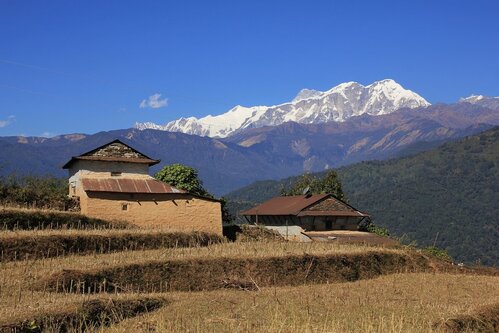
- Duration: 4-6 days
- Maximum Elevation: 2,500 meters
The Panchase Trek, ideal for beginners and families, is an emerging adventure in Nepal’s Annapurna region. This three-day trek leads you through dense forests and reveals breathtaking Himalayan vistas, including Dhaulagiri, Annapurna, Manaslu, and Lamjung Himal.
Explore the rich biodiversity of the Panchase region, boasting a wide range of orchids, walnut, oak, pine, and rhododendron ( Nepal’s national flower !) Around 125 species of orchids have been recorded in the Panchase region out of 381 known species. It is home to 19 species of mammals including spotted deer, civet cats, leopards, and various bird species like wildfowl, bulbuls, kingfishers, and parrots.
Your journey commences with a scenic boat ride across Phewa Lake, followed by a hike to the World Peace Pagoda in Pokhara . Trek to Bhumdi village, inhabited by Gurung and Brahmin communities. Then, ascend to Phanchase Bhanjyang, relishing captivating mountain views. Conquer Panchase Hill’s stone steps for a panoramic mountain vista. Finally, hike to Bhaduri and return to Pokhara by road.
4. Ghandruk Trek
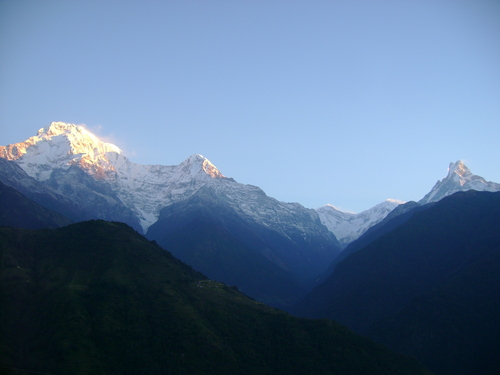
- Duration: 2-5 days
- Maximum Elevation: 2,012 meters
Discover the beauty of the Annapurna region by embarking on the Ghandruk Village Trek. CNN has recognized Ghandruk as one of Asia’s most picturesque towns , and you’ll soon understand why. Marvel at the breathtaking views of Annapurna South, Annapurna III, Gangapurna, and Himnchuli from this quaint mountain village. Immerse yourself in the rich Gurung culture by visiting the Gurung Museum and learning about their traditions.
Perfect for beginners and families, the Ghandruk trek is an easy and enjoyable experience. Begin your journey with a scenic drive from Pokhara to Kande, followed by a trek to Ghandruk through the charming village of Landruk. Wake up early to witness the magical sunrise over Ghandruk village, then descend to Modi Khola and hike up to Pothana via Deurali. The next day, trek to Nayapul via Siwai, marking the end of your trekking adventure. Finally, return to Pokhara by road, reminiscing about the stunning landscapes and cultural experiences along the way.
5. Annapurna Dhaulagiri Community Eco Trek

- Duration: 6-8 days
- Maximum elevation: 3,320 meters
Experience the beauty of the Annapurna region with the Annapurna Dhaulagiri Community Eco-Trek, also known as the Mohare Danda Trek. This week-long trek is ideal for beginners and families seeking a peaceful and secluded trekking experience. Marvel at the majestic mountains, including Annapurna South, Dhaulagiri, Nilgiri, and Huinchuli, as you traverse through the scenic landscapes. Immerse yourself in the local culture and traditions by passing through Gurung and Magar villages along the way.
Your adventure begins with a scenic drive from Pokhara to Banskharka, the starting point of the trek. Journey through picturesque mountain villages, soaking in the breathtaking mountain views as you make your way to Nangi. On the following day, trek through dense forests adorned with oak and rhododendron trees until you reach the mesmerizing Mohare Hill. This vantage point offers panoramic views of the Himalayas, allowing you to witness magical sunsets and awe-inspiring sunrises.
Continue your trek to Khibang, a small Eco-community village renowned for its community forest and homestay experiences. From there, proceed to Tikot village, a charming Magar settlement, before heading to the tranquil Tiplyang village nestled along the banks of the Kali Gandaki River. Finally, conclude your trek and return to Pokhara by road, cherishing the memories of the stunning landscapes and cultural encounters you experienced throughout your journey.
6. Ghorepani Poon Hill Trek
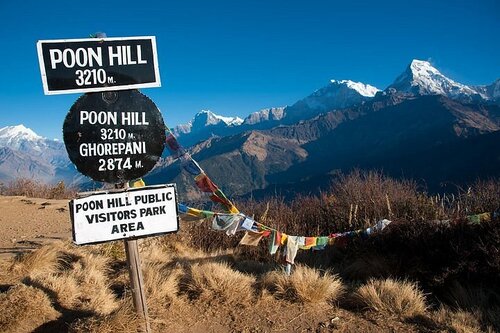
- Duration: 7 days
- Maximum Elevation: 3,210 meters
- Best season to travel: Spring (March and May) and autumn (Mid-September to November)
Experience the wonders of Ghorepani Poon Hill trek, an ideal choice for beginner adventurers and families in Nepal. In just a week, you’ll be immersed in the panoramic beauty of the Himalayas, witnessing captivating sunrises and sunsets from Poon Hill.
From this vantage point, be mesmerized by the majestic peaks of the Annapurna Range, Dhaulagiri, Nilgiri, Mardi Himal , and Huunchuli. Traverse the stunning landscape of the Annapurna Conservation Area Project, where rhododendron forests add vibrancy. Explore traditional Gurung and Magar villages, known for their warm hospitality and Gurkha soldier heritage.
Begin with a scenic flight from Kathmandu to Pokhara, then cab to Nayapool for permit checks. Trek from Nayapool to Birethanti, an easy hike, before ascending stairs to Ulleri. Continue through rhododendron-lined trails to Ghorepani. Reach the pinnacle at Poon Hill for a breathtaking sunrise and mountain panorama. Return the same way or head to Ghandruk for the final leg. From Ghandruk, walk to Kimchi and easily catch a jeep to Pokhara or Nayapool.
7. Royal Trek
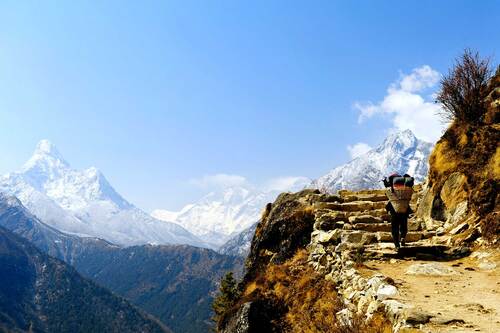
- Duration: 7-9 days
- Maximum Elevation: 1,730 meters
The Royal Trek unfolds as an exciting expedition in the Annapurna region, leading adventurers to the northern reaches of the Pokhara Valley. Its name derives from the notable visit of Prince Charles and his entourage in the early 1980s. Renowned for its accessibility, this trek stands as an ideal choice for beginners and families seeking an enriching experience. Along the trail, picturesque Gurung villages await, offering glimpses into the authentic rural lifestyle of Nepal.
From Pokhara, the trek officially starts at Bijayapur Khola. Surrounded by farmlands, adventurers tread their way to the serene village of Kalikasthan. The following day unveils a scenic passage through charming villages, accompanied by a trail adorned with vibrant rhododendron trees. Progressing towards Syaklung, trekkers are greeted with splendid vistas of the Annapurna and Lamjung Himal ranges.
Traverse through Gurung settlements, basking in the panoramic embrace of the Annapurna and Dhaulagiri ranges, before reaching the final destination of Chisapani. You will end the trek with a rejuvenating hike to Chisapani, and perhaps relish a tranquil boating experience on the tranquil waters of Begnas Tal before returning to Pokhara.
8. Everest Panorama Trek
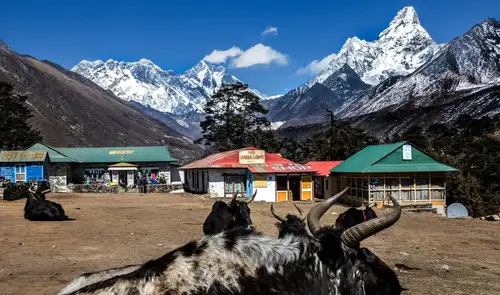
- Duration: 9 days
- Maximum Elevation: 3,885 meters
- Best season to travel: March to May (spring) and September to November (autumn)
Discover a mesmerizing journey awaiting you in the renowned Everest region through the enchanting Everest Panorama View Trek. This extraordinary adventure is carefully crafted to provide an unforgettable experience, perfect for beginners and families seeking an immersive taste of trekking. This extraordinary trek allows you to savor panoramic views of the majestic Himalayas, including the crown jewel itself, Mount Everest. Additionally, be prepared to be enthralled by towering peaks such as Lhotse, Nuptse, and Ama Dablam, among others.
As you traverse the renowned Sagarmatha National Park , a designated UNESCO World Heritage Site, you will witness the pristine wilderness that is home to a diverse array of wildlife. Keep a lookout for fascinating creatures such as musk deer, elusive snow leopards, graceful mountain goats, and colorful pheasants that add to the allure of the region.
Your adventure starts with a flight from Kathmandu to Lukla, a small mountainous town that serves as the gateway to the Everest region. From Lukla, you will embark on a trek along the tranquil banks of the Dudh Koshi river, leading you to the quaint village of Phakding. The trail meanders through verdant forests, offering a serene and enchanting experience.
Continuing your ascent, you will traverse the forested trail and make your way to the renowned Sherpa town of Namche Bazaar . Take a day to acclimatize to the high altitude while exploring the town’s charming cafes, delightful restaurants, souvenir shops, and lively pubs. To enhance your experience, hike to the Everest View Hotel, where you will be rewarded with a jaw-dropping panorama of Everest and its neighboring peaks.
The journey continues as you venture through the enchanting forested trail towards Tengboche, a spiritual haven nestled amidst the mountains. This revered destination is a significant center in the Khumbu region, where resident Rimpoche bestows blessings upon pilgrims, travelers, trekkers, and mountaineers. On clear days, the breathtaking views of Everest, the majestic Ama Dablam, and neighboring peaks will leave you spellbound, providing an experience that transcends the ordinary.
As the trek nears its end, you will retrace your steps back to Namche Bazaar, relishing the familiar trails and bidding farewell to the remarkable mountains that have captured your heart. The final leg of your journey involves a hike back to Lukla, then a flight back to KTM.
9. Khopra Danda Trek (Khopra Ridge Trek)
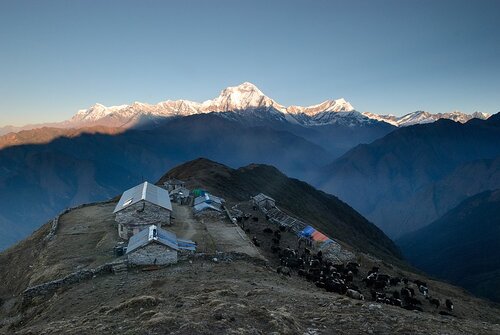
- Duration: 10 days
- Maximum Elevation: 3,900 meters
Indulge in the grandeur of the Himalayas as you begin the Khopra Ridge Trek in the lower Annapurna region. This newly opened trekking route offers a serene and secluded experience, making it an ideal choice for beginners, families, and those seeking tranquility amidst nature’s magnificence.
Prepare to be captivated by the breathtaking vistas of majestic mountains, including the mighty Dhaulagiri, the iconic Annapurna I, the enchanting Fishtail Mountain(Machhapuchhre ), the imposing Annapurna South, the majestic Manaslu, and the pristine Nilgiri.
A highlight of the trek is the opportunity to witness mesmerizing sunrises and sunsets from Muldai Peak, where nature paints the sky with vibrant hues, casting an ethereal glow upon the Himalayan panorama. Additionally, a rejuvenating experience awaits you at Tatopani, where you can immerse yourself in a natural hot spring, soothing your weary muscles and providing a well-deserved respite.
Your journey commences with a flight from Kathmandu to Pokhara, followed by a trek to Ghandruk, the starting point of this remarkable adventure. As you venture forward, a forested trail will guide you to Tadapani, where the beauty of nature unfolds before your eyes. Continuing onwards, you will hike past charming hillside villages, leading you to Dobato, where scenic ridgeline walks offer awe-inspiring mountain views.
The trail will then lead you to Khopra Danda, a vantage point that presents a panoramic tapestry of the Himalayas. Take a moment to soak in the majestic vista as you acclimatize to the altitude. For those seeking an extra adventure, an optional hike to the sacred Khayer Lake awaits, providing a glimpse into the spiritual significance cherished by Hindus.
As your trek progresses, you will head towards Tatopani. It is a natural hot spring and can get a quick rejuvenating dip. From Tatopani, you have the option to either fly back to Pokhara or embark on a scenic bus journey to Kathmandu, allowing you to savor the memories of your incredible trek.
10. Tamang Heritage Trail
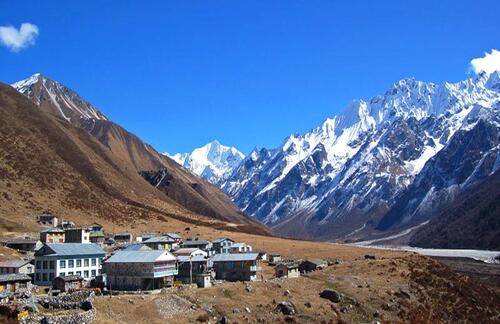
- Duration: 14 days
- Maximum Elevation: 2,380 meters
The Tamang Heritage Trail presents the rich culture and traditions of the Tamang ethnic group, heavily influenced by Tibetan culture. With deep roots tracing back to Tibet, the Tamang people possess a distinct language and heritage (see language in Nepal for more details!) Originally horse traders from Tibet, settled in the hilly region of Nepal many centuries ago. This trek, known for its ease and suitability for beginners and families, also holds a significant purpose in directly supporting the rural economy of Nepal.
Located near the Nepal-Tibet border in the Langtang region, close to the Kathmandu valley, the trek takes you through a trail enveloped by dense forests and lush green farmlands. Revel in the breathtaking vistas of the Langtang range, Ganesh Himal, Gosaikunda range, and neighboring Tibetan peaks.
You will drive from Kathmandu to Syabrubesi, the starting point of the trek. Then you will hike from Syabrubesi, marveling at the majestic Himalayas en route to the Tamang village of Gatlang. Continue your ascent towards River Thangbuchet and onward to Tatopani, where you can luxuriate in the soothing hot springs. Progressing further, reach Nagathali Danda, a vantage point offering captivating Himalayan views, before continuing your trek to Thuman, another enchanting Tamang village. As you approach Briddim, you will traverse near the Nepal-Tibet border, eventually returning to Syabrubesi. Explore the small town’s handicraft shops, where local items are available for purchase.
Is Trekking Insurance Mandatory For these Beginner Treks in Nepal?
Trekking insurance is mandatory while trekking in Nepal if you need to get permits for conservation areas. However, some of the local treks around Pokhara and Kathmandu will not require trekking insurance as you will not need a TIMS Pass or other conservation permit.
That being said, trekking insurance is always a good ideas as it offers financial security and peace of mind for trekkers in the event of unexpected situations, such as medical emergencies, evacuations, or unforeseen circumstances. It typically includes coverage for medical expenses, emergency medical evacuation, trip interruption or cancellation, and the loss or theft of personal belongings.
If you are looking for specific suggestions for insurance policies, check out our best insurance for trekking in Nepal guide!
Helpful Tips For Beginner Trekkers in Nepal
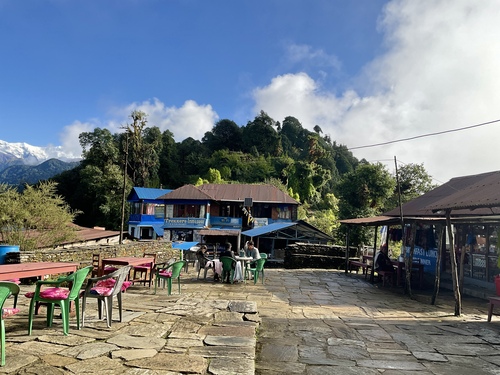
Here are some essential tips for beginners and families embarking on these easier treks in Nepal.
- Beginner trekkers and families with young children can easily undertake these treks without complications. So, if you’re new to trekking or have young ones with you, these treks are a great starting point. You can check out our backpacking for beginners blog to help you get ready for your big trek!
- Generally, easy treks have shorter itineraries, but feel free to customize it according to your preferences. Shorter itineraries don’t mean you do not need to plan accordingly. Check out our guide that covers how to plan a backpacking trip !
- Since easy treks don’t require long hours or weeks of hiking, you can opt for a lighter hiking backpack . However, don’t forget to pack essential items.
- It’s important to be mindful about your alcohol and drug intake while trekking, as they can have adverse effects on your health at higher altitudes.
- If you’re trekking above 2,500m, familiarize yourself with high altitude sickness (AMS) and its symptoms.
- Along with staying hydrated during the trek, it’s crucial to carry a first aid kit, personal medications, and toilet paper for your convenience and safety. See our backpacking checklist to know exactly what you need to pack for your trek!
Beginner Treks in Nepal: Hike and Backpack through the Himalayans
No matter your skill level, there are plenty of trekking routes in Nepal. With careful planning, these 10 beginner treks in Nepal are a great way for newbies to take advantage of the beautiful nature and environment Nepal has to offer.
These treks are also great for families traveling in Nepal as they are accessible for adults and children of all ages. With lower altitudes and closer proximity to villages you can feel safe and secure hiking through the country side. Have a look at the 10 beginner treks in Nepal that we listed out, and take part in an unforgettable vacation in Nepal!
FAQs: Beginner Treks in Nepal
Below are some of the most frequently asked questions regarding Beginner Treks in Nepal.
The easiest trek in Nepal is the Royal Trek. Located in the Annapurna region, this trail takes you through the picturesque foothills north of the Pokhara valley. In 1981, Prince Charles and his entourage embarked on this route, bestowing it with the name “Royal Trek.”
Yes, there are easy hikes in Nepal, one of them being the Poon Hill Trek. It is perfectly suited to beginners and families.
Renowned as Nepal’s top trekking destination, the Annapurna Circuit offers one of the most scenic treks in Nepal. Throughout your journey, you will walk through diverse landscapes, from breathtaking valleys and dramatic gorges to serene rivers, pristine lakes, magnificent glaciers, and majestic snow-capped peaks.
Leave a Reply Cancel Reply
Your email address will not be published. Required fields are marked *
Add Comment *
Save my name, email, and website in this browser for the next time I comment.
Post Comment

Passing Thru Travel
The 10 Best Treks in Nepal’s Majestic Mountains 2024
Posted: February 21, 2024 | Last updated: February 21, 2024
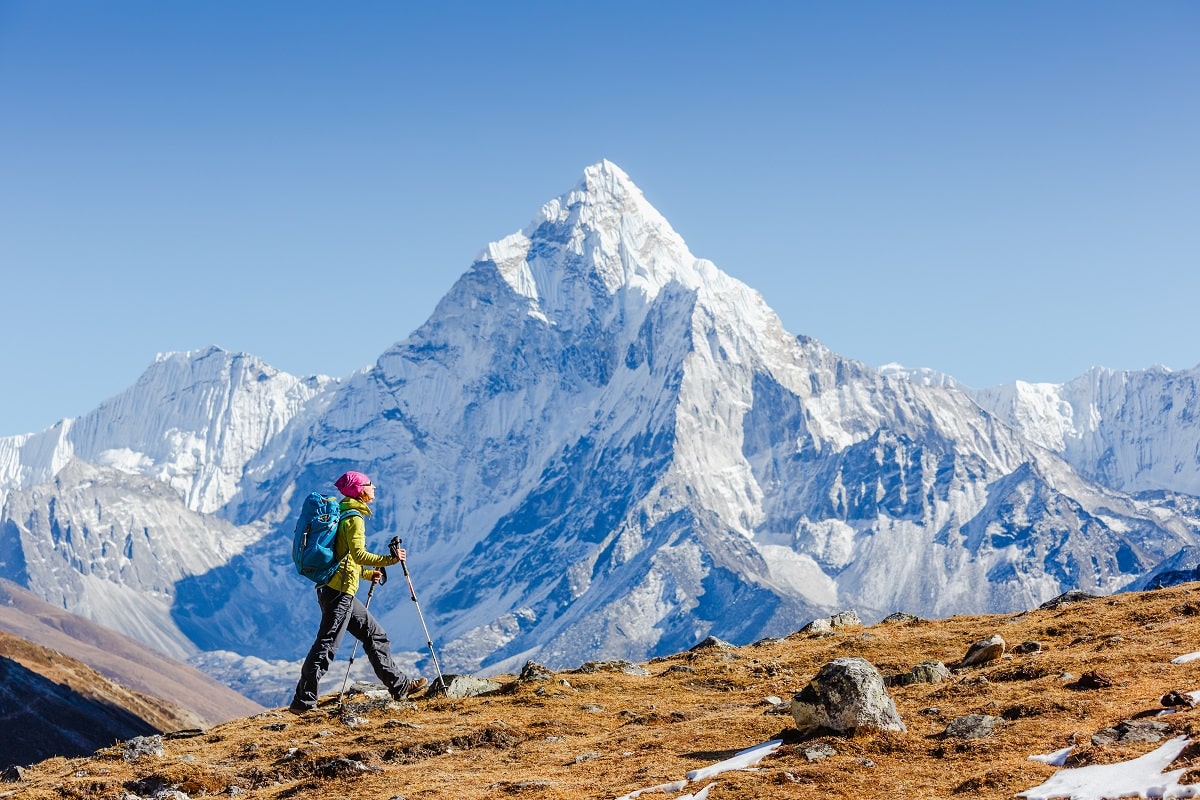
Nestled between the towering peaks of the Himalayas, Nepal is a land of unparalleled natural beauty and a haven for trekkers. From the iconic Everest Base Camp to the serene trails of the Annapurna region, Nepal’s mountains offer a diverse array of trekking experiences, each more awe-inspiring than the last. This guide will take you through 10 of Nepal’s most majestic mountain destinations, providing insights and practical advice for your trekking adventure.
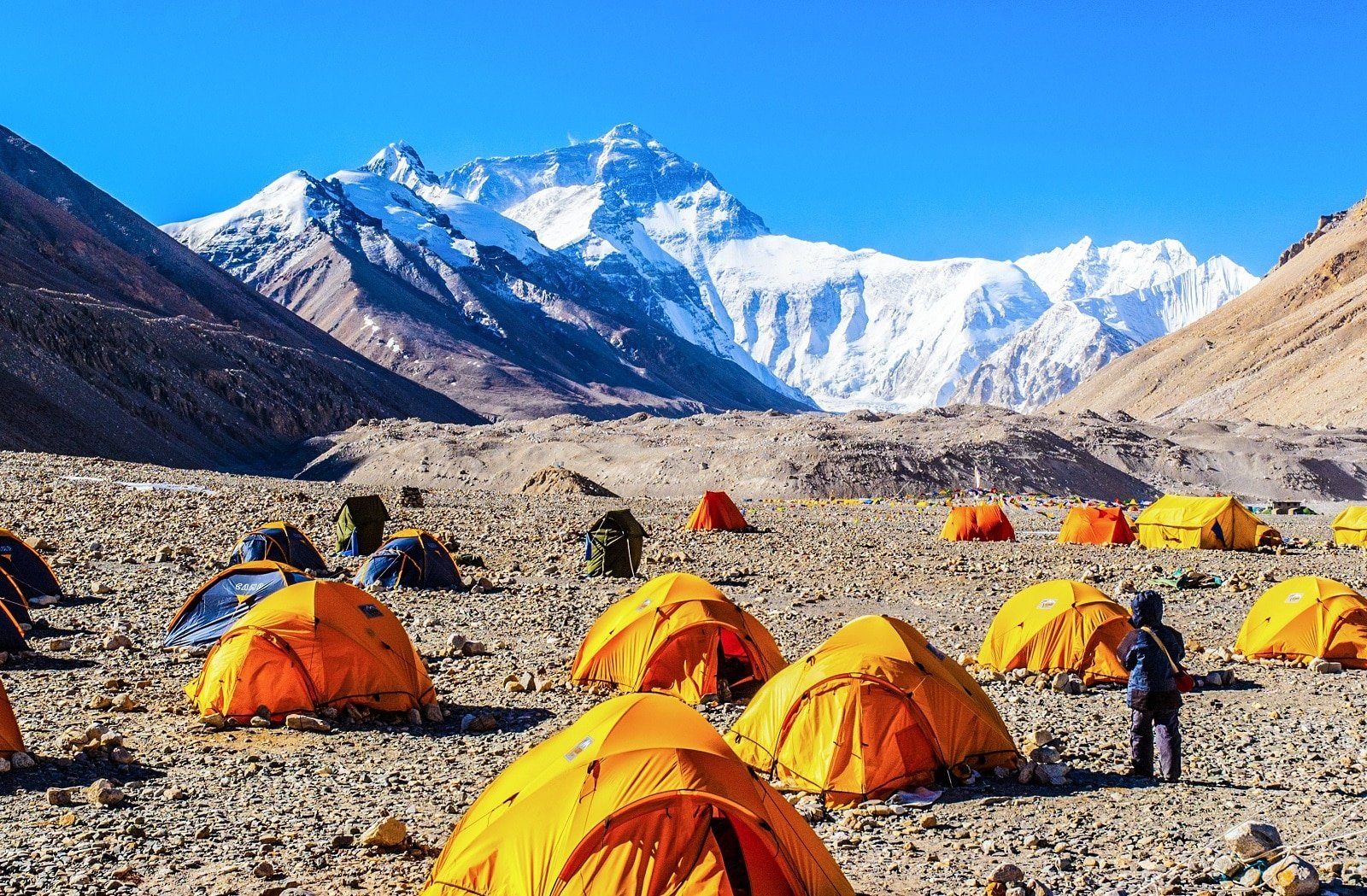
1. Everest Base Camp
Embarking on the Everest Base Camp trek, you’ll journey through the heart of the Himalayas, where the world’s highest peaks, including Everest, Lhotse, and Nuptse, tower above. Starting with a thrilling flight to Lukla, the trek takes you through traditional Sherpa villages, Buddhist monasteries, and along the Dudh Kosi River. The route is challenging yet rewarding, with acclimatization days in Namche Bazaar and Dingboche. The final ascent to Base Camp offers a stunning view of the Khumbu Icefall, making all the effort worthwhile.
Insider’s Tip: Acclimatize properly to avoid altitude sickness.
When To Travel: Pre-monsoon (March to May) or post-monsoon (September to November).
How To Get There: Fly to Lukla from Kathmandu and start your trek from there.
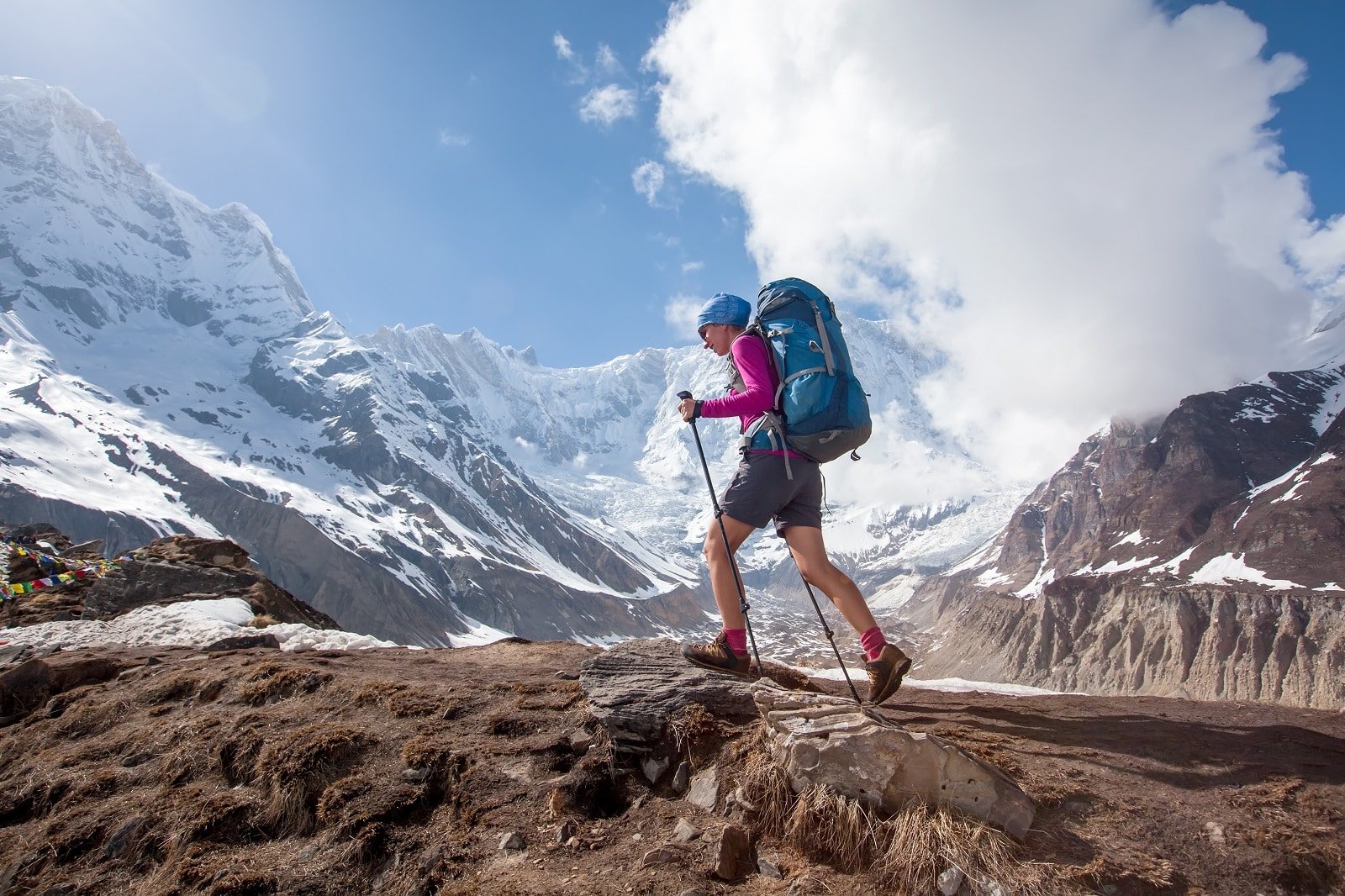
2. Annapurna Circuit
The Annapurna Circuit is a classic trek that takes you around the majestic Annapurna massif. This journey offers a remarkable diversity of landscapes, from the subtropical jungle of the Marshyangdi Valley to the arid, Tibetan-like terrain of the Upper Mustang. Crossing the Thorong La Pass, the trek’s highest point, is a challenging but exhilarating experience. The trek also allows for cultural immersion in the mountain communities of the Gurung and Manangi people.
Insider’s Tip: Take side trips to the ice lakes or Tilicho Lake for additional stunning views.
When To Travel: March to May and October to November for the best weather conditions.
How To Get There: The trek typically starts in Besisahar or Bhulbhule, accessible by road from Kathmandu or Pokhara.
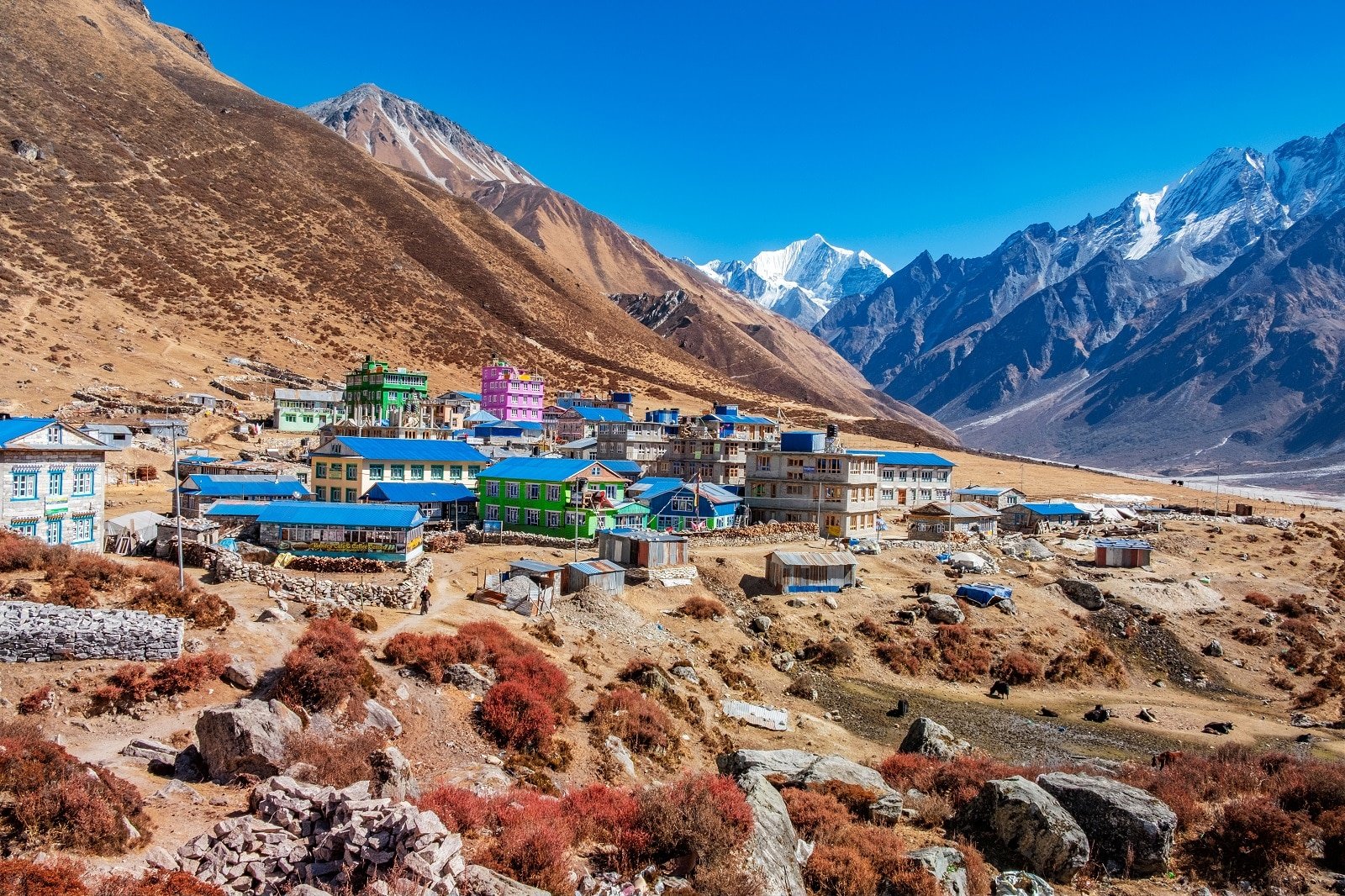
3. Langtang Valley
The Langtang Valley trek offers a quieter, more intimate Himalayan experience. It begins with a drive to Syabrubesi and a trek through forests, pastures, and traditional villages. The valley provides close-up views of Langtang Ri and Langtang Lirung. The trek also includes a visit to Kyanjin Gompa, a significant Buddhist monastery, and an optional climb to Tserko Ri for panoramic mountain vistas. This region was heavily affected by the 2015 earthquake, and trekking here supports local recovery efforts.
Insider’s Tip: Extend your trek to Gosaikunda Lake for a spiritual experience.
When To Travel: March to May and September to November for clear skies and pleasant temperatures.
How To Get There: Drive to Syabrubesi from Kathmandu, the starting point of the trek.
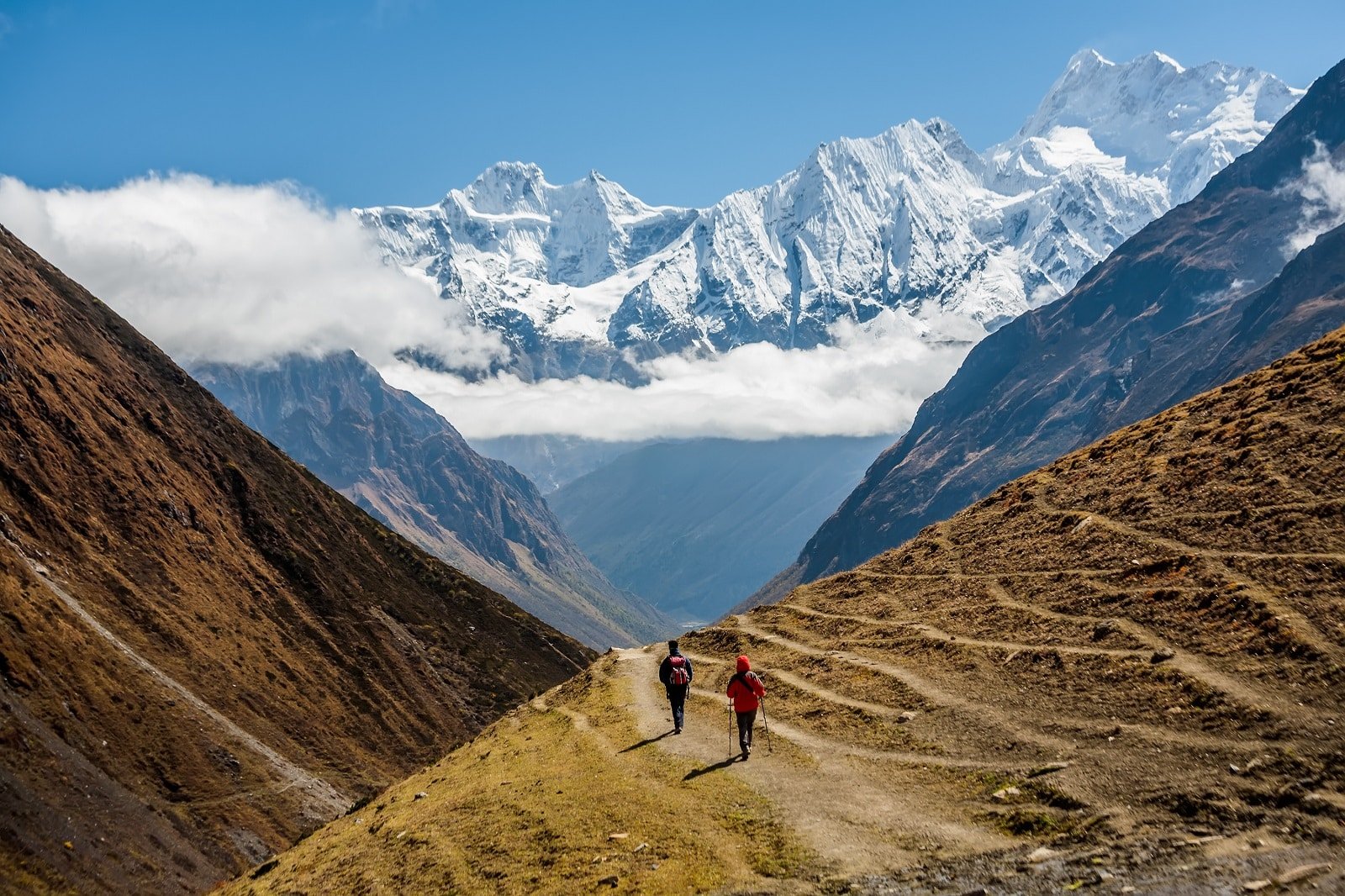
4. Manaslu Circuit
The Manaslu Circuit trek circles the majestic Manaslu, the world’s eighth-highest peak. This trek is less crowded than its more famous counterparts. It offers a look into the untouched natural beauty and culture of the Nepali Himalayas. The trek involves crossing the Larkya La Pass and traverses through Budhi Gandaki Valley, known for its mix of Hindu and Tibetan Buddhist villages. The circuit is a challenging trek, blending cultural richness and scenic splendor.
Insider’s Tip: Ensure you have a guide, as the Manaslu trek requires special permits.
When To Travel: March to May and September to November are ideal.
How To Get There: The trek starts at Arughat or Soti Khola, which can be reached by bus or jeep from Kathmandu.
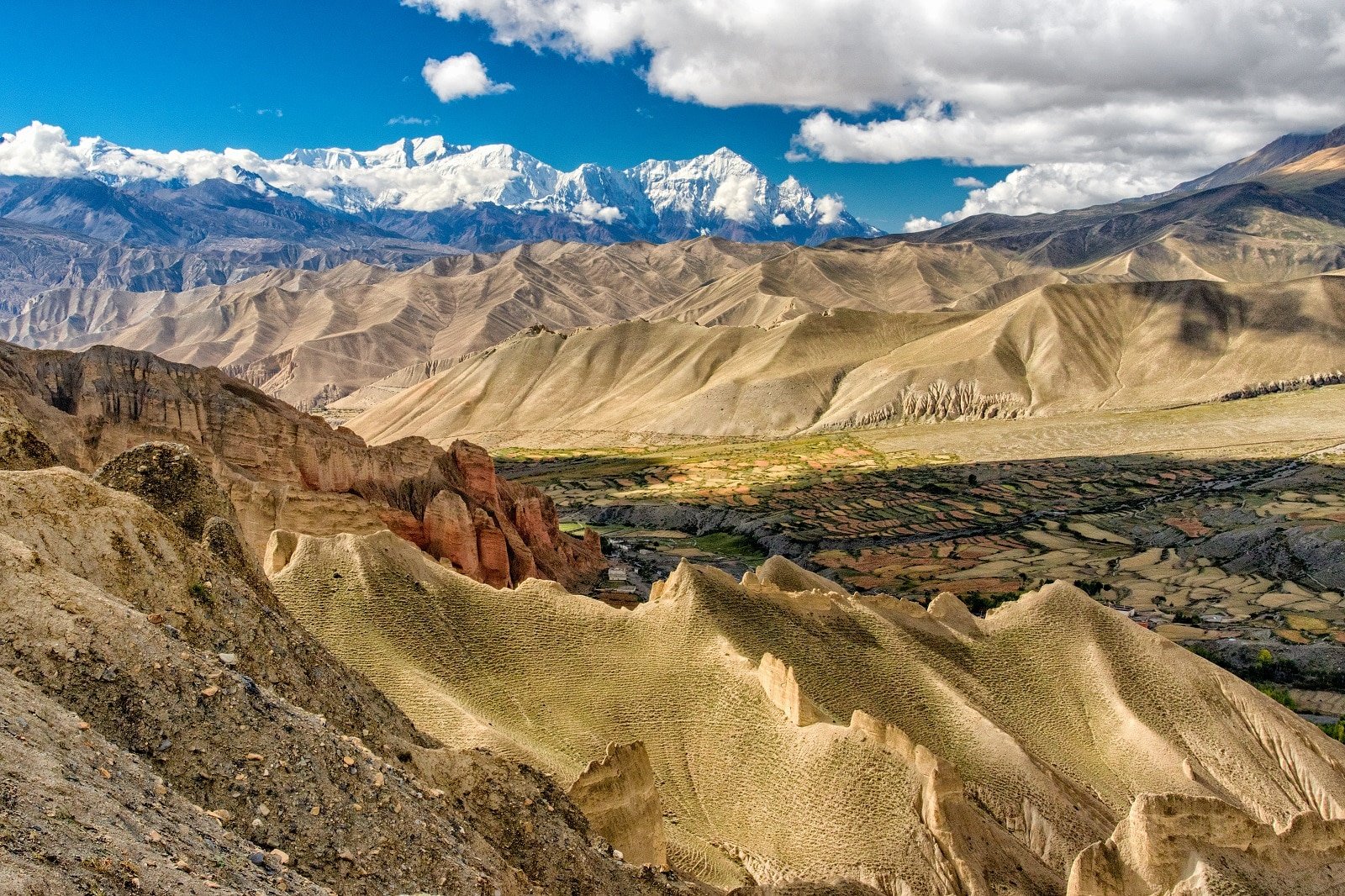
5. Upper Mustang
Trekking in Upper Mustang takes you to a region that was once an independent kingdom. The landscape here is more desert-like, characterized by eroded canyons and colorful stratified rock formations. Lo Manthang, the walled capital, is a highlight, with its monasteries and royal palace. This area is culturally and geographically more akin to Tibet, offering a unique trekking experience distinct from the rest of Nepal.
Insider’s Tip: Visit the ancient monasteries and the royal palace in Lo Manthang. Stay at the beautiful Shinta Mani Mustang.
When To Travel: May to October, as the region lies in the rain shadow area.
How To Get There: Fly or drive to Jomsom, then trek or drive to Lo Manthang.
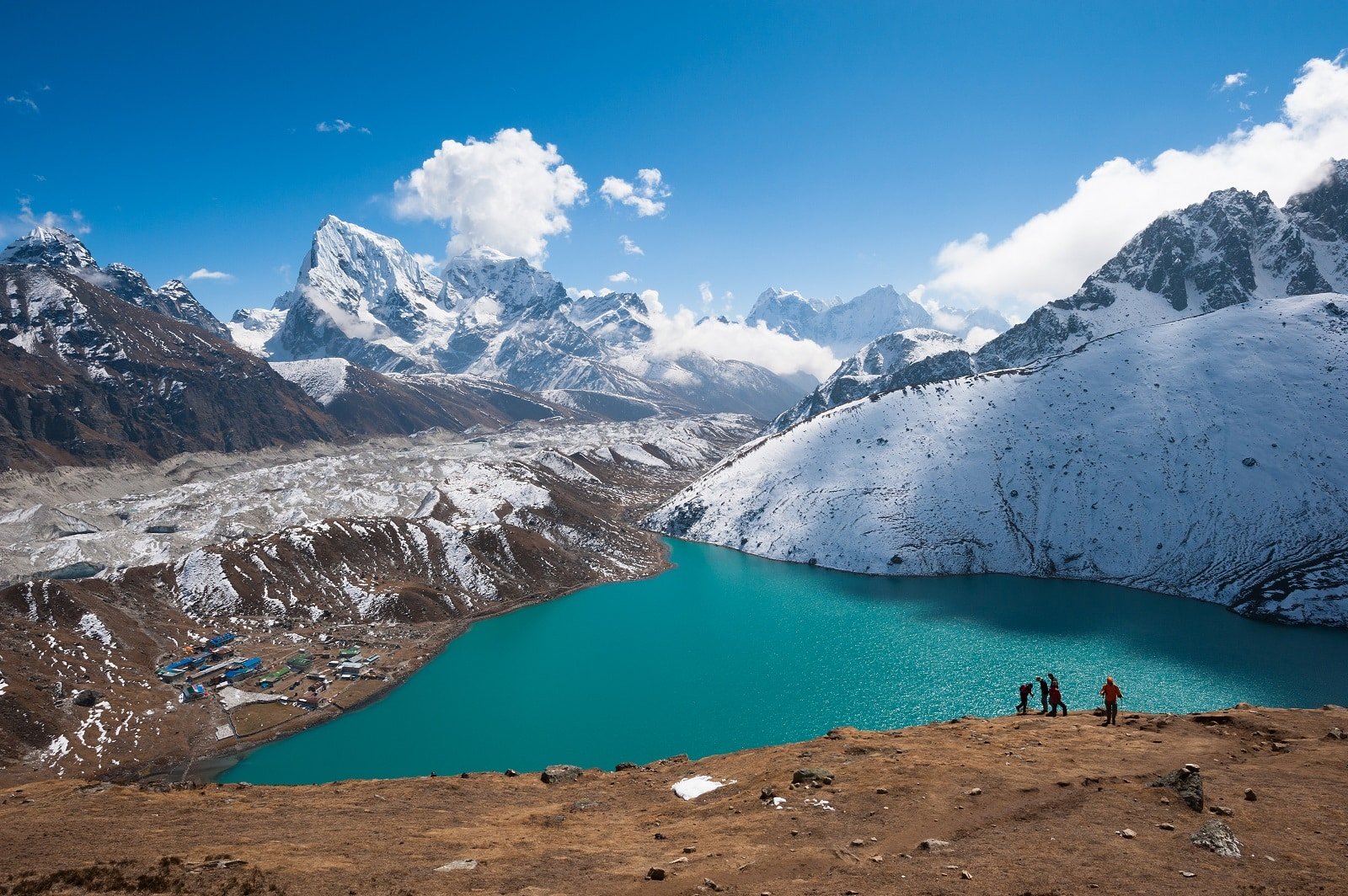
6. Gokyo Lakes
The Gokyo Lakes trek is a fantastic alternative to the Everest Base Camp trek, taking you to a series of stunning high-altitude lakes in the Gokyo Valley. The trek is less crowded and provides spectacular views of Everest and surrounding mountains. Climbing Gokyo Ri offers one of the best viewpoints in the Everest region. The trek passes through Sherpa villages, offering insight into the local culture.
Insider’s Tip: Trek during the full moon for spectacular night views of the mountains.
When To Travel: March to May and September to November for the best weather.
How To Get There: Similar to Everest Base Camp, fly to Lukla and follow a different trail.

7. Poon Hill
The Poon Hill trek is ideal for those looking for a shorter hike in the Annapurna region. It’s known for offering some of the most spectacular mountain views, especially at sunrise from Poon Hill itself. The trek passes through rhododendron forests and Gurung villages, giving you a chance to experience the culture of the central Himalayan region. The trek starts and ends in Nayapul, a short drive from Pokhara.
Insider’s Tip: Carry enough cash, as there are no ATMs on this route.
When To Travel: October to November and March to April for clear skies and good weather.
How To Get There: The trek starts from Nayapul, which is a short drive from Pokhara.
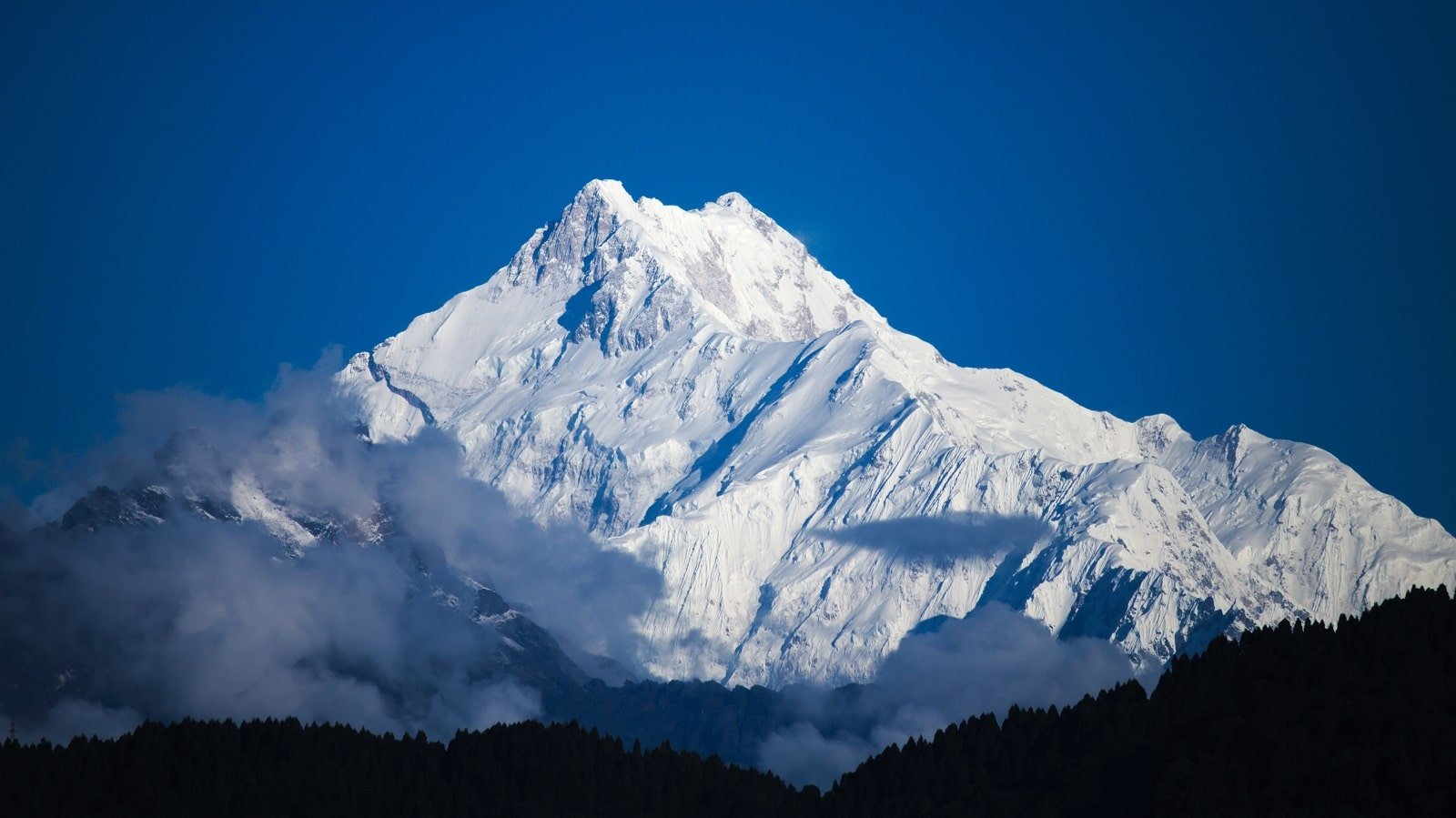
8. Kanchenjunga Base Camp
The Kanchenjunga Base Camp trek is a challenging and adventurous journey to the base of the world’s third-highest mountain. This remote trek offers stunning views of Kanchenjunga and a chance to experience pristine wilderness. The trek passes through diverse ecosystems, traditional villages, and high alpine terrain. It’s a trek for those seeking solitude and unspoiled nature.
Insider’s Tip: Be prepared for basic accommodations and facilities, as this is a less developed trekking route.
When To Travel: March to May and September to November for stable weather.
How To Get There: Fly or drive to Bhadrapur, then drive to Taplejung, the starting point of the trek.
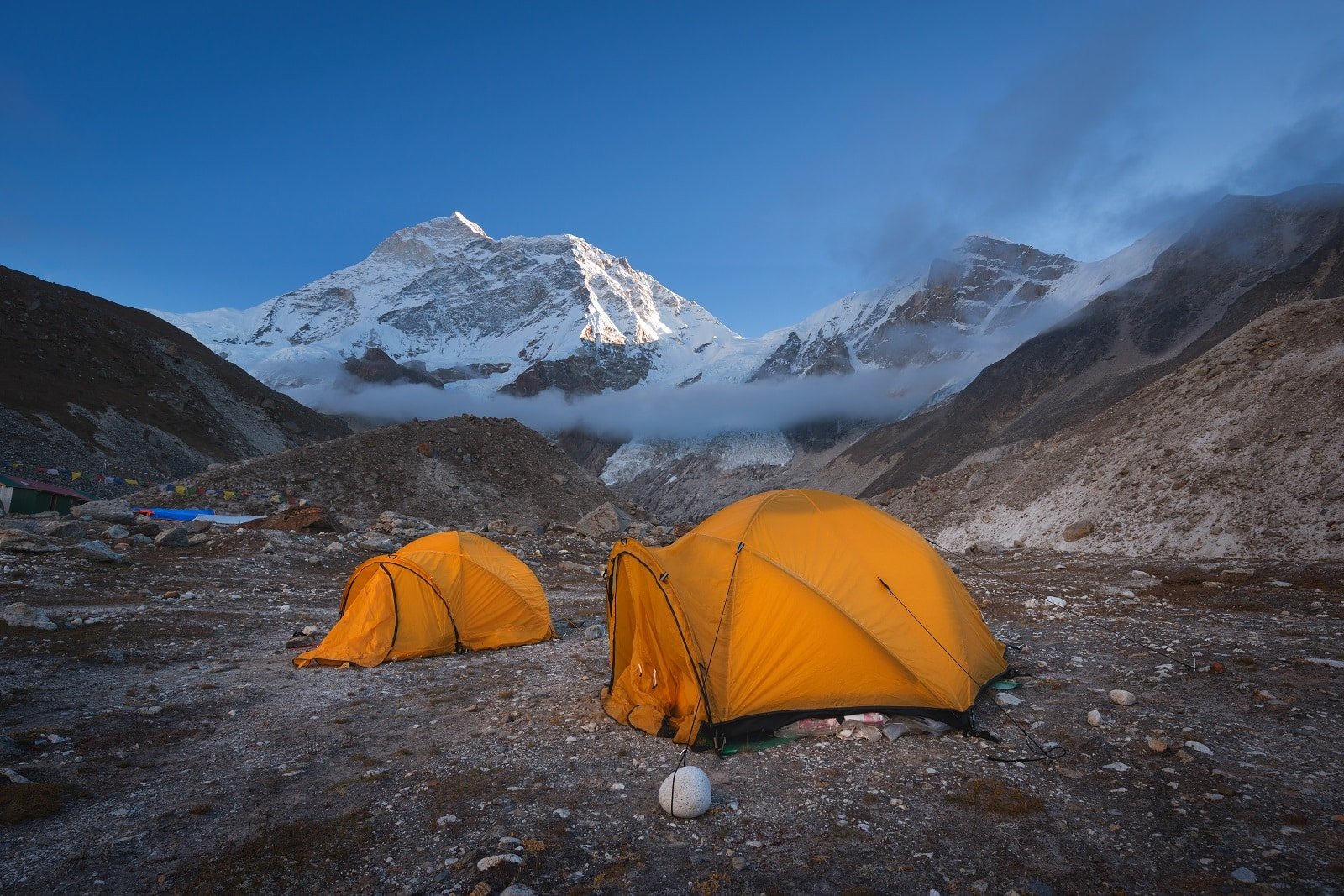
9. Makalu Base Camp
The Makalu Base Camp trek is a challenging journey to the base of Mount Makalu, the world’s fifth-highest mountain. This trek takes you through some of Nepal’s most remote and wild areas, offering stunning views of the eastern Himalayas. The Makalu Barun National Park, through which the trek passes, is a biodiversity hotspot with a rich variety of flora and fauna.
Insider’s Tip: Be physically and mentally prepared for a challenging trek with basic facilities.
When To Trave: Pre-monsoon and post-monsoon periods for the best conditions.
How To Get There: Fly to Tumlingtar from Kathmandu, then drive to Num, the starting point of the trek.
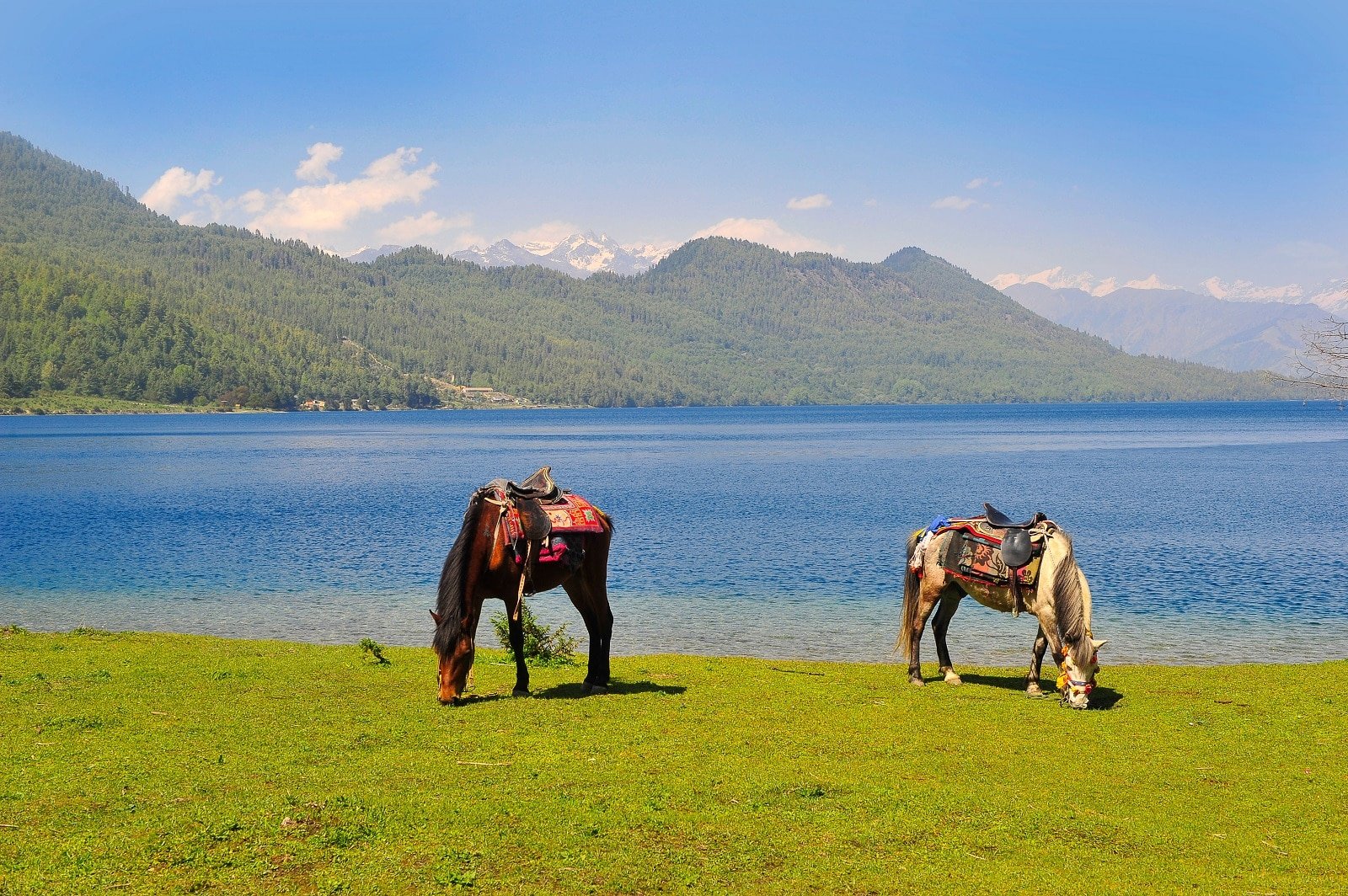
10. Rara Lake
Trekking to Rara Lake offers a serene experience away from the more popular trekking routes. Rara, the largest lake in Nepal, is known for its clear blue waters and scenic beauty. The trek to the lake is an adventure in itself, passing through remote Jumla and Mugu districts. The area around the lake, Rara National Park, is home to a variety of wildlife and offers tranquility unmatched in other parts of Nepal.
Insider’s Tip: Visit the nearby Rara National Park for a chance to see unique wildlife.
When To Travel: September to October and April to May for the best trekking conditions.
How To Get There: Fly to Nepalgunj from Kathmandu, then to Jumla, from where the trek to Rara Lake starts.
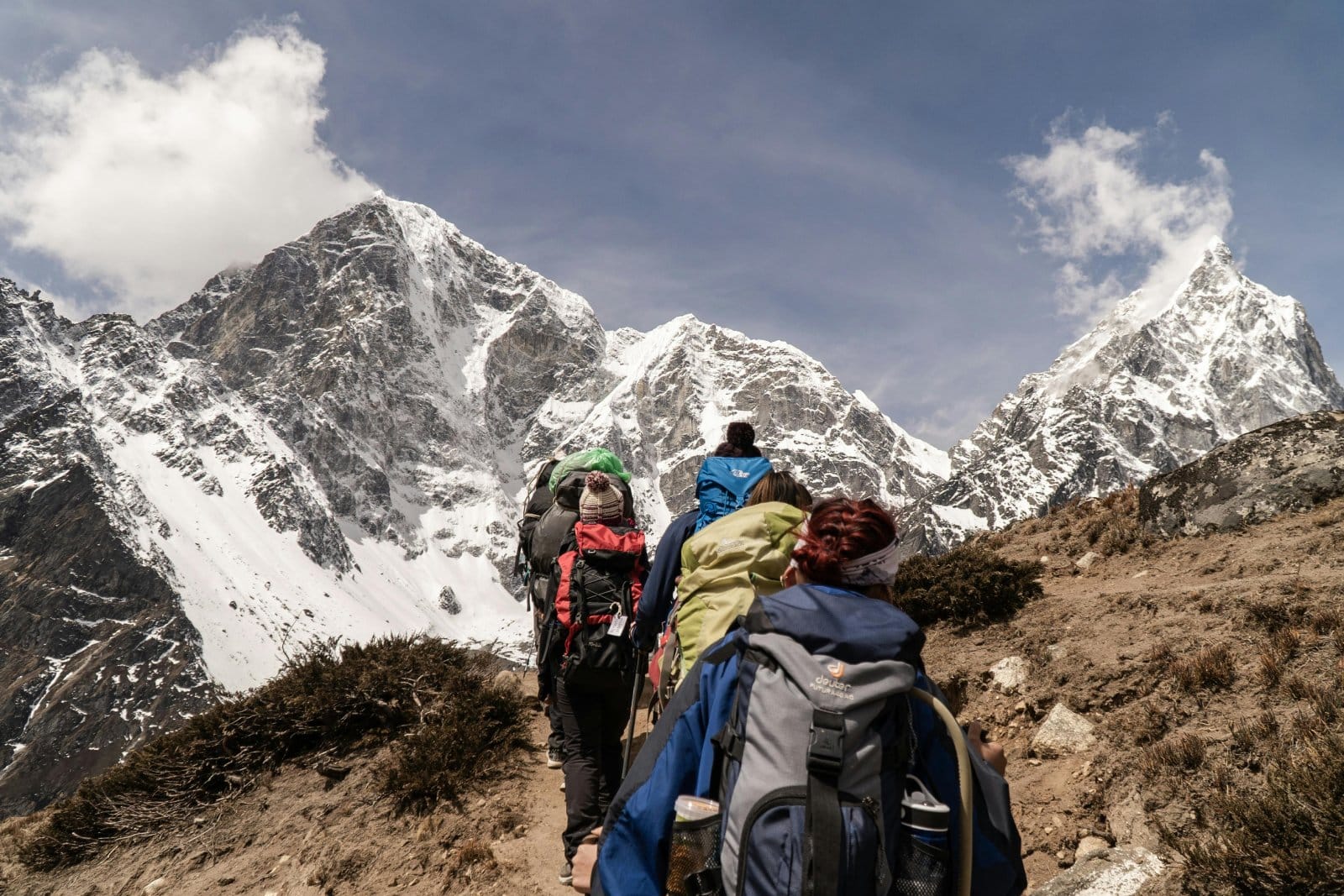
The Bottom Line
Trekking in Nepal is more than a physical journey; it explores some of the most majestic landscapes on Earth. Each destination offers its unique charm, from the world-renowned Everest Base Camp to the tranquil trails of Rara Lake. As you trek through these mountains, you’ll not only witness breathtaking vistas but also immerse yourself in the rich culture and hospitality of the Nepali people. Pack your bags, lace up your boots, and prepare for an adventure that will leave you with memories to last a lifetime.
More Articles Like This…
Barcelona: Discover the Top 10 Beach Clubs
2024 Global City Travel Guide – Your Passport to the World’s Top Destination Cities
Exploring Khao Yai 2024 – A Hidden Gem of Thailand
The post The 10 Best Treks in Nepal’s Majestic Mountains 2024 was republished on Passing Thru with permission from The Green Voyage .
Featured Image Credit: Shutterstock / Olga Danylenko.
For transparency, this content was partly developed with AI assistance and carefully curated by an experienced editor to be informative and ensure accuracy.
More for You
California Fast Food Chains Have Found a Way to Bypass Rising Minimum Wages—And It's Bad News for Staff
Beware, Swifties. A major British bank just issued a warning after fans lost an estimated $1 million in Taylor Swift concert ticket scams
Why You Should Be Putting Aluminum Foil Behind Your Router
Opinion: Taliban leaders enforce brutal restrictions against women, except for their own daughters
Martin Lewis issues warning to people choosing air fryer over oven
Veteran fund manager updates outlook for stocks after correction
I moved my family from California to Austin, Texas, and regretted it. Here are 10 things to consider before making an expensive mistake.
Patti Smith Comments on Taylor Swift Name Dropping Her in the Tortured Poets Department
21 of the absolute best fictional princesses
Fallout Shelter: Best Outfits For Exploring The Wasteland
If You See Black Residue on Your Cast-Iron Skillet, This Is What It Means
Should you leave your laptop plugged in all the time?
The most expensive state to live in isn't California or New York, based on data. Here are the top 10.
Our Handyman Explains How Often You Should Lubricate Your Garage Door Springs
The right starts to reckon with its Marjorie Taylor Greene problem
Frightening map shows the best parts of the United States to withstand a nuclear apocalypse
If You Invested $1,000 in Taiwan Semiconductor in 1997, This Is How Much You Would Have Today
Ghosts of the USA: The Most Haunted Places in America
See what 25 legendary hip-hop artists look like now
Strawberry-Rhubarb Breakfast Cake Will Make Everyone Spring Out Of Bed

- Best Hikes In The World
- Appalachian Trail
- European Hikes
- Nepal Hikes
- Patagonia Hikes
- See All Hikes
- Mount Kenya
- Mount Kilimanjaro
- Mount Toubkal
- See All Mountains
- South Africa
- New Zealand
- Switzerland
- United Kingdom
- Packing Lists
Best Time To Trek In Nepal (And When To Stay Away)
The best time to trek in Nepal depends on which Nepal hiking routes you have chosen, and the altitude of the passes. Another important deciding factor is whether you can deal with cold or are prepared to risk getting wet!
Some regions are inaccessible over the winter time when snow blocks high mountain passes. Monsoon rains play a big role when planning your trip to Nepal. Some places are too humid during summer or completely flooded out.
In this guide, I'll go through each of Nepal's seasons and discuss their suitability for trekking. We will take a look at the country's main trekking regions and the ideal time to trek these areas. Finally, I'm going to suggest some key gear to pack for your Nepal trek.
When Is The Best Time To Hike In Nepal?
Generally speaking, the best time to trek in Nepal is post-monsoon September-November. This is peak trekking season. Temperatures are fair and the weather is about as stable as you can hope for. Skies are also clear this time of year so hikers get the stunning mountain views.
Nepal is a diverse country with different regions and their own weather patterns. If you are planning your Nepal trek , you should be aware that weather can be unpredictable. Mountainous regions are notorious for storms, rain, and snow, even during ‘good hiking months’.
Nepal Trekking Seasons
Pre-monsoon, spring.
The pre-monsoon season lasts from February to late April. This is Springtime in Nepal. During the start of the season, the temperatures are chilly becoming mild as the months progress.
In the lower ranges and hills ( 800-2,000m (2,600-6,600ft) temperatures range from about 16-23ºC (61-73ºF). On the 5000m + mountain passes, including Cho La, Larkya La and Thorung La, the snow starts to melt and paths clear for hiking.
One of the best things about trekking Nepal in Spring is that the rhododendron bushes and wildflowers are in bloom. The days are usually sunny and warm, while nights can be chilly, especially at higher altitudes.
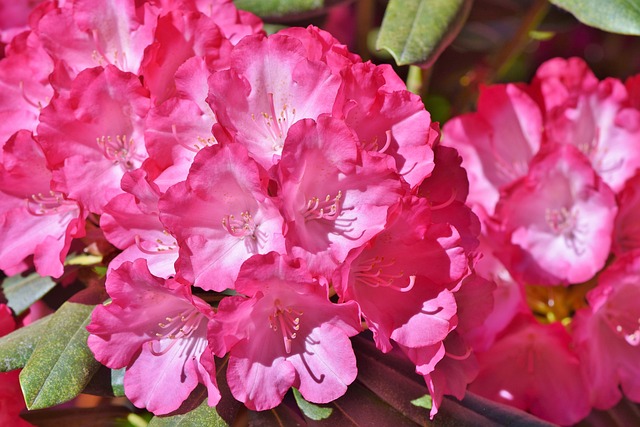
If you are planning to fly in to Nepal trekking regions, February to April is a fairly safe bet. Skies are usually clear and there is less chance of flight cancellations
One downside to hiking in Spring is that the trail can be quite dusty. There can also be occasional rain showers. There is more of a haze in lower altitudes over the Springtime, you may need to climb higher up the mountains for a clear panoramic view.
In early May, the weather is normally still good for hiking. Be aware that the later in Spring you hike, the more chance of rain. It also gets more humid in low-lying areas closer to summer
Post Monsoon, Fall
October-November is Fall in Nepal. Temperatures in the hills and lowlands are cool and comfortable, averaging between 15-24ºC (59-75ºF). Most people consider this the ideal time for hiking in Nepal, at least in terms of climate.
Following the rains, the dust and pollution have settled and trekkers get clear views. This lasts throughout the day and into the afternoon. By late November, the evenings start to get a lot colder, especially higher up. Be prepared by packing a good, low-temperature sleeping bag .
Fall is also the busiest trekking season. Expect to find many trekkers on the trails. You will also find that the Nepal tea houses are full over these months. Everest Base Camp and Annapurna Circuit are particularly popular routes and become crowded over this time.
Shoulder Months - September and December
The shoulder months for trekking in Nepal can be the best time of the entire year. Late September and early December are an opportunity to miss the bulk of the crowds, post- monsoon.
Trekking on the edge of the season is rolling the dice in terms of rain. It’s almost impossible to be sure that the monsoon won’t last longer or winter snows arrive early. If you do get lucky, the weather can be just as good as peak season with less than half the people around.
The end of December starts to become too cold. Plus, many tea house accommodations close at this time.
Monsoon Season
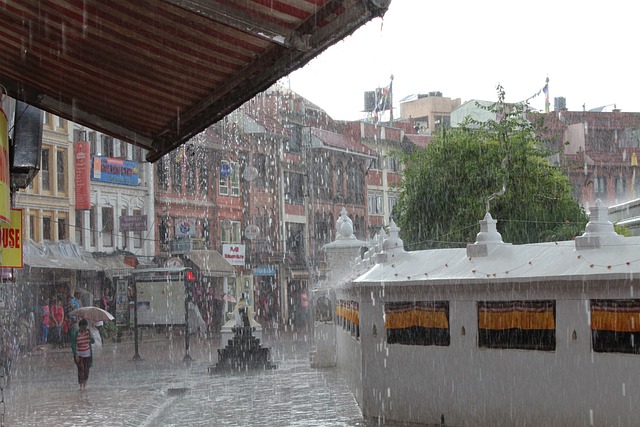
May through to August (and even mid-September) is not the best time to hike in Nepal. This is summertime which co-incides with the Monsoon rains.
Temperatures are high, averaging between 27/29 °C (81/84 °F) reaching above 40 °C (104°F) in the lowlands. Moisture rises off the Indian oceans and condenses.
You can expect lots of cloud coverage, haze and frequent heavy downpours. This is most intense over July. In the lower regions, trekking is still unpleasant with trails getting very muddy and lots of leeches around.
From July onwards, things tend to calm down as it gets closer to fall. Note: If you do want to do Himalayan trekking between June-August, opt to visit the Indian Himalayas. The Ladakha region stays mostly dry throughout the summer. Trekking around Ladakha also has the benefit of a lot fewer trekkers than Nepal. Check out the Markha Valley Trek .
Can You Trek Nepal in Winter? (December-February)
Trekking Nepal in Winter is not generally recommended. This is for two main reasons:
Firstly, It’s extremely cold. During the day, temperatures range between about 1-12ºC (33-54ºF) . This drops well below zero during the night.
Secondly, most high altitude passes are covered in snow and closed to trekkers between November-March. Inaccessable passes include Thorong La (Annapurna), Kongma La and Cho La (in the Everest reason).
If you have a high cold tolerance and don’t mind sticking to lower trails and mid-altitudes, you may actually enjoy December trekking in Nepal. There are much fewer hikers on the trails. The cooler air can be nice and refreshing around Christmas and New Year.
Note: Most tea house accommodation do not have heating. Thermal layers of clothing are an essential packing item for winter hikes in Nepal.
Best Time To Hike In Nepal - By Region
Higher regions - annapurna base camp, everest.
The high lying regions including Everest and the Annapurna region are best trekked in the post-monsoon months. This is because there is less chance of avalanches and snowfall. Temperatures also warm up to acceptable levels during this time.
Planning on hiking the Annapurna circuit? Check out this article on Annapurna circuit weather .
Manaslu and Langtang Valley
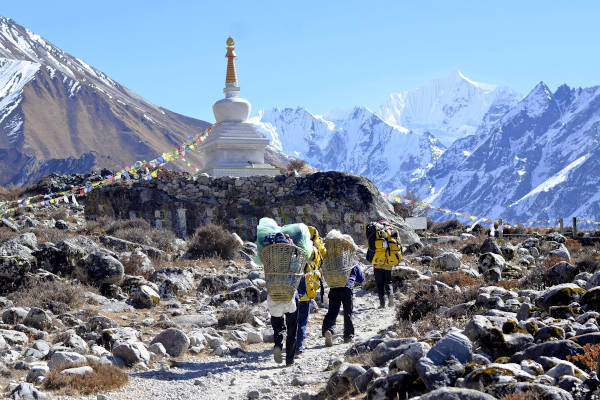
Langtang valley and Ghorepani Valley (Poohill Trek) regions are not as susceptible to snow or avalanches. This means the treks like the Langtang Valley Trek and Manaslu circuit are open during the pre-monsoon season. It's a good time to hike as temperatures are milder and the trails are less crowded.
These regions are also open for trekking over the cold winter months. Over summer, the trails get muddy and the weather can be uncomfortable and humid.
Manang, Mustang and Dolpo
Low-lying hill treks like those around Manang, Mustang and Dolpo regions are just out of the rain shadow. These areas don’t experience the typical monsoon downpours. Many of the routes are still accessible in the summer months or at least later into the season.
Far Western Region/ Humla
The far western region of Nepal is one of the least visited regions of the country. The best known trek in the far west is the Limi Valley Trek . The Humla region is outside of the monsoon area in a rain shadow and many people trek here over summer (June to Sept). It is possible to trek this trail for most of the year except winter (December-February) when snow covers the passes.
Rara National Park
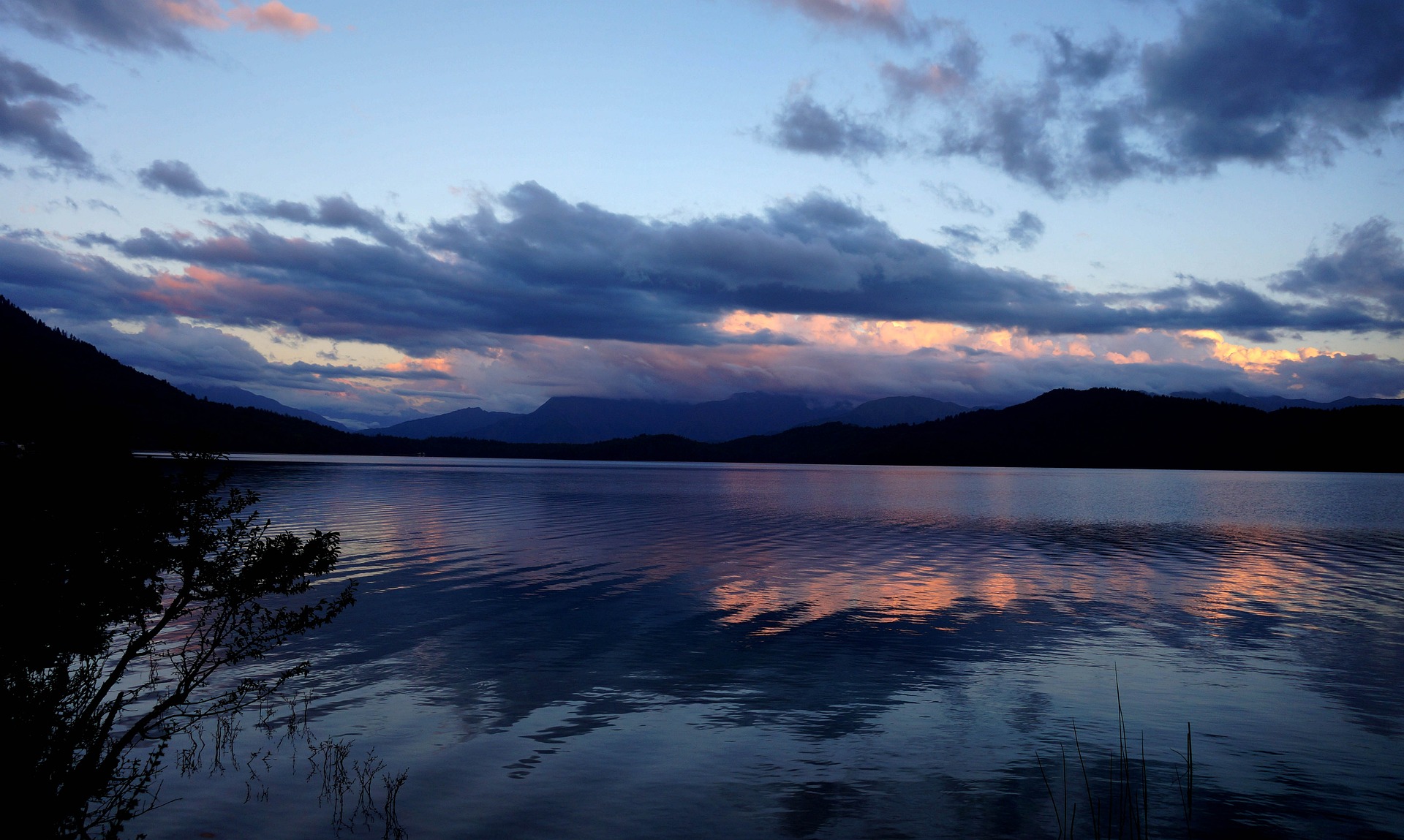
Rara National Park is home to Nepal’s biggest lake, Rara. This area is busy over the warm summer. The Rara Lake Trek is best in Spring (March-May) when the rhododendrons are in bloom and the landscape is at its prettiest. September to November is peak season and the trails get very busy. Early winter (December) is also possible for hiking.
Dhaulagiri Region
The Dhaulagiri region and the Dhaulagiri circuit is best trekked in Autumn and Spring. During other times of year you, wether conditions can be too cold or too hot and humid with high danger of landslides.
Kanchenjunga region
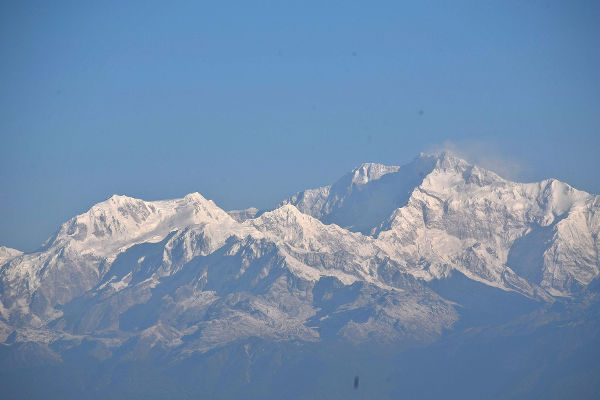
This high-lying region is best hiked before or after the monsoons. Trekking season is during the autumn (September to November) and spring (March to May). In the autumn months, the monsoon season has ended, and the skies are clear, offering stunning views of Kanchenjunga massif and some of the worlds highest mountains .
Essential Gear For Trekking In Nepal: Be Prepared In Any Season!
No matter what time of year you are trekking in Nepal, proper preparation is essential. This means taking with some key items that will make your trek a whole lot more comfortable.
Don't forget these important pieces;
- Thermal layers: These are insulating underclothes are especially important over the winter months. You will also be happy you have them when staying at camps in higher altitudes which get super cold in the evening. Check out some of the best base layers .
- Polarized Sunglasses: This is the first thing I put in my bag for any trip, trekking or otherwise! A good pair of sunnies will keep the sun out your eyes and protect you from the blinding glare at high altitudes. You could break the bank and buy specialist hiking sunglasses but these are going to get limited use outside of alpine peaks. I'm all for insane value, and my go-to for quality sunnies for adventure is the brand, Goodr. Check out the Goodr sunglasses collection .
- Trekking poles: you can rent trekking poles but for regular trekkers, its nice to have your own pair. A set of trekking poles takes the strain of your knees and gives you some support on rocky, steep slopes.
- Hydration Pack: Nepal is a place of extremes. During summer you are going to be rapidly sweating out your moisture reserves. On the other hand, in the cold high altitude passes, its easy to forget to drink regularly. Either way, a hydration pack is the way to go. It gives you easy access to your water supply without having to mess around in your backpack.
One last Item: We always recommend you take out some good travel insurance for Nepal trekking .
About the author
Alison Macallister
With a degree in Nature Conservation and experience working with wildlife including the Big 5, Alison used to work as a guide for a 5-star safari reserve in South Africa. Today she is a full time traveller and editor for Mountain IQ. She has travelled and hiked extensively in South America, including many solo hikes in Patagonia, the Cusco region of Peru, Ecuador and Chile.
Leave a Reply
Your email address will not be published. Required fields are marked
We work with local guides to offer great value adventures at unbeatable prices.
- Nepal Tourism
- Nepal Hotels
- Nepal Bed and Breakfast
- Nepal Vacation Rentals
- Flights to Nepal
- Nepal Restaurants
- Things to Do in Nepal
- Nepal Travel Forum
- Nepal Photos
- All Nepal Hotels
- Nepal Hotel Deals
- Last Minute Hotels in Nepal
- Things to Do
- Restaurants
- Vacation Rentals
- Travel Stories
- Rental Cars
- Add a Place
- Travel Forum
- Travelers' Choice
- Help Center
Planning EBC Trek in November, Itinerary advice. - Nepal Forum
- Asia
- Nepal
Planning EBC Trek in November, Itinerary advice.
- United States Forums
- Europe Forums
- Canada Forums
- Asia Forums
- Central America Forums
- Africa Forums
- Caribbean Forums
- Mexico Forums
- South Pacific Forums
- South America Forums
- Middle East Forums
- Honeymoons and Romance
- Business Travel
- Train Travel
- Traveling With Disabilities
- Tripadvisor Support
- Solo Travel
- Bargain Travel
- Timeshares / Vacation Rentals
- Asia forums
- Nepal forum

I'm planning a solo EBC trek in November, and I think I have a workable itinerary figured out, but I'm looking for feedback from folks who have spent time in the region.
Day 1, Lukla to whereever
Day 2, whereever to Namche Bazar
Day 3, Namche Bazar to Thamu
Day 4 Thamu to Thame Monastary and back to Namche
Day 5, Namche to Sanasa via Khunde and Khumjung
Day 6, Sanasa to Phortse
Day 7, Photse to Thore
Day 8 Thore to Nya
Day 9 Nya to Gokyo
Day 10 Summit Gokyo Ri then trek to Dragnag
Day 11 Dragnag to Zonghla over Cho La
Day 12 Zonghla to Lobuche
Day 13 Lobuche to Gorak Shep (continue to EBC and back)
Day 14 Summit Kala Pathar and trek to Dingboche
Day 15 Dingboche to Tengboche
Days 16-18 hang out in Tengboche and watch Mani Ramdu
Day 19 Tengboche to Namche
Day 20 Namche to Lukla
10 replies to this topic

Most people trek the route anticlockwise - Better aclimitisation options, most trekkers main goal is EBC and going there first increases your chances of achieving that goal.
There are still some direct Kathmandu to Lukla flights but as these are charters, they don't appear on airline websites- Surplus seats are sold off through local agencies - Exploring the possibility of getting a direct flight might be a worthwhile exercise.

If you are flying from USA, you'll have terrible jetlag....
Re #1: EBC isn't actually my main goal, seeing Mani Ramdu is, but I managed to get 4 weeks off work and figure I can spend 20 days or so on the trail seeing other things too.
Re #3: Are the afternoon busses to Rammechhamp local buses or tourist buses? The existence of an afternoon bus hasn't come up in my research at all, and I'm surprised people haven't mentioned anything but a 1AM bus if there were other options. Seems taking an afternoon bus, overnighting in Rammechhap, and starting at the airport refreshed in the morning is a much more ideal way to go.
I have never attended the Mani Ramdu festival, but if it is the main annual festival at Tengboche, I have heard that there is a huge demand for accommodation in the area (not just T) and that a lot of people try to attend the festival. Try and find out more as you trek, but I would suggest keeping this in mind, especially if you are solo (groups will presumably pre-book accommodation, individuals with guides will probably be better able to get rooms as the guides will ask around, phone ahead, especially if they are regular guides in the Everest region, and hence more valuable to the lodge owners/operators). You could look at staying further up the trail (Deboche, Orsho or further) and walking to T for the main activities.
Cho La: I have crossed this 5 times, once west to east (Nov 2005), most recently the other direction in June 2023, when I was 60 (I carry my own full back pack). With the steel ropes and changed route at the top on the east side, crossings are definitely easier and less risky than in the past. However, there is still risk as the sides are steep, and I would advise linking up with other trekkers for the pass, plus the Ngozumpa glacier if you cross that (as is likely). Don't cross either if the weather is poor or looks like becoming bad (sooner or later there will be a major incident when a large number of people get caught out in bad weather, like on Thorung La in Oct 2014). If you link up other trekkers, obviously try and choose people who appear to be sensible and know what they are doing and whom you get on with - there should be quite a few indie trekkers around.
Have a look at recent videos of the pass and the glacier.
Re #7: That's good to know regarding accommodation in Tengbouche for the festival. Is it possible to just find a quiet place and throw down my sleeping bag on the ground somewhere? I'm personally have no issues with sleeping out under the stars, even at that elevation. I'm assuming I'd still be able to find food,
It can easily be -15 c plus any wind chill factor I really really wouldn’t even think about sleeping outside. I’ve found though the worst that will happen is you will end up sleeping on the bench’s in the tea houses with the porters and guides . Nepalis are great people they will find somewhere for you.
Post 8 - I very much agree with post 9, it will be very/incredibly cold at night in November, even at Tengboche altitudes (c. 3,800m). My first Everest region trek was in Nov (2005) and I remember talking to a fellow Brit at Lobuche (4,800m) in late Nov - he was on a camping trek and had come into our lodge to warm up for a bit, because it was so cold in his (permanent) tent. Plus noisy and dusty (it is very dry higher up). He said that the previous night, his sleeping bag had become semi frozen.
I have done 4 E region treks in Dec - Jan (the 3 High Passes) and it is brutally cold outside at night - so much so, that it is worth popping out (in a good down jacket) for the experience. The skies are usually clear, so some amazing views of the stars.
This is before considering local dogs (several of which are strays), and other wild life - there are 2 packs of wolves in the upper Chhukung valley (not that far from the Khumbu valley). To pre-empt the usual comments from some, I am not aware of people being attacked in the K valley, but there is a risk.
In 2021-22 we trekked for 5-6 days with a Russian who slept in the open 1 or 2 nights on the approaches to Larke La - all the lodges were closed and the villages completely empty (covid restrictions) hence no option but to sleep outside (under a porch, I think). He survived and had good gear, but not my choice.
With climate change it may not be so cold in Nov nowadays as previous years - in 2019-20 up in the E region, it was less cold at night, certainly to Pangboche than previous winter treks.
As Barca says, you should be able to find a roof over your head, though it may not be very comfortable, or restful. From what I saw in mid 2023, some large lodges have been built further up the trail in Deboche and just beyond, and new lodges will presumably be built in T (many of the small, old had been demolished).
- Help with 4 Days Itinerary for Nepal in May 2024 8:25 pm
- A (Much) Better Gokyo Itinerary 7:36 pm
- Best cultural trek, not extreme altitude? 1:18 pm
- Sharjah - Kathmandu 132€ return ! 11:29 am
- Lucknow to kathmandu today
- Trekking Guide Forums? today
- Question on NOC for Indians today
- What to do in Nepal? today
- 10 days family trip itinerary today
- August in Chitwan? today
- Planning EBC Trek in November, Itinerary advice. today
- private car cost from Kathmandu to jiri yesterday
- Important information re Manaslu Trek Now Today yesterday
- Encash USD to Nepalese Rupees in Nepal or in my country? yesterday
- World Expeditions- anyone used them? 7 replies
- Kolkata to Nepal/Kathmandu transport options 3 replies
- Nepal tour operators 5 replies
- Accommodation in Boudha, near the Stupa 3 replies
- Flight from Kathmandu to Pokhara 8 replies
- Hire car with driver from Kathmandu 94 replies
- ashrams in nepal? 29 replies
- Flight to Kathmandu from India 2 replies
- Is Nepal safe for travel: May 2012? 13 replies
- Dashain 2012 2 replies
- Itinerary for Gosainkund and Helambu
- New Sticky Thread for posters to add their recent Nepal trip / trek reports.
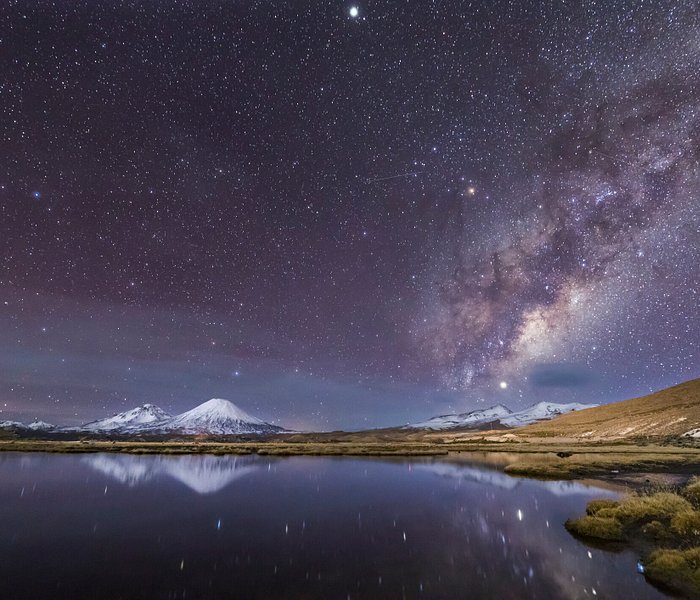

IMAGES
VIDEO
COMMENTS
Best trek to see Tibetan culture, Chorten, caves, 21 days. Kanchenjunga Circuit Trek. The less crowded trail in the east of Nepal and the third highest peak in the world. 21 days. Manaslu and Tsum valley trek. A side trip to the Manaslu circuit trek. 1. Everest Base Camp Trek.
Here are the best hikes in Nepal. 1. Everest Base Camp. Best for Everest views 130km (80.7 miles); 14-20 days; hard. The most famous trek in Nepal - if not the world - is the two-week trip to Everest Base Camp, which draws thousands of trekkers every year. Starting and finishing at the precariously balanced airstrip in Lukla, this high ...
Widely considered one of the absolute best treks in Nepal, the journey to Everest Base Camp Trek is an exciting adventure that takes around 14 days to complete. Generally, the whole trek distance is around 130 Km taking you to the highest elevation at Everest Base Camp (5,364m/17,598ft) & Kala Patthar (5,545m/18,192ft).
The Three Passes Trek takes you over three 5,000m+ passes and is the best way to truly experience the Everest Region for those who have the time to spend 3 weeks on the trail. The trek includes sections of the Everest Base Camp Trek, but offers even more spectacular views of the giants in the heart of the Himalaya as you cross the Renjo La, Cho La and Kongma La passes.
1. Mount Everest Base Camp Trek. Everest Base Camp Trek is one of the most popular trekking routes in Nepal that offers several opportunities to view Mount Everest. This 16-day classic trek takes you from the streets of Kathmandu onto a scenic flight through the Himalayas to one of the highest airports in the world.
The Nepal trekking season varies from year to year by days or even weeks. Here's a brief guide for each trek listed; Everest Base Camp: October to December and February to May. Three Passes Trek: October to November and March to May. Gokyo Trek: October to December and February to May.
Everest Base Camp (16 days) - the definitive Nepal trek, climbing right onto the flanks of Everest, with grandstand views of the world's highest mountain. Three Passes Trek (20 days) - the Everest Extension, linking the Gokyo, Kumbhu, and Imja valleys over three of the world's highest navigable passes. Trekkers descend from Thorung La ...
Over 240 mountain peaks in Nepal breach the 6,000-meter mark (~20,000 feet) - the highest mountain in Africa, Mount Kilimanjaro, is 5,895 meters. Thirty-three mountain peaks in Nepal, with heights ranging from 5,650 meters to 6,500 meters, are classified as ' Nepal trekking peaks '. Although as many as 15 require some, if not a lot, of ...
For beginners who are yet to climb significant altitudes, Nepal has several hikes even below 4,000m to help you adjust and enjoy. Ghandruk Trek (1,950m), Panchase Trek (2,500m), and Ghorepani Poonhill trek (2,860m) are reasonably one of the best walks in the country.
5. Annapurna Base Camp, the Best Himalayan Trek for First-Timers. The Annapurna Base Camp Trek, also known as the 'Annapurna Sanctuary Trek', is one of the most popular treks in Nepal but also one of the most beautiful. Often chosen as a first trek in the Himalayas, the Annapurna Base Camp Trek never disappoints.
GUIDES AND PORTERS. Guides and porters are very common in Nepal (though not always mandatory) and prices are quite competitive. In general a guide will cost around $25-30 per day and a porter will cost around $10-15 per day. A guide will help with logistics, information, and safety on your trek.
You can enjoy gentle walks to the mesmerizing treks, just in the same country. 1. Gokyo Lake Trek. Overview. Maximum Altitude: 5357m, Gokyo Ri. Duration: 12 - 14 days. Best Seaso n: March - May & October - November. Trek Grade: Moderate to difficult. Accommodation Type: Guesthouse.
Dhaulagiri Circuit Trek Quick Facts 2. Mardi Himal Trek: Mardi Himal is a great short and easy trek. The Mardi Himal Trek is one of my personal favorite treks in Nepal, and I consider it one of the best treks in Nepal as well! As it is a less traveled trek, you get an opportunity to experience the scenic views, and small villages along the way with peace and quiet!
1. Everest Base Camp trek. Mount Everest Base Camp trek is one of those trips that make your holiday dreams come true. As one of the most famous treks in the world, the Everest Base Camp trekking trail is also likely the most popular trek in Nepal — and not without good reason.
Kanchenjunga Base Camp Trek. Kanchenjunga Base Camp Trek is one of the best off-beaten-paths treks in a remote area of the Nepal-India border. The trip presents majestic Kanchenjunga (8,586m)- the third-highest peak. Indeed, the Kanchenjunga Valley is a daring acreage that has not yet seen modernization changes.
The Lantang Valley Trek is considered as one of the best treks in Nepal, commences from Syabru Besi, easily accessible by a 9 hours of long drive to the north of Kathmandu valley. Depending upon the specific itinerary and trekker's pace, this trek can be completed in 7 to 9 days covering a distance of approximately 80-90 kilometers. ...
The Pikey Peak trail is one of best treks in Nepal that is less-touristy. From what I have read and gathered, you get to be at the lowest places to easily witness the views of Mount Everest, Mount Kanchenjunga, Mount Lhotse and Mount Makalu - exactly 4 of the 5 highest mountains in the world. Even a slightly bold statement was made by Sir ...
5. Three Passes Trekking - Challenging best treks in Nepal. Everest Three Passes Trekking. The Everest 3 high passes comprise Renjo-la 5,446m, Cho-la 5,420m, and Kongma La 5,535m, which are very strenuous yet full of exhilarating experiences of adventure, perseverance, and excitement.
1. Everest Base Camp Trek. The Everest Base Camp Trek is the best option for those looking to relish the spectacular close up views of the world's highest mountains. This trek offers you a chance to explore the Sherpa villages and their lifestyles. This is one of the best treks in Nepal and offers an exclusive trekking experience.
Best Treks in Nepal. Nepal, a landlocked Himalayan nation, is a trekker's paradise renowned for its breathtaking landscapes, rich cultural tapestry, and towering mountain peaks. Nestled between India and China, this small yet diverse country offers many trekking opportunities, attracting adventure enthusiasts from around the globe.
The Nepal trekking route leads you to the lap of Everest Base Camp, Annapurna Circuit, Manaslu Circuit, Kanchenjunga trek, and many other incredible trekking regions of Nepal. With all the great trekking sections on the list, one is likely to be confused while choosing one. So, we are here to provide you with a list of the top 13 treks in Nepal ...
Best season to travel: September to May. The Panchase Trek, ideal for beginners and families, is an emerging adventure in Nepal's Annapurna region. This three-day trek leads you through dense forests and reveals breathtaking Himalayan vistas, including Dhaulagiri, Annapurna, Manaslu, and Lamjung Himal.
9. Makalu Base Camp. The Makalu Base Camp trek is a challenging journey to the base of Mount Makalu, the world's fifth-highest mountain. This trek takes you through some of Nepal's most remote ...
Monsoon Season. May through to August (and even mid-September) is not the best time to hike in Nepal. This is summertime which co-incides with the Monsoon rains. Temperatures are high, averaging between 27/29 °C (81/84 °F) reaching above 40 °C (104°F) in the lowlands. Moisture rises off the Indian oceans and condenses.
Apr 21, 2024, 11:08 PM. Hi all, I'm planning a solo EBC trek in November, and I think I have a workable itinerary figured out, but I'm looking for feedback from folks who have spent time in the region. Day 1, Lukla to whereever. Day 2, whereever to Namche Bazar. Day 3, Namche Bazar to Thamu. Day 4 Thamu to Thame Monastary and back to Namche.